








































Part of the stress felt before Pesach is the pressure of living in between two worlds. On the one hand, you’re cleaning and ridding your rooms of chometz. On the other hand, there are dinners to make and snacks to serve, and no one wants to be eating kosher for Pesach cuisine for weeks before the holiday arrives. In the stores, you’re shopping for Pesach and to feed your family during the days before. Your cart bulges with potato starch and macarons and spaghetti and bagels. And then, when you finally “turn over” your kitchen for Pesach, there are always a few pieces of chometz that need to be finished. That Shabbos before Pesach, well, that challah needs to be eaten really carefully.
But, on erev Pesach, the atmosphere changes. True, there’s an urgency about locking up cabinets and putting out the garbage and burning the chometz. But once you get to that appointed time, there’s a relief. No longer are you stuck between the chometz and the nonchometz worlds. You’re safely in one zone – and you’ll be cocooned in that chometz-free zone for the next eight days.
On Pesach, it’s as if we’re taken into an entirely different world. The smells are different, the tastes are different, the feel is different.
The kitchens in some homes are covered in silver foil. Some cabinets are locked up, while others have been rearranged. There’s different silverware and dishware, different pots and pans. On erev Pesach, there’s the smell of marror being grated and eggs being boiled. The crumbs of matzah during yom tov are constantly underfoot. Your tastebuds can go into over-
drive trying to process all the egg whites, potato starch, and extra sugar that saturate Pesach cakes and cookies.
Yes, for over a week, we live in a different world.
But our Pesach world is truly not so different. The changes that we make have been taking place in every Jewish home for hundreds of years. For centuries, Jews have been using different dishes for Pesach. We’ve been eating an entirely different cuisine for just these few days. And our houses have taken on a different appearance than from the rest of the year – all just for Pesach. As Tevye would say, “Tradition!”
Where would we be without our mesorah? We would be a rootless nation, eventually melting into society. But our chain of traditions from father to son, from mother to daughter, is strong – and on Pesach, we see it even more acutely.
This year, know that everything you do on Pesach is being passed along to your children. It’s not just at the seder when the generations connect in the telling of yetzias Mitzrayim. When your children build their own homes, they’ll be remembering that their parents did it “this” way on Pesach. They’ll tell them if they can dip their matzah into their soup or use sugar in their cakes. And they will happily pass those traditions down to their children, adding onto the hundreds of links that bind us to tens of previous generations.
Wishing you a chag kosher v’sameach, Shoshana




It wouldn’t be surprising to say that our book of ethics, Pirkei Avot, offers by way of a hint in its chapter ordering, a message that derech eretz and Torah must accompany each other.
The first five chapters of Avot mostly discuss character, however, “five” is associated with Torah as well, the Five Books of Moses. Therefore, Torah is only Torah if surrounded by good character.
The sixth chapter focuses on Torah itself, and appears last, after the first five chapters that primarily focus on middot, to capture the idea that derech eretz kadma laTorah. Therefore, all six perakim of Pirkei Avot are really saying that whether you are connected to Torah in any way or learn it in-depth, only middot give it authenticity.
The notion that Torah must be wrapped in middot conforms with the midrash (Vayikra Rabbah 1:15) that says even the carcass of a dead animal is better than a talmid chacham who lacks da’at
These six perakim give us our derech for the six days of the week. Shabbos is so submerged in holiness that there is greater help from Above.
Pesach at eight is above tevah and is about keeping the dough at bay. All good character stems from knowing we are merely dust of the ground. With this knowledge, hopefully we will reach redemptive qualities.
Steven Genack
For those Jewish Americans who continue to support President Biden, Saturday’s attack by Iran on Israel should be the final straw. Iran “crossed the Rubicon,” with over 300 missiles and drones reigning down on Israel. What is even worse was President Biden’s conversation with Prime Minister Netanyahu that followed the attack in which Biden allegedly said you’ve got your win (because neither people nor property were destroyed); now, don’t escalate by retaliating on Iran. It was with G-d’s blessing that the Iron Dome worked, but to threaten Israel, a sovereign democracy, from striking back requires endless chutzpah. The Biden administration literally is accused of appeasing Iran by orchestrating and paying for the attack on Israel to prevent a wider war before the 2024 election. For President Biden, everything is negotiable including the fate of the State of Israel and the hostages. Even Rabbi Amiel Hirsch (a major liberal) warned President Biden that the results of the upcoming election do not only depend on Michigan, so Biden should ensure that he does not alienate Jewish voters who support Israel.
Jan Henock Woodmere, NYDear
attack on Israel this week was an outright miracle. No one was killed with all those missiles being sent our way!


Continued from page 16
There was barely any damage, and the only person injured was a Bedouin girl. What a neis!
Hashem prepared the refuah before the makkah – the creation of the Iron Dome system is a miracle in its own right. Hashem orchestrated that Israel should have this amazing, protective shield to save His nation.
How lucky are we!
Tzippy WeissDear Editor,
The dating column about signing a financial prenup was shocking to me. In all my years I have never heard of this concept! It’s possible that I don’t run in these circles, but I would think that it is a bit crass to ask someone to sign a document that spells out what would happen if the marriage goes awry. How could someone have these thoughts when their children are dating and seem so happy?
Perhaps the “rich family” isn’t as enamored of this young boy as the mother would like to think. Perhaps they know that something is wrong with their daughter and the marriage can easily dissolve.
I would be very wary and suspicious of this. I would advise this family to stay far away. You won’t regret it, although you may regret staying the course with this shidduch.
Baila HopkinsDear Editor,
The unexpected snowfall prevented us from going to Great Adventure and wept and kvetch the young lad. “It seemed to always snow and rain when we were going to have a good time,” he continued. The older brother immediately said, “Let’s go to plan B and big the biggest snowman in the world!”
Husband and wife were told that their flight was overbooked, and they would have to wait for the next available flight. One sulked, while the other spent time reviewing plans and ideas for their upcoming vacation. He felt great, as he was actually enjoying the vacation right here in the airport.
On a camping trip, the bus broke down. Some were upset and wanted to get home already, while the others decided to chill or play frisbee on the side of the road.
Some are despondent that they are not going away for Pesach, while others view now as the time to explore the hid-
den treasures right here in your neighborhood or city.
Rabbi Zelig Pliskin says that each one was born wealthy and that was given to you at birth. To claim your wealth, you just need to “View the universe as yours.”
Once we internalize this message, all our experiences will be enjoyable, and you will master happiness. Happiness is your birthright; don’t forget that.
Life is easier when you know everything comes from G-d. People have to learn to laugh at things. People have to learn not to take things seriously. Doors close and doors always open up. There is always light at the end of the tunnel. Is it easier said than done? No, but it takes practice.
How do you begin? In my lifetime, everyone that did an injustice to me got paid back five-fold. Remember G-d always pays back. We may not see it right away but it always comes and it comes swiftly because G-d loves His children and protects them. Don’t drive yourself crazy, become bitter, plot vengeance, etc. because at the end of it all, it is you who will suffer. Let G-d take care of the “evildoers.”
Second, happiness begins with rewiring our brain. Why sulk? It’s out of your hands anyway whether the bus broke down, you missed the flight, or the family trip didn’t work out as planned. You can’t change G-d’s plans!
For the layman or people who have a hard time connecting to our G-d as the Creator, and need more of a practical approach to start with we have to keep asking ourselves, “What can I focus on now that is enjoyable?”
Happy people surround themselves with happy people. Their brain is rewired so that there is always a choice. Even when things are not totally to their likings or wishes, they find ways to improve upon the situation. If one door closes, they look for the other door to open. If one plan isn’t successful, they probe into another plan.
Happy people automatically are programmed not to complain or blame. “Darn it! I should’ve got the deal!” or we could say, “Good for them. There is always another deal, a better deal.” If we keep focusing an entire week on what can I focus on that is enjoyable, then the anti-happiness will slowly dissipate and the forefront of our focus will be joy and bliss and a new lease on life. Trust me on this… Israel Root


A blazing fire stormed through Copenhagen’s old stock exchange on Tuesday morning, causing the spire of one of the Danish capital’s most famous landmarks to collapse. Staff and citizens scrambled to rescue paintings and historic artifacts from the flames.
Denmark’s Deputy Prime Minister Troels Lund Poulsen called the fire “our own Notre Dame moment,” referring to the blaze that destroyed the roof and
spire of the Paris cathedral five years ago almost to the day.
The fire began at around 8:30 a.m. local time on Tuesday morning. Shortly before 11 a.m., nearly half of the building had been destroyed by the fire.
“We have tried to rescue a lot of historic paintings that were inside the building and the historic furniture,”
Jakob Vedsted Andersen, an executive director at the Greater Copenhagen fire and rescue service, said. As of now, police do not know what caused the blaze.
No one was hurt in the fire.
A “piece of Danish history” is on fire, Prime Minister Mette Frederiksen said, calling the building’s cultural heritage “irreplaceable.” The building has been at the heart of Danish business since the 17th century.
The old stock exchange – located only a few minutes walk from Christiansborg Palace – dates back to 1625. It was built in the Dutch Renaissance style at the request of King Christian IV and had recently been undergoing renovations with its facade covered in scaffolding and protective coverings.
Denmark’s culture minister Jakob Engel-Schmidt said 400 years of cultural heritage had been damaged.
“How touching it is to see how the
employees at Børsen, good people from the emergency services and passers-by work together to rescue art treasures and iconic images from the burning building,” he noted in a post on X.
The Danish Chamber of Commerce, which is based in the building, described the scene as “a terrible sight.”

Truong My Lan, a businesswoman who founded and chaired real estate company Van Thinh Phat, was sentenced to death on Thursday, marking the biggest fraud case in Vietnam’s history. Lan’s trial began just a short month prior to her sentencing, with the court finding her
guilty of embezzling around $12.5 billion from Saigon Joint Stock Commercial Bank (SCB), bribing officials, and violating banking rules.
“We will keep fighting to see what we can do,” a relative of Lan said, with her lawyer adding that they would appeal the verdict. According to her attorney, Lan’s alleged embezzlement earned her the death penalty. She was also sentenced to forty years in jail for her role in bribing officials and violating banking rules.
As part of the same case, eighty-four others were convicted and sentenced, including Eric Chu, the husband of Lan, who received nine years in prison, as well as Lan’s niece, who received a seventeen-year jail sentence.
In Vietnam, the death penalty is generally given to criminals convicted of violent crimes, although those convicted of financial offenses are also sometimes sentenced to death. According to human rights organizations, Vietnam has executed hundreds of individuals in recent years.
According to officials, Lan, through a number of proxies, illegally gained control of SCB, despite regulations that restrict holding a substantial number of shares in lenders. Lan’s arrest prompted a large number of SBC customers to panic



and withdraw money, leading the government to intervene and help the bank handle the issue. Officials say that Lan illegally had the bank loan a substantial amount of money to non-existent companies.
“The defendant’s actions not only violate the property management rights of individuals and organizations but also put SCB under scrutiny, eroding people’s trust in the leadership of the Party and State,” the jury reportedly said.
On March 31, three men boarded a twenty-foot boat and sailed around the remote Micronesian island of Pikelot, trying to catch some fish, when powerful waves consumed their small ship, stranding the three on Pikelot, a thirty-one-acre island.
ry in Oceania, that the men hadn’t come back to the island of Polowat Atoll, where their journey began. A day later, the men were found by a U.S. Navy P-BA reconnaissance jet from Okinawa, Japan, that had been flying over Pikelot, after officials onboard saw large palm tree leaves on the island, arranged to spell “HELP.” The jet delivered survival packs to the castaways and notified the rescue center of the mariners’ location.
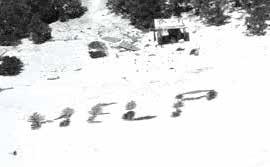
According to search-and-rescue coordinator Lt. Chelsea Garcia, the “HELP” sign was “crucial” in helping authorities find the castaways, as officials would have otherwise had to search through over 103,000 square miles.
“This act of ingenuity was pivotal in guiding rescue efforts directly to their location,” stated Garcia.
This isn’t the first incident in recent years where castaways found themselves stranded in Pikelot. In 2020, three others were stranded on the island after their boat ran out of fuel. They were subsequently rescued after they wrote “SOS” in items found on the beach.

For about a week, the castaways ate coconuts and drank fresh water from a well in Pikelot, an uninhabited island that is, at times, frequented by local fishmen. Pikelot is one of the six hundred islands of the Federated States of Micronesia, an island country situated between Hawaii and the Philippines.
On April 6, rescue authorities began searching for the mariners, after a family member of one of the castaways notified officials in Guam, a United States territo-
On Tuesday, the Olympic flame was lit at the birthplace of the Games in Greece in a move that will start the torch relay that will culminate in Paris on July 26. The flame will be carried more than 3,000 miles over 68 days.
“The Olympic flame has been a symbol of peace and friendship among nations since antiquity,” the International Olympics Committee said.
“In these difficult times we are living

24 through, with wars and conflicts on the rise, people are fed up with all the hate, the aggression and negative news they are facing day in and day out,” IOC President Thomas Bach said in a speech at the ceremony.
The ceremony planned to capture the sun’s rays with a parabolic mirror. Cloudy conditions forced Tuesday’s ceremony into plan B: using a pre-lit flame instead of relying on the sun.
Although it reflects Hellenic traditions dating back thousands of years, the ceremony was first conducted in in its current form in 1936, when the games were held in Berlin under the watch of Adolf Hitler, ym”sh.

For some time now, most of the methamphetamine supplied to countries in the
Asia-Pacific region, including Australia, New Zealand, and Japan, had come from the Golden Triangle, a region in Southeast Asia where the borders of Thailand, Laos, and Myanmar converge.
Now, however, it has been revealed that 70% of Australia’s meth comes from Mexico, the United States, and Canada, while only 15% is supplied by Southeast Asian countries. According to the Australian Federal Police (AFP), in the 20222023 financial year, authorities seized 23.6 tons of meth produced in North America that had been making its way to Australia.
“Mexican cartels (are) increasingly targeting Australia,” noted Australian police officials, with Jared Taggart, the police commander, adding that Australia is “an enticing market for organized crime groups who exploit our people to derive large profits.”
According to Australian police officials, 2.2 pounds of Mexican-produced meth costs around 1,000 Australian dollars (or $650), while the same meth from Myanmar is three times as expensive.
Methamphetamine, an addictive and dangerous drug, is one of the most popular illegal substances in Australia, only second to marijuana. In 2023, the Australian Capital Territory implemented a
policy that decriminalizes the possession of small quantities of hard drugs, with those found with such substances given fines or counseling instead of jail time. Queensland, on the other hand, adopted a three-strike system for similar offenses.
“These states have effectively put up the ‘Open for business’ sign to the criminal cartels in relation to the drug market,” said Terry Goldsworth, noting that meth is “a drug of concern for Australia,” especially in states which have decriminalized the possession of such substances.
In 2023, New Zealand confiscated the largest meth shipment in the country’s history, valued at $150 million, which had been concealed within containers of Canadian maple syrup. The shipment had been making its way to New Zealand, Australia, and other countries in the Pacific region.
“Mexican meth might just be getting dumped here because of changes in the other markets,” said University of Melbourne Criminologist John Fitzgerald, pointing to changes triggered by the war in Ukraine and other recent world events.
“Our analysis shows the overall meth supply from the Golden Triangle has not slowed down, and Australia will continue to be one of the major destinations for organized crime groups operating in
Asia,” said Masood Karimipour, a regional representative for Southeast Asia and the Pacific for the United Nations Office on Drugs and Crime. “These groups have shown a strong ability to adapt and diversify, and we are currently seeing very low prices in some parts of the region.”

At least 39 people were been killed in Pakistan after days of heavy rains pummeled the southwest of the country.
Some people who were killed had been struck by lightning while harvesting wheat.
Huge swathes of farmland were engulfed in rainwater. Flashfloods had also disrupted power supplies and transportation networks.
Pakistan has been hit with floods in the past. In 2022, parts of the country were




28 completely submerged by unprecedented flooding, killing more than 1,700 people and injuring thousands. Millions were left homeless and lacked clean drinking water for months after the storms.
Some of the areas affected by the 2022 floods, including Khyber Pakhtunkhwa and Balochistan, are being impacted again by the recent storms. The government has warned residents of landslides and flashfloods.
Pakistan’s most populated province Punjab has suffered the highest death toll so far, with 21 people killed by lightning between Friday and Sunday.
Heavy flooding has also been reported in neighboring Afghanistan. At least 33 people have been killed and hundreds of homes were damaged or destroyed, Afghan authorities said on Sunday.
A cable car ferrying passengers in a mountainous area of southern Turkey broke apart after colliding with part of the metal structure supporting it on Friday, sending its eight terrified occupants plummeting to the rocky hillside below.
One passenger was killed, seven were injured, and nearly 200 more were trapped in other cabins in midair, some overnight and into Saturday afternoon, as rescuers worked to free them from the crippled line.

Helicopters, cranes and hundreds of rescuers were deployed to the area to evacuate a total of 174 people, Turkey’s interior minister said. Those affected included children, local residents and foreign tourists who were stranded in cabins, some of them dozens of meters above the ground in the Sarisu area of Antalya province, officials said.
Thirteen people were taken to the hospital for treatment, the interior minister, Ali Yerlikaya, announced on social media.
The cable cars normally transport passengers to a point high up the steep, tree-covered mountain that offers
sweeping views of the hills, the city of Antalya and the Mediterranean Sea.
Around 6 p.m. Friday, a pole that was part of the system broke off and struck one of the cabins, smashing the cabin and dropping its eight passengers to the rocky ground when the floor they were standing on suddenly fell away, the Demiroren news agency reported.
One passenger who fell from the damaged cable car, a 54-year-old man, died at the scene, and the other seven were injured, Demiroren said. At least three more people were wounded during the rescue operation, Mayor Muhittin Bocek of Antalya told reporters at the scene.
Tall cranes rose near some of the cars, stretching to reach them. On others, emergency personnel wearing climbing helmets scampered up ropes to assist the trapped occupants. Metal baskets were used to ferry away the injured via helicopter.
Rescuers managed to evacuate 137 people overnight and into Saturday morning, and officials said they finally concluded the operation on Saturday afternoon — nearly a full day after the accident stopped the cars on the line in place.
Prosecutors have initiated an investi-
gation into the accident, Turkey’s justice minister said. (© The New York Times)

A knifeman murdered six people and injured a nine-month-old baby and seven others at a shopping mall in Sydney, the capital of New South Wales, Australia, on Saturday at 3:20 pm local time.
Shoppers panicked and attempted to hide from Joel Cauchi, 40, who targeted shoppers at the busy mall. The suspect was shot dead by a senior police inspector, Inspector Amy Scott, who faced the stabber all by herself, before administering CPR to victims. Scott “no doubt saved lives,” declared Anthony Albanese, the prime minister of Australia.
According to Karen Webb, the police commissioner of New South Wales, four


women and one man were murdered at the mall, while a fifth woman later succumbed to her stab wounds at a hospital. Eight people, including a nine-month-old infant, were wounded in the attack and are now receiving medical treatment, Webb added.
Authorities will likely be investigating the stabbing attack “for many, many days” to come, said Webb, adding that it is “too early to say” what the assailant’s motive was, although the suspect was known to have mental health issues.
On Monday, two days after the attack at the mall, the city witnessed another stabbing, this one in a church in Sydney.
Bishop Mar Mari Emmanuel was presiding over a service that was being livestreamed at his church when a 15-year-old was seen charging toward him. Members of the public restrained the attacker at the scene, according to New South Wales police. Police then arrested the terrorist.
Police Commissioner Webb said, “We will allege [the suspect] attended that church armed with a knife and stabbed the bishop and priest … We believe there are elements that are satisfied in terms of religious motivated extremism,” she said.
No one was killed in the stabbings at the church, although a few people were injured.

According to a report published by the Wall Street Journal last week, officials from the United States and Israel are concerned that the majority of abductees kidnapped by Hamas on October 7 have since passed away.
Of the 253 individuals taken hostage on October 7 – when the Hamas terrorist organization invaded southern Israel and murdered more than 1,200 people – 129

have yet to be released from captivity. Through findings by Israel’s military and intelligence agencies, the Jewish state has determined that 34 of the 129 hostages have died, and the well-being of the other ninety-five abductees is still in question.
Based on Israeli intelligence, U.S. officials believe that most of the abductees are deceased, although such findings are preliminary. According to United States’ estimates, some hostages might have died from health issues or wounds, and some may have perished as a result of Israeli strikes in the Gaza Strip. Those who are still alive are likely being kept in tunnels deep underground and are functioning as human shields for Hamas leaders.
According to other reports, Hamas has expressed that it cannot produce forty living hostages that fall under the category of women, children, the elderly, or the sick for the purpose of a hostage deal. Kan News has reported that Israel’s proposed hostage deal would involve the return of forty living hostages that fall under the aforementioned category. As part of Israel’s stipulation, if the terror group cannot return forty female, young, elderly, or sick abductees, Hamas has to return adult men and captured soldiers.
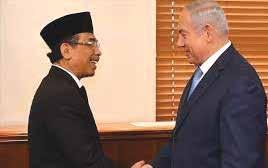
In exchange for Indonesia’s accession to the Organization for Economic Cooperation and Development (OECD), an intergovernmental bloc for developed countries, the Southeast Asian country is, according to officials, prepared to normalize ties with Israel.
Indonesia, which is home to 242 million Muslims, was initially going to join the OECD in February, but its entry into the organization was blocked by Israel. Before gaining admission into the OECD, all member countries must agree to the prospective nation’s accession.
Israel disapproved of Jakarta’s entry into the bloc because Indonesia does not have diplomatic relations with the Jewish state. Since then, Israel, Indonesia, and OECD Secretary-General Mathias Cormann have been privately discussing
the prospect of Indonesia normalizing ties with Israel, a move that would be remarkable considering the Muslim world’s increasingly hostile relationship with Israel.
At first, Cormann convinced Jakarta to stop publicly criticizing Israel, although Israeli Foreign Minister Israel Katz said that such a move would not be enough to make the Jewish state change its mind. Two weeks ago, Cormann notified Katz via letter that Indonesia agreed that it wouldn’t be admitted into the OECD until Jakarta and Jerusalem normalize ties. Yedioth Aharonot reported that the letter’s wording was approved by Indonesia.
On Tuesday, April 9, Israel, for the first time, permitted Indonesia to take part in delivering relief packages to Gaza through an airdropping mission. During the presidency of Indonesian President Joko Widodo, who is currently at the end of his final term, Indonesia and Israel interacted infrequently, with Jakarta consistently dismissing the idea of normalizing ties with Israel.
Widodo has criticized Israel’s military actions in the Gaza Strip and has called on the Jewish State and Hamas to “stop the escalation, to stop the use of violence, to focus on humanitarian issues, and to solve the root of the problem, namely the Israeli occupation of Palestine.” Indonesia supported South Africa’s genocide case against Israel in the International Court of Justice, with the Southeast Asian country filing its own case against the Jewish state in January. Indonesia had, for some time now, refused to normalize ties with Israel until a Palestinian state is established.

In retaliation for Israel’s recent strike on Iranian generals in Damascus, Iran launched 170 drones, 30 cruise missiles, and 120 ballistic missiles at Israel on Saturday night, marking Tehran’s first direct attack on the Jewish state in the Islamic Republic’s history in a move that may significantly heighten tensions in the region.




According to IDF Spokesman Rear Adm. Daniel Hagari, 99% of Iran’s projectiles were intercepted by Israel, with help from the United States, United Kingdom, Saudi Arabia, and Jordan. No drones or cruise missiles entered Israeli airspace, while a few ballistic missiles hit southern Israel, causing “slight damage” at the Nevatim Air Base, added Hagari.
“Iran thought it would be able to paralyze the base and thus damage our
air capabilities, but it failed. Air Force planes continue to take off and land from the base, and leave for offense and defense missions, including the Adir (F35) planes that are now returning from a base defense mission and soon you will see them landing,” said Hagari.
The only reported injury was of a seven-year-old Bedouin girl who lived near Arad and was brought to Beersheba’s Soroka Hospital in serious condition. The young girl had been injured by
The world awaits Israel’s response to Iran’s unprecedented attack, with Israeli officials vowing to take serious action. According to reports, the security cabinet has permitted the war cabinet to confer on Israel’s response, allowing the war cabinet to make a decision without the security cabinet’s approval.
Mohammad Reza Ashtiani, the defense minister of Iran, has stated that any country that “opens its airspace or territory for attacks on Iran by Israel” will face serious consequences.
“I just met with my national security team for an update on Iran’s attacks against Israel. Our commitment to Israel’s security against threats from Iran and its proxies is ironclad,” Biden posted on X, with other U.S. officials issuing similar statements of support for the Jewish state.
UK Prime Minister Rishi Sunak, French Foreign Minister Stephane Sejourne, and others condemned Iran for its attack.

The body of fourteen-year-old Benjamin Achimeir was found by authorities on Shabbos, following the Jerusalem teenager’s disappearance the day prior. No parties have taken responsibility for his death, as of now. Before his death, Achimeir had been shepherding at a farm near Malachei Shalom, which is located close to Ramallah.
shrapnel after an Iranian ballistic missile was intercepted nearby. Jordan, Iraq, and Lebanon closed down their airspace in anticipation of the attack, with Jordan, in a surprise move, neutralizing many drones flying over northern and central Jordan. Hezbollah and the Houthis joined Iran in attacking Israel.
At 12:30 a.m. on Sunday, Israel shut down its airspace, and at 7:30 a.m., flights resumed at Ben Gurion Airport.
“We will get the murderers and those who helped them, as we do to anyone who harms the citizens of the state of Israel,” said Prime Minister Benjamin Netanyahu.
The death of Achimeir who, according to Israeli security forces, was killed by Palestinian terrorists, triggered acts of violence on Friday and Saturday in Palestinian villages, where Israeli residents of the area engaged in riots, according to Palestinian officials, killing a twenty-six-year-old Palestinian, wounding twenty-five individuals, and setting houses and cars on fire.

36 According to Yesh Din, an Israeli rights group, clashes between Israelis and Palestinians took place at dozens of Palestinian villages, including al-Mughayyir, a village northeast of Ramallah, where two homes and a few cars were allegedly burned, and Douma, where six individuals were shot and wounded.
“Clashes developed” between Israelis and Palestinians in multiple places in the West Bank, said the IDF and Border Police. Gunshots were fired and stones were thrown during the violence, and many Israelis and Palestinians were hurt as a result of the clashes, the military said, adding that it deployed “many forces” to the area to put an end to the chaos.
“I appeal to the public. Let the security forces act quickly in the hunt for the terrorists. Acts of revenge will make it difficult for our soldiers in their mission. The law must not be taken into one’s own hands,” said Defense Minister Yoav Gallant.
Other officials, including Netanyahu and Opposition Leader Yair Lapid, called on Israelis who reside in the area to stop interfering with the job of the security forces.

The IDF and Hezbollah exchanged fire on Tuesday, with the Lebanon-based terror group launching two attack drones at northern Israel. A top commander in the terror group was killed in Israeli strikes. Three people were lightly hurt in the Hezbollah drone attack, according to media reports and local authorities. The Israel Defense Forces said the two explosive-laden drones struck areas near the northern community of Beit Hillel.
Ismail Yousef Baz, whose rank is equivalent to a brigade commander, was killed by the strike. He was “a senior and veteran official in the military wing of Hezbollah,” holding several positions, the latest being the commander of the coastal region, the army said.

“As part of his position, he was involved in advancing and planning rocket and anti-tank missile launches towards the State of Israel from the coastal area in Lebanon,” it said.“During the war, he organized and planned a number of terror attacks against Israel.”
Hezbollah announced Baz’s death, saying he was killed “on the road to Jerusalem,” its term for terror operatives killed by Israel.
Since October 8, Hezbollah has attacked Israeli communities and military posts along the border on a daily basis with rockets, drones, anti-tank missiles and other means, saying it is doing so to support Gaza amid the war there. The group is an Iranian proxy in Lebanon. Palestinian terror groups Hamas and Palestinian Islamic Jihad are backed by Iran.
Baz was the sixth Hezbollah officer with a rank equivalent to a brigade commander to be killed by Israel in recent months, according to the IDF. The military has said that more than 30 Hezbollah commanders have been killed in its strikes in the past six months.
Hezbollah has named 275 members who have been killed by Israel during the ongoing skirmishes, mostly in Lebanon, but some also in Syria. In Lebanon, another 53 operatives from other terror groups, a Lebanese soldier, and at least 60 civilians have been killed.

On Saturday, units from Iran’s paramilitary Islamic Revolutionary Guard Corps rappelled down from a helicopter onto an Israeli-affiliated container ship near the Strait of Hormuz and seized the vessel.
Iran’s state-run IRNA said a special forces unit of the Guard’s navy carried out the attack on the vessel, the Portuguese-flagged MSC Aries, a container ship associated with London-based Zodiac Maritime.
Zodiac Maritime is part of Israeli billionaire Eyal Ofer’s Zodiac Group. IRNA said the Guard would take the vessel into Iranian territorial waters.
The MSC Aries had been last located off Dubai heading toward the Strait of Hormuz on Friday. The ship had turned off its tracking data, which has been common for Israeli-affiliated ships moving through the region.
The incident comes amid heightened tensions between Iran and the West, particularly after the IDF attacked an Iranian embassy compound in Damascus, Syria, which killed several Islamic Revolutionary Guard Corps commanders, including two generals. Iran retaliated on Saturday night by sending hundreds of drones to Israel.
Israel’s Foreign Minister Israel Katz called on nations to list the Islamic Revolutionary Guard as a terrorist organization.
Iran “is a criminal regime that supports Hamas’ crimes and is now conducting a pirate operation in violation of international law,” Katz emphasized.
Iran offered no explanation for the seizure of the ship other than to say the MSC Aries had links to Israel.
For days, Iranian officials up to and including Supreme Leader Ayatollah Ali Khamenei have been threatening to “slap” Israel for the Syria strike. Western governments have issued warnings to their citizens in the region to be prepared for attacks.
The Gulf of Oman is near the Strait of Hormuz, the narrow mouth of the Persian Gulf through which a fifth of all oil passes. Fujairah, on the United Arab Emirates’ eastern coast, is a main port in the region for ships to take on new oil cargo, pick up supplies or trade out crew.

Former football player and actor O.J. Simpson, who became infamous for being acquitted after going on trial for the murder of his ex-wife Nicole Brown Simpson and her acquaintance Ron Goldman, died on Wednesday, April 10, from prostate cancer at the age of 76.


Simpson’s diagnosis became known publicly around two months ago, and he was being treated with chemotherapy.
A talented football star, Simpson played for the NFL’s Buffalo Bills and San Francisco 49ers. But in 1995, his fame turned into infamy, after Simpson was charged with the murder of his ex-wife and Goldman. In a surprising decision, the jury found him not guilty, although in 2016, the majority of Americans said they believed he was behind the double ho-
micide, according to polls at the time. In 1997, Simpson was ordered to pay $33.5 million in damages in another case for the wrongful deaths of Brown and Goldman.
“News of Ron’s killer passing away is a mixed bag of complicated emotions and reminds us that the journey through grief is not linear,” said Ron Goldman’s parents, Kim and Fred Goldman. “For three decades. we tirelessly pursued justice for Ron and Nicole, and despite a civil judgment and his confession in (a book titled
in two years, according to People magazine, thus putting Simpson under the radar of recruiters, including those from the University of Southern California (USC). In 1968, he won the Heisman Trophy. Simpson joined the 49ers in 1978, and two seasons later, he retired, after which he began acting in TV shows, movies, and commercials. He was also a sportscaster for ABC and NBC.
While married to Nicole Brown Simpson, O.J. Simpson was accused of domestic abuse, and they divorced in 1992. On June 13, 1994, 35-year-old Brown Simpson and 25-year-old Goldman were found at her home, dead from stab wounds. Days later, Simpson was charged with their murders. During the trial, he was told to put on the murder gloves, which he said he was physically unable to do, leading his defense attorney Johnnie Cochran to say, “If it doesn’t fit, you must acquit.”
Although Simpson never confessed to killing his ex-wife and her friend, he published a book in 2007 called, “If I Did It: Confessions of The Killer,” in which he vividly described how he would have “hypothetically” killed Brown Simpson and Goldman. The book’s proceeds were supposed to go to the family of Goldman, as ordered by a judge.

‘If I Did It’), the hope for true accountability has ended.”
In a different case, Simpson was arrested in 2007 for armed robbery in Las Vegas after he, at gunpoint, attempted to steal what he claimed were pieces of his own sports memorabilia. He was sentenced to nine to thirty-three years in prison and was granted parole in 2017.
Born in San Francisco on July 9, 1947, Orenthal James Simpson, while enrolled in college, scored fifty-four touchdowns
SmartAsset, a personal finance website, recently published a list of the happiest cities in the United States, taking into account eleven factors: percentage of households earning $100,000 or more, poverty rate, housing-cost burdened, number of mentally unhealthy days, life expectancy, physical activity, rate of health insurance coverage, marriage rate, traffic volume, adequate space for physical activity, and overcrowding rate.
Want to be happy? Move down South. In first place was Arlington, Virginia, where residents enjoy a life expectancy of 85.3 years and have plenty of room to engage in physical activity. Although Arlington has congested traffic, the city ranked in the top ten for sev-

“happiest metrics.”
In second place was Plano, Texas, and in third was Fremont, California. San Jose, California, took the fourth spot, and Seattle, Washington, took the fifth. Three cities in California were in the top ten, including the two aforementioned ones, and San Francisco, California, which was ranked the ninth happiest city.
In all, California had sixteen cities on the list and Florida had twelve.
Texas, on the other hand, had three cities in the top ten least happy cities, including Laredo, Texas, which was ranked the second least happy city; El Paso, Texas, which was at the number eight spot; and Houston, Texas, which was at number ten.
Detroit, Michigan, was ranked the least happy city in all of the U.S., with the highest poverty rate, the lowest marriage rate, and the lowest percentage of households earning $100,000 or more.
In the World Happiness Report 2024, the United States dropped to the twenty-third spot, marking the first time since the report started twelve years ago that the U.S. was not ranked as one of the twentieth happiest countries in the world.

Signs of turmoil at Tesla multiplied this week after the electric car company told employees it would lay off more than 10% of the workforce to cut costs and two senior executives resigned.
The job cuts, amounting to about 14,000 people, come as the company faces increasing competition and declining sales. The management changes and layoffs are a reminder of the unpredictability of CEO Elon Musk at a critical time for the company.
Musk has not outlined a plan to reverse a decline in car sales, and he appears focused on long-shot ventures such as a self-driving taxi, rather than new models that would help Tesla compete with cars being introduced by established

carmakers and new rivals from China.
“As we prepare the company for the next phase of growth, it is extremely important to look at every aspect of the company for cost reductions and increasing productivity,” Musk told employees in a Monday morning email, a copy of which was reviewed by The New York Times.
“There is nothing I hate more, but it must be done,” he wrote.
Hours after that email, Drew Baglino, a senior vice president who has played a big role in the company’s rise from startup to dominant electric carmaker, said he had resigned.
“I made the difficult decision to move on from Tesla after 18 years yesterday,” Baglino said in a post on the social platform X. Baglino is one of only three managers besides Musk listed as a top executive on the company’s website. His longevity was unusual at a company known for high management turnover.
Tesla also appeared to be losing an executive key to winning regulatory approval for self-driving technology. Rohan Patel, who was Tesla’s head of policy and business development, tacitly confirmed reports that he was leaving. In a post on X, Patel thanked his co-workers and Musk for “the past eight years at Tesla.”
Investors often welcome job cuts because they can lead to higher profits. But that was not the case Monday, with Tesla shares ending the day down more than 5%. (© The New York Times)
An Ethiopian won the Boston Marathon on Monday, but that’s hardly a surprise. This time, though, is the first time the person who won, Sisay Lemma, declared victory in the Boston race, with a time of 2:06:17 in the men’s race. Hellen Obiri of Kenya retained her 2023 title in the women’s race.
Lemma, who is the fourth-fastest man in history after his 2:01:48 finish in the Valencia Marathon last month, set the early pace, racing into a big lead. Lemma, 33, was able to hold on for his second major marathon victory after winning the 2021 London Marathon.
Lemma finished 41 seconds ahead of Mohamed Esa in second and one minute and five seconds ahead of double-defending champion Evans Chebet in third.
The top performing men’s runner from the U.S. was CJ Albertson, who finished in seventh with an unofficial time of 2:09:53.
When it came to the women’s race, Obiri was neck and neck with former New York City Marathon champion Sharon Lokedi. But a few miles before the finish line, Obiri sneaked ahead and finished with a time of 2:22:37.

Obiri, 34, is the first woman to win back-to-back Boston Marathons since Catherine Ndereba accomplished the feat in 2004 and 2005. She also won the New York Marathon in November last year.
The top performing U.S. women’s runner was Emma Bates, who finished with an unofficial time of 2:27:14.

Going for a walk? That’s a great idea if you want to reduce stress and improve your cardiovascular health.
According to a study published this week in the Journal of the American College of Cardiology , exercise, good mental health, and a healthy cardiovascular system all work together.
The study analyzed 50,000 adults around 60 years of age. Participants were given a survey to fill out about their physical activity, imaging of their brains to track activity related to stress, and digital records of cardiovascular events.
“Individuals who exercise more had a graded reduction in stress-related signals in the brain,” noted lead study author Dr. Ahmed Tawakol, a cardiologist at Mass General Hospital and associate professor of medicine at Harvard Medical School in Boston.
“We found nice associations that




exercise appeared to, in part, reduce heart disease risks by decreasing stress-related signals,” he added. Depressed? Exercise is your best bet to reduce stressful feelings.
“Surprisingly, we additionally found a greater than twofold increase in benefits of exercise among individuals who are depressed versus individuals who don’t have depression or don’t have a history of depression,” Tawakol said.
For people without any history of depression, the benefit of exercise on cardiovascular disease reduction plateaued after about 300 minutes of moderate physical activity a week. But for people with depression, the benefits continued with more time spent, Tawakol said.
Exercise reduced stress signals and increased prefrontal cortical signals. Stress signals in the brain are also associated with things like in -
sure that the exercise caused the reductions or what the mechanisms are that underlie it.

April 15 was the deadline for Americans to file their taxes. As such, the commander-in-chief of the United States released his taxes to reveal that he and his wife, first lady Dr. Jill Biden, jointly earned $619,976 in 2023.
The White House also released the return for Vice President Kamala Harris and second gentleman Doug Emhoff, showing that pair made $450,299 last year.
“President Biden believes that all occupants of the Oval Office should be open and honest with the American people,” the White House said in a statement on Monday, “and that the longstanding tradition of annually releasing presidential tax returns should continue unbroken.”
That statement could be seen as a dig at former President Donald Trump, who declined to voluntarily release his tax returns while he was president. Six years of Trump’s tax returns, including from his time as president, were released to the public by the House Ways and Means Committee at the end of 2022.
The bulk of the Bidens’ income came from President Biden’s congressionally mandated $400,000 salary, along with pensions. The first lady also earned $85,985 from her position as a teacher at Northern Virginia Community College.
flammation, higher sympathetic nervous system activity, higher blood pressure, and diseases that thicken or harden the arteries. When exercise reduces those stress signals, it will end up reducing heart disease as well.
Still, these findings are just associations. Because the researchers observed participants rather than conducting a randomized trial with a control group, they cannot say for
The Bidens paid $146,629 in federal income tax in 2023, making their federal income tax rate 23.7%. They reported $20,477 worth of contributions to 17 different charities in 2023. They donated $5,000 to the Beau Biden Foundation and smaller amounts to organizations including the Fraternal Order of Police, a Wilmington fire station, and St. Joseph on the Brandywine.
Harris and Emhoff paid $88,570 in federal income tax, amounting to a

46 2023 rate of 19.7%. The pair contributed $23,026 to charity in 2023, including donations to the DC Central Kitchen, Howard University, and the University of Southern California.
The Bidens’ 2023 income was an increase from the $579,514 the couple earned in 2022. The Bidens reported an income of $610,702 in 2021 and $607,336 in 2020.
Harris and Emhoff reported an income of $456,918 in 2022 and $1.6 million in 2021 – the year they sold a house.
On March 26 at around 1:30 a.m., Baltimore’s Francis Scott Key Bridge collapsed after a massive cargo ship, the Dali, lost power and struck the bridge. Six construction workers plunged into the Patapsco River and were killed in the collapse. The fourth body of the victims was recovered this week. Two of the victims’ bodies have yet to be found.
Now, federal authorities, including the FBI and the U.S. Coast Guard, are trying to piece together what happened,
launching a criminal investigation into the incident. The city and attorneys for several victims are also seeking accountability – especially after the ship’s owner and manager filed a court document trying to limit their financial liability.

Federal investigators will also look into whether the crew failed to report an earlier issue with the ship that delayed its departure, an official said Monday.
The National Transportation Safety Board has also been investigating why the 213-million-pound ship lost power and crashed into the 47-year-old bridge. That probe has been focused on engine room equipment.
Thirty-thousand people crossed that bridge each day.
“Today, the City of Baltimore announced a partnership with the national complex issues and trial firm DiCello
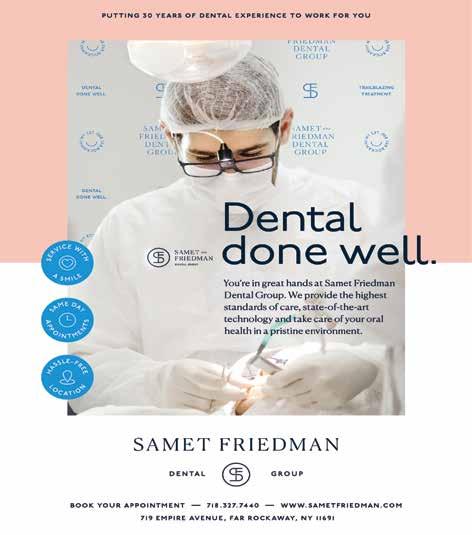
Levitt and Philadelphia law firm Saltz Mongeluzzi Bendesky Trial Lawyers to launch legal action to hold the wrongdoers responsible and to mitigate the immediate and long-term harm caused to Baltimore City residents,” Mayor Brandon Scott said in a statement on Monday.
“Through this engagement, the City of Baltimore will take decisive action to hold responsible all entities accountable for the Key Bridge tragedy, including the owner, charterer, manager/ operator, and the manufacturer of the M/V Dali, as well as any other potentially liable third parties.”
The ship’s owner, Grace Ocean Private Limited, and manager, Synergy Marine PTE LTD, filed a petition in federal court asking for a $43.6 million limit on potential liability payouts.
“The Casualty was not due to any fault, neglect, or want of care on the part of Petitioners, the Vessel, or any persons or entities for whose acts Petitioners may be responsible,” the companies’ attorneys wrote in the petition filed April 1.
“Petitioners claim exoneration from liability for any and all losses or damage arising out of the Casualty and from any and all claims for damages that have been or may be filed. Petitioners further allege that they have valid defenses to any and all such claims.”
“Alternatively, if any such faults caused or contributed to the Casualty, or to any loss or damage arising out of the Casualty, which is denied, such faults were occasioned and occurred without Petitioners’ privity or knowledge,” the petition states.
But attorneys for some of the victims’ families slammed the companies’ efforts, saying they’re relying on an “archaic” maritime law from 1851 to try to limit liability.
Attorneys for the families of Alejandro Hernandez Fuentes and José Maynor López, who both died in the collapse, and Julio Cervantes, who fell from the bridge and survived, announced their own investigation on Monday.
“We all know that the more eyes to investigate, the better – especially when you’re dealing with corporate giants of an industry,” attorney L. Chris Stewart said.
“As the bodies of our clients were still under the bridge, the owner of this boat was in court trying to protect their assets.”

The ants go marching one by one, hurrah, hurrah!
In California, they are making it easier for wildlife – including ants –to cross 10 lanes of highway from the Santa Monica Mountains into the Simi Hills of the Santa Susana mountain range.
Construction of “the world’s largest wildlife crossing” began in April 2022. This week, crews will close a portion of the Los Angeles County’s 101 Freeway overnight on weekdays for several weeks. As the project nears completion in 2025, the bridge will be covered in soil and native plants to blend in with the natural surroundings.
Officials say major highways are barriers to wildlife, affecting animals’ movement and gene pools.
“We can coexist side by side with all kinds of wild instead of paving it over and choking it off,” said Wallis Annenberg at the groundbreaking ceremony. “It is about bringing more attention to an ingenious solution so urban wildlife and ecosystems like this one cannot only survive, but thrive.”
The crossing is named for the president and CEO of the Annenberg Foundation, a family foundation that supports non-profits.
It will provide habitat access to coyotes, bobcats, deer, snakes, lizards, toads and even ants, but cougars will be among its chief beneficiaries, the National Parks Service has said.
Mountain lions typically have a territory of 150-200 miles, but in Los Angeles, they have been restricted to a freeway-ringed “urban island,” causing inbreeding, according to the NPS.
Following in Texas’ footsteps, the governor of Iowa signed a bill into law last week that allows law enforcement officers in her state to arrest some undocumented migrants.


Republican
signed the law that makes it a crime to be in the state after being deported, denied admission to the United States, or have an outstanding deportation order.
The law, which takes effect on July 1, is similar to Texas’ controversial law that allows state officials to arrest and detain suspected illegal immigrants. Texas’ law, which also allows state judges to order immigrants to be deported, is currently blocked as a federal appeals court
considers its constitutionality.
“Those who come into our country illegally have broken the law, yet [President Joe] Biden refuses to deport them,” Reynolds said. “This bill gives Iowa law enforcement the power to do what he is unwilling to do: enforce immigration laws already on the books.”
Immigration is on the forefront of voters’ minds in this upcoming election, with both parties claiming to be securing the border.
long-time Iowans.”
A person arrested under the Iowa law would have the option to accept a deportation order from a state judge or face potential prosecution, according to the bill. The judge’s order would need to include the manner of transportation for the person to a port of U.S. entry and the law enforcement officer or state agency responsible for overseeing their removal.

In response to Iowa’s bill, the Mexican government said it will not stand idly and plans to explore legal advice and resources to help defend the rights of Mexicans in Iowa.

Ippei Mizuhara, the interpreter for baseball superstar Shohei Ohtani, had been the star’s friend for a long time. But now it seems like Mizuhara had taken advantage of the baseball legend – to the tune of $16 million.
Mizuhara is facing a federal charge of bank fraud, a U.S. attorney in Los Angeles announced on Thursday. He had made unauthorized transfers from Ohtani’s bank account from November 2021 until January 2024, U.S. Attorney Martin Estrada said.
In Iowa, local immigrant rights groups like Iowa Migrant Movement for Justice have protested the legislation throughout the year and said in an online statement, “We know that we all belong here, Iowa is home, and we will stand together as workers, families and allies to defend each other.”
“Welcoming immigrants and refugees is the definition of what ‘Iowa Nice’ should be,” the group said. “Governor Reynolds is failing newly arrived and
Mizuhara took advantage of his close relationship with Ohtani – a longtime friend whom he accompanied on a constant basis due to the Japanese star’s limited English – “largely to finance his voracious appetite for illegal sports betting,” Estrada said.
“Mr. Ohtani is considered a victim in this case,” the prosecutor emphasized.
“Ohtani provided his cellphone to law enforcement, who determined that there was no evidence to suggest that Ohtani was aware of, or involved in, Mizuhara’s il-


legal gambling activity or payment of those debts,” the U.S. attorney’s office said.
Shortly after Ohtani moved from Japan to the United States, Mizuhara helped the baseball phenom create a bank account in 2018. But Mizuhara refused to give access to Ohtani’s other professional advisors – including his agent, accountant and financial advisor.
Phone and bank records indicate Mizuhara accessed Ohtani’s account online. In 2021, Mizuhara started placing

You may see an abundance of insects with bright red eyes and wings and legs this spring. Scientists are confirming a rare emergence of two different broods of billions of cicadas, a phenomenon some are dubbing the cicadapocalypse.
In just a few weeks, their deafening song will fill the air. One brood generally emerges once every 13 years; another comes out every 17 years. This year, they will both come out at once.
The last time this occurred Thomas Jefferson was president. After this year, it is predicted that it will happen once again in 2245.
The 13-year group, known as Brood XIX, or the Great Southern Brood, is the largest periodical cicada brood, stretching across the southeastern United States. The Northern Illinois Brood, or Brood XIII, emerges every 17 years.
“It’s rare that we see this size of double brood emergence,” said Dr. Jonathan Larson, an extension entomologist and assistant professor at the University of Kentucky. “We’re talking about an absolute oddity of nature, one of America’s coolest insects.”
Some cicadas emerge annually. Other cicadas – such as these two groups – emerge periodically. Three species emerge on a 17-year cycle, and four species are on a 13-year cycle.
sports bets with a group of bookmakers linked to an illegal gambling operation, according to prosecutors.
“We do not believe any bets were made on baseball games,” Estrada said. But “over time, Mr. Mizuhara’s bets became more and more frequent. And over time, Mr. Mizuhara’s bets became larger and larger in amounts.”
Winnings were not placed in Ohtani’s account; Mizuhara put them in his own bank account.
Mizuhara even impersonated Ohtani to try to get a bank to approve large wire transfers to bookmakers.
The allegations became public while the Dodgers were in South Korea for an MLB season-opening series in March. Ohtani’s lawyers accused Mizuhara of “massive theft” of millions of dollars and placing bets with a bookie under federal investigation.
If convicted, Mizuhara could face up to 30 years in prison.
The pattern periodical species follow is different from that of “annual” cicadas, which don’t actually have an annual life cycle, even though you can see them every summer in much of the United States. The nymphs, or babies, of annual cicadas spend two to five years underground, slowly growing, until they are ready to emerge. There are just so many overlapping generations that there appears to be a steady stream of these cicadas every year.
Annuals tend to emerge later in the year than periodicals. While there are numerous species of annual cicadas, many of them are large and greenish. Periodical cicadas are smaller and
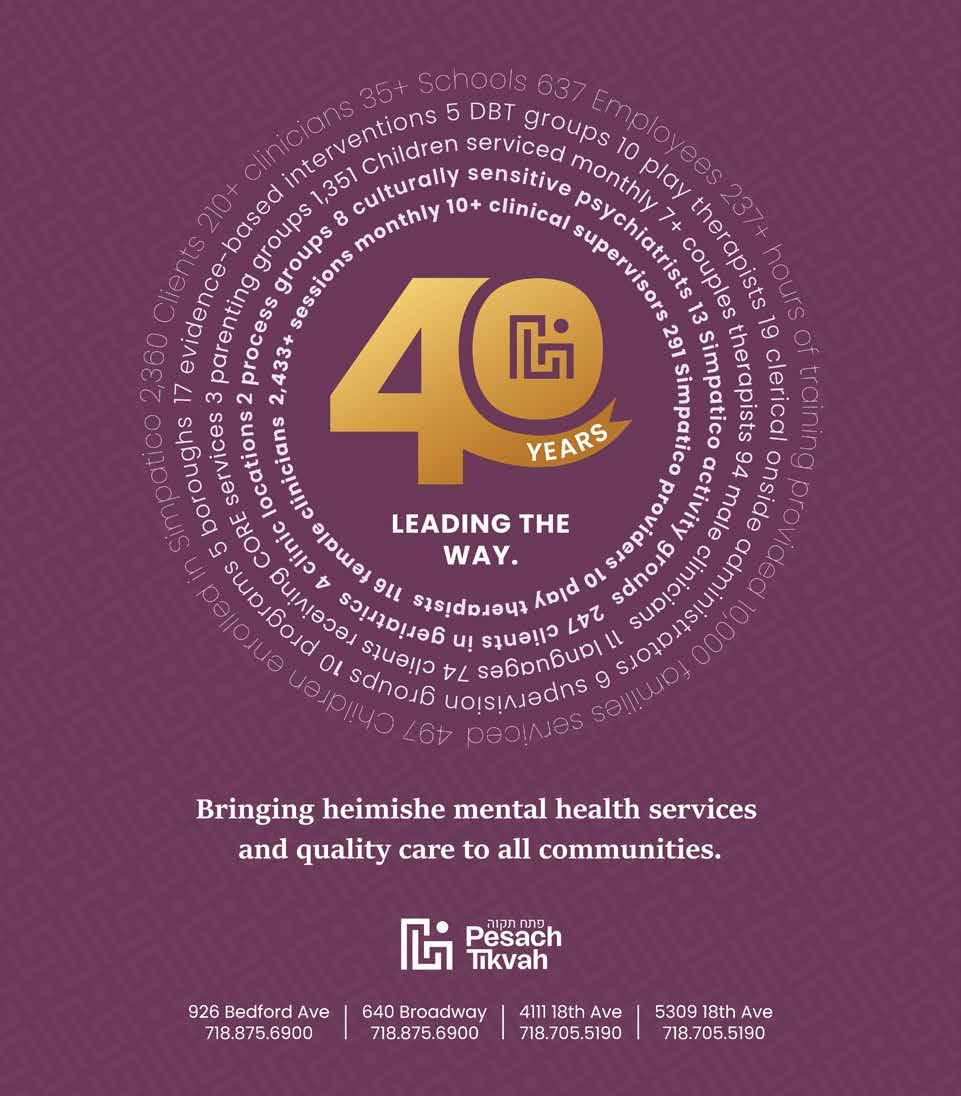
mostly black, with bright red eyes and orange-tinged wings and legs.
Cicadas emerge once the soil gets warmer, which is likely to happen midMay. They will come out in a staggered procession, which will mean there will be around six weeks of loud singing from these insects, until they die en masse.
Parts of the Midwest and Southeast are due for cicadas this spring. Northern Illinois, along with southern Wisconsin, eastern Iowa and northwest Indiana, are likely to see bugs from Brood XIII; central and southern Illinois, most of Missouri and scattered areas of Kentucky, Tennessee, Virginia, Maryland, North Carolina, South Carolina, Georgia, Alabama, Mississippi, Louisiana and Arkansas are due to get Brood XIX bugs.
There are some areas of central Illinois where the two broods’ geographic ranges have historically been close to each other and could potentially overlap. However, predictions of a cicadapocalypse — in which Brood XIII and Brood XIX show up at the same place at the same time — are probably an exaggeration.
“We’re not even sure that they’re really going to overlap,” said Dr. Chris
Simon, a professor of ecology and evolutionary biology at the University of Connecticut.

A former U.S. ambassador accused of working for decades as a secret agent for Cuba in one of the biggest national security breaches in years pleaded guilty on Friday and was sentenced to 15 years in prison.
Manuel Rocha, 73, pleaded guilty to two charges — conspiring to defraud the United States as a foreign agent and failing to register as a foreign agent — as part of an agreement with the federal government. He also faces three years of super-
vised release and a $500,000 fine.
Rocha conceded before he was sentenced to the “betrayal of my oath of loyalty to the United States during my two decades in the State Department.”
“During my formative years in college, I was heavily influenced by the radical politics of the day,” said Rocha, who prosecutors said was recruited by Cuban intelligence agents in 1973. “Today, I no longer see the world through the radical eyes of my youth.”
In imposing the sentence, Judge Beth Bloom of U.S. District Court in Miami said that as recently as 2022 and 2023, Rocha was recorded by an undercover FBI agent showing “a lack of allegiance of the United States.”
The proceedings did not shed much light on Rocha’s dealings with the Cuban government or whether he shared secrets during his diplomatic career, which included serving as ambassador to Bolivia and briefly working in a White House role under President Bill Clinton.
Bloom expressed deep frustration with prosecutors for not seeking more penalties for Rocha, such as forfeiture of his assets. She demanded changes to the plea deal from the bench and pressed prosecutors to reveal more about when the government learned that Rocha had
become “an enemy of the United States government.”
Prosecutors said details beyond those made public in the indictment were classified.
Rocha was charged in December with acting as an agent of a foreign government; he was also charged with defrauding the United States, wire fraud, and making false statements to obtain and use an American passport.
Prosecutors dropped the other charges as part of his plea agreement; the wire fraud charge had carried a 20-year maximum sentence.
Rocha’s plea deal compelled him to share with the government “a full, detailed damage assessment of that harm that was committed,” Jonathan Douglas Stratton, one of the prosecutors, said in court. (© The New York Times)
You may be chewing on matzah this week, but when Pesach is over and you bring out the pretzels, make sure you consider how big they are before you chow down.


According to researchers at Pennsylvania State University, the size of an individual snack piece not only influences how fast a person eats it but also how much of it they eat.
The team of food scientists led by Madeline Harper, a graduate student in food science, working with Prof. John Hayes who was corresponding and director of the Penn State Sensory Evaluation Center, published their findings in the journal Appetite under the title “Unit size influences ad libitum intake in a snacking context via eating rate.”

They investigated how the size of pretzels influences eating behavior –overall intake, eating rate, bite size and how long they snacked – and found that people eat larger pretzels quicker with larger bites. They also found that while people ate smaller pretzels slower and with smaller bites and ate less overall, they still had higher intake of sodium.
Seventy-five people were involved in the study. They were required to eat snacks at three different times. The oversized snack was about 2.5 servings of one of three sizes of pretzel – small, medium or large. When participants were given the same amount of food, how much they ate — in both snack weight and calories — depended on unit size. Those eating larger pretzels ate around 30 percent more than those eat the small- and medium-sized pretzels. People eating the larger pretzels also ate faster and
took larger bites.
These pretzels are making me thirsty.
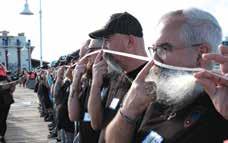
Attendees at the National Beard and Mustache Championships in Florida broke three Guinness World Records for the longest chains of beards, mustaches, and partial beards this year.
The annual event, which is held in a different location each year by Beard Team USA, saw participants take on the three record titles on the Main Street Pier in this year’s host city: Daytona Beach.
The facial hair fanatics first attempted the record for the longest beard chain, which was previously set at 150 feet during the previous year’s National Beard and Mustache Championships.
The beard-sporting participants stood side-by-side, and their facial hair was clipped together into an 86-person chain measuring a whopping 195 feet and 3 inches long.
Organizers then attempted the record for the longest mustache chain, with 27 participants achieving a record-breaking length of 20 feet and 4 inches.
The final record, longest partial beard chain, involved only those participants with partial beard styles, which include mutton chops, goatees and musketeer-style facial hair. The partial beard

chain, made up of 24 participants, measured 42 feet and 8 inches long.
“I think it looks extra crazy because it’s so wacky to make a beard chain in the first place,” Bryan Nelson, creative director for Beard Team USA, told Guinness World Records. “But on top of that, there is the measuring, documenting, and all the official aspects of certifying the record title for Guinness World Records.” Mustache madness.

The 51-year-old exhibition technician and self-proclaimed “freelance artist” smuggled one of his paintings into the museum on February 26.
“A technical employee of one of the four museums represented in the Pinakothek der Moderne, who had not previously attracted attention in this regard, mounted the object in an exhibition room of the Sammlung Moderne Kunst outside opening hours,” a museum spokesperson said.
“As a result of the incident, he has been banned from the museum until further notice and his employment will not be continued.”
The painting measured 60 centimeters by 1.2 meters.
Just after workers discovered the painting, the man emailed the museum confessing his actions, writing that “as a freelance artist, he has now hung his own picture [on the wall],” Christian Drexler, chief superintendent of the Munich Police, said.
A small artistic triumph.
An employee of an art museum had his dream realized when a piece of his artwork was hung on the museum’s walls. It was a short-lived dream come true, though, as he had hung the piece himself on one of the walls of the Pinakothek der Moderne in Munich, Germany. After security officials observed his actions, they promptly took the piece down and fired the rogue worker.



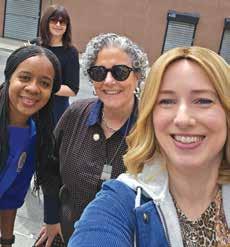
Jewish Community Council of the Rockaway Peninsula (JCCRP) distributed Pesach food packages to 560 local Jewish families, including single mothers, Holocaust survivors, and those who teach in local yeshivas. Preparation for the event began the week before, as over seven local schools volunteered to package the food boxes at JCCRP headquarters. Some of the schools included YOSS, Netzach Hatorah, HALB, HAFTR, MAY, Central, and Nishmas Hatorah. On the day of the event, over 30 volunteers and JCCRP staff members placed boxes of carefully prepared holiday foods in the cars of local Jewish fam-
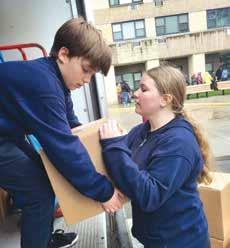
ilies with a smile. Each family received five boxes of food, including many packages of chicken, gefilte fish, and a variety of cheeses, produce and much more. Local families greatly appreciated the food packages and thanked staff and volunteers profusely.
We are grateful to our community partners who made this distribution a success, including community donors who enabled us to gift each family with a gift card and a robust holiday package containing Pesach food worth over $300. JCCRP staff thanked the our elected officials who make these community distributions possible and volunteered at the
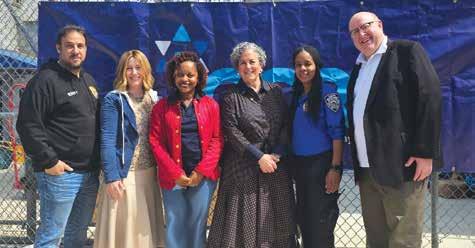
distribution, including Assemblywoman Stacey Pfeffer Amato and Councilwoman Selvena Brooks-Powers. Thank you to our elected officials, UJA-Federation of NY, Met Council, NYS Nourish NY, NY Food for NY Families Program, United Way EFSP, and NYS HPNAP for their support of JCCRP programming. A very special thank you to Detective Lynn Blanchette of the 101st NYPD Precinct in Far Rockaway and RNSP who worked the entire distribution helping load up cars with Pesach food!
Thank you notes received: “We just wanted to thank you and all the staff (and volunteers) for yesterday’s
distribution. We really appreciate your efforts and hard work! We are very grateful! Thank you so much! Have a wonderful Yom Tov!”
“Many thanks for the most generous and helpful assortment of foods for Pesach. It’s obvious to me that the menu was carefully thought out. Kol haKavod to everyone involved in this successful event. Wishing all a Happy and Kosher Pesach.”
If you are interested in volunteering at future JCCRP food distributions and community events, please email volunteer@jccrp.org.

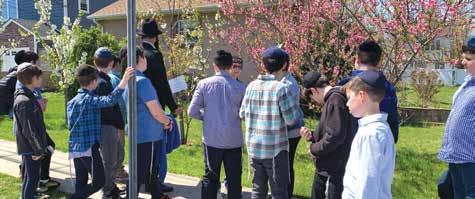
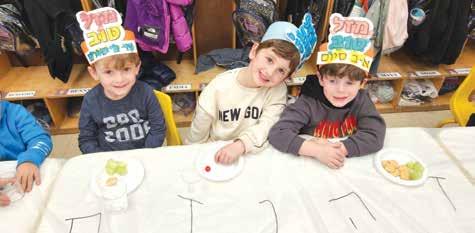

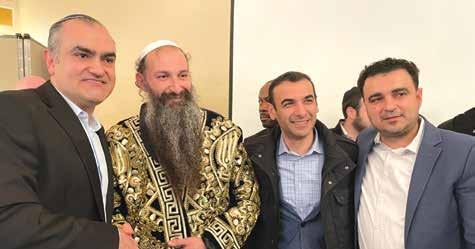
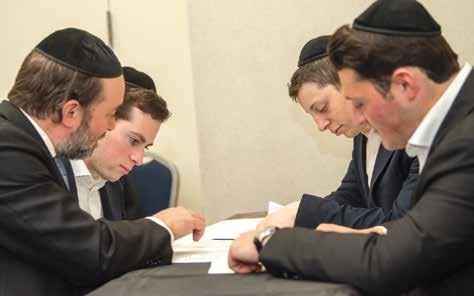
Over the past couple of weeks, as Bein Hazmanim got underway, our alumni began coming back to NY, after learning in their respective yeshivas, both here and in Eretz Yisroel over a long winter zman. One of their favorite places to visit when they come back is their Netzach family, and it is always a heart-warming reunion. We watched with pure nachas as our three classes of graduates came back to the Mesivta, thrilled to see our hanhallah, rabbeim, and current talmidim.
This past Sunday, Mesivta Netzach HaTorah held our first ever Yarchei Kallah, where all of our alumni classes came home to learn with our Mesivta talmidim. Rabbi Yurman opened with a Haggadah shiur in the morning, giving the talmidim a chance to hear from their Menahel. Rabbi Feiler closed it out at the end of the day, as our 12th grade Rebbe gave shiur on the sugya the talmidim had
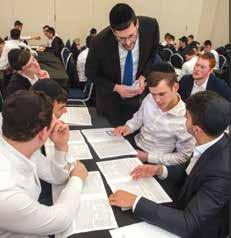
just learned for hours b’chavrusa. It was fantastic to see the bais medrash filled with so many of our boys, learning with a real geshmak, as the warmth between the current talmidim and the alumni was palpable. It reminded us, as it always does, that once you are a Netzach HaTorah talmid, you are always a talmid of Netzach!

On Wednesday, April 10, students who participate in SKA’s RISE independent learning program were afforded the opportunity to gain insight into the intricate and complex workings of New York’s court system during a trip to the Nassau County Court. They were greeted upon arrival by the head deputy court officer, Don Vetter, who provided legal background for the girls and escorted them into the courtroom.
Mr. Vetter explained the various nuances
of day to day routine in the courthouse, such as the differences between felonies and misdemeanors and how each is classified. He introduced an interactive discussion, including examples of practical cases and the process behind how the trials work. The students were then addressed by different members of the legal system, including the head court officer, a senior court reporter, and a courtroom clerk, all of which gave the girls in-depth knowledge of their personal roles and significance within the court system. Armed with this knowledge, the girls were able to enter a courtroom and sit in
on live court proceedings to gain a deeper understanding of the way they are run. From their vantage point in the jury box, they watched three separate cases that were presented to Judge Meryl Berkowitz. They were then able to ask the judge questions about her job and discuss the cases with her. Lastly, they were brought to a holding cell behind the courtroom to witness the behind the scenes and see where the defendants are held while awaiting trial.
Through this experience, the students obtained a firsthand view of the justice system for the first time and gained a
Shevach High School students were inspired by an uplifting Yom Iyun in preparation for Pesach. On Rosh Chodesh Nisan, Tuesday, April 9, Mrs. Shulamith Insel, Menaheles, introduced this special event. Expounding upon the morning’s theme of emunah and bitachon, Mrs. Insel emphasized their significance in regard to the yom tov of Pesach. She went on to introduce guest speaker, Rabbi Shaya Cohen, Rosh Yeshivas Zichron Aryeh and founder of Priority 1 and the Teach to Reach Educational Program.
Rabbi Cohen addressed the girls and spoke very passionately about how one can reach the status of seeing Hashem in every aspect of one’s life. Rabbi Cohen referred to the watershed event in Jewish history of yitzias Mitzrayim, thousands of years ago. There were open miracles at that time which brought the Jewish nation to recognize the hidden miracles that
take place each and every day.
The ability to recognize Hashem’s hand in difficult times is the essence of the Jewish people throughout history, including today. Emunah should always be our guide. Life can be lived with tranquility and free of worry if one internalizes that reality. With specific examples from his own life, Rabbi Cohen brought that idea home for each and every student in the audience.
The entire Yom Iyun was beautifully coordinated by Mrs. Bayla Tropper. Following the inspirational speech, the students were treated to a gala Rosh Chodesh breakfast. After enjoying fresh bagels and muffins, the girls were divided into workshops where they explored the concept of bitachon and trust in Hashem. The workshops were presented by fourteen local community kollel wives and proved to be meaningful and thought provoking. The morning then continued with a powerful

dvar Torah by Shevach Senior Maya Harpaz, followed by a choir headed by Avital Pleshtiyev, and a creative video depicting how one can bring the concepts of emunah and bitachon into your everyday life put together by Yael Goldfarb.
The words of Rabbi Cohen, followed up by the ideas discussed throughout the
broader understanding of the processes that make up daily life for America’s legal professionals.
“This trip was an eye-opening experience for me. Speaking to Judge Berkowitz and other professionals within the courthouse was especially meaningful. Overall, I got a much better understanding of the American justice system through this firsthand trip with RISE,” said junior Chaya Sarah Lelonek.
The trip highlighted the various professions within the court that can be pursued as future careers for our students.
morning, certainly left a lasting impression on the students. Kudos to the Shevach seniors who headed this inspiring Yom Iyun: Adina Davidov, Yael Goldfarb, Maya Harpaz, Rivky Jakubovics, Naomi Miller, Avital Pleshtiyev, Ariella Siouni, and Shifra Yusupov.


 By Shabsie Saphirstein, Event Organizer,
By Shabsie Saphirstein, Event Organizer,
as previously published by the Queens Jewish Link
Six months to the day after the October 7 massacre in Eretz Yisrael, Margaret Tietz Nursing and Rehabilitation held a remarkable hachnosas sefer Torah on Sunday, April 7, five years after first setting out to plan its welcome to the center. Alex Solovey, CEO at Cassena Care, took over management of Margaret Tietz back in March of 2018 and has embodied the spirit and foresight of its founders by delivering worthy programs and services in an atmosphere immersed with home-like qualities set forth in 1971 when the facility opened. Today, the center boasts 140 private and 30 semi-private rooms and 380 stellar staff members who care for residents round-the-clock.
“This has been an amazing experience,” proclaimed Alex, standing alongside his wife Alla and son Benjamin. “I honestly haven’t seen it anywhere else!” continued the gracious donor as he described varied communal engagement at Margaret Tietz. Alex referenced his appreciation for the younger generation, represented by talmidim from Yeshivas Chofetz Chaim who ensure Shabbos minyanim at the center’s shul, which was also dedicated at the ceremony, and high school students from Shevach High School who enjoy engaging with residents on their visits to the center. Alex spoke of the communication and engagement seen within the Margaret Tietz community as the different generations share stories and develop emotional attachments each week. “Young kids from our local yeshivas coming here every week are amazing.” Alex thanked the attendees of the Shabbos Shacharis minyan that sees some three dozen worshipers and encouraged the re-launch of a daily Mincha minyan, as well as usage of the shul for communal functions and celebrations.
Queens DA Melinda Katz, the sole remaining Jewish district attorney in the State of New York, has grown fond of Margaret Tietz over her years in public service. The DA explained, “When I was working

for Borough President Claire Shulman, I felt like she spent half her life here in Margaret Tietz – and she was not a patient. She was someone who loved this center, as I do, and knew the value of having a center like this that cared not only for the individual, but for the entire family, like I do.”
The tasteful shul and Torah were dedicated in memory of Izik Shamalov z”l, the father of Mrs. Solovey, and her brother Michael. The dedication also commemorated the memories of their grandparents, Mishoel Shamalov z”l, Bertha Gavrielova Shamalov a”h, Roza Shoshana Shimanov a”h, and Yadgar Shimanov z”l, in addition to Alex’s grandparents Mania Kopyt a”h, Naftali Kopyt z”l, Dinah Solovey a”h, and Zamund Solovey z”l. The family, including Michael and Milana Shamalov, Tatyana Shamalov, Viola Krivitsky, and Sam Shamalov, joined in the festivities.
“Wow. Wow. Wow. Wow. What an amazing event. What a stunning venue. What a beautiful sefer Torah. The best band in North America and such delicious food; what an event!” exclaimed Event Coordinator Rabbi Yossi Blesofsky, Director at Chabad of Northeast Queens, who, together with his wife Dina, have run CNEQ STREAM School since 1996.
“Many well-intentioned Jews throughout the world donate their funds to keep Judaism strong. Some build museums, erect monuments, or sponsor chairs at colleges, but you, Alex, understood the greatest dedication that one can make,” expressed the Queens Senior Chabad emissary. “In the words of the great Rav Saadia Gaon, ‘What makes us a People is our Torah; that is the greatest dedication that a person can make.’”
Pointing to the table where sofer Rabbi Moshe Klein led the completion, Rabbi Blesofsky stated, “The Torah on that table is not just an ancient message written on parchment. Rather, it is divrei elokim chayim, eternal words of a living G-d. It is the divine Constitution that guides and inspires our People throughout the world.”
Alex and his family added the final letter to the scroll, making it a complete Torah with lineage straight back to Moshe

Rabbeinu at Hat Sinai. The sofer brought Benjamin Solovey close to watch the final lamed written, and then amidst joyous song, lifted the Torah towards the heavens for the Torah’s first hagbah. The music of Pumpidisa kept a celebratory mood all morning and culminated their presentation with lively tunes that brought the Torah to its home in the shul’s holy ark. Riverside Caterers provided a lavish seudah of creative cuisine that combined both the Ashkenazic and Sephardic pallets of the guests making for a delicious experience.
Concerning the unfolding situation in Israel, Rabbi Blesofsky noted how our hearts and souls are with our brethren and that dedicating a Torah, the protector that safe keeps the Jews, exemplifies a primal manner of strengthening am Yisrael.
“Everyone here felt there could not be a celebration like this without supporting one of the efforts in Israel,” said Master of Ceremonies Nachum Segal. “Moshav Maveh on the Egyptian-Gaza border is desperately trying to improve their security system, and six months later, I do not have to tell you why.”
Director of Public Affairs Linda Spiegel thanked attendees for the amazing turnout in making their dream a reality. Spiegel spoke of Alex’s eagerness to build the shul when the vision was presented. When he asked how else he could contribute and the idea of a sefer Torah was presented, Alex replied, “How many do you want, one or two?” A planned dedication was curbside by Covid, and the sacred Torah remained in storage ever since.
“It is really a monumental day in Queens. I don’t think I know of any other nursing facility that dedicated a sefer Torah because of your generosity and vision of ownership,” said Spiegel speaking to Alex. “This facility is here for the community, these doors open right into this synagogue, and we’re hoping going forward that people will use this as a simchah space.”
Spiegel concluded her remarks with thanks to the site’s administrator, Kwang Lee, who works daily to adhere to the

needs of the religious Jewish community. A note of thanks is due to Arthur Cooperberg, Vice President of Finance and HR at Cassena Care, for assisting. Rabbi Zavel Pearlman, spiritual guide to all at the center, thanked Alex for providing “everything that we need for the spiritual health and well-being of our residents.”
“Good things come to those who wait,” said Rabbi Daniel Pollack, Jewish liaison to Congress Member Grace Meng, who has stood by the Jewish community despite constant bullying from pro-Palestinian elements. “This is a wonderful simchah and more than anything it’s a kiddush Hashem ad infantum.” Of Rep. Meng, a member of the House Appropriations Committee, Rabbi Pollack added, “She has been a steadfast friend and supporter of our community, the State of Israel, and making sure that Israel gets the funding that they need to protect themselves.”
Segal addressed the donor, “Alex, can I tell you what most rehab centers in this country do when they are asked to have a synagogue, a place for services, or Torah? You’ll be lucky if the synagogue is the size of a large closet. You’ll be lucky if the synagogue is large enough to hold 10 men, and you’ll certainly be lucky, very lucky, if the synagogue has a brand new sefer Torah. This community, and of course, everyone here at the center, is so indebted to you for the incredible generosity of you and your family, and for having a day like this where we could celebrate our tradition and our heritage at a place as simple as Margaret Tietz.” Alex thanked his wonderful staff and concluded, “We want this place to truly be a community-oriented facility where members can integrate and interact with our residents and make use of this shul.”

Dr. Moshe Sokol was appointed as the new dean of the Touro University Graduate School of Jewish Studies (GSJS), Touro President Dr. Alan Kadish announced last week. Dr. Sokol is the founding dean of Touro’s Lander College for Men (LCM), which he led for the last 25 years.
“Dr. Sokol is a world class scholar, thinker and teacher and a skilled administrator who built the Lander College for Men from the ground up, establishing its stellar reputation and turning out more than 1,000 successful alumni who are contributing to their professions, society and the community at large. I know GSJS students and faculty will benefit greatly from his many talents and skills and his leadership,” said Dr. Kadish.
In his new role as GSJS dean, Dr. Sokol will be responsible for management of all aspects of Touro’s Masters and Ph.D. programs in Jewish Studies, including student and faculty recruit-
ment, academic standards and policies, thesis and dissertation guidance, teaching graduate seminars, planning academic conferences and developing new curricula.
“I am thrilled by the opportunity to devote more of my time to a field I love, Jewish Studies, to research and scholarship, and to helping prepare a new generation of young scholars who, with their deep knowledge of Jewish history and thought, will enrich Jewish life and education here and abroad,” said Dr. Sokol.
As dean of GSJS, Dr. Sokol hopes to build upon the extraordinary accomplishments of his predecessor, Dr. Michael Shmidman, who is retiring as of June 2024. He will continue the school’s enduring focus on rigorous and high quality scholarship, while working to expand access to Touro’s offerings through distance learning, especially in the field of Jewish education.
Sokol also seeks to partner with oth-


er Touro schools, including the graduate schools of social work and business, to prepare graduates for administrative and leadership positions in Jewish communal service and educational administration.
“I cannot think of a more qualified successor to assume the role of Dean at the Touro Graduate School of Jewish Studies,” said Dr. Shmidman, who will continue to serve as Dean Emeritus, Victor J. Selmanowitz Professor of Jewish History and Editor of Touro University Press.
“Dr. Moshe Sokol is a distinguished scholar, with an illustrious administrative career. While at Lander, he taught for decades at GSJS and even played a key role in its founding. I have had the
opportunity to see up close his superb teaching, sterling character, genuine integrity and personal warmth. It will be an honor to transfer leadership of GSJS to Dr. Sokol’s talented hands.”
Dr. Sokol earned his Ph. D. in philosophy from the University of Pennsylvania and his rabbinic ordination from Yeshivat ITRI in Israel. He is the author or editor of six scholarly volumes and over two dozen articles in leading international journals of Jewish Studies.
A search for a new dean for Lander College for Men has been launched, and Dr. Sokol will remain the Dean of LCM until his successor is appointed.
The Touro University Graduate School of Jewish Studies, established in 1981 and headed by Dr. Shmidman since its inception, offers courses leading to master’s and doctoral degrees in Jewish Studies. Under Dr. Shmidman’s leadership, GSJS has earned a reputation for close student-faculty interaction, superior instruction and a rigorous, well-structured curriculum. Major academic conferences have been sponsored by the school, and the Graduate School of Jewish Studies is the home of Touro University’s scholarly press.
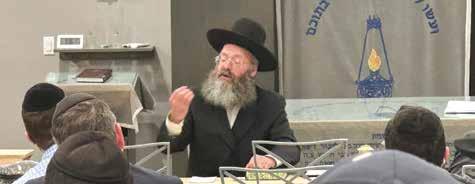

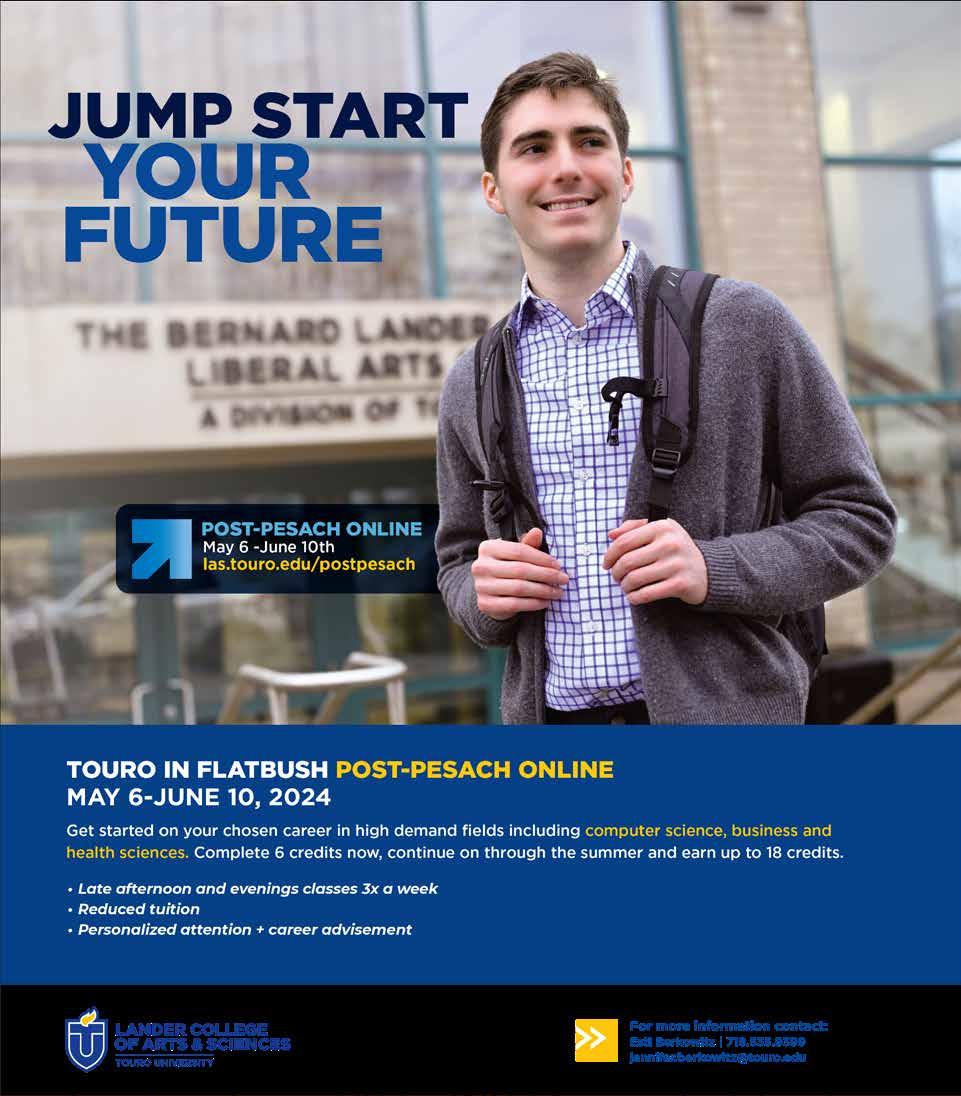

HALB’s eighth grade boys enjoyed a fun-filled day in NYC. They began the day visiting the Jackie Robinson Museum where they learned about the Civil Rights Movement and
Jackie Robinson’s contributions. Then they traveled to Ellis Island where they walked in the steps of their ancestors and learned about the immigration process.

At HAFTR, students eagerly delved into preparations for the upcoming Pesach holiday through a series of engaging activities and educational initiatives.
In the Early Childhood division, young learners participated in a Model Seder, immersing themselves in the traditions of Pesach. They also experienced the excitement of the Matzah Factory, witnessing the matzah-making process firsthand.
Moving up to the Lower School, kindergartners enjoyed their model Seder, adding to the festive atmosphere. Stu-
SKA students created a Makkot kit for Lev Chana students. This week, they got together, and the SKA students taught the Lev Chana students all about the makkot and gave them the makkot projects to take home for the Seder!



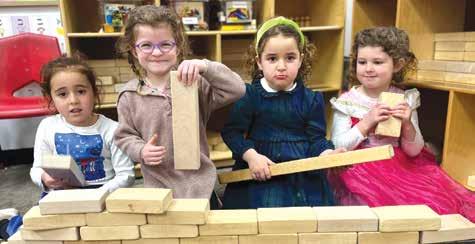
dents also made their matzah, enhancing their understanding of the holiday’s customs. They also explored Pesach-themed art projects, expressing their creativity while learning about Pesach symbolism.
A highlight was the “Pesach Around the World” program, where students discovered diverse customs practiced by Jewish communities worldwide. Students gained insights into the global tapestry of Pesach observances. A cherished tradition at HAFTR is the annual creation of personalized Haggadahs. Starting from first grade, students add new ideas and concepts each year, culminating in a
comprehensive and personalized version by fifth grade—a tradition that fosters a deep connection to Pesach.
In the Middle School, students delved deeper into concepts for their Pesach Haggadahs and engaged in creative art projects, such as crafting Bedikat Chametz candles.
These immersive programs equipped HAFTR students with the knowledge and skills to celebrate Pesach with meaning. As the community eagerly anticipates Pesach, HAFTR students are prepared to embrace the joy and spirit of the holiday.


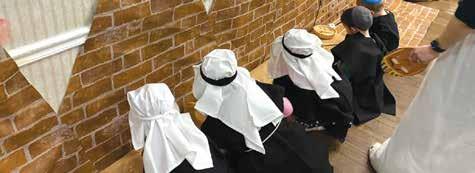

Children at Gan Chamesh were transported back to the time of Yetzias Mitzrayim through this realistic dramatization. They actually felt
like they were there, experiencing Hashem’s wondrous miracles. It was hands-on experiential learning at its best!

Last Monday, HALB 7th grade girls spent some time at the JCCRP, packing boxes for families in need for Pesach. Then, on Wednesday, the fifth grade girls went to help as well! It was a special feeling to help others in need leading up to Pesach.



Over the past year, the Hamasmid staff has been hard at work producing the first ever Hamasmid Haggadah, and they are excited to share it with the public! The students are thrilled with the results and are eager to use it on Pesach.
This Haggadah is created by students from Rambam Mesivta. It includes articulate commentary on the Haggadah composed by the students, rabbeim, and alumni of Rambam Mesivta. This edition features an introduction to the Passover Seder by Rav Yosef Zvi Rimon, the rav of the Gush Etzion area and the Nasi of World Mizrachi. It comprises innovative components to explain the Pesach Haggadah, such as “Halacha Highlights,” “What’s the Point?” and “So Everyone Will Ask.” This Haggadah will provide new insight and change the Seder night experience to the reader.
The Haggadah available on Amazon right now for purchase and can be

found by searching for “Rambam Mesivta Hamasmid Haggadah” or at https://a. co/d/7dwmDqg.


Mazel tov to all of HAFTR’s Middle School inductees into the Maor Program (an affiliate program of the Jr. National Honor Society). These students, as Middle School principal Dr. Josh Gold stated, “have distinguished yourselves as future leaders of the Jewish people, and therefore carry the special and unique responsibility
and opportunity to partner with Hashem in building a better world for tomorrow.” These students exemplify strong academic, character, and leadership traits inculcated by strong Jewish values. We look forward to seeing them shine bright and forge their paths as the future leaders of the Jewish people.

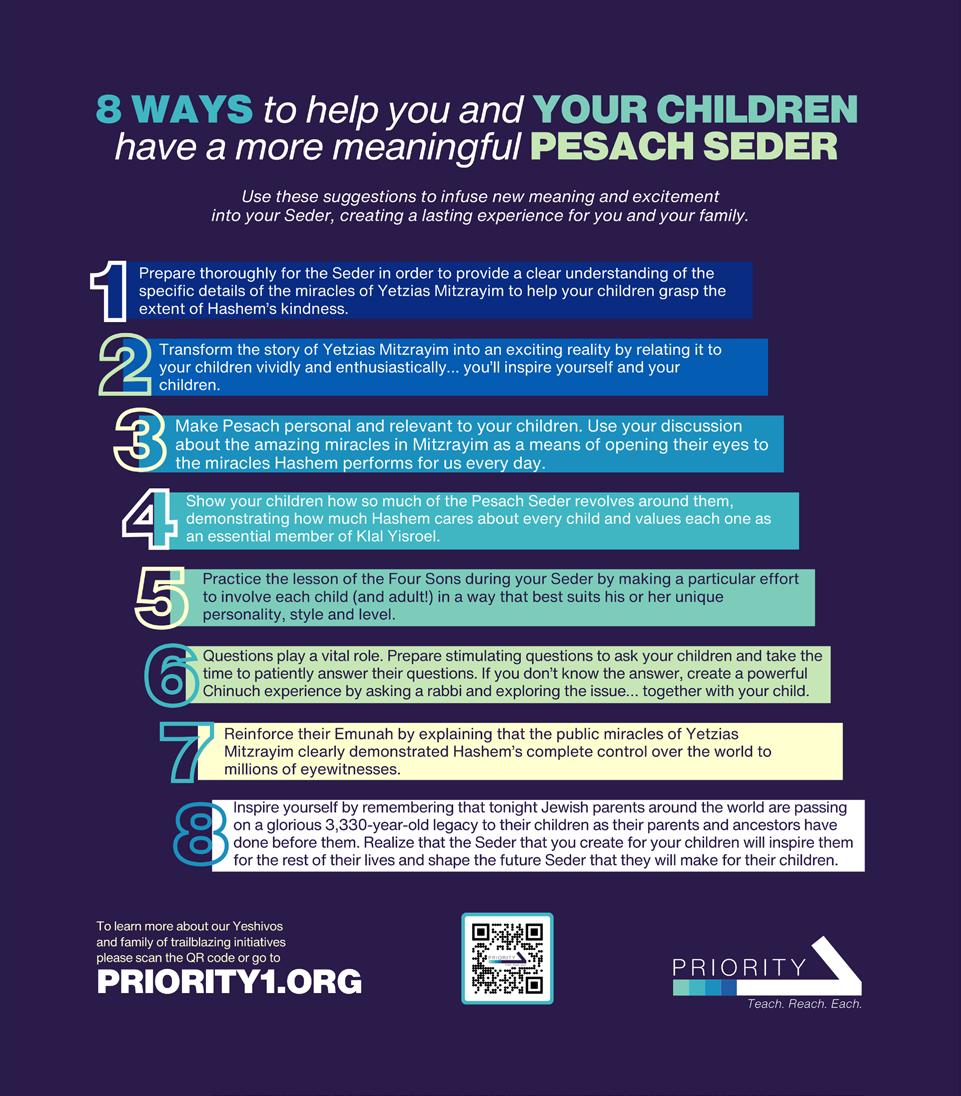


This past week a group of close to 40 talmidim headed to Capitol Hill to advocate on behalf of the State of Israel as part of MTA’s 8th annual MTAPAC mission to Washington, DC. This first trip since the 2020 pandemic had the Lobbying Lions heading to their meetings with a renewed sense of urgency as Congressional support for Israel is not something to take for granted in the aftermath of October 7.
While many MTA talmidim look forward to participating in NORPAC this May, this smaller trip empowered them with the opportunity to lead every step of the way. All of the meetings were arranged by our senior members of Hatzioni (MTA’s Israel Club and Publication) in the weeks leading up to the trip. In advance of the trip, the talmidim attended training sessions to learn about lobbying, become well versed in the current issues, and develop their own talking points.
After an early morning Rosh Chodesh davening and the long bus ride to DC, the talmidim were ready to take on Capitol Hill.

The trip was divided into 5 smaller groups, and each group, together with their faculty or parent chaperone, headed to the two meetings scheduled by their Senior Captain. Over the course of the afternoon, the talmidim were able to meet with the offices of six Senators and four members of the House of Representatives. Each meeting delved into the impact of October 7 on Jews around the globe, the importance of maintaining

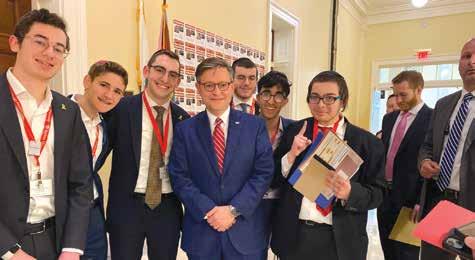
the strong alliance between America and Israel, the absolute necessity of Security Assistance without preconditions to Israel, and urging Congress to do whatever they could to bring home our hostages. Armed with facts, arguments, and passion, the talmidim made their case to the legislative aids and members of Congress that they were meeting with and engaged them in these important conversations.
After completing their meetings, the
talmidim enjoyed some free time on Capitol Hill, visiting the House and Senate Galleries and other sites located within walking distance. After a quick trip to Pershing Park opposite the White House to witness the 5 p.m. taps and daven Mincha, the bus headed back to MTA – filled with tired talmidim from the long trip, but energized from their productive day of lobbying.

The 5 Towns Flags Football League has had a remarkable season. Students from Pre-1A to eighth grade have been enjoying the game of football with great enthusiasm. In addition to the exciting flag football matches, the boys are benefitting from regular exercise and forming new friendships. This league, now in its 10th season, serves as a valuable platform for boys in the community. The league is managed by a dedicated team of adults, college students, and high
school boys who strive to ensure that everyone has a positive experience. With a few games remaining before the Super Bowl, anticipation is high for the upcoming season starting in early September. Wishing all the players a good yom tov and looking forward to the remaining games of the season and free FM Home Loan authentic NFL football giveaway for all participants. www.5townsflagfootball.com.


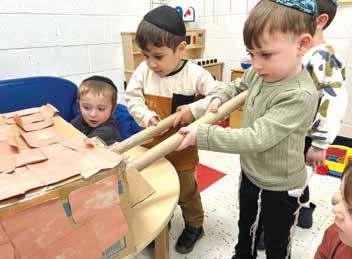
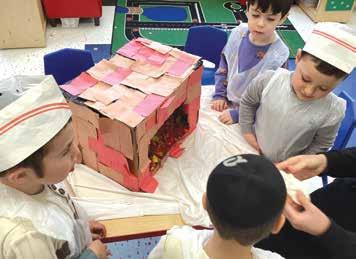
Nursery Aleph, Nursery Bet, and Kindergarten students baked matzah at Mercaz Academy in Plainview, New York, following the steps of the process from wheat to crunch. Under the auspices and supervision of Chabad of Forest Hills North, the pop-up matzah bakery opened in the cafeteria at Mercaz Academy, and a pair of master matzah bakers traveled all the way from Israel to train their new employees in the proper technique. Of course, the new bakers donned protective aprons and adorable hats before they got started.
After examining what wheat looks like
after it’s picked and still on the stalk, students took turns at the hand mill, grinding the wheat kernels into flour. The young bakers were informed that the flour and water must be kept completely separate until the last few moments, to minimize the risk of the baking process lasting too long. (Asked what the maximum time for the entire process should be, the room rang with shouts of “eighteen minutes!”)
Knowing that going over the 18-minute time limit creates chametz rather than matzah, students stood isolated but ready in the flour booth and the water booth, adding their ingredients to the bowl car-
HANC’s Early Childhood Center in West Hempstead is bursting with activity as the children prepare to be active participants in their families’ Sedarim. In addition to learning the story of Pesach, the many brachot that are recited and the songs that are sung during the Seder, the yeladim are utilizing a myriad of modalities and artistic techniques to create ceremonial objects that they will be able to share with their families. As each class prepared their handmade Haggadot, the children used a multitude of skills including writing, cutting, pasting and painting, and created magnificent Haggadot with removable items to encourage interaction during the Seder. The Nursery Aleph children also made matzoh trays decorated with paint and tissue paper, Afikoman bags crafted from felt, card stock or fabric and sewn using their lacing skills, and
beautiful matzoh covers personalized with their picture and spray painted or designed by placing multicolored tissue squares on white fabric and then spraying water to transfer the color onto the fabric. The results were positively magnificent.
In Nursery Bet classes, the children decorated pillow cases with tie dye and fabric paint, each one unique and colorful. They also crafted beautiful seder plates and a three-tiered matzoh tray to enhance their families’ Seder tables. The love and hard work that went into these magnificent creations will certainly be keepsakes for their families in the future.
The experiential method of learning has permeated all aspects of their Pesach preparation. As each class learned the Pesach story, the children acted out the scenes using costumes and props. The children built models of Egypt in the
ried between them by a third student. The flour and water were quickly mixed into dough, and each young baker was presented with a ball of matzah dough to roll and with a fork to puncture it for extra crispness. After this, the dough was baked into matzah, which each baker took home in a proper matzah box–unless it was sampled on the way.
All the young bakers agreed that they had a great time, and they look forward to future seasonal employment in the matzah factories of Long Island.

block corner and dug their hands into colored sand to find the (plastic) wild beasts that were hidden inside. Melodies of Pesach songs, including the “Ma Nishtana,” could be heard all day long in the hallways, as the children dutifully practiced so they would be prepared to sing at the Seder.
The children enjoyed an elegant model Seder sponsored by the PTA. They sang the “Ma Nishtana” and all the brachot and songs that they have been learning these past few weeks.
With great anticipation, the yeladim will pack up all of their projects at the end of the week and carefully carry them home to present them to their adoring families. Not only will their projects adorn the Seder table, but their singing and recitation of brachot will certainly be a source of joy and pride for all of their families. “The morot did such an excel-

lent job working with all of the children to ensure that they would be prepared,” said HANC ECC Director, Trudy Rubinstein. We hope that the families have so much nachat from their children!

As we near the end of the spring semester, there’s a bittersweet excitement running through the halls of the Yeshiva University High School for Girls (Central): regular classes are coming to an end for the class of 2024, and starting April 15, the senior class will enjoy an annual Central tradition: Senior Seminar!
The seminar is a practical, well-rounded educational week for those soon to make their departure and enter the real world. Seminar week was preceded by senior experiences that dotted the months of the spring semester and included, among other things, an outing to Yeshiva University’s Seforim Sale. Sessions for this week include “The Secret to Winning with Money” with certified financial planner and Senior Financial Advisor to the Achiezer Team, Ms. Stacey Zrihen, “How to Keep a Kosher Kitchen” with Central’s very own Mashgiach Ruchani, Rabbi Joshua Goller, a presentation from Mr. Jared Sharf, Assistant Director of Community Outreach at the Organization for the Resolution of
Agunot (ORA), a talk on genetic testing from board-certified genetic counselor, Ms. Raizy Abittan (YUHSG class of 2014), and Women in Jewish Law (WIJL) sessions with Central’s Head of School, Ms. Bracha Rutner, and Judaic Studies faculty member, Mrs. Yael Axelrod. Sessions on healthy relationships, eating disorder awareness, a trip to the mikvah – and even kickboxing sessions and how to change a tire! – will cap off the experience. Central seniors look forward to the seminars every year for a reason: they are useful, thought-provoking, and fun, providing a warm, familiar introduction to new and unfamiliar terrain.
“Central was a great trial run for life, and Senior Seminar and internships are going to be the best ending to that trial so we can get started doing our part as citizens of the world,” said senior Elisheva Ilyayeff. “I am excited to learn important skills for life, and I am even more excited to carry those skills out in the real world.”
Immediately following the school’s break for Pesach will be the second phase of this real-world education: se -


nior internships, which will run through the month of May. This end to their high school careers inspires these soon-to-be graduates to embrace the future.
“I am looking forward to learning new things and experiencing parts of the real world,” senior Meira Schuck reflected. “I think that my internship will teach me about the experience of owning and running a business, and I am looking forward to that. Throughout these next
two months, I will learn many valuable lessons that I would most likely not find elsewhere.”
Additional upcoming senior events include the senior Shabbaton in New Rochelle, the Central Senior Dinner, and of course, the graduation of the class of 2024, which will take place on Wednesday, June 5, at Lamport Auditorium on the campus of Yeshiva University.
Time marches on, and we find ourselves just one week away from the great yom tov of Pesach! There is so much to do in that Erev Pesach frenzy, and we will all make it to the Seder. We may not have time to finish all the spring cleaning that comes along with the Pesach cleaning but we will sit at the Seder and work to feel the chairus (freedom).
I wonder, will each Jew feel chairus this year? How is it possible amidst so much untold pain and sorrow, the individual and collective throngs of hardships including the war that Eretz Yisroel was thrust into on October 7! The list of pains is not something I want to enumerate as I want the reader to be left with positive energy. I would like to suggest something that can be done to alleviate suffering and bring simchas Yom Tov.
Inviting guests is one of the key ways of “emulating G-d.” In describing the mitzvah to walk in G-d’s ways, the Talmud says: “Just as He is merciful, so you be merciful. Just as He is kind, so you be kind.” Even greater than talking to G-d is to be like G-d. G-d is a giver. We are cre-
ated in the image of G-d; thus, giving is our greatest form of spiritual expression. Avraham Avinu achieved great spiritual levels because he emulated G-d by welcoming guests into his home.
We aim to emulate our Avos, and so we want to do the mitzvah the way it ought to be, as Avraham Avinu taught. To your guest, the warm smile and greeting on your face and the feeling of being wanted on his exodus (pun intended!). All else is a bonus and can be done without. This begins with the way the invite is being conducted – an old-fashioned phone call, “Hi, this is ____. We would love to have you join us if you are available. You can get back to me to let me know.”
As I’ve penned before, let’s say you cannot host for whatever the reason. Still, any kind of reaching out is so very much appreciated! Think of someone who doesn’t receive gifts from a spouse and perhaps reach out with some small gesture. A phone call on chol hamoed or an invite for lunch/dinner, or trip… your style, means the world – reach out in whatever way works for you!
Please feel welcome to share your stories of reaching out to bemyguest@whiteshul.com.





MTA’s robust elective program features a popular Graphic Design class, taught by Mrs. Leah Korach, a multi-disciplinary artist. For the past few weeks, her tenth and eleventh grade classes created beautiful, custom seder plates. This process began with a digital design that was later transferred onto the seder plate. The design was made using several different online tools, and once completed, they were printed with a Cricut so that the design could be painted on the plate. The stencil design was placed on top of the plate, then peeled off layer by layer as the students painted it. The last step in the process was firing the seder plates in the kiln.
This unique project allowed the boys to express their artistic creativity while utilizing the concepts learned in the context of their Graphic Design class. The project took six weeks from start to finish, and around 38 plates were created. This was the first time Mrs. Korach
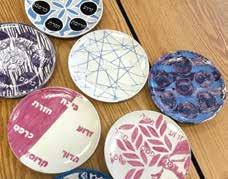
did this project, and she was really impressed with the way the talmidim took ownership over their plates and really enjoyed the process.
The boys felt that the designing of the seder plates was the most challenging part, as they did not fully realize the connection between the design and the end result. The painting, though tedious, was really relaxing and enjoyable. By the time they were done, there were several that looked like they were made by professionals. Mrs. Korach looks forward to completing this project in future years!
Aim Hire is a nonprofit organization which provides employment with dignity.
We help individuals who are over the age of forty, have been unemployed or underemployed for more than three months, and who are facing the financial obligations of supporting themselves and their families. Our goal and mission is to place our candidates in new, well matched jobs, jobs that will provide them with the potential to build lucrative and long-term careers.
Previously struggling families are now able to pay for their basic food and medical bills, keep their children in private religious schools, maintain marital harmony, and enjoy a newfound sense of dignity and purpose.
Aim Hire helps countless others with career coaching, resume writing and interview preparation. We also provide
much needed emotional support to our job seekers as they work through this difficult chapter in their lives.
One feature that sets us apart from all the others is that our organization offers salary subsidies to our job benefactors, the partnering companies who believe in our mission and who hire our candidates.
In order to continue supporting our platform and to raise awareness for the cause, we will be hosting our third annual fundraiser. The benefit dinner will take place at Tabernacle Steakhouse on May 29. With great pleasure, we invite you to join us for the evening and be our partners as we help to provide job opportunities to the families who need assistance.
Sponsorships are available. Please reach out to info@aimhire.org.




In the vast landscape of mental health, where challenges often loom large and resources seem scarce, a glimmer of hope emerged recently in the form of a truly impactful event. Hosted by Achiezer, a beacon of community support, this gathering represented not just a milestone but a testament to the unwavering commitment to bridge the gap between resources and the pressing needs of our community.
Achiezer’s goal to expand resources, foster collaboration, and cultivate a culture of compassion within the mental health realm is a tireless pursuit.
“Our foremost priority has always been accessibility,” emphasizes Rabbi Boruch Ber Bender, president and founder of Achiezer, echoing the sentiment shared by many in our community.
The addition of Shragi Chafetz to the Achiezer team marked a significant leap
forward in this ongoing journey.
“With the addition of Shragi, we’ve been empowered to take these crucial steps.”
His arrival infused renewed energy and enthusiasm, laying the groundwork for the remarkable event that would soon unfold.
Meticulously organized with precision and passion, the event drew an impressive turnout of over 110 mental health professionals and esteemed school administrators. “It was truly awe-inspiring,” reflects one attendee. “The palpable sense of camaraderie and shared purpose was simply invigorating.” Participants eagerly immersed themselves in a plethora of networking opportunities, engaging discussions, and collaborative brainstorming sessions—an evening of shared experiences and collective wisdom.
At the heart of the event were two distinguished speakers whose expertise

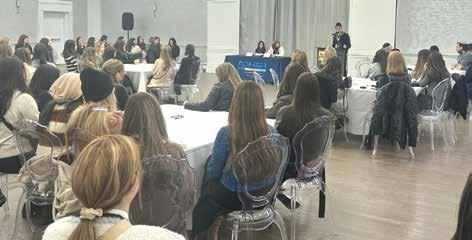
and insights captivated the audience. Dr. Helena Rothbart, a revered psychiatrist renowned for her tireless advocacy and unwavering dedication to the community, took center stage alongside Dr. Malky Zacharowicz, a highly respected psychologist revered for her profound understanding of child assessment and diagnosis.
Dr. Rothbart’s presentation proved to be illuminating for therapists, providing a comprehensive overview of medication classifications commonly used in treating anxiety and depression. She emphasized the importance of therapists aiding clients in making informed decisions regarding psychiatry consultations, delving into topics such as common side effects, risk of addiction, and the role of “crisis meds.” Moreover, she underscored the effectiveness of a combined therapy and medication approach in treatment.
Meanwhile, Dr. Zacharowicz’s insights into neuropsychological evaluations offered therapists invaluable guidance in understanding the process and its implications for client care. With clarity and expertise, she elucidated what cli-
ents can expect during scheduling, highlighted key information from reports beneficial for therapists, and addressed queries regarding the timing and perceived cost of evaluations. Her guidance shed light on the significance of neuropsychological assessments in enhancing therapeutic interventions and informed decision-making.
While the discussion inevitably touched upon medication management and neuropsychological evaluations, the overarching focus remained firmly rooted in broader strategies for community care and support. Indeed, the event served as a veritable springboard for collaboration and action, and most importantly the efforts continue in seeking and finding the best and most appropriate resources available for our community members who need them.
The event’s impact extends far beyond its immediate confines. It serves as a call for change, inspiring conversations and igniting initiatives aimed at breaking down barriers, fostering understanding, and creating a brighter, more compassionate future for all.

It was week 3 of the 5TLL season by FM Home Loans this past Sunday, and there were some incredible games and competitive action! It was also Picture Day since this was the last Sunday of games until after Pesach.
K/P Baseball & Soccer Highlights
K/P Baseball: In a nail-biting matchup, Bright Futures and Hewlett Auto Body ended in a thrilling tie. Hewlett Auto Body’s infield dynamo Pinny Neumann showcased his hustle, while Refael Rosenberg of Bright Futures covered left field like a blanket, ensuring no hits slipped past.
K/P Soccer:The Wieder Orthodontics team shut down Tikva Fire with a clean 2-0 victory, thanks to a dazzling twogoal performance by Yaakov Grossman. Defensive stars Ruby Wieder and Yoyo Eichorn, alongside Grossman, kept their goal impenetrable.
1st/2nd Soccer: Donny Grabie was in top form for Wieder Orthodontics, leading the charge in a decisive 5-1 triumph over Tikva Fire. Meanwhile, Benjy Blumenthal doubled the fun with two goals in NOJO Promo’s 3-0 victory.
Highlights
1st Grade: Shua Sod hit a home run, propelling Wieder Orthodontics to an 18-13 win over Cork & Slice. Ezra Gruen debuted with a bang for OpenVeranda, hitting a double and a home run against Spray Foam Insulation.
2nd Grade: Avi Genachowski was the hero with a walk-off 2-run homer, clinching an 18-17 nail-biter for Tikva Fire against Town Appliance. Momo Caller’s walk off triple was the talk of the town as Johns Automotive edged out Dr. Fluency 12-11. Yitzchak Schattner was a ground ball magnet and a hit machine for Insight Optiks, who cleaned up with a 15-5 win over Executive Dry Cleaners.
3rd Grade: Dovid Young hit a grand slam, giving BayRock Insurance a narrow 10-9 victory over Emerald Health Care. Ari Pearlman sent one deep for Molly’s Jewelers in an 18-8 rout of Signature Coverage. In a seesaw battle, 5TownsCentral erupted for nine runs in the sixth, taking down Marciano Pediatric Dentistry 12-11.
Majors (4th Grade & Up)
Baseball Highlights
4th Grade: Dovid Schattner hit a 3-run triple for Tikva Fire, flaming past Elegant Lawns 15-2.
5th Grade:Levi Jeger flew high with a walk-off sac fly, clinching a 4-3 victory for DOMA over Marciano Pediatric Dentistry. Yosef Seplowitz unleashed power with two 2-run homers, landscaping a 22-9 victory for Five Towns Landscape over BayRock Insurance.
6th Grade: Dov Kreisman was unstoppable on the mound, pitching a shutout four innings as Carving Block sliced through Wieder Orthodontics 159. Moshe Shlomo Gold struck gold with a walk-off 2-RBI single, leading Maidenbaum to a 9-8 victory over Sliced.
7th/8th Grade: Maidenbaum jumped out to an early 10-run lead, but Bathtique did not give up. They scored 8 runs to cut the lead to 2, heading into the final inning where they managed to get the winning run to the plate but Maidenbaum’s defense held strong to complete the victory.
In 7th/8th Baseball, Wieder Orthodontics had a comfortable 12-run lead going into the last inning, but JNT wasn’t ready to give up. Storming back, they closed the gap to just 4 runs. As the tension peaked, Benyamin Zeidel stepped up for JNT and delivered a grand slam, earning him the MVP title and tying the game in the dramatic final moments, forcing it to end in a draw.



Rav Oelbaum spoke at Aish Kodesh last week for a special

Yeshiva Darchei Torah’s seventh and eighth grade science and engineering team (posing with Rabbi Nachum Dinowitz, right) shared a third-place win with YBH of Passaic in a prestigious contest joined by 45 yeshivos and day schools under the CIJE (Center for Initiatives in Jewish Education) umbrella.
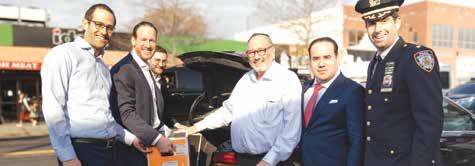
As costs continue to soar due to global inflation, Met Council has launched an emergency fundraising appeal to ensure the Jewish organization can provide free food to the more than 300,000 Jews who rely on the organization’s free food distributions for Passover across the tri-state area.
More than 230 distribution events have been strategically organized across all five boroughs of New York City, as well as in Westchester, Albany, Connecticut, and northern New Jersey. These events serve as crucial access points for individuals and families in need, providing them with essential Passover supplies in a dignified manner in their communities.
“Passover is already the most expensive time of year for Jewish families especially those who are already financially struggling, as the holiday’s customs require essentially a full changeover to
kosher-for-Passover foods for pantry staples, special foods, and other holiday essentials,” said Met Council CEO David G. Greenfield. “For too many people this comes at a time of continued increases in rent, fuel and other basic expenses creating a greater struggle now more than ever before.”
The Passover provisions Met Council is distributing encompass a diverse array of kosher for Passover foods such as matzah, kosher for Passover chicken, gefilte fish, eggs, tuna, and an assortment of beverages including apple juice and grape juice. Additionally, the packages contain staples like apple sauce, biscotti, borsht, cake mix, chopped walnuts, cocoa powder, jam, lemon juice, macaroons, matzah meal, matzah brei mix, oil, potato starch, sugar, tomato sauce, vinegar, as well as an assortment of fruits and vegetables including mandarin or-
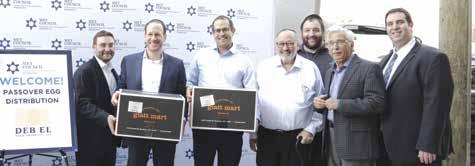
anges, peaches, pickles, and potatoes.
Outside of the food distributions, Met Council has already distributed nearly $500,000 worth of emergency food cards to help thousands of low-income families mark the holiday with dignity. Many of these families also have young children.
“Our Passover distributions come at a time when the community needs our support more than ever,” said Jessica Chait, the managing director of Met Council’s food programs and policy. “By providing essential provisions to hundreds of thousands of households, we’re enabling access to nutritious foods and ensuring that individuals and families don’t have to sacrifice tradition to meet their basic needs.”
For more information and to participate in the campaign, please visit: https://www.metcouncil.org/PE24MC
This past week, Mesivta Ateres Yaakov held their Annual Bein Haz’manim Yarchei Kallah on inyanei Pesach. Although primarily geared for alumni returning from Eretz Yisrael for bein haz’manim, the Yarchei Kallah also attracted alumni from the greater community. This year’s program drew dozens of graduated talmidim for shi-
urim, learning, schmoozing and “catching up.”
Each morning following Shacharis, alumni were treated to a lavish breakfast during which they caught up with friends, current talmidim and rabbeim. Seder began with shiurim on the Haggadah providing insightful divrei Torah for talmidim to share at their own Sedarim.
Following the Haggadah shiurim, talmidim, together with the 12th grade, were provided ma’arei mekomos with which to prepare for the day’s iyun shiur on different Pesach-related topics.
Rabbi Yossi Bennett, Menahel, commented, “This event is one of our most highly anticipated events and a highlight of our year. It’s so gratifying to see our
Founded in 1972, the Metropolitan Council on Jewish Poverty (Met Council) has been fighting poverty and promoting the social welfare of New York’s struggling populations including the impoverished, immigrants and the elderly. Its “Kosher Food Network” is the largest kosher food pantry program globally. Its social services programs support tens of thousands of New Yorkers through direct assistance and by helping to register them for applicable government programs. These include programs supporting victims of domestic violence, the elderly, Holocaust survivors, and those experiencing other financially based crises. Met Council is also the largest owner and operator of affordable housing in the Jewish community. For more information, please visit https://www. metcouncil.org.
talmidim return from Eretz Yisroel or yeshivos in America to learn with their Rabbeim. It is a huge chizuk, both for Rabbeim and current talmidim. It bears testimony to the strong connections and relationships that were forged while they were here at the Mesivta and that those relationships remain intact.”

Beginning back in December 2023, fourteen Mercaz Academy fourth and fifth graders, bursting with excitement, competed in the elementary division of the CIJE Robotics League Tournament. It was the culmination of months of hard work in which the extracurricular Robotics Club spent one or more recesses each week working together to build robots for the tournament under the guidance of Director of Educational Technology Lynda Last.
On Wednesday, April 10, the members of the Robotics Club returned to the field once more to compete in the final CIJE Inter-Yeshiva Robotics League Tournament’s event for the year. This time, the event was held at Manhattan Day School and was entirely devoted to the elementary school category, so the Mercaz teams would not be sharing the floor with middle- and high schoolers as before. They knew that they would be operating on a different “field,” with updated tasks, and there may have been some nervousness as they entered the competition hall.
The event was fast-paced and stressed cooperation, with the five Mercaz teams collaborating and competing with 82
teams from other schools at each round. They hopped from match to match, and some were surprised to encounter old friends from camp, as competitor schools arrived from as far away as Pittsburgh. The Robotics Team was delighted to discover that this time, each match allowed an opportunity to be awarded badges for outstanding robot design, how effectively students were able to maneuver through tasks, and sportsmanship with both teammates and other school teams. As the Mercaz teams moved through their 30 individual matches, they racked up badges–and accumulated many points. They were delighted to see Mercaz rising through the ranks with each match. In fact, they started to wonder…would they be among the final three?
“Towards the end of the last match, we thought we had third place…but it was hard to believe, because there were so many bigger schools,” said one Mercaz fifth grader. “Our school was the only one there that didn’t have a middle school or high school, and there were lots of good teams.”
As the first place (Yavneh Academy, Paramus, NJ) and second place (SAR, Riverdale, NY) winners were an-

nounced, it seemed impossible…but the final school on the podium was Mercaz Academy.
“We were jumping up and down and screaming,” another fifth grader remembered. “It felt great!”
Pre-Pesach preparations. The phrase makes many shudder. Even those who choose to go away for the holiday have palpitations as they shop and pack and make the various arrangements necessary to pull off an enjoyable experience. Those who stay home may not have to deal with flights and suitcases, but the cooking, stocking and cleaning
can be overwhelming. Although we have all learned that getting ready for Pesach does not have to be as all consuming as it used to be, preparing for the holiday is still a huge challenge.
Now imagine facing these holiday challenges as a single parent. Sometimes not sure until the very last minute if you will have your kids with you or if you will be on your own. And if you are on your own – or even with your kids – wondering if there will be any yom tov dinner or lunch invitations coming your way this year. Hoping you won’t be by yourselves for the entire holiday. Imag-
ine watching your friends and neighbors packing up for out of town holiday trips or busy preparing their homes for their extended families and not being able to share their excitement. And imagine trying to buy those expensive Pesach groceries or a new outfit for your children or yourself as a one income family on a severely limited budget.
At the Marion and Aaron Gural JCC, we don’t have to imagine these challenges. In our Kadima program for single Jewish parents over 450 single parent families have come through our doors sharing their struggles, their disappointments and their pain with our staff. While throughout the year we are in touch with all our families offering various support, services and programs for both the children and parents, we are especially sensitive to the feelings of loss and despair that emerge as the holidays approach and the family unit is not whole.
Soon after our annual Purim party this year, we immediately got into gear preparing for the next challenge. Our support groups, for women, men and children, focused on the upcoming trials associated with the dynamics of making Pesach as a single parent.
The camaraderie and shared frustrations as well as ambitions helped members know they were not facing these feelings alone.
With the help of a team of incredible volunteers, we put together a boys’ suits and Shabbos wear event where more than forty clients were able to shop for up to date clothing in excellent condition for their sons. Over eighty families staying home for the holiday received a box of assorted Pesach groceries, including both perishables and non-perishables, as well as Shmurah matzah, grape juice and other essentials, sponsored by our dear friends, the Ramer family. In addition, the S.H.O.P., our food pantry, has been providing special holiday grocery
Congratulations to Mercaz Academy’s successful Robotics Club and to Mrs. Last. The Robotics Club can’t wait to come back to compete in next year’s tournament!
packages to our clients in need, supplementing their regular monthly shopping. Our amazing friends at the Merrick Jewish Center once again sponsored Stop & Shop gift cards for our single parents to help address the endless food and supplies needed this time of year.
Our single parents might be struggling but they are not doing it alone. Whatever the needs or time of the year, the Kadima staff is on hand to listen, assist, provide and refer. Pre-Pesach preparations may be daunting, but every month of the year provides its own set of challenges for a single parent. At the Gural JCC, we face them all together and then work to move forward.
If you or anyone you know is a single Jewish parent, please contact Rachayle Deutsch at the JCC Kadima program at (516)569-6733 ext. 222.
The Marion and Aaron Gural JCC is a proud non-profit partner of UJA-Federation New York.

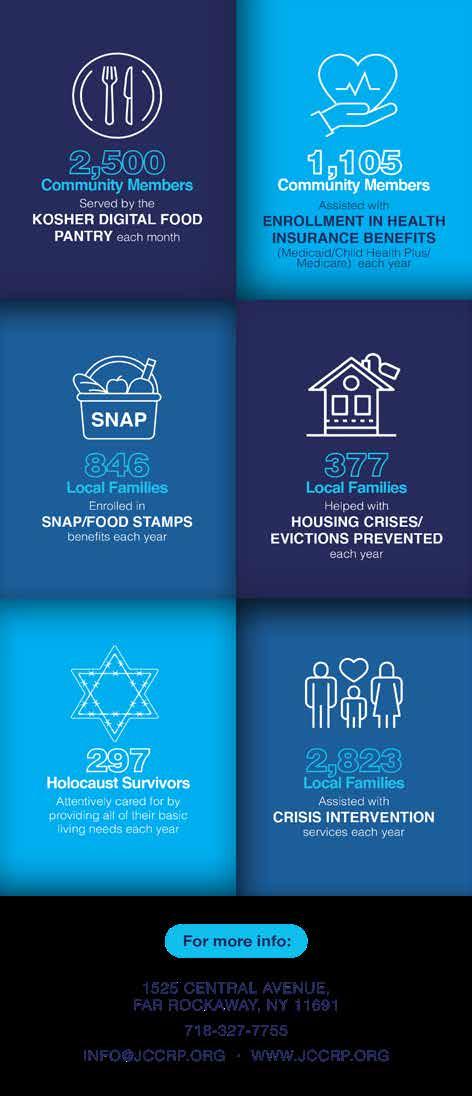

The Pre-1A classes at Siach Yitzchok enjoyed a beautiful Pesach Seder with their rabbeim
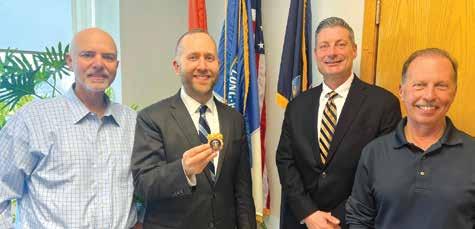
L-R: Long Beach City Manager Daniel Creighton, Rabbi Benny Berlin, Acting Police Commissioner Richard DePalma, and Deputy City Manager Philip L. Ragona
Rabbi Benny Berlin, the rabbi of the BACH Jewish Center, was recently appointed to serve as a chaplain to the city of Long Beach’s police department. The ceremony was attended by City of Long Beach City Manager Daniel Creighton and Deputy Manager Philip L. Ragona and was presided over by Acting Police Commissioner Richard DePalma.
As a chaplain, Rabbi Berlin will provide spiritual support to officers of the Long Beach Police Department and the communities they serve. His role will entail counseling, participating in ceremonies, supporting and advocating for the spiritual needs of officers and the constituents they serve while building bridges between the department and Long Beach’s burgeoning Jewish community.
“It is a great honor for me to serve as chaplain to the dedicated men and women of the Long Beach Police Department,” said Rabbi Berlin. “I look forward
to working alongside those who tirelessly serve our community offering them support, guidance, and spiritual care as the needs arise and advocating for the emergent needs of our Long Beach community.”
“Since taking the helm at the BACH Jewish Center, Rabbi Berlin has worked in partnership with us to develop programming bringing together his congregation and our department,” said Acting Police Commissioner Richard DePalma. “The synagogue’s annual Police appreciation barbeque and other communal events hosted by Rabbi Berlin and his community provide our officers with the opportunity to develop and foster relationships with the community we serve.”
“Rabbi Berlin is already a close friend of the department, and we look forward to further growing our relationship with him in his new role as department chaplain,” he added.

Rav Yaakov Bender, Rosh HaYeshiva of Yeshiva Darchei Torah; Mesivta Chaim Shlomo menahel Rav Zevi Trenk; Rabbi Boruch Ber Bender, president of Achiezer; and a delegation of Darchei talmidim visited the 101st
Precinct house of the NYPD last week to honor the memory of fallen officer Jonathan Diller. Three sixth grade talmidim (at left) presented their own, hand-made sign as well: Alexander Gluck, Gavriel Reisz, and Naftali Richter.

HAFTR High School is proud to announce that five students have qualified to compete in the upcoming National Speech, Debate & Model Congress Tournament in Des Moines, Iowa, this June. This is the second year in which HAFTR students will compete in the National Speech & Debate Association (NSDA) National Tournament. Juniors Sophia Feiler and Kayla Fauziev and freshmen Gigi Hersh, Jessica Kass, and Rachel Stein will participate with over 6,000 students from throughout the US. They will be accompanied by 17 other Shabbat-observant students from New York, New Jersey, and Florida representing the Citron Online District (www.citrononline.org).

HAFTR High School was the first yeshiva high school to join the NSDA. HAFTR Coach Mr. Alex Libkind petitioned NSDA for a special, national online district to accommodate Shabbat-observant students. Historically, the National Tournament has been held during the week, but to qualify, students were required to compete on Shabbat. NSDA recognized this problem and agreed to create the national Citron Online District to qualify yeshiva students for the National Tournament. In the fall of 2022, the NSDA awarded a district charter to Citron Online for students who cannot compete on Fridays or Saturdays.
Wishing much success to our students in the tournament!
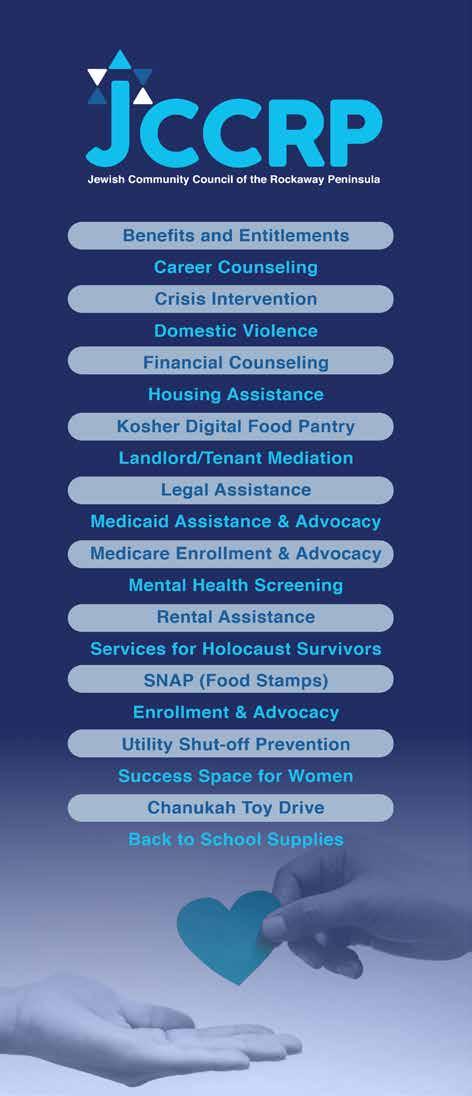
Since its humble beginning in 1975, Laniado Hospital of Netanya, Israel, has developed into a modern and extensive medical center serving a region of over 500,000 residents.
Over the past ofur years alone, Laniado has opened a state-of-the-art ICU, NICU, Emergency Ob-Gyn Center, Delivery Rooms and Dialysis Center, among other significant capital improvements. Where possible, each project is sheltered – meaning it is protected against missile and biological attacks and earthquakes. If such a scenario were to happen, instead of mass evacuation, bombproof doors are closed, and everything in the department can continue without interruption.
Most recently, Laniado has undertaken to build a sheltered Emergency Hospital and Trauma Center. Although plans were underway earlier, October 7th confirmed the need for a sheltered facility.
The new hospital will boast 4 floors –
over 53,000 sq. ft. – quadrupling the size of the existing ER and provide peace of mind to patients and staff. With 60 beds/ patient stations, a robust Trauma Center, and complete Imaging Center, the new sheltered Emergency Hospital will take emergency medicine to a new level.
This news is very welcoming, especially for new olim who are moving to Netanya’s Poleg and Ir Yamim neighborhoods.
Tammy and Daniel from NYC recently purchased an apartment in Netanya. “As we look towards retirement, we thought why buy in Florida, our future is in Israel! We love the centrality of Netanya. Knowing our new city has a hospital that is developing and creating the infrastructure needed to care for its population was a big factor,” shared Tammy.
In addition to serving civilians, Laniado is a back hospital for the IDF’s northern command. As this article goes to print, numerous medivac drills are

taking place.
Laniado’s founder, the late Klausenberger Rebbe, zt”l, who lost his wife and eleven children during Holocaust, dedicated his life to rebuilding and caring for Am Yisrael’s guf and neshama – body and soul. Laniado encompasses both.
Holding steadfast to its founding mission, Laniado does everything possible to save a life and alleviate the physical and emotional pain of a patient with kindness

and compassion. The new Emergency Hospital is another step to ensure patients receive the best possible care in a safe and secure environment.
Chanan Daniel Skurnik is the Executive Director of the Laniado Development Fund Mid-Atlantic. He can be reached at dskurnik@laniadofund.org or via www. laniadofund.org.


It was truly shocking and enlightening to watch the Shulamith second graders finish off their STEM unit on electricity, teaching first graders what they have been learning with interactive projects, demonstrations and activities. The first graders were excited to learn more, and the second graders showed true leadership and perseverance as they learned to solve their own problems and worked in teams to bring their learning to light!

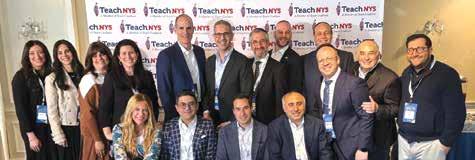

On Sunday, three groups of students from HALB competed in the NY State History Day after advancing from the Regional competition a few weeks ago. They competed against the best groups from all over NY
ALB had an extremely strong turnout at the Teach NYS Breakfast on Sunday. Teach NYS has
been instrumental in securing state funding for our yeshiva, and we thank them for their hard work!

State. HALB took home Second Place Junior Group Exhibit and Second Place Junior Group Website! Both groups will be
moving on to National History in College Park, Maryland, to compete against the top groups in the country in June.




On Monday, April 15, 2024, Assemblyman David Weprin sponsored a resolution to commemorate the anniversary celebration of the Lubavitcher Rebbe, Rabbi Menachem Mendel Schneerson’s 122nd birthday. The resolution calls for 122 days of education in honor of Rabbi Menachem Mendel Schneerson, who served over 45 years of dedicated leadership.
Rabbi Shmuel Butman, the Executive Director of the Lubavitch Youth Organi-
zation, opened the Assembly session with an inspiring invocation. He was also introduced on the Assembly floor. Rabbi Butman explained how we should all be giving of ourselves, even in the smallest of ways. He asked that everybody should put one dollar into the pushka, the charity box he brought with him. Good deeds start small, and one good deed turns into another good deed. Many legislators added their dollars and joined in the spirit of giving.
Assemblyman Weprin said, “It’s a
great pleasure to welcome Rabbi Shmuel Butman here to celebrate this momentous occasion and the passing of this resolution for the 122nd birthday of the Lubavitcher Rebbe. We will dedicate 122 days of education in New York State.”
Assemblyman Weprin, Assemblyman Brian Cunnigham, and Senator Zellnor Myrie hosted a luncheon reception to celebrate the 122nd birthday of the Lubavitcher Rebbe, Rabbi Menachem M. Schneerson.

Assemblyman Weprin with Rabbi Shmuel Butman, Executive Director of the Lubavitch Youth Organization
In a historic moment for NSHAHS, the boys’ Torah Bowl team clinched their first-ever championship – marking a monumental achievement in the school’s history. Led by Rabbi David Weiss and senior co-captains David Hanan ‘24 and Ethan Kohananoo ‘24, alongside Oded Azarahian ‘24 and Ben Zareh ‘24, the team’s undefeated streak (16-0) showcased their exceptional knowledge and teamwork.
Their journey to victory was no easy feat, with hard-won triumphs over for-
midable opponents from Magen David, HAFTR, Barkai, Flatbush, and HANC. The championship was an intense game against Frisch, MTA, and Rambam Mesivta, culminating in a close finish with North Shore clinching the win on the 105th question. The comprehensive coverage of Sefer Shemot with Rashi’s commentary tested their depth of understanding and rapid recall skills, highlighting their dedication to Torah study.
Similarly, the girls’ team achieved a commendable second place, a first-time
When war erupted between Israel and Gaza, we felt the ground shake beneath us. An invisible wave of collective trauma swept across the nation. Shock. Fear. Uncertainty. For the first few months, survival was the only goal.
Trauma, as we historically understand it, has a clear start and finish. Therapists are called in after a traumatic event, aiding individuals in processing and healing from their experiences. But this time was different. The trauma is ongoing.
The mental health impact of this crisis varied across the nation, with the trauma acutely felt in the south, where the war broke out. Yet, all over Israel, the devastating impact was felt. This shared experience challenged the idea of individualized treatment, calling for a more holistic approach that recognized our shared trauma as a nation under siege.
Kav L’Noar has been delivering a variety of mental and emotional health ser-
vices to the citizens of Israel for over 20 years. After October 7, we knew we had to broaden our mission, lend a hand, and help our brothers and sisters survive.
Building Resilience Together
Today, more than six months have passed, and the Kav L’Noar team is hard at work. As residents of the south return home, survival mode is slowly being replaced with a focused effort to rebuild, particularly in the kibbutzim of the Gaza Envelope. In these communities, factories are not separate entities, they are part of the lifeblood of each kibbutz – not only their source of livelihood, but the beating heart of the place they call home. At Kav L’Noar, we understand that working directly with these factories and their workers is key to supporting their collective spirit and individual mental well-being.
Kav L’Noar is currently providing services to 57 kibbutzim, with more on a waiting list. Every Kav L’Noar initiative with a kibbutz starts by sitting down with the CEOs and HR Directors to ensure we have a shared understanding of the support they need us to provide. We break the

accomplishment for the Girls Torah Bowl team. With star players Jordana B. ‘25 and Valerie B. ‘27 leading the charge, the team rallied from an initial slow start to secure their second-place position.
With nearly 70 competing teams from the New York/New Jersey area, NSHAHS’s success underscores their unwavering commitment to Torah knowledge and excellence. Mazal tov to both teams for their outstanding performances!
team into small groups and run a 10-week program focused on resilience-based emotional intelligence skills. Kav L’Noar also offers individual therapy for those who need it. We’re teaching everyone, from factory floor workers to managers, how to listen actively and handle conflict through conversations, opening the door to finding solutions.
Our engagement with these communities has already sparked change. The CEO of a factory on one kibbutz was initially resistant to seeking help. Tragically, his son was murdered on October 7, after courageously engaging the terrorists while protecting his family and the entire kibbutz. It wasn’t until months later that the CEO took the Kav L’Noar team to a point along the fence and showed us where his son had lost his life. Only then did he discover the cathartic power of sharing his pain, told us his story, and began his journey to healing.
On another kibbutz, the head of HR had been working remotely for months, terrified to return to work in the Gaza Envelope. It was during her first meeting
with Kav L’Noar, while discussing resilience-based skills, that she realized she had to face her fears and return to work, to set an example for her employees and help the group rehabilitate together. Our Shared Journey Continues
The war has left its mark on all of us. As CEO of Kav L’Noar, the war has changed how I interact with my own family. My capacity to relate to people whose lives are very different than mine has grown beyond imagination. My life looks nothing like the life of a kibbutznik from the south, but I have learned many things since that fateful day in October, possibly the most important lesson being that we are truly in this together and it is our shared experiences, not our differences that define us as a nation. By learning to work together and supporting each other, we are stronger as individuals and as a people.
To help Kav L’Noar in its important mission, please go to www.kavlnoar.org


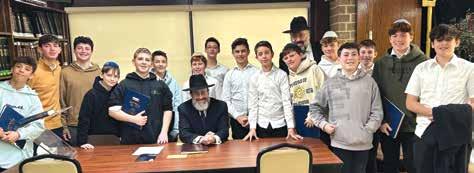
The talmidos of the Ganger Early Childhood Center and the Elementary School at TAG got to experience Yetzias Mitzrayim at a special simulation in school this week. They saw pyramids, pet a “sheep” that was tied to the bed for Korban Pesach, danced through Krias Yam Suf, and finished off by singing and davening to celebrate next year (or maybe this year!) in Yerushalayim!
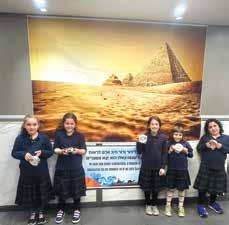


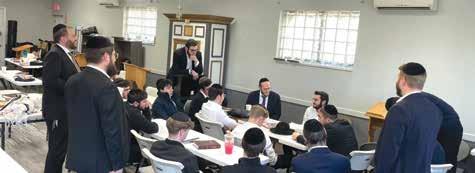

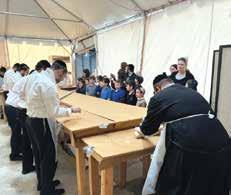
Getting ready for Pesach is hard enough, but for families facing pediatric illness and medical crisis, yom tov preparations can feel impossible. Chai Lifeline, the Jewish community’s leading health support network, is there to help families every step of the way so they can focus on what truly matters most—the health and wellbeing of their loved ones.
This yom tov, Chai Lifeline is once again setting the standard for compassion and support, providing a comprehensive array of services designed to ease the burden for families navigating medical crisis. With offerings ranging from
hospital sedarim and meal deliveries to home cleanings, car washes, and financial assistance through the Evan Levy Z”L Fund, Chai Lifeline’s regions across the United States are hard at work to mitigate the stress and hardship of Yom Tov preparations of more than 6,000 families affected by medical crises.
In Chai Lifeline regions such as New Jersey/Pennsylvania, services extend to car and house cleanings, kashering services, and a pre-Pesach day camp for children and their siblings. The Greater New York area will see car wash services, pre-Pesach dinner programs, and special Pesach afikoman toy box packages for children, among other support activities.
The Midwest region is hosting a pre-Pesach program complete with haircuts, dinner, and engaging activities for kids, along with essential services and gifts to ease the holiday preparations.
The Mid-Atlantic region’s offerings include pre-Pesach car cleaning in collaboration with the Baltimore Chesed League and care packages filled with holiday essentials. In the Southeast, families will receive financial support for holiday purchases and a special children’s program to uplift spirits. West Coast families are being treated to personalized Pesach kits, ensuring they have everything needed for a meaningful and joyous Yom Tov.
“Amidst the preparations and celebra-
tions of Pesach, it’s crucial to remember those in our community facing unimaginable challenges,” said Rabbi Simcha Scholar, CEO of Chai Lifeline. “Every gesture of support is a step towards lightening their load, allowing them to embrace the Yom Tov with peace of mind. At Chai Lifeline, we’re not just offering help; we’re offering hope, demonstrating that compassion and community can transform the Pesach experience for families in need.”
To help support Chai Lifeline children and families this Pesach, visit www. chailifeline.org/pesach
Exploring technology is an important component of the curriculum in HANC’s Elementary School in West Hempstead. For those students who exhibit a particular interest in robotics, a team of students traveled to Manhattan Day School on April 10 to participate in the CIJE VexGo Robotics Competition. This event brought together twelve yeshivot and over two hundred students for a day of innovation, collaboration, and friendly competition. The atmosphere was electric as eight HANC students, Lily Lazar, Adira Isseroff, Ollie Berko, Michael Lowenthal, Tzvi Koenisgberg, Zach Kornecki, Hillel Klein, and Jack Braverman, engaged in the spirit of camaraderie, introducing themselves and shaking hands with peers from other schools. It was truly heartwarming to witness the students embody the values of teamwork and cooperation throughout the event.
At the heart of the competition was the VEX Robotics challenge, which not only tests students’ technical skills but also nurtures their creativity and problem-solving abilities.

In the Ocean Science Exploration Competition, the enthusiastic students navigated the field with precision, maneuvering their robots to perform these specific tasks in the limited amount of time provided. Watching the children’s persistent efforts to accomplish all of these tasks as a team was a testament to their dedication and ingenuity, and their
performance was nothing short of remarkable. They faced challenges head-on with unwavering determination, showcasing resilience that left the staff in awe. Their outstanding teamwork and sportsmanship did not go unnoticed, earning praise from both fellow competitors and judges alike.

At a Pre-Pesach Chinuch Panel hosted by Yeshiva Ketana of Long Island (l-r) Rabbi Shlomo Dovid Pfeiffer, Rabbi Tzvi Krigsman, Rabbi Avi Schulman and Rabbi Moshe Katz

Rabbi Eytan Joffen, shlita, RM Yeshivas Chevron, speaking at Yeshiva Ketana of Long Island on his recent visit to the community

The Prudential Center?
Is Dirshu really renting out the Prudential Center?! And not even for a siyum? Why? Why would Dirshu make such a massive event to mark the beginning of hilchos Shabbos, Chelek Gimmel of the Mishnah Berurah, and Perek Bameh Isha in the Amud HaYomi that is set to begin just days before Shavuos? The answer is simple. Drastic times call for drastic measures. Klal Yisrael finds itself in a tremendous eis tzarah. Most of us cannot recall a time such as this, when we are surrounded m’bayis u’mbachutz by enemies who are sworn to our destruction and annihilation and by “friends” who don’t seem to care if our enemies succeed.
Since October 7, Klal Yisrael finds itself in a state of war in Eretz Yisrael, where a bloodthirsty terrorist state wants to murder every single Jewish man, woman and child, peshuto k’mashmao. Not only that, but even those who are ostensibly friends, friends of democracy, friends of people with “similar values,” are preventing the Jews from defending themselves.
To make matters even worse, they are sitting at the sidelines, passively watching as rabid and open Jew-hatred and violence against Jews in the Western World has reached levels not seen or even contemplated since the 1930’s.
In Eretz Yisrael as well, there are those who are intent on trying to still the Kol Torah and trying to take our bachurim and avreichim out from the Beis Hamedrash.
We need drastic measures. We are in mortal danger. In ruchniyus and in gashmiyus
What can be done? The Gedolei Yisrael of our generation have told us and echoed the call of Gedolei Yisrael of previous generations that learning hilchos Shabbos and even more importantly an enhanced level of shemiras Shabbos, brings a tremendous amount of shemirah to Klal Yisrael. Indeed, the Ibn Ezra writes in the famous piyut or zemirah that we sing on Shabbos, “Ki eshmera Shabbos, Keil yishmereini – when we watch over the Shabbos and make sure we observe it in accordance with every aspect of its halachos, Hashem will watch over us.”

The Gedolei Yisrael, shlita, of our time, HaGaon HaRav Dov Landau, shlita, Rosh Yeshivas Slabodka, the Vizhnitzer Rebbe, shlita, HaGaon HaRav Reuven Elbaz, shlita, and HaGaon HaRav Yitzchok Zilberstein, shlita, have all called on Klal Yisrael to upgrade and enhance their Shabbos observance. This can only be done by learning hilchos Shabbos. The understanding of hilchos Shabbos is further enhanced by simultaneously learning Masechta Shabbos. Thus it is clearly providential that at this difficult time, Dirshu’s Amud HaYomi and Daf HaYomi B’Halacha programs are both engaged in the learning of Shabbos, offering an unprecedented opportunity to make improvements in our observance of Shabbos.
The Mishnah Berurah in his introduction to hilchos Shabbos brings the words of Rav Yonasan Eibischutz (Yaaras Devash) who says that it is not possible to properly observe Shabbos unless one comprehensively learns its halachos
The Chofetz Chaim further writes (Igros U’Maamarim 66) that it is a mitzvah to encourage people in each city to set up chaburos to learn hilchos Shabbos because “learning about hilchos Shabbos brings a person to actually be able to keep Shabbos properly…”
The Call of the Hour
It is for that reason that Dirshu’s hanhala feels that at this critical juncture in our history when Klal Yisrael needs such rachamei shomayim and are in many ways facing unprecedented challenges, both spiritual and physical, it is critically important that legions and legions of Yidden learn hilchos Shabbos, to know hilchos Shabbos and to observe Shabbos with the greatest hiddur possible. It is Dirshu’s most fervent tefillah that this shall undoubtedly swing the pendulum in our favor and help bring us the shemirah and yeshuos that we so desperately need.
That is why Dirshu, with the bracha
and encouragement of Gedolei Yisrael from both Eretz Yisrael and chutz l’aretz, will be holding a massive event entitled “Kinnus Olam HaTorah, Kabbolas Shabbos Event” to mark the haschala of hilchos Shabbos in the Daf HaYomi B’Halacha program. The event will be held on Sunday, 3 Sivan/ June 9, at the Prudential Center Arena in Newark, NJ. Leading Gedolei Yisrael will address the maamad of chizuk and tefillah and most importantly, encourage a kabbalah to learn and upgrade our hilchos Shabbos.
The Daf HaYomi B’Halacha program is an excellent vehicle to accomplish this goal. It involves a relatively small daily investment of time to learn an amud of Mishnah Berurah along with Dirshu’s Biurim and Musafim on the adjacent page that brings the piskei halacha of many Gedolei Haposkim on modern day questions and scenarios as paskend by the Poskei Hador who have come since the publishing of the Mishnah Berurah. This coupled with the fact that lomdei Dirshu are now in the middle of learning Masechta Shabbos in Talmud Bavli, presents an ideal opportunity to learn the foundational underpinnings of the halacha from the Gemara and then follow up with the practical halacha.
Those who commit to joining the Daf HaYomi B’Halacha program for hilchos Shabbos will be given preferential seating and heavily discounted rates at the event.
Rav Shmuel Kaminetsky, shlita
Three years ago, the venerated Rosh Yeshiva of the Yeshiva of Philadelphia, the Zekan Roshei HaYeshiva of our times, HaGaon HaRav Shmuel Kaminetsky, shlita, penned a personal letter to the Nasi of Dirshu, Rav Dovid Hofstedter, thanking him for the Daf HaYomi B’Halacha program.
In the letter, Rav Shmuel writes, “The program to learn from the sefer Mishnah Berurah written by the gaon hador,

Rav Dovid Hofstedter
the Chofetz Chaim, has been received throughout the world b’sever panim yafos by Torah learners and especially in yeshivos all over the world. May Hashem enable this limud to continue, especially in yeshivos.
“His honor has merited to enable the learning of halachos every day which serves as a proper preparation for life for every ben Torah. This is especially true regarding halachos that are relevant in day-to-day life. My bracha to you from the depth of my heart is that you should be successful in everything you do.”
Rav Shmuel’s heartfelt call for learning halachos that are constantly relevant in day-to-day life was echoed by Gedolei Yisrael in Eretz Yisrael, especially now at this critical time.
Now, in this very difficult period for Klal Yisrael, there is no room for complacency. We must utilize every tool, every eitzah of Torah, tefillah and chessed to try to tip the scales in our favor. We must show Hashem how much we value His Torah by rededicating ourselves to limud haTorah and yedias haTorah
Learning Masechta Shabbos with the Amud HaYomi and following up with Hilchos Shabbos, with the Daf HaYomi B’Halacha is a critically important shemirah. As the Daf HaYomi B’Halacha is set to embark right before Shavuos on chelek gimmel of Mishnah Berurah, the chelek that encompasses Hilchos Shabbos, now is the time to accept upon ourselves with a true kabbalah to learn hilchos Shabbos, and to enhance and upgrade our shemiras Shabbos. The only way to do that, is by learning hilchos Shabbos.
We have a golden opportunity this 3 Sivan/June 9, to embark on a journey that will transform us and bring the tremendous shemirah and bracha of Shabbos, upon ourselves and upon all of Klal Yisroel.
Now is the time to be mekabel Shabbos!



1. Do they have a 4th of July in England?
a. Yes
b. No
2. How many birthdays does the average man have?
a. 1
b. 7
c. 72
3. Some months have 31 days; how many have 28?
a. 1
b. 2
c. 12
4. How many outs are there in an inning?
a. 1
b. 3
c. 6
d. 9
5. Is it legal for a man in California to marry his widow’s sister?
a. Yes
b. No
6. Divide 30 by 1/2 and add 10. What is the answer?
a. 20
b. 25
c. 70
7. If there are 3 apples and you take away 2, how many do you have?
a. 1
b. 2
c. 3
8. A doctor gives you three pills telling you to take one every half hour. How many minutes would the pills last?
a. 60
b. 90
c. 120
9. A farmer has 17 sheep, and all but 9 die. How many are left?
a. 8
b. 9
c. 17
10. How many two cent stamps are there in a dozen?
a. 2
b. 6
c. 9
d. 12
1) A- In England, much like America, July 4th comes after July 3rd. Everything else about the place is backwards, though.
2) A- Every person has 1 birthday… duuhh.
3) C- Last I checked, each month has at least 28 days, although we wish August had 60 and January had 2.
4) C- A full inning has six outs –

three for each team.
5) B- It would be pretty hard for a dead person to get married.
6) C-70 (30 divided by 1/2 equals 60. Then you add 10.)
7) B- Unless someone stole one of the apples from you, you have the two that you took.
8) A-60 – Start with the first pill; 30 minutes later, take the second; 30 minutes after that, take the third.
9) B- Why don’t you think about this one a little more? Maybe read the question again.
10) D- There are twelve 2 cent stamps in a dozen.
8-10 Correct: You are probably the smartest person sitting around your yom tov table (which also makes you the most annoying person to sit near).
4-7 Correct: You are intelligent. But you shoot from the hip a bit too much.
1-3 Correct: Too much marror is known to kill brain cells. Slow down on the chomping and try this quiz again later.
? When three-letter airport codes became standard, airports that had been using two letters simply added an X.
? Alaska is the only state that you can type out its name using only one line of a keyboard.
? If you start counting at one and spell out the numbers as you go, you won’t use the letter “A” until you reach 1,000.

? A normal, relaxed blinking rate is 6-8 blinks per minute, and the eyes are closed for about 1/10th of a second.
? According to the Oxford English Dictionary, the word “set” has the most definitions, with 464. The word “run” runs a distant second, with 396 definitions.
? No word in the English language rhymes with month.
? The average person falls asleep in seven minutes.

? There are more than 50,000 characters in the Chinese language. You’ll need to know about 2,000 to read a newspaper.
? If you have 3 quarters, 4 dimes, and 4 pennies, you have $1.19.
You also have the largest amount of money in coins without being able to make change for a dollar.
? Rhode Island is the smallest state but has the longest name. The official name, used on all state documents, is “Rhode Island and Providence Plantations.”
? There are 10 human body parts that are only 3 letters long (eye, hip, arm, leg, ear, toe, jaw, rib, lip, gum).
? The plastic things on the end of shoelaces are called “aglets.”
? Diet Coke was only invented in 1982.
You are given a 5-gallon barrel and a 3-gallon barrel. You are told to go to the sink and fill the 5-gallon barrel with 4 gallons of water. You don’t have any measuring devices.
What do you do to make sure the 5-gallon barrel has 4 gallons using your two items?

fill the 5-gallon barrel up and pour it into the 3-gallon barrel to fill it up. Now you have 4 gallons in the 5-gallon barrel.
Answer: You fill the 5-gallon barrel up and pour it into the 3-gallon barrel. Then dump the 3-gallon barrel out and pour what is left in the 5-gallon barrel into the 3-gallon barrel so that you have two gallons in the 3-gallon barrel. Then
 By Rabbi Berel Wein
By Rabbi Berel Wein
This week’s parsha is truly one of the most difficult subjects for people in our time to contemplate or understand or from which to gain knowledge and inspiration. The entire subject of these mysterious diseases, which manifested themselves on the human body, in clothing and even in houses and buildings, is technically discussed in the Mishna and also in various places in the Talmud itself. However, the fact that the subject is discussed does not really reveal the underlying pa-
thology of these diseases nor does it help explain it to us in a purely rational fashion.
We are all aware that the Talmud connects the disease to the sin of slandering others and improper speech. Nevertheless, the mystery of the cause, diagnosis and cure for the condition remains a troubling and hidden matter. It is beyond my ability to add any new insights into this age-old discussion by the great scholars of Israel. I think, though, that we simply have to accept that there are physical diseases that


manifest themselves because of spiritual failings, whatever those failings may be and however they are interpreted.
We are all aware that there are psychosomatic diseases that can and often do become actually physical. Medical science has not yet been able to determine why such phenomena occur. Well, just as there are, so to speak, mentally caused diseases, the Torah informs us that there are also spiritually caused diseases that actually affect one’s body, clothing and even one’s home. There are many events and occurrences in life, both personal
spiritual imbalances and shortcomings. We are usually never conscious of these matters, and if, in fact, they are pointed out to us by others, the usual reaction is one of resentment. So, through the mechanism of physical symptoms as described in this week’s parsha, the Torah reminds us that we need to examine and purify ourselves spiritually and not merely physically.
Our bodies, our clothing, and even our dwelling places require inspection and sanctification. Even though the physical manifestations of these shortcomings are
There are many events and occurrences in life, both personal and national, that defy logic or any form of human understanding.
and national, that defy logic or any form of human understanding.
The Torah does indicate to us the areas of our lives where our human vulnerabilities exist and are apparent. Certainly our bodies, our health, our appearance and our general physical wellbeing rank as some of the most vulnerable of all human conditions. Our bodies are so delicately formed and perfectly balanced that even the slightest malfunction of any of its parts immediately causes pain and requires our attention.
The Torah expands this idea to include
no longer apparent in our time, the underlying lesson is still present in all of our actions and attitudes.
The realization that we can be woefully deficient in behavior, unless we are constantly monitoring our relationship to our unique value system, is essential for living a truly Jewish and observant life. We are responsible for discerning those weaknesses within us even if they are not physically apparent.
Perhaps this is the message to us from this week’s parsha.
Shabbat shalom.

 By Rav Moshe Weinberger
Adapted for publication by Dov Elias
By Rav Moshe Weinberger
Adapted for publication by Dov Elias
After the Jewish people experienced the salvation of the splitting of the sea, the pasuk (Shemos 14:31-15:1) says, “And the Jewish people saw the great hand which Hashem used against Egypt and the nation feared Hashem and they believed in Hashem and in Moshe His servant. Then Moshe will sing...” The Gemara (Sanhedrin 91b) comments on these verse, “[Because it] does not say ‘Then Moshe sang,’ but rather ‘will sing,’ this is a hint to the resurrection of the dead in the Torah.” We must understand the connection between the resurrection of the dead and the Song at the Sea. Why would the Torah hint at the ultimate resurrection here?
In addition, why does the Torah emphasize that the Jewish people believed in Hashem and Moshe at the Song of the Sea? We see that they believed in Hashem much earlier, as the pasuk (Shemos 4:31) says, “And the nation believed.” The Gemara (Shabbos 97a) derives from this pasuk that “it is revealed before Hashem that the Jewish people are believers.” If this is the case, why does the Torah seem to imply that the Jewish people only acquired emunah later on by the splitting of the sea?
Every Jew has emunah in Hashem on some level, whether revealed or hidden deep inside. As explained by the Tanya, this gives every Jew the power and potential to give up his life in order to stay true to his faith in Hashem. But there are infinite levels of emunah. A Jew must strive to attain the level of (Shemos 17:12) “and his hands were faith.” On that level, a person’s emunah is so tangible, that he feels like he can touch it with his hands.
The Shela Hakadosh offers a remarkable explanation of the following

statement by Chazal (Shemos Raba 23), “In the future, the Jewish people will sing a song for the World to Come.” This statement seems redundant. Chazal did not need to say that we will sing “in the future” “for the World to Come.” The Shela therefore explains that this statement by Chazal does not mean that in the World to Come we will sing about the miracles which will have occurred to help us reach that time. Rather, it means that at some time in the future, before we reach the ultimate redemption, we will have such powerful emunah that we will sing songs of gratitude to Hashem
for the ultimate redemption because of our certainty in its coming. For tzaddikim, there is no difference between a salvation which occurred in the past and an anticipated salvation. They are both equally real for the tzaddik who feels his emunah tangibly, as if with his hands.
As the Torah said, the Jewish people had emunah in Hashem even in Egypt. But they never sang based only on the promises of (Shemos 6:6-7), “ V’hotzeisi ,” And I will take out, “V’hitzalti ,” And I will save, “V’ga’alti ,” And I will redeem,” and “V’lakachti,” And I will take out.” Their faith was not yet on
that level. However, they did attain that higher level of faith after the splitting of the sea, when the Torah says, “And the Jewish people saw the great hand which Hashem used against Egypt and the nation feared Hashem and they believed in Hashem and in Moshe His servant. Then Moshe will sing...” Then, they sang not only in gratitude for their immediate salvation, but in gratitude for the resurrection of the dead as well.
The Chofetz Chaim told a parable of an extremely poor couple who lived in abject poverty in a tiny hovel. One day, however, the husband bought a lottery ticket. Later on, they learned that their ticket had the winning number. They had won the lottery! With great joy, he and his wife went outside of their little house to dance and celebrate their winnings. The neighbors saw them dancing and heard them singing, “We’re rich! We’re rich!” Bewildered, they asked the couple, “How can you sing and dance that you’re rich? Look where you are!” But the husband answered them, “We may not be rich yet, but we’re holding the winning lottery ticket. That’s why we are singing and dancing!”
Emunah means being able to sing and dance about Hashem’s promise of the redemption in the future. It means realizing that we already hold the winning ticket. That was how Rabi Akiva was able to comfort his friends over the destruction of the Beis Hamikdash (Makos 24a-b). Because he was no less confident in the promise of the ultimate redemption than he was regarding the destruction of the Beis Hamikdash, he was able to celebrate the future rebuilding of Hashem’s house even before that promise came to fruition.
We open the door for Eliyahu Hanavi at the Seder. While we drink four
cups of wine because of the Torah’s four expressions of redemption, the truth is that there is one additional cup; the cup of (Shemos 6:8) “And I will bring you to the land about which I raised My hand to give it to Avraham, y itzchak, and Yaakov.” Despite this fifth expression of redemption, Chazal did not institute a fifth cup because the practical reality is that we remain in exile and the ultimate redemption has not yet occurred. Most of us have not yet attained the level of emunah which would allow us to celebrate a future redemption. In order to acknowledge this level of faith, however, they instituted that we fill up a fifth cup for the prophet who will herald the coming of Moshiach and Eliyahu Hanavi.
After experiencing the Seder, however, a Jew can then say, “Pour out your wrath upon the nations who do not know you...” and open the door for Eliyahu as if we are actually going out to greet him. At that moment, at the conclusion of the Seder, we can close our eyes and sing the “Song of Songs” with tears of gratitude in our eyes for the final redemption.
One year before Pesach, a woman, who had recently become a widow, called me for guidance. She did not know how she could sit at the Seder. Her husband had led the Seder for all the years they were together, and she simply did not know how she could stand it without him. Although nothing I could say could adequately address her pain, I tried to offer her some comfort. I shared the following story of the Belzer Rebbe which occurred shortly after the War. His ship arrived in Haifa shortly after the War right before Parshas Beshalach, which includes the story of the splitting of the sea and the Song at the Sea. Speaking to a few other survivors, he asked the following question: How could the Jews sing about their salvation from the Egyptians? We know that fourfifths of the Jewish people died in Egypt! This means that everyone present at the splitting of the sea had lost children, parents, brothers, sisters, relatives, or friends. Everyone was in mourning. How could they sing? He further asked how they themselves could even learn to sing again after everything and everyone that they had lost in the War. He explained that this is why the Song of the Sea is alluding to the future, when all who were killed will be brought back to life with the resurrection of the dead. Only then, will our song be complete. However, based upon what we learned from the Shela Hakadosh, we
can make an additional point. The Torah (Bereishis 40:23) says, “And the butler did not remember yosef, and he forgot him.” What is the reason for the redundancy? Why does it say that he “did not remember yosef” and that “he forgot him”? The butler never thought
Although the chassidim didn’t want to speed up the Seder, the Rebbe was making an effort to keep it moving for the sake of the soldier, who continued to complain about how long the process was taking. And then after the meal, when everyone began reciting the last
Emunah means being able to sing and dance about Hashem’s promise of the redemption in the future.
he would see yosef again. When someone thinks there is no hope of seeing someone else again, he does not try to remember him, and this automatically results in “and he forgot him.” However, the emunah of the Jewish people at the splitting of the sea was so strong and was felt so palpably by the people that they remembered that everyone who they had lost was not gone forever. They knew that they would see each other again at the time of the final redemption and the resurrection of the dead. It was this faith in the resurrection that allowed them to sing to Hashem while they still remembered those they had lost. Their “ y izkor,” remembrance, allowed them to sing because it came with the concrete awareness of their ultimate reunification with everyone who had already gone on to the next world.
The Rebbe concluded that they, too, could go on and sing with the knowledge that those they had lost were not gone forever but that they would all be reunited at the time of the final redemption.
It is told that one Pesach, Rav y isroel, the Kuzhnitzer Maggid, was approached by a former soldier of the Czar. Such soldiers were taken away from their families as young children and forced to serve for thirty years without any contact with their families or y iddishkeit. This tinok she’nishbah, person who was abducted as a child, came to the Rebbe, and said, “Srulik, can I come to your Seder?” While the chassidim were aghast at this ignorant soldier’s chutzpah, the Kuzhnitzer agreed and happily invited him to the Seder.
While the Rebbe usually went through the Haggadah slowly, sharing Torah and chassidus along the way, the soldier repeatedly complained, “I’m so hungry! When are we eating?!”
part of the Haggadah, he began complaining again “There’s more?! When are we going to sleep!?” Finally, at the end of the Seder, the Rebbe asked the soldier, “Isn’t there anything you remember from your childhood? Can you recall anything about the Seder?”
The man thought for a few moments and then said, “There is one thing I remember. At the end of the Seder, everyone sang, “Podyom l’Zion b’rinah, get up to Zion with joy!’” In reality, the words
are “peduyim l’Zion b’rinah, those who are redeemed go to Zion with joy.”
The problem was that he pronounced the word “peduyim , those who are redeemed,” as “Podyom,” which means “get up” in Russian. The Rebbe loved this alternate reading of the words from the Haggadah, which imply that instead of waiting until we are redeemed to go to Zion, yerushalayim, we should simply get up right now and begin heading toward the final redemption. He went outside with this soldier and the other chassidim, singing the soldier’s version of the song, “Podyom l’Zion b’rinah, get up to Zion with joy!”
May we merit to attain the level of emunah in which we can rejoice in the final redemption even now because we know we hold the winning ticket of Hashem’s promise that He will send us the ultimate redeemer, may he come soon in our days.
Rav Moshe Weinberger, shlita, is the founding Morah d’Asrah of Congregation Aish Kodesh in Woodmere, NY, and serves as leader of the new mechina Emek HaMelech.

While the Daf continues plowing through Bava Metzia, many monetary topics are studied. Interestingly enough, someone once asked Rav Yaakov Hagiz (1620-1674) a question about whether a singing bird was muktzeh. He answered based on a recently studied daf. For those who don’t know the connection, this is quite a riddle. The Gemara never mentioned Shabbos, let alone muktzeh.
The Daf spent this week learning about kinyan sudar, alternatively referred to as kinyan chalipin. This is the go-to kinyan for religious purposes. At a wedding, the officiating rabbi makes a kinyan chalipin with the groom, on behalf of the bride. When the rRabbi hands his pen over to the groom, the groom takes the pen and thereby becomes responsible for everything he agreed to in the kesuba. The bride’s agent is in essence trading the pen for financial support. Similarly, when someone goes to a rav to sell chametz, he performs a kinyan chalipin with ther. The rabbi hands the congregant his pen, and the congregant transfers the authority to sell his chametz to the rabbi.
There is some discussion as to what item can be used for chalipin. In the times of the Gemara, it seems as if a handkerchief, a sudar, was the standard item. Nowadays, a pen is often used. The object for chalipin can be anything, as long as it is a utensil or functional item. The rabbi officiating at the chosson’s tisch may not take a bunch of grapes and hand them to the chosson. Grapes are not utensils, therefore, they may not be used. What would happen if someone had just borrowed the rabbi’s pen at the chosson’s tisch? The rRabbi needs to make a kinyan with the chosson, so that the chosson will be obligated in the kesubah obligations. The rabbi looks around and sees that for some reason his cow is nearby. Can the rabbi give the cow to the chosson to effectuate a kinyan chalipin? One would have assumed that he could not. A living

creature is not a utensil. However, Tosfos (Bava Metzia 46b) says that he may! Tosfos reasons that a cow and donkey are indeed considered functional utensils because they have designated uses. They are used for plowing, pulling, threshing, etc.
Rav Yaakov Hagiz, who hailed from Morocco, cites this Tosfos as proof that a singing bird is not muktzeh. One would have assumed that all animals are muktzeh machmas gufo. They are not considered utensils, and even if they have a permitted use, they can’t be moved. This is similar to a rock that is muktzeh. Even though one may use a rock as a paperweight during the week, one cannot pick up a rock from his garden on Shabbos. However, now that Tosfos teaches us that animals are considered utensils, we can conclude that a singing bird is not muktzeh. A cow would still be muktzeh since its primary use is forbidden Shabbos labor. However, a singing bird’s primary use is permitted on Shabbos. Therefore, Rav Yaakov Hagiz (Hilchos Ketanos) concluded in a very brief teshuva that a singing bird is a keli shemilachto l’heter and is not muktzeh.
What is somewhat surprising is that
Rav Yaakov Hagiz made no mention of the seemingly related machlokes Rishonim cited in Tosfos in Mesechta Shabbos (45a). There, Rabbeinu Yosef rules that a live chick is not muktzeh because it can be played with. Tosfos and the Rosh disagree. Indeed, the Rosh says that if we follow Rabbeinu Yosef’s psak to its logical conclusion, no rock found in a garden would ever be muktzeh because one could always find a permitted usage for it. Rav Yaakov Hagiz, while citing Tosfos in Bava Metzia, did not mention the Tosfos in Shabbos.
There is a related controversy. In the eighth volume of the Igros Moshe (OC 5 22:21), there is a brief teshuva that rules that pets are not muktzeh. Yet upon close inspection of the teshuva, it is clear that if one read the unadulterated text, one would conclude that pets are muktzeh! However, the editors of the posthumously printed volume amended the text to explain that while animals are generally muktzeh, pets are not. This has led to very sharp criticism from various sources that the changes are unwarranted and untrue.
As an initial matter, Rav Moshe Feinstein could very well follow the ruling of
Rav Yaakov Hagiz and hold that pets are not muktzeh. Still, what will Rav Hagiz and Rav Moshe do with the Tosfos in Shabbos?
Rav Moshe Feinstein himself provided the answer in his work on Gemara entitled Dibros Moshe (33:4). Rav Moshe writes that the stringent opinion in Tosfos in Shabbos is only based on the fact that the bird is not exclusively designated for permitted usage. However, if the bird was designated as a pet, even the stringent opinion in Tosfos would hold that it is not muktzeh. Indeed, this is clear from the Rosh’s comparison of a chick to a rock found in a garden. Both are undesignated for permitted Shabbos use and both are muktzeh machmas gufo. But even a rock can be designated for a permitted use, and then it would not be muktzeh! So, too, an animal can be designated as a pet and then it would not be muktzeh. Rav Shlomo Zalman, zt”l, wrote similarly that a seeing-eye dog, which is inherently designated for permitted Shabbos use, is not muktzeh. (Shulchan Shlomo 74:2)
There are other poskim that disagree and hold that pets are muktzeh. Still, Rav Moshe, zt”l, wrote himself in the Dibros Moshe that live creatures are muktzeh because they are not designated for permitted use. It would seem to logically follow that the version of Rav Moshe’s teshuva that says that pets are not muktzeh is the correct one. This is bolstered by the fact that his logic is supported by a very similar ruling of Rav Shlomo Zalman, zt”l. Finally, Rav Reuven Feinstein, shlit”a, is reported to have concurred that his father held that pets are not muktzeh. For practical guidance, one should speak to his posek or rav.
Rabbi Avrohom Sebrow is a rebbe at Yeshiva Ateres Shimon in Far Rockaway. In addition, Rabbi Sebrow leads a daf yomi chaburah at Eitz Chayim of Dogwood Park in West Hempstead, NY. He can be contacted at ASebrow@gmail.com.

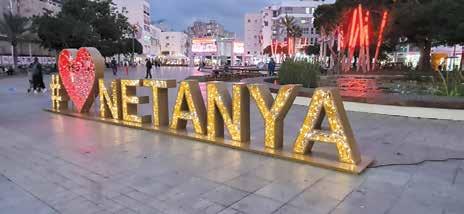
Israel’s consistently high rankings in the Happiness Index is fascinating.
Fittingly, streets across the country have names that reflect this theme. For example, Netanya has a neighborhood filled with many joyful street names, including Ha’Gila, Ha’Rina, Ha’Ditsa, Ha’Chedva, and Tsahala.
The fact that Israel is ranked the fifth happiest country in this most challenging year of 2024 is astonishing. How can a country that has lived in a constant state of war since its inception, and is currently at war with Iran and its proxy of terror, all the while being vilified and boycotted globally, be so happy?
One explanation for the source of Israel’s happiness is that, while most countries’ populations are declining, our population is expanding dramatically and will double within the next 20 to 30 years. This growth elicits a national feeling of continuity and stability.
An inspiring answer is that Israel’s definition of happiness is deeply rooted in the Navi Yeshaya’s vision of the Jewish people’s role as an “ohr la’goyim,” a light unto the nations. Israel leads the world, on a per capita basis, in scientific publications, museums, and new book publishing, and boasts an inordinate number of Nobel Prize winners. Living a meaningful, value-driven existence can fill one with gratification.
A practical answer focuses on Israel’s economic success, spurred by its thriving high-tech industry and many other important fields. This sense of financial well-being helps create a national culture of contentment and confidence.
A spiritual explanation touches upon the religious nature of the Jewish nation. Less than one-third of the Jewish population considers themselves “religious,” yet two-thirds of this population consider themselves religiously connected.
faction knowing that their grandparents’ traditions and values are enduring.
A heartening explanation for the country’s high morale is that its younger generation is bravely fighting the current war with resilience and conviction. As VC Michael Eisenberg inspiringly wrote: “Our kids taught us to take the fight to the enemies of humanity, to stand tall, to believe, to know that the future will be better in their hands.”
An intriguing reason was proposed
Life in Israel, despite its hardships, is enriched with meaning and a sense of purpose and destiny.
This appreciation of a Higher Being endows people with a sense of purpose and meaning.
An uplifting answer focuses on the unprecedented amount of Torah being learned and the religious growth occurring here. The sheer number of people learning Torah is astounding, which is a source of pride not only to religious people, but also to many secular Israelis, who derive satis-
by my dear friend Dr. Joshua Lipsitz, a trailblazing professor of Psychology at Ben Gurion University, who in his relatively short life achieved so much. He maintained that most Israelis are more interconnected – they know each other and are concerned about each other’s welfare – than citizens of other countries. Consequently, the global crisis of loneliness and isolation is less common
in Israel. Although one may sometimes prefer to be left alone than to answer to multiple meddling Yiddishe mamas, the feeling of being connected to others is a source of serenity.
One final and powerful reason focuses on many Jews’ attachment to the physical land of Israel. Living in the land of our patriarchs and matriarchs fosters a reassuring sense of being a link in the long chain of Jewish history. Furthermore, being blessed with our own country allows us to defend Jewish lives, in contrast to the thousands of years when we had no homeland to escape to nor army to protect us.
The happiness that pervades Israel is not borne of naiveté nor established in denial of the formidable challenges that confront our nation. Rather, it is based on an understanding that life in Israel, despite its hardships, is enriched with meaning and a sense of purpose and destiny.
May our Seder prayer “Next year in Jerusalem” herald the Jewish nation’s long-awaited redemption.
Gedaliah Borvick is the founder of My Israel Home (www.myisraelhome.com), a real estate agency focused on helping people from abroad buy and sell homes in Israel. To sign up for his monthly market updates, contact him at gborvick@gmail.com.
The six-month anniversary of the savage Hamas terrorist attack of October 7 came and went, and I was left with the feeling that less and less of the American politicians, TV talking heads, protesters, and socalled journalists, who feel they must comment about Israel, should not be. Far too many just don’t know the simple historical facts needed to intelligently speak about this war. They refer all the time to what they call Palestine, “the Israeli occupation,” “Israeli apartheid,” and “the Israeli settlements,” which shows they lack a basic understanding of simple facts.
How many of these so-called arbiters of truth do you think would be able to pass a simple quiz? Could they even score a 50%? And if they could not, what drives them to speak out so harshly against Israel?
How many pundits and protesters could score a 50% on the below short quiz?
1. What year was the First Zionist Congress held?
This founding Zionist meeting was held in Switzerland in 1897. The idea that Zionism originated as a response to German Nazism is false as is the claim that the Zionists wanted a Jewish State outside of the Holy Land and Jerusalem. The anthem selected at the 1897 Congress included the words “The land of Zion and Jerusalem.” The false claims about Zionism’s origins and goals were created to portray Zionism as having been created to further European colonialism and solve the European problem of antisemitism. Antisemitism was never only a European hatred and was just as strong or stronger in Islamic majority countries.
2. What percentage of Israelis are not descended from European Jewish communities but hail from the Middle East and North Africa?

According to the Pew Research Center, a majority of Israeli Jews are Sephardim or Mizrahim (48%) compared to 45% Ashkenazim (European). The remaining 7% are mostly Ethiopian and Indian Jews. The idea that all Israelis are descended from European Jews who came to Israel to escape Nazism and are not from the region is false.
3. Do Palestinian Arabs serve in the Israeli Knesset (legislature)?
The Israeli government system is the antithesis of apartheid. Multiple parties led by Arabs participated in Israel’s first election in 1949 and Arabs have been candidates and have been elected throughout Israel’s history. Currently 10 Knesset Members are Arab. The Likud, which is very often labeled as racist by those ignorant of Israeli politics, had an Israeli Arab Druze Knesset Member for over 22 years named Ayoob Kara.
4. Who occupied Gaza from 1948 to 1967?
Egypt occupied Gaza from 1948 until June 1967. No attempt was made by any Gazans to free the area from Egypt nor was there any international pressure to create a Palestinian state there nor se -
rious calls for such from Arab nations.
5. When was the first President or Prime Minister of Palestine elected? Yasser Arafat became president of the Palestinian National Authority in 1994. Before that, there was no modern, independent, viable Palestinian Arab nation that existed nor any government. The idea of separate Palestinian nationhood did not exist prior to the creation of Israel.
6. What are Israeli “settlements”? Settlements are Jewish communities where there are neighborhoods of families in areas that Israel did not control before 1967; put another way, these are cities and towns founded by Israelis in Judea and Samaria the so-called “territories.” No settlements were attacked on October 7. There are families with deep roots in the settlements with several generations of children born and raised in the settlements.
7. How long has Israel occupied Gaza?
On October 7, no Israeli troops were in Gaza at all. All Israelis were removed from Gaza in 2005 as part of Prime Minister Ariel Sharon’s disengagement
plan. Gazans had complete control within their territory for 19 years before October 7. Many of the Jewish families who lived in Gaza that were removed in 2005 had previously lived in the Sinai and had been removed from their homes there when Israel surrendered the territory in 1982 to Egypt as part of the Camp David Accords. Israel has already relinquished control of over 23,000 square miles of territory it captured in 1967. By contrast, Israel is only 8,000 square miles. Israel has already sacrificed tremendous amounts of territory in its efforts to try to achieve peace with the Arab nations that surround it.
8. When was the Palestine Liberation Organization (PLO) formed?
The PLO was founded in 1964 when the Old City of Jerusalem, Gaza, and Judea-Samaria (the so-called “West Bank”) were all occupied by Jordan or Egypt. So, the PLO was created to end the existence of any Israeli control of any land it held after the 1948 Arab-Israeli war.
9. What did Hamas call its October 7 surprise terrorist attack and why?
Hamas and its terrorist allies named the attack Al-Aqsa Flood after a Jerusalem mosque built on the Temple Mount above the Western Wall. Hamas (like Al Qaeda, ISIS, Hezbollah, and the Muslim Brotherhood) is dedicated to a violent, expansive militant version of Islam that sees the murder of civilians as a legitimate part of the wars they launch. Moreover, the use of the name Al-Aqsa is their way of saying that the war doesn’t end until Jews are driven out of Jerusalem and kept out just as the Jews are banned by the Saudis from Mecca and Medina.
Moshe Phillips is a commentator on Jewish affairs whose writings appear regularly in the American and Israeli press.
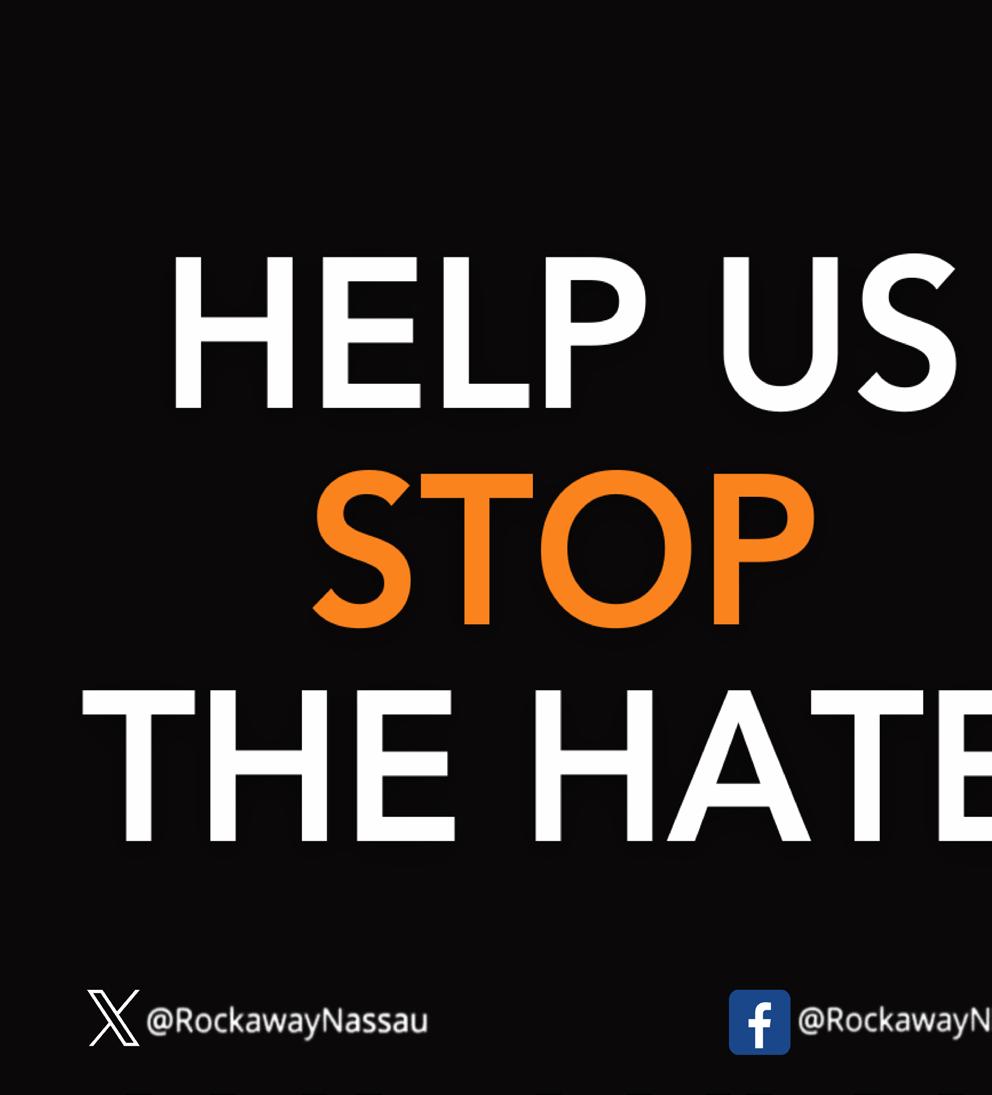


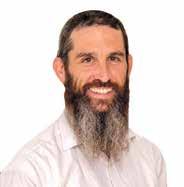
“Icome from a loving and supportive Jewish but not observant family,” Rabbi Cohen shares. We’d have our Friday night Shabbat dinners and afterwards, as a college student, I’d go clubbing and DJing.” During the week, Rabbi Cohen attended Manchester University and majored in philosophy.
In his third year of university, Rabbi Cohen says, “I remember looking around and seeing that no one was particularly happy. I saw a lot of divorce and depression.” As a kind of self-imposed project, he started asking people the ques -

tion: “How are you?” The Top five answers he received were: “can’t complain,” “could be worse,” “not too bad,” “getting by,” and “hanging in there.”
“I realized this was not a good trajectory for living an amazing life. Though everybody was saying they want to be happy, I wasn’t seeing any authentically happy people.”
A major turning point in 19-year-old Dov Ber’s life came when his then 90-year-old grandfather cautioned him not to live an “I should have….” life.

“When people get to my age,” he told Dov Ber, “they don’t have a lot to look forward to. They usually look back and say things like, ‘I should have spent more time with my family. I should have traveled more. I should have worked out the purpose of life.’ Make sure to live your life so that at my age you’ll have lived to the fullest with no regrets.”
“I thought about his words a lot,” says Rabbi Cohen. “It was true. I mean, how many 90-year-olds can honestly say (about their lives), ‘Wow, I nailed it’?”
Dov Ber decided he was going to do everything he could to live fully, with no regrets. He figured if he could follow three basic steps, he’d be set for
an amazing life: 1) What’s my goal? 2) How do I achieve it? 3) Do it.
Looking around London, however, it didn’t appear to him like the Western secular world had answers to the kind of fulfilling life he was seeking. The observant Jewish neighborhood near him didn’t seem like they had the answers, either.
So, Dov Ber turned to martial arts.
“Bruce Lee (Hong Kong-American martial artist and actor) became my first ‘rebbe,’” says Rabbi Cohen with a laugh. “As a child I had never been taught life skills like how to be happy or how to build self-esteem. Bruce Lee had wise sayings like, ‘Don’t pray for an easy life; pray for strength to endure a difficult one.’ I heard that.” Around the same time, Dov Ber also began exploring Buddhism and other spiritual writings in the university library.
Rabbi Dov Ber Cohen, an Aish Hatorah rabbi currently living in Jerusalem, originates from London but spent six transformative years in Japan, Thailand, India, Nepal, and Sri Lanka. During this time, he transitioned from traditional Judaism to Buddhism and Hinduism. Ultimately, his path led him back to Orthodox Judaism, where he now shares his insights and experiences with others.
The unfortunate fact is, Rabbi Cohen shares, that 40% of practicing Buddhists in America are Jewish and 60% of Buddhist teachers in the U.S. are Jewish. When asked why, he shares, “Looking at Torah on a childish (ignorant) level, it looks like there’s an ‘angry man in the sky’ who needs us to follow his rules and tell him how great he is. It seems like he has ego issues. It doesn’t seem to teach profound values. But when you enter a Buddhist temple, you can get an immediate sense of deep peace. You don’t feel that on a surface level in a synagogue. Judaism doesn’t seem to match up to the more spiritual religions.
“But, of course, this is a tragic misconception.”
Dov Ber’s first stop in his search for true happiness was Sri Lanka.
“I got my university degree and said, ‘I’m out of here. I have to work this out.”
Coming as he did from a privileged background, Dov Ber felt a sense of responsibility to offer something to the world. So, he went to an Asian orphanage and taught English. “The children had never seen a white person before. They thought I had a disease,” he recalls.
Their poverty was so acute that five children shared a single pencil. When Dov Ber bought each child their own pencil, they were ecstatic. Despite their poverty and challenges like dealing with diseases like polio these orphans were happy.
Working with these children, Dov Ber felt a purpose beyond himself.
“In the Western world,” he explains, “who you are is defined by your career. I didn’t buy into that. Just roughing it with my backpack on my shoulder, I felt so alive. These underprivileged children living in huts with no running water and no electricity were happier than most of my friends back home. They had the gift of gratitude, appreciating whatever little thing they had. This was an eye-opener for me.”
Dov Ber’s journey didn’t stop in Sri Lanka. He then moved to Thailand for a year and a half, where he taught Buddhism, learned to speak Thai, and played a lot of soccer. Dov Ber engaged deeply in meditation practices and participated in many ten-day silence retreats. In these retreats, the living conditions were tough, and the daily routine was rigorous. Participants slept on wooden beds with a block of wood for a pillow with only a thin blanket to keep them warm. They weren’t permitted to read, write, or use phones at any time.
“Our day began at 4 a.m. with the sound of a ringing bell. We’d splash our faces with cold water and then engage in tai chi or yoga as a physical wakeup,” shares Rabbi Cohen. Following this, participants practiced Anapanasati, or conscious breathing, for 16 hours, interrupted only for a simple meal of rice and vegetables at 10 a.m. and a cup of warm soy milk at 6 p.m. Rabbi Cohen explains that for most people, the prospect of focusing on breath for such extended periods would be daunting, as we’re accustomed to letting our minds dominate. Yet, this practice taught him the importance of present-moment awareness and the transformative power of meditation on personal well-being.
These experiences, Dov Ber explains, are designed to encourage introspection, which actually aligns with the wisdom of our Torah sages who teach that the ability to be alone is fundamental to healthy interactions with others.
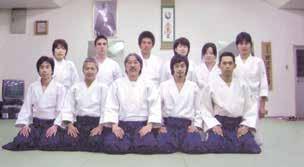

Is there ever a point to dwelling on the past or looking to the future?
“Adam was created alone,” Rabbi Cohen shares. “But then the pasuk states, ‘Lo tov l’heyos Adam levado,’ which means we’re not meant to stay alone. However, we need to be able to interact with people in a healthy way and not just because we’re scared to be by ourselves – we are meant to be able to be alone.”
According to Rabbi Cohen, because we’re so used to letting our minds run the show, most of us would feel unsettled after even one minute of trying to med-
“Since the present moment is all we ever have, the more we can accept what is going on right now, the more at peace we will be.”
itate, let alone 16 hours. This is because most people’s thoughts completely dictate their reality. To be left with your mind without any distractions is scary. Nevertheless, Rabbi Cohen stresses, it’s important to get out of our minds and live in the present. When you’re in your over-analytical mind, you’re either dwelling on what was or what’s going to be – neither of which are reality, Rabbi Cohen explains. The only real reality we can actually experience is the now.
Rabbi Cohen also emphasizes the importance of living in the present in Judaism observance. When you’re learning Torah, focus on that. When praying, focus on your prayer, not what you’ll be having for lunch. When eating lunch, focus on your lunch. When you’re with your spouse, don’t be busy with your phone.
“If it serves a constructive purpose like learning from past mistakes or looking towards the future to know what your goals are and how to attain them, then that’s fine, but to dwell on or regret the past, or worry about the future, that’s not productive.
“The truth is,” he says, “since the present moment is all we ever have, the more we can accept what is going on right now, the more at peace we will be.”
The problem, he continues, is that for most people, the minute they start trying to meditate, they start feeling bored, tired, frustrated, or anxious. Typically, they’ll jump up and say, “OK, I have to do something.” But these things are really the yetzer hara that’s trying to keep you away from going deeper inside. If you’re meditating and you feel bored, a good suggestion is to simply look at it. Watch the boredom; don’t fight it or engage it in any way. Just observe it. That’s how you get to dive beneath it and into your soul.
“The key to meditation,” he adds, “is to start with focusing on your breath for just two minutes a day AND don’t fight the voice in your head. The Arizal would say when you notice your yetzer hora getting to you to stop and smile. When you begin meditating and you notice the voice, stop, smile, and refocus on your breath.”
Usually, a person will get through one breath and the voice will start – ‘I’m feeling anxious, I can’t do this – or alternatively, this is great, I can do this… Just smile and focus back on your breath. The idea, he explains, is that we’re training our mind to get back into the present moment. 99.9% of our thoughts are either in the past or the future, but the breath is in the present moment. When we focus on the breath, it brings us into a calmer and more peaceful place and more able to deal with the issues in our lives.
When you have peace of mind, you can be whoever you are in a healthy way. For example, there are introverts and extroverts. An unhealthy introvert fears interacting with people, usually because of low self-esteem. An unhealthy extrovert can be similar; he must keep himself busy interacting with people, so he doesn’t have to face himself. If you can be alone with yourself in peace, then you are free to be whatever is appropriate for the moment, maintains Rabbi Cohen.
magnificent Korean island paradise where he trained in Taekwondo.
“I just wanted to do amazing things so when I was 90 years old, I could look back and not feel I missed out on life. I would say that my life at that point was basically inspired by movies like ‘Rocky’ and ‘The Karate Kid,’” Rabbi Cohen says laughingly. “My Taekwondo master made us strip down to our boxer shorts and run up and down the mountain in the snow.” To support himself, Dov Ber taught English wherever he went.
From Korea, Dov Ber traveled to India, where he volunteered in orphanages and participated in more 10-day silence retreats. He hiked in Nepal, attended yoga retreats, and then moved onto China to train in Shaoling Kung Fu, another martial art. “We had to run up and down the mountain at 4 a.m. If we stopped running, the master smacked the back of our legs with a wooden bamboo stick,” he recounts.
Amid these experiences, Rabbi Cohen describes an epiphany he had while sitting atop a mountain in Nepal and meditating.
“It hit me that the less you want, the happier you’ll be. I realized then that I only need three things to be happy and if I have them, I’ll always be happy. The first is meditation – as we discussed, your whole life is your mind. If your mind is peaceful, you’ll have a great life. The second is education – reading growth-oriented books. And the third is exercise. A lot of our spiritual and emotional health is based on our physical health. It’s hard to deal with life if you’re not physically healthy.”
Dov Ber recognized then that even if he was in solitary confinement, he could be happy because he would be able to do his breathwork and his pushups.
“It was an amazing moment of insight and joy, knowing that I’m now going to be happy for the rest of my life.”
Continuing his journey, Dov Ber spent a year and a half in Japan, achieving a black belt in Taekwondo and a brown belt in Aikido. His adventurous spirit next contemplated canoeing down the Amazon, but he first decided to make a stop in Israel for three weeks. “That was 17 years ago, and I never left,” he reveals.
Dov Ber worked on a kibbutz. There was only one religious Jew there, and he suggested Dov Ber check out Judaism.
“You’re here, already,” he had said, “you might as well check it out.”
Dov Ber went to Tzefas and be gan to learn that the wisdom of the Eastern religions was sourced in Ju daism. It also offered a balance that

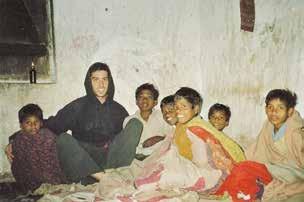
Buddhism and Hinduism did not have. He learned that Judaism doesn’t believe in the “angry man in the sky” who’s going to punish you for not following his silly rules. Judaism understands that Hashem is infinite consciousness. In fact, the Name of Hashem (Y-K-V-K) means continuous presence. Dov Ber learned that if Hashem is infinite consciousness and we’re all aspects of that, then when we praise Hashem, we’re saying, “I’m part of something great.” Hashem doesn’t need our praise, Rabbi Cohen explains, it’s for us to live a life of wonder. The same thing goes for thanking G-d. He doesn’t need us to thank Him. Hodaya in prayer is to teach us to live a life of gratitude which, like the children in the orphanage, is what leads to true happiness.
Though Dov Ber was living in a high state of joy in his six years in the far East, he always had one question that no one had satisfactorily been able to answer: How do you know this is true?
“I loved what I was doing, but I also knew that millions of people in the world think that if you don’t believe in [Yashka], you’ll burn in [Gehenom].”
So, Dov Ber asked his Buddhist masters, “How do you know that what you’re teaching is true?” Their answer was, “Because Buddha says so.” But the Hindus say the same thing about their deity.

When Dov Ber was in Tzefat for a while, he posed the same question. Torah is deep and profound, but how do you know it’s true? He thought that, like with the other religions, he would stump his Jewish teachers. But he was wrong. In fact, there is evidence that the Torah can only be of divine origin and the rabbis in Aish haTorah in Yerushalayim (where the Tzefat rabbis sent him) clarified it for him.
“I sent my atheist friends the ‘evidence,’ and while waiting for their re -
sponse, I decided to walk the Israel national trail – a 650 mile hike from the Lebanese border to Eilat.” Dov Ber decided to do it in 40 days because he’d learned about the spies who in 40 days walked the land and returned with a bad report. “I wanted to be ‘metaken’ their mistake and say good things about Israel and also raise money for the orphanages I worked in. On the trail, I listened to Rabbi Tatz’s lectures and debated the atheists. However, no one could refute the evidence I had.”
Rabbi Cohen illustrates the key difference between Buddhism and Judaism.
“If life is treading water,” he says, “sometimes so much is coming at you, you need to say, ‘Let’s go on the beach to meditate and reset.’ Buddhism will say, ‘Let’s stay on the beach and never get off.’ Judaism says, ‘No, you’re meant to go back into the water and live your life. But it’s important to do it in a calm, healthy, and present way.’”
The time spent on the beach meditating is a necessary reset, but we’re not meant to stay there.
Rabbi Cohen notes, “Overcoming your ego while hanging out by yourself in a cave isn’t very hard. When you have three kids tugging at you 20 minutes before candle lighting and 10 guests coming and the food isn’t cooked, that’s the challenge. It’s much harder to overcome your ego when you have rent to pay. Retreat time is training to get back to the world. If your whole life is retreat time, then you’re missing the whole point of being in the world.”
The Torah, he explains, is the guidebook that brings physicality together with spirituality. For example, money is great, but make sure to give charity. Eating delicious food, likewise, is wonderful. Elevate the experience by being mindful and recognizing it as G-d’s gift to you. Make sure it’s kosher, say a bracha.
Today, Rabbi Cohen incorporates his Eastern training into his avodas HaBoreh. He’s up before sunrise and spends two hours doing exercise, immersing in the mikveh, and davening. At this point, his formal meditation is only a daily five minutes, but throughout the day, he is mindful in all areas including making conscious brochos, davening and tefillin. “When I say the word ‘baruch,’ I say it with intention (kavana), and ‘Atah’ – even more. I try to feel like I’m actually speaking to Hashem Who is literally and palpably in front of me,” shares Rabbi Cohen. “When I put on my tefillin, I do it mindfully. Mincha also is a huge key.”
Rabbi Cohen admits that this mind and body discipline is an asset to observing Jewish religious prac -
tices. Every 3-year-old child in Thailand knows what meditation is. Unfortunately, the average Jew today doesn’t know about true spirituality. Dovid Hamelech says, “ Taamu uru ki tov Hashem , taste and see how good is Hashem.” Observing mitzvot is meant to be an emotional experience. It’s like experiencing a strawberry. You can talk about strawberries all day and night, but until you bite into one, you’ll never know what a strawberry really tastes like.
“Why, for example,” he asks, “do we have the mitzvah of mezuzah? To wake you up and make you realize that you have a loving Creator Who is keeping your heart beating right now. All of Torah is a path of mindfulness that is meant to be taking us towards the experience of Hashem.”
Mindlessly observing mitzvot is like looking at the map but never taking the walk or like discussing the menu for a half hour but never tasting the food. Often, people get caught up in the rules and forget what they’re there for. The rules are there to help us to express ourselves in our relationship with Hashem. And they’re very necessary. You can’t play the game of life unless you know the rules. Knowing, observing, and experiencing the rules will get you to your goals.
“One of my best mitzvahs,” Rabbi Cohen shares, “is Shabbos. The word ‘lashevet ’ to sit/rest shares the
same root as the word ‘Shabbos.’ Six days a week we’re physically rushing around, achieving, and on Shabbos, we get to rest and experience our soul. It’s really the whole purpose of life.”
“It was an amazing moment of insight and joy, knowing that I’m now going to be happy for the rest of my life.”
Another “favorite mitzvah” of his is tefillin. “When I put on tefillin for the first time in my life at age 29, I thought, ‘Wow, this is weird!’” Rabbi Cohen recounts. “Placing black boxes on my head and arm, what’s that all about? Now I love it because I understand there’s so much depth and wisdom. It’s awesome wearing Hash-
em’s name (Sha-kai) on your body. King David went to battle with tefillin on. And I also like it because it’s so ‘weird’ – there is no way we would be doing this unless we were deeply committed to serving Hashem,” he adds with a laugh.
Rabbi Cohen leaves us with a word of thanks and some advice.
“If I had the opportunity to talk to my grandfather today,” he shares, “I’d say, ‘Thanks for the kick, Grandpa. I know now where I want to get to and I’m committed to the process.’”
As for the many struggling folks out there, Rabbi Cohen’s advice is – BREATHE.
“I mean that in all seriousness,” he says.
Breath is key to becoming present and saying, OK, let’s restart. It’s not too late.
And his message to the world is – CHILL OUT.
“Everyone is so uptight today. ‘I need to make a decision right away,’ they’ll say. No, you usually don’t. Chill out, breathe and do self-care. And then we’ll work on figuring it all out.”
You can contact Rabbi Cohen at dovbercohen@gmail.com. He has two YouTube channels @masteringlifeseries –short empowering life skills – and @livingintune – longer Torah shiurim. You can join his 8-week online mindfulness chaburah at www.litmindfulness.org.


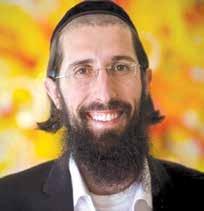
Supporters of non-Orthodox Jewish groups argue that many of the traditions and laws of the Torah are antiquated and cannot be reconciled with the values of society. Such people propose that Judaism, as a religion, should or must ‘evolve,’ ‘progress,’ and ‘change’ over time, even if that entails discarding traditions and aspects of Yiddishkeit that have been preserved by our
nation for millennia. Although Judaism has survived for thousands of years without its followers having to compromise on their religious values, proponents of movements such as Reform Judaism fail to acknowledge the importance of staying true to our roots. But perhaps the most damaging thing about progressive groups is that they, for the most part, sap Judaism of its spirituality.
The Torah wants you to ask questions and wants you to know that we have an unbroken mesorah. Where everything else was ‘don’t ask too many questions,’ i came to Torah and it said, ‘a sk me anything you want.’
We’re here to be the light to the nations, and we have to be ready now to be giving the right message because the world is looking at us. a nd the message is that hashem is here for humanity. We want to bring hashem to the entire world.
Existence is so beautiful. Existence is so pure. it’s so good, there has to be something real.
We’re trying to bring everybody home. We’re trying to unify all the Jews around the world under one common goal. hashem Echad.
Spiritually devoid movements tend to promote distorted views of Judaism, especially amongst younger members and children who ultimately misunderstand the religion and, as a result, engage with their Jewish heritage and values in a superficial manner. Those searching for more in life may be convinced to look elsewhere, certain that the empty Judaism they grew up with accurately represents Yiddishkeit as a whole. Feeling disconnected from the lessons they learned during temple services or at Sunday school, many non-Orthodox Jews feel unimpressed with Judaism and thus search for truth in other places. Rabbi Moshe Chaim Eade was one such Yid.
Today, Rabbi Moshe Chaim Eade, with his long beard, peyos, and large yarmulke, lives in Israel and teaches at Aish HaTorah, but until he was in his twenties, he was anything but frum. Rabbi Eade’s journey to Orthodox Judaism was a long one, with many twists and turns along the way, but his whole adventure started years ago when he was just a teenager.
“I was born in Toronto, and I grew up in a loving Reform family. We would go to shul on Rosh Hashana and Yom Kippur. We had Sunday school and Tuesday school. You would have a bar mitzvah, you’d get a kiddush cup, you’d get a handshake with the president of the shul, and that was basically the end of it,” Rabbi Eade explained. “I felt
estranged from the Jewish way. I felt things were far from me, and it didn’t seem personal. I saw early on that whatever they were selling in the temple, I didn’t relate to. I didn’t feel like it was speaking to the human being of today.”
Just like Avraham Avinu at age three, Rabbi Eade, as a high schooler, looked at the world and saw it as a beautiful work of art. And he asked himself: What is life all about? Who created this incredible universe? Where can I find the truth? It was at that point in Rabbi Eade’s life that he decided to embark on a mission to discover the meaning of life.
“I started going into the woods, going into the wilderness, just thinking. I started to read books on meditation, on just quieting one’s mind. And I found a lot of happiness in that. I found there was a lot of blessing in being able to quiet the noise of the world and sort of go inside. And I discovered that the inside of a person is a very beautiful place,” Rabbi Eade added. “I started with meditative techniques, deep breathing, practicing different yoga techniques, and just quieting my mind; quieting the monkey brain, if you will. And I started to see that there was something happening here, but I didn’t know exactly what it was. It was all fresh. And that was the beginning of my journey.”
Beyond his new love for mindfulness, he wanted to explore world religions in search of the ultimate truth. And so, the boy started looking into a
variety of faiths: Buddhism, Christianity, Islam, and the like. But with each religion that young Rabbi Eade explored, he felt uncomfortable and impure, as though his instincts were telling him to stay away. When he explored idolatrous, polytheistic faiths, the word, “graven images,” which he remembered learning about in Sunday school, echoed in his mind. A voice in his head seemed to say: “This isn’t it. This isn’t you.” Although he wasn’t frum, he knew he was a Jew, and he understood that he wouldn’t ever be able to shed his identity.
When Rabbi Eade was in the middle of college, he was offered a Birthright trip to Israel.
“I remember thinking, ‘It’s unbelievable. Somebody is spending money for me to come to Israel for free.’ I started thinking, ‘Who are these Jews? Somebody must love me out there,’” Rabbi Eade recalled.
And thus, Rabbi Eade, at age twenty, flew to Israel. When the plane landed in the Holy Land, he was suddenly seized by an overwhelming surge of emotion. People rose from their seats and began clapping. Yarmulkes were everywhere, the smell of Eretz Yisrael filled the air, and suddenly, the twenty-year-old boy found himself tearing up. Filled with feelings he never experienced before, he walked off the plane, bent down, and kissed the ground of the Holy Land. He was home.
While the Bbirthright trip was supposed to be fun and relaxed, Rabbi Eade, who was, at the time, passionate about veganism and meditation, wasn’t interested in the parties, clubs, or beaches. Instead, he was looking for a spiritual experience.
“When we went to the Kotel for the first time, I started crying. At that point, you can’t explain these things. This is just the rawness of the Jewish soul ex-

periencing truth,” he explained. “That night, everyone’s partying and you’re not allowed to leave the hotel, but I had this feeling: I just have to get back to the Western Wall. So, I snuck out of the place, and I just ran to the Western Wall.
“It was eleven at night, and I just laid down in front of the Wall. I remember hearing a story that Yaakov Avinu went to sleep by the [place of the] Western Wall, and he had this dream of the sulam mutzav artzah (the Heavenly ladder) and malachim. I didn’t know what it was, but I just felt like this was my home. My forefathers were here,” Rabbi Eade recalled.
He fell asleep by the Kotel, and shortly afterward, he was woken up by security personnel. The interaction that followed was a tad bit awkward (“What are you doing sleeping by the Western Wall?”), but they quickly realized that he was harmless and sent him on his way.
In an effort to fully experience the Holy Land, Rabbi Eade decided to walk through Eretz Yisrael. Thus, he began walking through the north and south of the land, sleeping in avocado groves. With only two days left to his trip, Rabbi Eade wanted to spend the rest of the trip in Yerushalayim. And thus, he made his way back to the holiest city in the world, once again finding himself standing by the Kotel. Dressed all in white, Rabbi Eade was facing the Western Wall, feeling an incredible spiritual high, when suddenly, someone tapped him on the shoulder.
“I looked around, and it was a very religious, Orthodox-looking man with a long white beard and a black hat. And this person says to me, ‘Are you a Jew?’ So I said, ‘Yes, I am’,” Rabbi Eade recalled.
The frum, bearded man then offered to bring Rabbi Eade to a yeshiva. This man was Rabbi Meir Schuster, a great
This article is based on a podcast, “Inspiration For the Nation,” hosted by Yaakov Langer. To catch more of this conversation, you can watch it on LivingLchaim.com or YouTube.com/LivingLchaim or listen wherever you listen to podcasts (just search for “Inspiration For The Nation”) or call our free hotline: 605-477-2100.
tzaddik who approached many non-observant Jews by the Kotel, tapped them on the shoulder, and brought them back to Yiddishkeit.
“He brought me to the Men’s Heritage House, which he was running. I don’t know what hit me. People are offering me food, they’re offering me this. Here’s a bed. I’m like, ‘How much do I pay?’ They’re like, ‘Don’t even worry about that. We got you,’” he continued.
The next morning, the boy was invited to have breakfast at Aish HaTorah. There were cucumbers, tomatoes, and cottage cheese; foods Rabbi Eade, as a strict vegan, was happy to eat. After the meal, someone came into the dining room and asked Rabbi Eade, “Do you want to learn some Jewish wisdom?” Sitting in the class, he was simply amazed by the depth of the learning.
After the trip was over, Rabbi Eade finished college, after which he went
back to Israel with Ohr Samayach. While in the Holy Land, he and a few of his friends had a meal at the house of Rabbi Yerucham Goldwasser. Beautiful music filled their ears and candles lit up the dark room, as the meal commenced. Suddenly, someone brought out steaming bowls of cholent and placed one of the bowls right in front of Rabbi Eade.
“I was with a bunch of my buddies from Toronto who knew that I had been eating only raw foods for the past six years. All of a sudden, these bowls were coming around, and it was pretty obvious that they were filled with fleishigs,” Rabbi Eade said. “I don’t know what came over me. My buddy told me to pass the bowl, and I said, ‘I’m not passing the bowl.’ At that moment, I just felt: this is it. This is the health food right now.
“I go in. I eat the fleishigs. It was the best cholent I ever had in my life, and I haven’t looked back since.”


I have been dating a girl for two months, and things are going well. We vibe and are looking for the same things. Hashkafically, we’re a match, and I was really feeling we were shayach.
Both our families happen to be going to vacation rentals in Florida for Pesach, so we are going to be able to go out. We were recently talking about packing and heading down to Florida, and I realize now how different she and I are and our lifestyles. My family is driving down to Florida, cooking and freezing ahead of time, and basically doing everything they can to make it economical. In her family, everyone is flying in, her parents are hiring a personal chef to cook on demand, and they are taking their cleaning lady along (paying her flight, too!). They are shipping all new linen and towels to the home as well, even though the home comes with all of these things (I guess they only use new?). She even told me she bought all new clothes and had them shipped directly to the home they’re renting.
With all this said and done, I literally feel like breaking things off just by virtue of the fact that I now recognize what different worlds we come from. We talked about it, and she was very clear that this is how she can imagine herself in the future and cannot imagine lowering the bar on these things. Honestly, there is no way I could keep up with a lifestyle like this, and this is what she is used to. Ever since that conversation, I have been less “into it,” and she is picking up on it. Do I let things end now? Before Pesach? Or do I spend Pesach with her and see if we could somehow work things out? I feel really stuck; any advice would be appreciated.
Thanks for your time, Ephraim*

Rebbetzin Faigie Horowitz, M.S.
Ephraim, a relationship where socio-economic status is not negotiable is not a relationship. Whomever she marries must deliver on a high level. You also see her values clearly and that she is not flexible. Withdrawal is advisable when there is such a lack of compatibility. Count your blessings that this came up and there was clarity about where she stands.
When you date other girls, be sure to do your homework and look for a young woman who understands that it takes time and effort to develop a certain lifestyle. Of course, it is very pleasant to
live that way but it is not an entitlement to impose on a life partner.
Leah Rabinowitz
Ephraim, you clearly like this girl, which is why you’re even asking this question. If you didn’t feel invested in this relationship, I think you would just call it off. But you have feelings for her, obviously, and although you are a little “turned off,” you are asking if you should continue dating her.
Good for you! That shows maturity and understanding that dating is not a situation where you just throw

something good away because you see something different than what you envisioned.
As a mother, I was also a bit turned off by her attitude. It sounds like she’s showing off to you about her family’s aesthetics when vacationing. I don’t know if she thinks this would be attractive and she’s exaggerating (ex. she ordered a few shirts online and is having them sent there instead of to her home because they won’t come in time or they bring their own towels because there wasn’t enough in the rental the last time they went down…).
In any case, I believe that she definitely deserves a cautious, open conversation in which you tell her that you are not capable of supporting a girl on such a high level of lifestyle. Ask her how she thinks she will be able to maintain
Count your blessings that this came up and there was clarity about where she stands.
this lifestyle once she gets married. Are her siblings married? Do her parents support them? Will you, Ephraim, feel pressure to keep up with this family and their vacations and wardrobes?
These are hard conversations to have. If the girl you are dating is ma -

ture, it will make this conversation easier. And she may also come to the realization at the end of the conversation that she is looking for a boy who can support her at a high level – and you may not be the one.
Much hatzlacha with this! And enjoy Pesach with your family in Florida!
Dear Ephraim, it sounds like a good dose of communication is in order before jumping to conclusions and terminating the relationship based on fear, insecurity, and limited feedback
and judgement. Sometimes people’s values change, once they meet someone that may not check the boxes of what they thought they needed, once there is something in front of them that they want.
Regardless, it’s extremely important to exercise the communication muscle and have a mature discussion before jumping to any conclusion or finite decision.
Dr. Jeffrey Galler
R
ich girl, poor boy. The story is as old as time. This is a
The Navidaters
Dating and Relationship Coaches and Therapists
Thank you for writing in to the panel! I understand that since the woman you are dating told you she “cannot imagine lowering the bar on these things,” you have been feeling turned off and you’re simply feeling disconnected from her. I also understand that you have spoken, and you’re looking for advice. I wish I could tell you what to do, and I also wish I knew who would wind up happily ever after and who should not continue dating. I don’t know these answers. I can sense the urgency of this matter for you, and I know you are looking for resolution rather immediately.
classic tale of contrasting socioeconomic backgrounds.
Consider the following. Your girlfriend made very sure to let you know that her family’s vacation features their personal chef, their own cleaning lady, and that they’re shipping brand new linens and towels, even though they’re included in the vacation rental.
And, in case you didn’t get the message, she went on to make very, very sure that you knew that rather than being bothered to pack a suitcase, “she bought all new clothes and had them shipped directly to the home they’re renting.”
And, in case you still didn’t get the message, she made it very, very, very clear that “hhis is how she can imagine herself in the future, and cannot imagine lowering the bar on these things.”
Time
time again, I see that “the right one” doesn’t give a person anxiety.
bear to live without this woman, then I think you know the answer.
Uh, Ephraim?
She is telling you, very clearly, that this relationship is over if you cannot, or will not, support her in the style to which she’s become accustomed.
Unless every fiber of your being is telling you to run (and I believe that might be your intuition), I suggest really talking this through and learning more about what she means by “lowering the bar.” Who is expected to support her lifestyle? Is she expecting you to do that? Is she expecting her parents to continue supporting her luxurious lifestyle? Are her parents willing and expecting to do so?
The second thing you need to figure out is your comfort level with a woman who requires this type of maintenance and if this is your emotional/ lifestyle hashkafa If this kind of thing completely turns you off, and you can
I think that when two people truly love each other (or when the potential for true love exists), something like this isn’t going to get in the way. If she is completely turning you off after you speak a little more about this, then you don’t have true love. Love is about a deep appreciation for who the other is. You simply adore what the other is about, what she values, what she stands for, what she believes in, how she speaks, the way she crinkles her nose, her thought patterns, her feelings. You just love her and adore her and want her exactly as she is. Sure, she will annoy you and you will quarrel, but the thought of life without this person isn’t an option. Love just is. It’s just there. You have to take care of it, and work at maintaining the relationship, but love is just there. It’s a chemistry. A connection. A certain something. A deep respect.
JenniferMannLCSW@gmail.com.
If you walk away from the next level of this conversation with a deeper understanding and respect for this woman, then she may be the one. If you walk away even more turned off and tuning out, and you’re feeling your anxiety rise because you want to be “done with it before Pesach,” I think you have your answer.
Time and time again, I see that “the right one” doesn’t give you anxiety. Things are calm. Your nervous system feels good and relaxed.
I see people marry from different financial backgrounds all the time. That doesn’t concern me in the slightest. What would be concerning is if what you could provide for this woman would never satisfy her...and if the support was coming from her parents and that would make you feel unsettled.
Go with your instinct.
Sincerely,
JenniferIoften like to write an article that focuses on an aspect of chol hamoed trips, such as bonding, wholesome activities, or trip tips. After looking at the calendar, I realized such an article is unnecessary this year.
This year, almost all of Pesach is yom tov or Shabbos, so it only seems appropriate to discuss some of the ways to maximize this unique time together. Over Shabbos, there is a special feeling in the air, and yom tov only enhances this. Days off from work and school, shutting down devices, and long, leisurely afternoons all provide us with a chance to tune out the outside world while refocusing on our inner world.
While many would rightfully declare that extra time davening and learning Torah is the only way to maximize this special time, children still have their needs and require their parents’ assistance. We can use this time to further improve our connection with our children and their love towards the yomim tovim and their associated mitzvos.
Additionally, many individuals find this time stressful. While we prefer to focus on the beauty of these days, we can’t ignore that many find this time challenging. Anything that can reduce that tension will directly enhance the day.
While I will provide suggestions for ways to interact with children, I am not a halachic authority, and there are diverse halachic opinions regarding which activities are permissible over yom tov or Shabbos. Additionally, what is appropriate for a young child may not be accepted for an older child or adult, even within the same p’sak. Please direct any halachic questions to your family’s rav.
There is plenty of food at the meals, but kids will still need a snack. Especially with the long stretches between seudos, it’s not healthy to go so long without nutrition. Hungry children (and adults) are not happy ones. Keeping snacks available ensures that everyone has something when they need it. In my experience, people eat what’s
readily available. If the table is set with sweets and junk, few will search for fruit. But, if the table is laden with cut fruit, vegetables and melons, the kids and adults will devour them. Add some healthy family favorites to the shopping list and prepare them earlier in the day so they’re ready to go out during the afternoon.
Yom tov meals – particularly the Sedarim – are very late, and young children can’t wait so long to eat. Erev yom tov is hectic, and it’s easy to skip meals without proper planning. It’s important to have something basic, but filling, to serve them. It can be leftovers from the previous meal or soup chicken from the pot. I usually put extra chicken (enclosed in a net) into the soup for an easy but healthy protein during those busy times.
Children will have late nights and be off schedule throughout Pesach – and for a few days afterwards. They will be crankier, act wilder or behave irrationally. Parents know it’s going to happen but are still surprised each year when it does. We do our best to keep them close to something that resembles a schedule, but there is only so much we can do. Be gentle on yourselves and your children. This, too, shall pass.
Naps are mandatory on erev yom tov – for both children and adults. Everyone left Mitzrayim, and everyone deserves to be awake and focused as we experience once again the miracles of that night. Kids don’t like naps, but older children can appreciate the logic that the more they sleep during the day, the longer they will remain awake at night.
Most adults enjoy a nap in the afternoon, but young children need constant supervision. Often, the younger your children, the more you need that extra sleep. There are many options to ensure everyone gets their rest. It’s better to make plans in advance rather than hope for the best at the last minute. Ultimately, parents are responsible for their children, and the job of babysitting shouldn’t be imposed on others, unless they really want to assist.

Children are constantly playing or otherwise keeping busy, and yom tov is no exception. Children can play outside or visit friends when the weather is sunny. It is worthwhile to have indoors options, regardless of the weather.
Games are fun and encourage children to interact with each other. They’re also a wonderful way to jumpstart conversation between parent and child. Many families like to purchase new games before Pesach, both because it’s exciting and because they’re guaranteed to be chometz-free.
There are a plethora of Pesach books for every age. Young children may enjoy the beautiful illustrations, and older ones can learn about Pesach in a way that is relaxing and engaging. Many of the books bring yetzias Mitzrayim to life in a new way. Keeping Pesach (or any) books in the main family area makes them more accessible.
This is the time we use to create memories for our children and connect them to our mesorah. Pesach is passing on the torch of our divine mission. We want to make sure we keep our children involved in the Seder and yom tov festivities. There are many ways to keep children engaged, and adults will have fun alongside their youngsters. Discussions can be kept on a child’s level and enhanced with some drama. Be creative, think outside the box, and bring the story to life. Toss ping pong balls, roar like lions and pack your bags to travel around the dining room table. It’s these small gestures that create lifelong memories and positive associations.
Pesach is the time when family minhagim become most prominent as we introduce and reinforce our nation’s purpose. Pass on your family’s unique traditions so your child can cherish them, too.
This is also a time when many share the personal challenges their parents and grandparents went through. This is another part of the unique tradition that is your child’s history to appreciate. Children best absorb information that is given on their level. Details that may frighten a child are best left for when your child is older.
Families can create their own unofficial “traditions.” Whether it’s a special chol hamoed breakfast, a Chad Gadya performance or a pre-Pesach family trip, anything you do each year becomes a beloved part of their Pesach memories. Many of us will recall these informal traditions as our most meaningful memories.
We are their link to the past and connecting to us is no less important. Our most powerful chinuch tool is the connection and love between us and our children. We can make the most of this time by spending it with our most treasured ones. Join them in their games, share a book together, or enjoy an afternoon snack together. As we give our children beautiful memories, we can create some for ourselves, too.
Have a chag kasher v’sameach!
Sara Rayvych, MSEd, has her master’s in general and special education. She has been homeschooling for over 10 years in Far Rockaway. She can be contacted at RayvychHomeschool@gmail.com.
Pesach is synonymous with cleaning. We rid our homes of chometz, which takes effort and elbow grease. Some families use this time to spring clean.
I have noticed over the years that there is less talk about helping to clean for Pesach among students. They shrug when asked what they are doing to help for Pesach.
“We are going away, so I don’t have to do anything.”
“We have a cleaning lady, so she does it.”
“My mother cleans when I am in school.”
When I ask around, parents tell me they felt burdened as children and don’t want to burden their own children, or that there is plenty of time later when they are all grown for them to learn responsibility, so why put the responsibility on them now? They also tell me that their children have school stresses, or that they cannot do all their extracurricular activities and help around the house.
As an educator, I am sad to see this trend. A wellknown study*, where researchers from Harvard tracked children for 75 years to examine childhood psychosocial variables and the biological process, showed that children who had chores did better later in life.
Why?
There are so many positives that come from children having responsibilities and helping around the house.
• A sense of belonging: It is their home and their family – and they are part of it. There is safety in feeling part of a whole. Youngest children have told me that they loved going to busy and bustling families and helping to clear the table and serve. They felt so connected and part of the bigger picture.
• Time management: Children who have chores to do are learning to balance work and play, a vital lesson in life. Children learn to value getting a task done, being efficient with their time, and how procrastination prevents them from doing the activity they want to do.
• Developing organizational skills: As they complete tasks, they might adjust how they do the job,

when they do their job, and how quickly they do the job – all part of the process of inner dialogue and planning.
• Learning to accept responsibility : Going through life as a taker is part and parcel of childhood, but no one wants their children to become adults and still think that everyone around them must cater to their needs. Having children be givers during their formative years allows them to focus on others and be part of a team, which sets the foundation for being a responsible adult in the future. Children learn to trust themselves because their parents trust them. They feel capable and able, two very important feelings that build self-confidence.
• Feeling the sense of achievement of a job well done: Not every child finds school accomplishing and satisfying. Having age-appropriate chores can allow a child to find fulfillment out of school and help the child see himself as more than just a struggling student. At the same time, for a child who is successful in school, it helps the child see themselves as more than a student as well, for school does come to an end, and some student-oriented young adults find themselves lost without the structure and challenge of school when that part of their lives is over.
• Practicing independence: The more chores a child masters, the more independent they become.
Parents tell me it is annoying to give children jobs.
“It just makes more work for me.”
“I can’t trust that my child will do the job correctly.”
“My child refuses to do chores.”
If you have not given your child responsibility until now in your home, it is hard to begin. You might get pushback at first. You will have to be encouraging, smile a lot, and praise a lot, looking past any grumpiness your child displays. But persistence is worth it. Every therapist I speak with, every article I read, and every study done, shows that the pros of giving children responsibility outweighs any of the cons.
Don’t trade easy for now with the building of positive
skills and traits that will serve them forever.
Be smart:
• Make sure the expectations are clear and reasonable for the child’s age and stage. Do not assume a child knows what needs to be done.
• Be consistent. Changing rules and expectations is confusing and frustrating and will have the opposite results that chores should bring.
• Be positive and look to praise. Try not to praise with a “but” as that undermines the praise.
• Do not redo the chore unless necessary, and try to redo it, if possible, when the child is not around.
• Be a good role model. Be happy cleaning up and serving. Turn on music or sing. (Fake it until you make it!) You can’t expect compliance for something you have made clear is drudgery.
• Pick your battles.
• Offer choice whenever you can. When children get to choose their jobs, they are more apt to do them happily.
Even 2- and 3-year-olds can help dress themselves, put clothes in the hamper, pick up toys, and help put away some groceries. They can spray and wipe just because it is fun, even if it won’t accomplish much.
It is never too late to start having children help. Even in a hotel, children can collect plates to give to the server.
When we look at the bigger picture of the future adults our children can be one day, the small inconveniences are suddenly not such an inconvenience after all!
“It is important to note that the size of the task itself doesn’t matter much. The focus is more on the responsibility associated with the task” (Dr. Emily Bendlin, Methodist Physicians Clinic Pediatrician).
Have a kosher, happy, and growth-filled Pesach!
- Etti
* George E. Vaillant; Charles C. McArthur; and Arlie Bock, 2010, “ Grant Study of Adult Development, 19382000,” Harvard Dataverse,V4. doi:10.7910/DVN/48WRX9
Mrs. Etti Siegel holds an MS in Teaching and Learning/Educational Leadership and brings sound teaching advice to her audiences culled from her over 35 years of teaching and administrative experience. She is an Adjunct at the College of Mount Saint Vincent/Sara Shenirer. She is a coach and educational consultant for Catapult Learning, is a sought-after mentor and workshop presenter around the country, and a popular presenter for Sayan (a teacher-mentoring program), Hidden Sparks, and the Consortium of Jewish Day Schools. She is a frequent contributor to Hamechanech Magazine and The Journal for Jewish Day School leaders. She will be answering your education-based questions and writing articles weekly for The Jewish Home. Mrs. Siegel can be reached at ettisiegel@gmail.com.
What do you think of when I say the phrase, “date night”? Some of you smile and nod. Some shrug and think, “One day.” Others may think, “Another person pushing date night? My spouse and I barely have time to talk at the end of the day!” I agree that there is an overemphasis on date night, but not because it isn’t essential; connection and friendship are the basis for a harmonious marriage, and you can only feel connected with someone if you take the time to do that – connect. However, there is far too much focus on making sure to go out often with your spouse, as opposed to focusing on how to maximize date night in marriage.
Let’s face it. We are all so busy. The to-do list never seems to end. And when it does, we are often drained and not in a positive place to create friendship in our marriage. So if we are going to make a significant effort to make date night happen, it requires an intelligent, goal-oriented approach. To do that, we need to emphasize how to date correctly.
Date nights in marriage are about quality, not quantity. Don’t go on weekly dates with your spouse so you can check that off your “we are in a good place in our marriage” list. Instead, your aim should be to figure out your needs as a couple and the best way to escape from the humdrum of life: connect, laugh, and remember why you chose one another to spend the rest of your life together.
How do we do that? How do we get the most bang for our buck regarding dating in marriage?
For every couple, it will look different. Weekly, out-of-the-house date night is what you will hear as the ideal setup. For some, going out every week is not what that couple needs. They can bond without being distracted by regular life by staying home, turning off their phones, making popcorn, and playing games. Or they can connect by doing a paint project, building something together, or baking (just a few ideas). For others, that won’t cut it; if they don’t leave the house, it won’t happen. With the myriad of distractions today, most people must

leave their house every so often to re-infuse the friendship in their marriage. Going out is a helpful way to shut out the world and focus your attention on one another.
But even if you are going out, you must be wise where you spend your time and money. This may sound obvious, but it’s not. And sometimes, it’s trial and error.
A key factor is knowing yourself and your spouse. Make sure to distinguish expense from experience. Sometimes, the cheapest dates can be the most fun and bonding. You don’t have to go to a fancy steakhouse. If you enjoy that as a couple, enjoy it, but you can also go out for ice cream or dessert. Play ping-pong. You can go for a walk. Sometimes, a long car ride can be a fun aspect of a date, where you can share new music you both like or talk uninterrupted. It’s essential to be clued into what works for you and what you as a couple enjoy doing together.
Many ask, “What if my spouse doesn’t want to go out?” Firstly, try to have a dialogue. Don’t mention it as a criticism (“how come we never go out anymore?”). Come from a place of vulnerability. “I miss you. I love spending time with you. I would love to go out sometime.” It may not be easy to make it happen – he or she may be overwhelmed with work, or finances may be
tight. Additionally, the longer you don’t go out as a couple, the more challenging it is to break out of the habit and go out on that first date. But once you do, you’re back in the game. It’s like getting together with a good friend you haven’t seen in a long time. Two minutes in, you’re saying, “Gosh, why did we wait this long”?
Another key element to making date night enjoyable and doable is not comparing! Remember to focus on what you and your spouse need to do to bond and feel closer. The number of times other couples go out is irrelevant to what you and your spouse need. Try not to focus on where other people are going. The goal is to discover what you enjoy and connect over.
But here is the key: you need to be honest. Know when it’s time to go on a date. Don’t wait until there is distance in the relationship. Many couples wait too long to spend quality time together. Not because they are bad, but because life is busy, and it takes effort and energy to go out. But it needs to be a priority.
Figure out what you need as a couple and stick to that plan. Sometimes, couples don’t go out because they don’t realize they need it. An excellent way to notice if it’s been too long since you went on a date is when you notice you’re each a little
more judgmental of the other and feeling unusually more sensitive or unloved. This can happen because you’ve had a big disagreement or you’re personally in a negative space, but it can also be a telltale sign that you haven’t connected for a while.
I once heard a speaker discuss the importance of going on dates. Someone from the audience responded in a way I couldn’t believe: “But what do we talk about?” What do you talk about?! Now, it could be that she and her husband were both quieter and liked to do things rather than talk, but I was still puzzled and saddened to hear her response. Sometimes this happens when couples become ships passing in the night and are no longer in the habit of spending time together.
You must have a place in your marriage for one or both parties to call out the issue and say, “I feel us slipping away from each other. Can we go on a date?” It shouldn’t be presented as a personal attack on anyone but as a need for the marriage.
Is date night overrated? Not if you’re taking advantage of the opportunity and what it offers. Be present, be a friend, and be curious. Look for opportunities to connect and court the other. Make them laugh. Listen. Share.
Prepare beforehand what your objective is. I want to connect! I want to know my spouse more and be known. Take advantage of the incredible gift marriage has to offer – to know and be known on an intimate level. Don’t let other relationships or life’s craziness pull you away from this incredible opportunity for meaningful friendship. Our marriage needs it. We need it. Let’s make it happen.
Malka Klaver is a certified marriage coach and marriage educator. She provides individual and group coaching, as well as yearly workshops, to educate and guide women to a closer, more connected marriage. She also hosts a weekly podcast titled, “Best Friends for Life,” where she discusses relatable challenges and practical tools to enhance marriage. For more information or to contact her, please visit malkaklaver.com.

 By Naomi Nachman
By Naomi Nachman
Put this up in the morning in your crockpot, go out for your chol hamoed trip, and dinner will be ready for you when you come home!

◦ 3 tomatoes, halved
◦ 3 stalks celery, chunked
◦ 8 Yukon gold potatoes, peeled and quartered
◦ Garlic powder, to taste
◦ Onion powder, to taste
◦ Paprika, to taste
◦ Salt, to taste
◦ 1 3-4-pound second-cut brisket
◦ 1 cup red wine
◦ 1 cup ketchup
1. Place all the vegetables in the bottom of a large crockpot and season with spices. Season brisket on all sides with spices and place on top of vegetables.
2. Mix wine and ketchup in a bowl and pour over meat and vegetables. Set crockpot to high and cook for six to seven hours.
3. Remove meat from the crockpot and slice. If it’s very soft, you can just pull it apart with two forks.
4. To serve: Place meat on platter and place potatoes around the meat. If you have a fleishig immersion blender, blend the remaining vegetables in the crockpot to make gravy and pour it over the meat.
Naomi Nachman, the owner of The Aussie Gourmet, caters weekly and Shabbat/ Yom Tov meals for families and individuals within The Five Towns and neighboring communities, with a specialty in Pesach catering. Naomi is a contributing editor to this paper and also produces and hosts her own weekly radio show on the Nachum Segal Network stream called “A Table for Two with Naomi Nachman.” Naomi gives cooking presentations for organizations and private groups throughout the New York/New Jersey Metropolitan area. In addition, Naomi has been a guest host on the QVC TV network and has been featured in cookbooks, magazines as well as other media covering topics related to cuisine preparation and personal chefs. To obtain additional recipes, join The Aussie Gourmet on Facebook or visit Naomi’s blog. Naomi can be reached through her website, www.theaussiegourmet.com or at (516) 295-9669.


This column features business insights from a recent “Mind Your Business with Yitzchok Saftlas” radio show. The weekly “Mind Your Business” show – broadcasting since 2015 – features interviews with Fortune 500 executives, business leaders and marketing gurus. Prominent guests include John Sculley, former CEO of Apple and Pepsi; Dick Schulze, founder and Chairman Emeritus of Best Buy; and Beth Comstock, former Vice Chair of GE; among over 400+ senior-level executives and business celebrities. Yitzchok Saftlas, president of Bottom Line Marketing Group, hosts the weekly “Mind Your Business” show, which airs at 10pm every Sunday night on 710 WOR and throughout America on the iHeartRadio Network.
Since 2015, Yitzchok Saftlas has been speaking with leading industry experts on the “Mind Your Business” show, sharing insightful business and marketing strategies.
In this article, we’ve gathered some of the top tips from leading experts in technological innovation on how to run a business in the constantly evolving digital landscape.

Utilize technology. Always be innovating. It can help you serve your people better. It can help your organization or company grow. In some situations, it can even help your clients advocate for themselves. For example, we introduced online ordering for our clients. We discovered that one population likes borschtm and one population likes peanut butter. All along, we had been sending each of these populations the opposite foods, which they didn’t like all along. So now, our clients can advocate for what they actually want, while having their dignity of not having to be in public to order. They order online and come pick it up. And we as an organization can maximize the foods we have. So, leverage technology. Introduce
new technologies over time. It can really change the landscape for your clients and your overall business operations.

Amazon is a very powerful platform, for both sellers and buyers. There are six key strategies for sellers to be successful on Amazon. Recognize the shifts within your category, which can often have a huge impact on your products. Analyze the successful players in your specific industry to see where you stand and if you need to make changes. Register your brand on Amazon’s Brand Registry. Their registry helps protect your intellectual property and create a trusted experience for customers. It also lowers the risk of someone selling counterfeit products under your brand name. Carefully consider and balance your Amazon Fulfillment options – there are three primary selling options: “FBA,” or Fulfilled by Amazon, where you do all of the selling by yourself on Amazon, but you ship your inventory to Amazon and then they ship to the customer. “MFN,” or Merchant Fulfilled Network, is when you sell and ship on Amazon yourself.
And Vendor Central is where Amazon buys products from you in bulk and then they sell it in the Amazon Marketplace.
Stand out from your competition with great photos and descriptive copy of your products. Explore Advanced Technologies such as dynamic “pricing.” Based on market supply and demand, Amazon often reprices certain items every 15 minutes. Dynamic Pricing Software can help you do this as well, changing prices in real time and generating the most revenue possible. Bottom line is make sure you are aware of all the features Amazon offers for sellers and keep up to date in your industry.
m arketing with g oogle
Beryl Trachtenberg, Founder and CEO of Elite Media Trax Inc.

Whether you’re a B2B (Business-To-Business) or a B2C (Business-To-Consumer) company, digital marketing can be a big help. But the strategy is obviously different between those two business models. With B2C, you’re focusing on product-related searches. There is very high intent and very high conversion rates. When you’re advertising for B2B, you’re focusing more on information. People need to know things, need to get informed, and Google is the go-to for search. They have a 90% market share. Obviously, there are other means on the internet where people can learn information, but when it comes to the main source for anyone learning about anything, people come
to Google. And then, they research information about different companies, areas, and industries. That’s where B2B companies can connect with them and place themselves as the thought leaders and innovators in that industry. There really is no better lead you can get on the Internet than Google Ads when it comes to the search department. It’s like you’re walking down the street when somebody comes up to you and says, “Hey, I’m looking for the service that you provide,” you shake hands, and take it from there. It’s people expressing intent in real time. And you can connect with them and talk to them. Your ad should speak to the search term that they’re searching about, and then the landing page experience should bring them that same comfortability, where they feel like “this company knows what I’m talking about, they know what I need.” And then, you lead them into the phone call, the form submission, or the online sale, where you’ll actually turn it into a profitable lead for yourself.

If you’re working from home, you need to be prepared with the proper tools and techniques for perfect video calls. For example, webcams.
Now, most modern laptops come with webcams built in, and they’re fine, but they don’t offer you a ton of flexibility. It’s very much worth investing in an external webcam, so that you can position yourself from the best angle. That way, your client doesn’t have to face you in an unflattering perspective. Similarly, an external microphone is often a much higher quality alternative to the one that comes built into your laptop. Even the microphones on a pair of Airpods produce great quality sound. Lighting is also very important. I’ve been on calls with people who don’t realize that the light from the window behind them obscures their face and turns them into a shadowy silhouette. A great tool for properly lighting your face is a ring light. Consider setting up a second monitor. When you’re on a remote call, you want to be able to focus entirely on your client, but if you need to pull up a document during the call, a second monitor will help you get the information you need without derailing the call. Finally, know the system that you’re using inside and out. Whether it’s Zoom, Teams, or Google Meet, you need to be sure you know how to work that software. These things may not seem im-
portant, but if you can’t be face-to-face, it’s vital to virtually recreate that situation in the best possible way in order to capture that natural conversational feeling.
after they talk to you, forming initial impressions on you. Too often, people only put up a resume on LinkedIn, instead of building relationships. Your online presence has to tell the powerful story of who
Your online presence has to tell the powerful story of who you are.
i m P ortance of a g ood l inkedi n Profile
Debra Jasper, CEO of Mindset Digital
do next. But it’s not just about your profile—it’s also about how you engage with people. Don’t be shy about connecting with people, but be selective, too.
And here’s a little-known secret: LinkedIn’s search feature is a goldmine. CEOs in almost any industry can find and connect with like-minded professionals, virtually or in your city. Leveraging the search feature can increase potential for networking and business growth.


Maintaining an online presence, especially on LinkedIn, holds significant importance in today’s professional landscape. People look you up every day, long before they meet with you or
you are. Without you even being aware, people are looking you up and deciding whether or not they want to set up a meeting and do business with you. Start with a great profile photo that has the right balance between professionalism and approachability. The summary section of your profile should communicate what you love doing for your clients and not what you actually do for them. You want to gain likeability before you gain credibility. Your profile should answer three key questions: what is my profile about, why do my clients care about this information, and what do I want my clients to




I’ve been more pro-Israel than any other president by far with Golan Heights — throw that one in there by the way; nobody even asked for it, and I got that for them.
- Donald Trump in an interview with Real America’s Voice Network

Donald Trump. Seriously.
- President Joe Biden, when asked on Univision to name the “primary threat” to “freedom and democracy” in the United States
If Hitler was alive today, he would be singing the U.N.’s praises.
- Israel’s UN Ambassador Gilad Erdan, while holding up a photo of Hitler with the Grand Mufti of Jerusalem, taken when the two met to discuss how to collaborate in the execution of Jews
I can safely walk my dog to the Capitol today in a way that you couldn’t do when we all got here!
- Transportation Secretary Peter Buttigieg, who has a constant security detail, claiming on MSNBC that Washington, D.C., has gotten safer, despite the data which shows that it has had the largest crime spike of any major U.S. city
Because Joe Biden is a serious person who tells the truth, the press holds him to an exponentially higher standard than Trump.
- Former senior Obama advisor Dan Pfeiffer
Dear Senator Schumer, with your tremendous enthusiasm for Israeli politics, don’t forget that the gates of Israel are open to you. You are more than welcome to immigrate and vote in the next elections. Until then, please respect our democracy.
- Diaspora Affairs Minister Amichai Chikli, responding to Senate Majority Leader Chuck Schumer’s (D-NY) efforts to undermine the Israeli government
The Iranians have lost control of the narrative. I like to quote Napoleon’s dictum: “When your enemies are making a big mistake, don’t interrupt them.” Iran interrupted its enemy at a time when Israel was increasingly isolated and on the defensive, both internationally and in its relationship with the U.S.
- Foreign policy strategist Richard Haass, in an interview with Politico

Today, the White House has already leaked to the press this morning that they’re not going to participate in an Israeli response to what Iran just did. Let me say it again. More sheep is not going to solve the wolf problem. My advice to the president today, for what it’s worth, Mr. President, don’t. Stop it. Support Israel. With respect, go to Amazon and buy a spine online! Peace through weakness never works.
– Sen. John Kennedy (R-LA)Canada was where every woke White college kid wearing pajama pants outdoors who had it up to here with America’s racist patriarchy dreamt of living someday. I mean, besides Gaza.
- Bill Maher, HBO, pointing out that the uber-left policies of Canada have caused it to become a total mess
They say in politics liberals are the gas pedal and conservatives are the brakes. And I’m generally with the gas pedal. But not if we’re driving off a cliff.
- Ibid.
My grandfather was truly a great influence.… I used to learn values from him and learned a lot. The most interesting thing is that, shortly before he passed away, he discovered that he was Jewish. He didn’t know but someone told him, “Your mother was Jewish, so you are Jewish.” So all the values that I received from him came from Judaism.
- Argentinian President Javier Milei speaking this week at the Shul of Bal Harbor in Surfside, Florida
Israel protected Al-Aqsa Mosque from destruction at the hands of Iran.
Are the Anti-Israel haters going to thank Israel for protecting one of the holiest sites in Islam? No.
Are the Anti-Israel haters going to condemn Iran for endangering one of the holiest sites in Islam? No.
Selective outrage is their modus operandi.
- Tweet by Congressman Ritchie Torres (D-NY), after the Iranian attack on Israel

Just because you shoot at someone and miss doesn’t mean you’re not trying to kill them. Yes, the Iranians were embarrassed. But they almost surely view this as a win. And they also crossed a red line by firing on Israel from their own territory. Yet Israel is apparently the only nation on Earth that is permitted to fully defend itself only if its enemies succeed.
– David Harsani, The FederalistThe only thing I have to say is, it’s just a further reminder of Ron being gone all these years.… It’s no great loss to the world. It’s a further reminder of Ron’s being gone.
— Fred Goldman, talking about his son’s murderer, O.J. Simpson, who died last week

This is who Tucker is: a click-chaser.
Tucker’s MO is simple: defend America’s enemies and attack America’s allies. There isn’t an objective bone left in that washed up news host’s body. Mindless contrarianism is his guiding principle, buttressed by his childish tactic to “juSt aSK quEsTiOns!
But any educated adult, especially one with such a long career in journalism, should occasionally try *answering* some of those questions objectively.
But he never does. Instead, he uses his platform to sow doubt and paranoia and false narratives.
He does this for one simple reason: clicks and engagement, which of course translate to monetary benefit. He wants you to believe he is the last place you can go to for truth, that he’s the ONLY one brave enough to reveal the elitist lies being told.
This nonsense about Christian mistreatment in Israel is just the latest example.
Tucker will eventually fade into nothingness, because his veneer of faux intellectualism is quickly falling apart and revealing who he truly is: a cowardly, know-nothing elitist who is full of [garbage].
- Rep. Dan Crenshaw (R-TX) criticizing Tucker Carlson after he had a radical Christian Arab on his show and declared that Christians should not support Israel
Elect me, I’m in the 20th century!
- Pres. Biden at a campaign event
It appears “don’t” is not a great foreign policy strategy.
- Chef Andrew Gruel, after Iran tried attacking Israel even though Pres. Biden told them, “Don’t!”

[O.J.] represented something for the black community in that moment, in that trial, particularly because there were two white people who had been killed, and the history around how black people have been persecuted during slavery.
- CNN contributor Ashley Allison
Long before the city woke up on a fall morning in 2017, Trump walked out of Lovelock Correctional Center outside Reno, a free man for the first time in nine years.
- From an L.A. Times obituary about OJ Simpson , highlighting how much Trump lives in their head
Yesterday, protesters blocked the Golden Gate Bridge and disrupted traffic in San Francisco. What if something similar to that happened all around the capital, so all the bridges from Virginia were blocked and members who needed to appear at a hearing couldn’t get there or were delayed in getting there? Would that be a violation of this provision?
- Supreme Court Justice Samuel Alito questioning U.S. Solicitor General Elizabeth Prelogar about the scope of a federal law prohibiting “obstructing an official proceeding,” which prosecutors used against January 6th defendants
Shamefully, since Oct. 7, Joe Biden has transformed into an anti-Israel president. There’s really no other way to characterize it. He’s more concerned, seemingly, with placating the antisemites in his base than standing with our historic and vitally important ally.
– U.S. House Speaker Mike Johnson (R-LA)
I encourage people who get stuck behind the pro-Hamas mobs blocking traffic: take matters into your own hands to get them out of the way. It’s time to put an end to this nonsense.
– Tweet by Sen. Tom Cotton (R-AR)
I’m doing this not because I want Boeing to fail, but because I want it to succeed, and prevent crashes from happening.
— Boeing engineer Sam Salehpour, a whistleblower who made alarming claims about the company’s jets
After several days during which Supreme Leader Ayatollah Ali Khamenei repeatedly vowed that “the evil Zionist regime” would be punished for its April 1 attack on Iran’s Embassy complex in Damascus, Syria, that killed seven Iranian military advisers, including three top commanders, the Islamic Republic struck. More than 300 drones and missiles launched from Iranian soil took aim at Israel on Saturday. Nearly all of them were intercepted, mainly by Israeli or U.S. defenses, with a report of just one Israeli casualty, a girl from a Bedouin community wounded by shrapnel.
Will that be the end of it?
It’s no secret that Israel and Iran have fought a shadow war for decades. The weekend attack is notable for two reasons: its directness and its ineffectuality. Iranian military commanders undoubtedly understood that most of their slow-moving drones, about 170 in all, would be shot down before reaching their targets. They were a diversion. Those commanders were probably more surprised that their 30 cruise missiles and 120 ballistic missiles also did negligible damage.
That should drive home a clear lesson to Iran’s leaders: They are no technological match for the Jewish state, especially when the United States is lending a hand. If Israel decides to respond to the attack with direct strikes on Iran — perhaps against oil installations, nuclear sites or military infrastructure — it isn’t likely to miss its targets.
As I write this, Israel’s Cabinet is debating that question. As a matter of self-defense, Israel has every moral and legal right to respond in kind — and then some. It is not enough for Israel to demonstrate its capacity for defense, as it did over the weekend. It must also reestablish its capacity for deterrence. That is, it needs to show Iran’s leaders that the price for bringing their war against Israel out of the shadows will be unbearably high and is therefore not to be repeated.

But if right is one consideration, prudence is another.
Israel has an unfinished war against Hamas in the Gaza Strip, and a direct Israeli attack on Iran could trigger a second full-scale war against Hezbollah in Lebanon, if not with Iran itself. Most Israelis understand that particular war will have to be fought sooner or later — perhaps before the end of the summer — and that it will be
If Israel decides to respond to the attack with direct strikes on Iran — perhaps against oil installations, nuclear sites or military infrastructure — it isn’t likely to miss its targets.
probably much tougher on them than the war against Hamas has been so far.
But war with Hezbollah will demand two things: the full concentration of Israel’s fighting capacity and sustained support from the United States.
Iran’s attack, and the Biden adminis-
tration’s laudable participation in Israel’s defense, is an opportunity for Benjamin Netanyahu to mend frayed ties in Washington and other Western capitals by showing restraint. Among other things, it can help move the House of Representatives finally to vote for the Ukraine-Israel military assistance package that the Senate approved in February. It also buys Israel time to destroy what remains of Hamas’ military forces in Gaza.
An Israeli attack now would lack an additional advantage — the element of surprise. It isn’t just Israel’s technology that is superior to Iran’s. It’s also its intelligence, the kind that has been on display with Israeli hits on Iran’s top nuclear scientist,
senior commanders and the spectacular 2018 heist of its secret nuclear dossiers. The clandestine nature of the warfare has helped to keep Tehran paranoid, vulnerable and guessing. It’s the sort of place where a wise nation wants its enemy to be.
None of this is to say that Israel should simply stand down.
Israel will find opportunities to hit its enemy where it hurts, at a time of its choosing. So, of course, will Iran — but Iran would do that anyway. Israel’s diplomatic facilities have always been vulnerable to Iranian attack, as have civilian Jewish targets. We were reminded of it again Thursday, when an Argentine court finally held Iran responsible for the 1994 attack on a Jewish cultural center in Buenos Aires, Argentina, that killed 85 people and injured hundreds.
Nor is it to say that Israel doesn’t deserve President Joe Biden’s full support if it chooses to retaliate for Saturday’s attack. Khamenei surely noted the friction between Israel and the West over Gaza when he ordered the strike; daylight between Israel and the United States is often an invitation to mischief by the common enemies of both. The president has political reasons to avoid another full-scale regional war in an election year. But the best way to avert such a war is to leave Tehran with no illusions that it could separate Israel from the United States by starting one.
The key decisions of the past half-century that have driven the Middle East to the place it is in today have a common origin: Iran’s Islamic Revolution of 1979, which brought to power a theocratic despotism intent on sowing fanaticism, brutalizing its own people, destroying Israel and causing misery across the region for the sake of its ideological aims. Saturday’s missile attack is the latest example of a long and ugly record. But as Israelis decide how to react, they would serve their interests best by recalling the useful adage that revenge is a dish best served cold.
© The New York Times


Israeli soldiers near a wrecked Egyptian warplane near El Arish Airport
Since the Israeli War of Independence in 1948, one of the key components of the Israeli Defense Forces (IDF) is the air force. The Israeli Air Force (IAF) quickly became a formidable force for the Arab neighbors who tried to invade Israel. Throughout the course of several wars, Israeli pilots established air dominance over areas like the Sinai Peninsula. The feats achieved by some of these pilots during the 1967 Six Day War are well documented, but here are the accomplishments of some of the other pilots that may have not made front page news.
Operation Moked (“Focus” in English) included the airstrikes in June 5, 1967 that targeted Egyptian, Jordanian and Syrian airfields. The first wave was launched at Egyptian targets in the Sinai Desert like the Bir Gifgafa Airfield that was situated east of the Suez Canal. Israeli planes from Haztor and Ramat David Airbases destroyed most of the Egyptian planes on the ground, but a few managed to get in the air. Those were quickly shot down. The IAF’s losses for the entire operation were less than twenty planes, while 450 enemy planes were destroyed. In three hours, the vast majority of the Egyptian Air Force was destroyed, along with their bases. At 10:30 a.m., General Hod radioed Prime Minister Yitzchak Rabin, “The Egyptian Air Force has ceased to exist.”
One of the Israeli pilots shot down was Captain David Yariv Krieger. He was drafted into the IDF in 1953 and took a pilot’s
course. He was an officer in the reserves when he was called up prior to the breakout of the Six Day War. At Bir Gifgafa, Yariv, flying in a French-built Dassault Ouragan jet fighter, was with the first four IAF planes with Squadron 113 to reach the Egyptian airfield. He shot down a Russian-built Egyptian MiG-21 that was attempting to take off. Tragically, his plane was shot down by anti-aircraft fire, and he was killed. Raphael Severon was one of the planners of Operation Moked and also took part in the invasion of the Sinai as a he -
helicopter training and later was assigned the task of planning an operation to achieve air superiority against Arab forces. His plan for Operation Moked was to bomb the airfield, thereby preventing enemy planes from taking off. His plan was successful as we have mentioned earlier. Severon flew missions during the war as a pilot of a Sikorsky S-58 helicopter landing infantry at Sharm el-Sheikh in the southern part of the Sinai Peninsula. Later in the war, he flew missions to land troops in the north at the Golan Heights.
The IAF’s losses for the entire operation were less than twenty planes, while 450 enemy planes were destroyed.
licopter pilot. Born in Haifa, he started in the IDF in communications before taking a navigator’s course in the IAF. He was then assigned as a pilot in a WWII-era De Havilland Mosquito fighter/bomber. In 1956, he transferred to a photography unit that was operating British-built Gloster Meteor jet fighters. A year later, Severon took part in the Sinai campaign, photographing Egyptian bases and positions in the Sinai Peninsula as well as other Arab countries like Saudi Arabia and Syria. In 1959, he took
The second group of IAF planes to hit Bir Gifgafa was led by Giora Ram-Forman. He was born on a kibbutz in 1935 and served as a pilot and instructor in the IAF. He was a senior officer with Squadron 113, and during Operation Moked, his quartet of planes destroyed the remaining Egyptian planes, including two MiG-21 fighters that were on the runway preparing to take off. The next day, he shot down a Mig-21 in the air. Later, he served as the commander of a squadron at Hatzor Air Base and in 1969
shot down two Syrian MiGs – one with a missile and the other with his cannon.
Hostilities with Egypt continued even after the war concluded on June 10, 1967. On July 15, an IAF fighter from the 119 Squadron piloted by Eliezer Prigat used cannons to shoot down an Egyptian Mig-21 near the Suez Canal. During the Yom Kippur War in 1973, he was the commander of squadron that was flying F-4 Phantom fighters. During the naval Battle of Port Said, Prigat was flying air support alone as his wingman had to turn back due to a plane malfunction. In the ensuing battle, Prigat sunk an Egyptian missile ship, and several of the ship’s sailors were taken prisoner by the IDF. This was just one of the few ships sunk by aircraft since the end of World War II.
The results of the air raid saw devastating losses for the Egyptian Air Force and soon would be followed by heavy losses from the rest of the Arab coalition. The Arab air forces had formidable planes and defenses along with the latest Russian technology, and knocking them out in a matter of hours was the major factor in the Israeli victory. The pilots that took part in the operation were heroes of the air, though many of their stories were not widely publicized.
Avi Heiligman is a weekly contributor to The Jewish Home. He welcomes your comments and suggestions for future columns and can be reached at aviheiligman@gmail.com.
MAJOR APPLIANCE REPAIR
Servicing Washers , Dryers , Refrigerators , Dishwasher, stoves
All work guaranteed. Call 718 3762288
VACUUM SALES AND REPAIR
All areas call Max Flam 718-444-4904
THE LEATHER SHOPPE
The spot for all your custom leather Judaica. Tallis/tefillin bags, lulav and esrog bags, havdallah sets, challah covers, shtenders, pesach sets, matzah/afikomen bags. WhatsApp: (732) 523-0007 or email: theleathershoppe732@gmail.com for a full catalog. We ship.
MY MOTTO IS DON’T WAIT TO buy real estate
Buy real estate and wait
Your realtor for life
516-784-0856 Alexandra at Realty Connect USA
PEACEFUL PRESENCE STUDIO
Men’s private yoga, Licensed Massage & Holistic Health
Guidance 436 Central Ave, Cedarhurst Info. & free video training www.peacefulpresence.com 516-371-3715
GERBER MOVING
FULL SERVICE MOVING
Packing Moving Supplies
Local Long Distance. Licensed Insured 1000’S Of Happy Customers
Call Shalom 347-276-7422
HANDYMAN AVAILABLE
For big or small jobs, Sheetrock, carpentry, painting, electrical, plumbing, install & repair appliances
Call Ephraim at 347-593-4691
MANAGEMENT STAFF WILL ASSIST
you with: * Obtaining Medicaid and Pooled Income Trust
* In-home Assessments, Individual and Family Counseling
* Securing reliable home care assistance
* Case and Care Management services
Dr. S. Sasson, DSW, LCSW (718) 544- 0870 or (646) 284-6242
HAIR COURSE:
Learn how to wash & style hair & wigs. Hair and wig cutting, wedding styling Private lessons or in a group Call Chaya 718-715-9009
ZEVIZZ WOODTURNING JUDAICA
Challah knifes, batei mezuzah, besamim holder, kiddish cups, havdalah candle holders, yad for sefer torah, pens, stenders, bowls and more 952-356-2228

DON’T GET STUCK WITH A TWO STORY HOUSE YA KNOW, IT’S ONE STORY BEFORE YOU BUY IT BUT A SECOND STORY AFTER YOU OWN IT! Call Dov Herman For An Accurate Unbiased Home Inspection
Infrared - Termite Inspection
Full Report All Included NYC 718-INSPECT Long Island 516-INSPECT www.nyinspect.com
LAWRENCE
Stunning One of a Kind Mid Century Modern 6 Bedroom, 6.5 Bath, Contemporary Ranch. Resort Style Home on Over an Acre of Property in Back Lawrence. Incredible Views, Regulation Size Tennis Court - Deco Turf. IG-Gunite Pool, Low Taxes, 5318 sq. ft. of Main Floor Living Space. Plus 5000 sq. ft. Basement With Very High Ceilings. Call Mark 516-298-8457 for more details Mark Lipner Associate Broker Berkshire Hathaway Laffey International 516-298-8457 mlipner@bhhslaffey.com
CAN’T AFFORD YOUR PROPERTY TAXES?
MORTGAGE?
Must sell for any reason?
Call for FREE Consultation. Call now 212-470-3856
Cash buyers available!
CEDARHURST JUST LISTED
Magnificent renovated 4 bedroom 3 bathroom in SD#15, new roof, windows, plumbing + electric, gas cooking, new marble bathrooms, marble kitchen with stainless steel appliances, LED lighting, security cameras and speakers throughout the home, custom closets, outdoor patio, 1 car garage, near all. Mark Lipner
Associate Broker Berkshire Hathaway Laffey International 516-298-8457 mlipner@bhhslaffey.com
NORTH WOODMERE
Stunning Split, 5 Bedrooms With 3 Full Baths. Custom Features Throughout. Well Maintained Home. Hardwood Floors, Granite Counters in kitchen, Formal Living Room and Dining Room, Den, Full Finished Basement. Relax in the Private Backyard With Inground Pool. SD#14. A must see! Close To All Houses of Worship Mark Lipner Associate Broker Berkshire Hathaway Laffey International 516-298-8457 mlipner@bhhslaffey.com
WOODMERE
Charming Colonial on beautiful tree lined street in the heart of Old Woodmere. Home features 3 bedrooms, 1.5 baths, kitchen, dining area, living room, full basement. Relatively new heating system + hot water tank. Large & beautiful backyard. Great for entertaining. Close to all. Mark Lipner Associate Broker Berkshire Hathaway Laffey International 516-298-8457 mlipner@bhhslaffey.com
WOODMERE
Beautiful, brick, colonial boasting 5 bdr 3.5 Bth in pristine condition. Excellent location, near all! Move right in! RCUSA 516-512-9626
WOODMERE
New to the market renovated 3 bedroom 2 full bathroom ranch home with a full finished basement in the heart of Woodmere, sd#15, on a lot size 90x118, gas heat, central air conditioning, garage, new windows, roof, siding, appliances, lighting, kitchen and bathrooms. Eat in kitchen with 2 sinks, 2 dishwashers, double oven, island, lots of cabinets and storage. Spacious renovated basement with lots of storage, washer dryer and utilities, minutes to the railroad, shopping and houses of worship. Mark Lipner Associate Broker Berkshire Hathaway Laffey International
516-298-8457
mlipner@bhhslaffey.com
Meticulously maintained fourbedroom, two-bathroom home on an expansive corner. Main floor: entrance foyer, generously sized bedroom, a full bath, attached two-car garage. On the next level: sophisticated formal living room with cathedral ceilings, eat-in kitchen, formal dining room, sleek black banisters, hardwood floors.
Third floor: master suite, two additional bedrooms, and another full bath. Lower level: cozy den with brick fireplace, laundry facilities, ample storage space, and utilities. New heating system, central air conditioning, custom closets throughout, inground sprinkler system. Conveniently located near parks, shopping centers, and houses of worship, and situated within SD#15 with low taxes. Mark Lipner Associate Broker Berkshire Hathaway Laffey International 516-298-8457
mlipner@bhhslaffey.com
WOODMERE
Welcome to this stunning residence situated on a tranquil residential street in Lawrence SD#15. This spacious and flawlessly maintained home boasts 4 to 5 bedrooms. Bright, airy living room with vaulted ceilings, skylights and wet bar. Central air conditioning, elegant quartz countertops, eat-in kitchen, formal dining room, main floor den with fireplace, master bedroom with bathroom snd dressing room, Jacuzzi tub, three other bedrooms and two full bathrooms. Inground sprinklers, lush landscaping, alarm system. Spacious playroom. Two-car garage. Mark Lipner Associate Broker Berkshire Hathaway Laffey International 516-298-8457
mlipner@bhhslaffey.com
LAWRENCE
New to the market 5 bedroom 3.5 bathrooms prime location with a lot size 77x130 features an eat-inkitchen, formal dining room , main floor den , formal living room with vaulted ceilings, finished basement, 2 car garage, gas heat, central air conditioning, in ground sprinkler, alarm call for more details.
Mark Lipner Associate Broker Berkshire Hathaway Laffey International
516-298-8457
mlipner@bhhslaffey.com
School district. New to the market. 4 bedroom 3 full bathroom home features living room with a fireplace, formal dining room leading out to the deck, eat-in-kitchen with granite countertops, stainless steel appliances, 2 dishwashers, double oven, new microwave, primary bedroom with an en-suite bathroom, plus 3 additional bedrooms and 2 full bathrooms, large family room, central air conditioning, gas heat, in-ground sprinklers, hardwood floors, modern high hat lighting, custom window treatments, driveway has recently been done, 2 car garage, beautifully landscaped plus so much more.
Mark Lipner Associate Broker
Berkshire Hathaway Laffey International 516-298-8457 mlipner@bhhslaffey.com
WEST HEMPSTEAD
Introducing a stunning new construction home. Nestled in a picturesque neighborhood. Large windows, open-concept layout that merges the various living spaces. The expansive living room is bathed in natural light, thanks to the windows that offer great views of the surrounding area. Gourmet kitchen with top-of-the-line stainless steel appliances, sleek cabinetry, expansive center island with a breakfast bar. Ample counter space and a welldesigned layout. Wonderful dining area providing. Large glass doors, spacious patio. Luxurious master suite with a spacious bedroom, a lavish ensuite bathroom and a large walk-in closet. Additional bedrooms. High-end finishes, premium flooring, and custom details throughout. Mark Lipner Associate Broker Berkshire Hathaway Laffey International
516-298-8457
mlipner@bhhslaffey.com













WOODMERE
Spacious home within school district 14 with exquisite upgrades and central air conditioning, splendid kitchen with dual sinks, five bedrooms. Main level encompasses a spacious great room, office space, complementing the formal living and dining areas. Unfinished basement, detached garage. Expansive lot, measuring 80 x 100. Conveniently located near shopping, railroad, restaurants and places of worship.
Mark Lipner Associate Broker Berkshire Hathaway Laffey International 516-298-8457 mlipner@bhhslaffey.com
WOODMERE
Woodmere just listed 3 bedroom 2 full bathroom hi-ranch in sd #15 with central air-conditioning , gas heat, 2 car garage, eat-in-kitchen, l/r, d/r, den, hardwood floors, minutes to transportation , shopping, and houses of worship Mark Lipner Associate Broker Berkshire Hathaway Laffey International 516-298-8457 mlipner@bhhslaffey.com
WOODMERE
Introducing a stunning 14-side hall colonial home in the Hewlett Woodmere School District. Formal living room, formal dining room, den with a skylight. Eat in Kitchen, two sinks, a double oven, a warming draw and a microwave. First floor bedroom, a full bathroom and laundry room. Two-car garage. Upper level has four bedrooms, two full bathrooms. Finished basement with playroom, storage and utilities. Well-groomed exterior with porch adjoining the master bedroom. Hardwood floors and back patio. Central air conditioning, inground sprinkler system, alarm system. Close proximity to schools, shopping centers, restaurants, and transportation options.
Mark Lipner Associate Broker
Berkshire Hathaway Laffey International 516-298-8457 mlipner@bhhslaffey.com

WOODMERE
1st showing spacious bright and sunny 5 bedroom 3 full bathrooms in school district 15. Features an expanded gourmet kitchen with stainless steel appliances, 2 sinks, double oven, warming drawer, great counter space, central air conditioning, gas heat, 2 of the bathrooms are new, hardwood floors, recessed lighting, in ground sprinkler, gas line for the barbeque, 2 car garage and minutes to all.
Mark Lipner Associate Broker Berkshire Hathaway Laffey International 516-298-8457 mlipner@bhhslaffey.com
NORTH WOODMERE
New to the market magnificent 5 bedroom 3 full bathroom split level. Bright & sunny, living room with vaulted ceilings, formal dining room, eat-in-kitchen, den with fireplace, sunroom, 2 car garage, gas heating, central air conditioning, master bedroom with en-suite, hardwood floors, in ground sprinkler system, plus so much more.
Mark Lipner Associate Broker Berkshire Hathaway Laffey International 516-298-8457 mlipner@bhhslaffey.com
LAWRENCE
New to the market 2 bedroom 2 full bathrooms top floor elevator building, 24 hr doorman, open concept, totally renovated kitchen, granite counter tops, stainless steel appliances, 2 dishwashers, island, 2 new bathrooms, terrace, central air conditioning, u/g parking, high hats throughout, custom closets minutes to shopping, railroad, park, and houses of worship Mark Lipner
Associate Broker Berkshire Hathaway Laffey International 516-298-8457 mlipner@bhhslaffey.com
WOODMERE
New to the market studio co-op apartment, elevator building, high ceilings, low maintenance, laundry room on premises, minutes to the railroad, shopping, restaurants and houses of worship. $130K Mark Lipner Associate Broker Berkshire Hathaway Laffey International 516-298-8457 mlipner@bhhslaffey.com
HEWLETT
Totally renovated 1 and 2 Bedroom, Apartments with washer/dryer, kitchen with quartz countertops, stainless steel appliances. Recessed lighting, hardwood floors, storage in basement. Close to RR, shopping, and houses of worship. Mark Lipner Associate Broker Berkshire Hathaway Laffey International 516-298-8457
mlipner@bhhslaffey.com
WOODMERE
1 bedroom apartment, elevator building, eat-in kitchen, full bath, hardwood floors, plenty of closet space. Ceiling fan in bedroom & kitchen, laundry room in the basement. Close to the railroad, shopping, and houses of worship. $179k Mark Lipner Associate Broker Berkshire Hathaway Laffey International 516-298-8457 mlipner@bhhslaffey.com
LAWRENCE
New to the market spacious 1 bedroom 1.5 bathroom condo, elevator building, central air conditioning, garage parking, 24hr doorman, many closets, kitchen with granite countertops, generous counter space, washer/dryer, minutes from shopping, park, transportation and houses of worship Mark Lipner
Associate Broker Berkshire Hathaway Laffey International
516-298-8457
mlipner@bhhslaffey.com
LAWRENCE
New to the market 1 bedroom
1.5-bathroom condo apartment, elevator building, 24 hr doorman, central air conditioning, washer/dryer, u/g parking, terrace, many closets, social room, gym, library minutes to shopping, restaurants, transportation and houses of worship. Mark Lipner
Associate Broker Berkshire Hathaway Laffey International
516-298-8457
mlipner@bhhslaffey.com
1500SF LOFT OFFICE
(formerly Shmuel Flaum Architect)
2 store/offices; ~600sf each
2 Cedarhurst offices; ~100sf each
Starting at $650
Also… Large Parking Lot & Storage available
Utilities, Internet & Parking incl. with some Kosher kitchen – Minyan
Next to LIRR - No broker fee
Call/text/Whatsapp: 516-206-1100
This amazing two-bedroom two full bathroom condo Features a luxurious lifestyle in the beautiful city of Lawrence. What more could you ask for? The building has a 24-hour doorman and elevator access, with a social room, library, washer/dryer inside the unit, and terrace. Plus, the added benefit of having a live-in super to ensure maximum safety and security! And don’t forget about your new kitchen complete with a gas stove, refrigerator, microwave, and even two dishwashers! The living room and dining room are spacious and have recessed lighting installed throughout. Both bedrooms feature lots of closet space for storage. To top it off, there’s even garage parking available to make your life just that much easier! Don’t miss out on this incredible opportunity. Please call for a private showing
Mark Lipner Associate Broker Berkshire Hathaway Laffey International 516-298-8457 mlipner@bhhslaffey.com
2 bedroom 2 bathroom apartment, private entrance, washer/dryer, central air conditioning, freshly painted, hardwood floors, recessed lighting, garage parking, stainless steel appliances, great courtyard, minutes to the railroad, shopping, restaurants, park and houses of worship. Mark Lipner Associate Broker Berkshire
Hathaway Laffey International
516-298-8457
mlipner@ bhhslaffey.com
Totally renovated bright and sunny 1 bedroom corner unit apartment with a washer/dryer. Features quartz countertops, ss appliances, recessed lighting, bathroom with chrome fixtures, close to the railroads, shopping and houses of worship. Call for details
Mark Lipner Associate Broker Berkshire Hathaway Laffey International 516-298-8457 mlipner@bhhslaffey.com
1, 2 and 3 bedroom apartments, totally renovated private entrance , central air conditioning, hardwood floors, washer/dryer, garage parking, dishwasher, recessed lighting, private playground, close to railroad, park, shopping and houses of worship. Call for more details
Mark Lipner Associate Broker Berkshire Hathaway Laffey International 516-298-8457 mlipner@bhhslaffey.com
Welcome To Luxury Living in The Heart of Hewlett! This Spacious 2 Bedroom, 2 Full Bathroom Condo Boasts in Unit Separate Laundry For Ultimate Convenience. Enjoy Lovely Courtyard Views from Your Private Terrace. With Elevator Access and A Doorman, Experience The Epitome Of Comfort In This Prestigious Building. Mark Lipner Associate Broker Berkshire Hathaway Laffey International 516-298-8457
mlipner@bhhslaffey.com

HELP WANTED HELP WANTED HELP WANTED HELP WANTED
DUE TO EXPANSION
TAL Academy seeks outstanding special educators and Rebbeim for the 24-25 school year. Please send resumes and cover letters to careers@talacademy.org
MDS REGIONAL NURSE
5 Towns area Nursing Home management office seeking a Regional/Corporate level MDS Nurse to work in our office.
Must be an RN. Regional experience preferred. 2-3 years MDS experience with good computer skills required.
Position is Full Time but
Part Time can be considered.
Great Shomer Shabbos environment with some remote options as well.
Email: officejob2019@gmail.com
BNOS MALKA ACADEMY
Is seeking teachers and assistants for the upcoming academic year. Kodesh, general studies, gym art.
Send resume to rungar@bnosmalka.org
REGENTS EXPERT
Tutoring regents in Algebra and Geometry
A Darchei Torah instructor
Guaranteed results
Text 347-491-8045
WhatsApp 347-767-1755
TEACHING POSITIONS 2024-25
Due to expansion, Yeshiva Kol Torah in Inwood, seeks afternoon teachers for English, math, science and electives. Extremely competitive pay. Warm and professional environment. Interested candidates should submit resumes to srada@yeshivakoltorah.org
BOOKKEEPER
Excellent growth potential, Frum environment, Excellent salary & benefits. Email resume to: resumetfs1@gmail.com
SEEKING ELA TEACHER
Teaching position for Gr. 6. Mon.-Thurs., afternoon hours. Far Rockaway/5T area. Great salary, warm, supportive environment. Training in our curriculum is provided. Teachersearch11@gmail.com
A YESHIVA IN QUEENS is looking for an experienced part/ full time secretary, 2-year-old morah, kindergarten morah, kindergarten morah assistant and Pre-1A English teacher for the 2022-2023 school year. Nice and timely pay. Please email resume to mshelt613@gmail.com or call/text 718-971-9799.
5 TOWNS BOYS YESHIVA
Seeking Elem Gen Ed Teachers
Excellent working environment and pay. Only lic/exp need apply.
Email resume to yeshivalooking@gmail.com
Please

classifieds@fivetownsjewishhome.com • text 443-929-4003
HELP WANTED HELP WANTED HELP WANTED MISC.
DEVELOPMENT ASSISTANT
A multi-tasker needed for general office work. The ideal candidate is someone who is detail-oriented, responsible, and can take ownership. Looking for someone who is eager to learn, and expand his/her skill set while possessing the ability to work independently and as part of a team. Experience with Excel required. Five Towns location. In-office position only, not remote. Please send resume to 5tpart.timecareer@gmail.com
GROWING SCHOOL!
Great work environment! Yeshiva in Queens seeking Lower Elementary General Studies Teacher and Preschool Assistant. Email resume with references to staffing@ybtschools.org 718-971-9799
MATERNITY LEAVE ENGLISH Teacher, Afternoon Position
Mid May through June.
Looking for a warm and caring teacher to work with our assistant teacher in a small 3rd and 4th grade girls’ class in a Beis Yaakov in Far Rockaway.
Great Pay! Great Opportunity! Warm environment with administrative support! Email resume: jlepolstat@zareinu. org or call 516-993-2142
HEAD ENGLISH TEACHING
Positions
Zareinu is hiring for the 24-25 school year. Head teaching positions available for both elementary and middle school classrooms. Looking for qualified teachers to teach a modified English curriculum in our small classrooms located in the different schools within the Five Towns and Far Rockaway.
Great Pay! Warm environment! Great administrative support! Email resume: jlepolstat@zareinu.org or call 516-993-2142

Available Looking to hire a licensed Social Worker to give 1:1 counseling, and class social skills lessons for the 24-25 School year. Our small classes are located within the different Yeshivas and Beis Yaakov’s in the Five Towns and Far Rockaway community.
Great Pay! Warm environment!
Great administrative support!
Email resume: jlepolstat@zareinu. org or call 516-993-2142
GOING TO FLORIDA FOR PESACH?
Get your favorite wine and spirits delivered for free for all orders over $400
vintagekosher.com/pesach 646-768-8800
SHMIRAS HALASHON
Text 516-303-3868 with a time slot of your choice to be careful on lashon hara. Be a part of the 1,000 people for klal yisroel!

Don’t think of it as shopping; think of it as getting those steps in.
Don’t think of it as loading or unloading the trunk, instead consider it weightlifting.
Don’t even think of it as peeling potatoes or shedding eggshells, just recognize the helpful wrist-limbering exercises.
Passover is just right around the corner. You may be thinking, “I don’t have my usual time to go to the gym to work out.” But flip that! Recognize you don’t need to go to the gym – you’re already
getting a real workout!
Even if you’re just packing to go away.
You are doing squats to get the drawers open, toe touching to get to those bottom drawers and bicep curls to lift and pack.
Everyone is certainly doing plenty of waistline sculpting just by turning from oven to counter or hanging rod to suitcase.
This is really not a joke. The work one does whether to stay put or travel is intense!
We should be getting into great shape.


However, what sabotages us are the delicious big meals to come.
It’s just not like years ago where you lived on matzah and butter. And for dessert it was matzah and jam.
Everything you can imagine is available on Pesach these days. Except maybe some beans and rice, and that’s only
quest a room far from the dining room. I’m not implying you won’t go to meals; you’ll just get in more exercise going and coming from them. During the days that you are permitted to swim, swim laps; that is, if the matzah inside you doesn’t sink you first. And how about trying a tea at least once in the tea room?
That is, if the matzah inside you doesn’t sink you first.
to a select few. Between the “my husband’s family is from Spain or my wife’s family is from Syria , or I once spoke to someone from Spain,” more and more people are getting to eat that as well. This year, there are even more giant meals. There are less days to get out and have “nowhere” to eat because we get a Shabbos in between the chol hamoed days . So that’s two more overly generous meals we are ingesting.
My thoughts:
If you are going away for Pesach, re -
For those staying at home, try taking long walks after each meal. And don’t visit anyone. They’ll just feed you more!
The more you prep, the more you can get into condition. So enjoy this last week of lifting, peeling ,cleaning, shlepping, stirring. And for the travelers, buying, folding, packing. These are the days we get in shape for the marathon.
And may we all pass through Egypt, the desert, and redemption with a maximum of meaning and appreciation and a minimum of bodily neglect.








The preparations for Pesach 5784 have been difficult.
I don’t speak of pots and pans, shmurah matzah prices, cleaning or even packing and going to relatives or hotels. I’m thinking of the hostages who are still in captivity and grave danger. Perhaps even worse, some of the unity and reconciliation which we experienced in Eretz Yisrael after the barbaric attacks on Shemini Atzeres/Simchas Torah seem to have evaporated. Brothers are at each other’s throats again, and the Torah world is profoundly worried about their future in the Holy Land. Here, our children have often come home from their yeshivos for yom tov, but we enter yom tov with a heavy heart.
Let’s take a moment to both count our blessings and enter the yom tov spirit b’simcha. The chassidim say that “b’simcha teitzeiu” means that with true joy we can get out of any problem and danger. Therefore, let’s contemplate the powerful world of Pesach we will shortly be entering and how we can hopefully access its beauty, greatness and grandeur to bring yeshuos and geulos for Klal Yisrael.
First of all, let me begin with a beautiful insight from Rav Yonasan David, Rosh Yeshivas Pachad Yitzchok, Yerushalayim (Maamorei Pesach 15:15). He notes that we recite daily that at Kriyas Yam Suf we
all achieved the level of “simcha rabbah –great joy.” What exactly was that special rapture which could only be achieved at the end of Pesach?
Rav David answers that the Gemara (Sanhedrin 91b) cites the first words of the Shirah as proving techiyas hameisim, the resurrection of the dead. The Torah does not record that that Klal Yisrael shar – sang – but yashir – will sing. This proves that Moshe Rabbeinu and all the Jews who left Mitzrayim will once again sing, indicating that the dead will arise.
breath we take.” The most basic gratitude we can have to Hashem is for life itself. In fact, as we will recite in Hallel all of yom tov, “the dead cannot praise You” (Tehillim 115:17), meaning that the very essence of life is the ability to praise our Creator.
Rav Yonasan goes on explain that our shevach to Hashem must be on the dual levels of what we have now and what will happen in the World to Come. A Jew lives with this “double life” every day and perhaps even every moment. One thank you is for what is and one is for what will, G-d
The most basic gratitude we can have to Hashem is for life itself.
But why is this b’simcha rabbah, as we say just before Shemoneh Esrei? He answers that this is the most elemental song of all, the song celebrating life itself. Dovid Hamelech declares at the end of Tehillim that kol ha’neshama – every soul – will praise Hashem. But the Medrash (Bereishis Rabbah 14:9) famously interprets neshama to mean “human breath, meaning that we should praise Hashem for every
willing, be in the future.
This, I believe, should be the premise of our joy and avodah this Pesach. We should be profoundly grateful for the brachos Hashem has bestowed upon us but, like Klal Yisrael over three thousand years ago, constantly aware of the much greater perfect world which will correct all of the deficiencies of the world that is.
Let us explore this theme a bit more
deeply in preparation for the wonderful yom tov which is approaching.
The Maharal in two places (Nesivos Olam, Nesiv Ha’avodah 14 and Gur Aryeh to Shemos 15:1) teaches that “shirah can only come from a joyous and happy heart.” He stresses that it cannot derive from an intellectual decision to be happy or from an obligation. It must flow from a true appreciation of what we have received from Hashem and gratitude for His kindness. A number of meforshim have discovered a source for this in what we recite every day at the end of Hodu: “My heart will rejoice in Your salvation. I will sing to Hashem for He dealt kindly with me.” The Gra and others point out that while the heart can rejoice even when we anticipate or believe in a coming salvation, true song can only emerge from actual kindness from Hashem. We were only able to sing the Shiras Hayam after we were rescued from the Egyptians and they had been destroyed. Thus, the Yerushalmi (Pesachim 10:6) declares that we sang the Shirah on the seventh day of Pesach which is g’mar geulasam, the culmination of the redemption, but not before.
It is hard for us, too, to sing to Hashem with a full heart while some of our beloved brethren are still in the bloody hands of Hamas. However, we can and must believe and fully trust that Hashem will save us
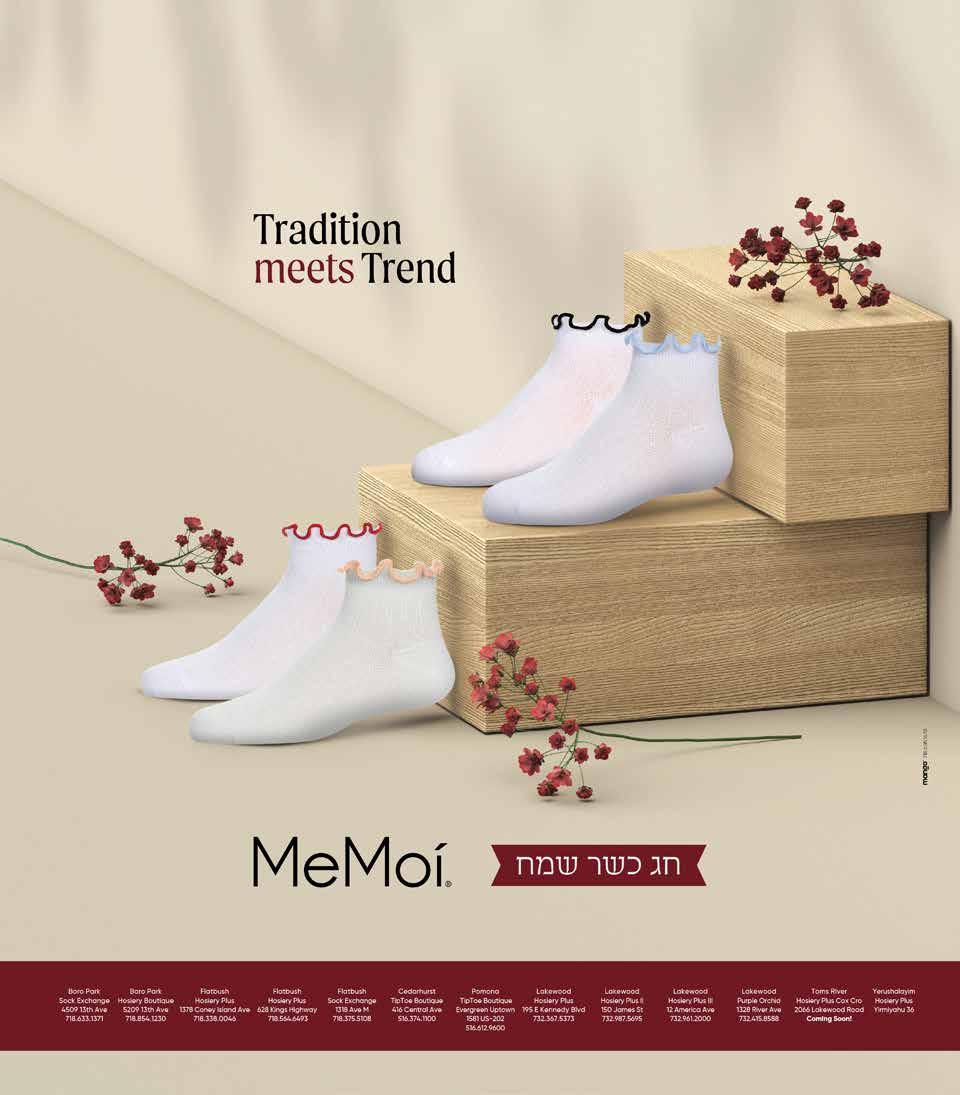

and bring us triumph over own enemies very soon. It is from the strength of that belief in the Eternal One that we can proceed to a joyous and serene Pesach.
My parents, z”l, were both survivors of a total of at least nine concentration camps. I grew up with their friends and relatives who were all people of good cheer. Despite their horrific experiences and losses, they smiled, laughed, and managed to enjoy life.
How was this even possible? I believe that one of their secrets was the belief and total certainty that they would be reunited with their lost loved ones at techiyas hameisim. They invited their souls to weddings and bar mitzvahs, spoke to them as if they could respond, and looked forward to a better world. We, too, must learn to live with hope and even if we can’t sing shirah yet on some of recent events, we must act
were his rebbeim, so why he didn’t go to them? His answer is that Rebbe Akiva was the one who could conduct the Seder in joy even in the darkness of the Roman Empire which forbade Torah from being studied. Indeed, Rebbe Akiva was one of the Asarah Harugei Malchus executed brutally by the Roman government. However, Rebbe Akiva, who began life as an ignoramus, knew that life can turn around in a moment. He was the one who saw the stone being penetrated by dripping water and concluded that his own brain could be opened by Torah. They looked for Rebbe Akiva’s light in the darkness and found it in B’nai Brak.
But there is another, perhaps even more surprising, source for simcha in our lives, even when our hearts are heavy. The Gra (Shenos Eliyahu Berachos 5a) teaches us that when we say Krias Shema, it should be done b’simcha – with joy. On the surface, this is surprising since Krias Shema represents kabbolas ol malchus Shamayim, accepting the yoke of heaven, which is quite a serious business. How can it be b’simcha? Indeed, Rav Dovid Cohen, Rosh Yeshivas Chevron, (Zman Cheiruseinu, page 346) offers a source in Chazal (Tanna D’bei’Eliyahu) that we must accept Hashem upon ourselves with great joy. Isn’t this a contradiction in terms?
His answer is that it is not because we can be mekabel ol malchus Shamayim with ahava, love of Hashem. That, too, flows from simcha, the joy of knowing that all that Hashem does is for the best. On Pesach, we must remember that just two generations ago, our ancestors, parents and grandparents baked matzah in Auschwitz and Bergen Belsen, remarried after the Holocaust/Churban Europa, and began new lives. They did this out of love of Hashem and knowing He always loves us.
during the Seder and entire yom tov as if all will be well because Hashem has promised us Techiyas Hameisim and the ultimate redemption.
The Aruch Hashulchan raises the famous question of why the Haggadah tells us that all the Taanaim had the Seder in Rebbe’s Akiva’s home in Bnei Berak. First of all, why weren’t they in their own homes? Secondly, he was their student and they
At the Seder, we welcome every one of our children, even the rasha. In fact, Chazal tell us that when we bowed to Hashem because He promised us children, that referred to the wicked son. Every child is a precious gift, as is every moment of life. We must thank Hashem for everything, and then He will be ever more kind to us and bring us redemption. A wise man once said that geulah sheleimah and refuah sheleimah must have the prerequisite of teshuvah sheleimah. The Seder and Pesach as a whole is a time for gratitude and happiness. This breeds more joy, and the presence of the Shechinah in our lives will, G-d willing, truly bring us the geulah sheleimah b’meheirah b’yameinu. Amen.



The mitzvah of Sippur Yetzias Mitzrayim is derived from a pasuk that is the most oft-repeated pasuk in the Haggadah:
“V’higgadetah l’vanecha ba’yom ha’hu leimur, ba’avur zeh asah Hashem li b’tzeisi mi’Mitzrayim, You shall tell your son on that day, ‘It is because of this that Hashem did so for me when I left Mitzrayim’” (Shemos 13:8).
Because of what? What is the “this” to which the pasuk refers?
Rav Dovid Avudraham, the renowned commentator on the siddur, notes that the word zeh, this, has a gematria of twelve. Thus, he explains, the pasuk is stating that Hashem took us out of Mitzrayim because of zeh, because of the twelve mitzvos that we perform on Seder night. The Avudraham lists the twelve mitzvos as follows:
1-4 –Four cups of wine
5 – Charoses
6 – Karpas
7, 8 – Netilas Yadayim (for karpas and for matzah)
9 – HaMotzi
10 – Matzah
11 – Maror
12 – Koreich
Twelve is quite a significant number of mitzvos to be performed on one night. On no other night of the year do we perform twelve specific mitzvos.
The Chida, Rav Chaim Dovid Azulai, asks that the Avudraham seems to have omitted the most important mitzvah of Leil Seder! The mitzvah of Sippur Yetzias Mitzrayim, relating the events of the Exodus, is glaringly absent from the Avudraham’s list.
The Avudraham interprets “ba’avur zeh” to mean “in merit of the twelve mitzvos that we perform on the night of Pesach, Hashem took us out of Mitzrayim.”
What about the beginning of this very pasuk, “V’higgadetah l’vanecha ba’yom ha’hu, You shall tell your son on that day,” the events of Yetzias Mitzrayim?
The Chida answers that the Avudraham was counting only mitzvos ma’asiyos, mitzvos that are performed through action. He did not include mitz-

vos that are performed by speaking. Since we fulfill Sippur Yetzias Mitzrayim merely by talking, it is not included in the list of mitzvos.
If we were to include all the mitzvos, even those that are not actions and are fulfilled with speech, how many mitzvos would there be on the night of the Seder?
Rav Shlomo Brevda writes that a rebbi in the city of Mir, Poland, R’ Yosef Shlomo, would quote Rav Elchanan Wasserman, who had a tradition from the Vilna Gaon that if one were to add all the mitzvos of the Seder night, including the Haggadah and all the brachos we recite, he would arrive at a total of sixty-four mitzvos!
Sixty-four mitzvos is a far greater number of mitzvos on one night than on any other time of the year. We do more mitzvos on Leil Seder than we do on Rosh Hashanah or Yom Kippur.
I recently came across a kuntres called Mitzvos B’Leil HaSeder, written by Rav Shmuel Hominer, in which he compiled all the mitzvos and merits one can amass throughout the night of the Seder. The number of mitzvos Rav Hominer lists is a staggering total of 168. What a glorious opportunity the night of the Seder is!
But we must echo the question of the Baal Haggadah: Mah nishtaneh ha’laila ha’zeh m’kol ha’leilos? Why has the night of Pesach been selected to perform so many more mitzvos than any other time of the year? Let us examine further.
The Aveir A h of Ch A me T z is so sT ringen T
R’ Dovid ben Zimra, the Radvaz, was the Rav of Cairo and the rebbi of the great Arizal and the Shitah Mekubetzes.
The Radvaz wrote more than 2,500 responsa. In one teshuvah, he states that he was asked a very fundamental question, which we will illustrate as follows: Everyone knows that a Jew is not permitted to eat chazir, the flesh of a swine. Consuming chazir is considered a severe transgression, and yet, if some juice or gravy from a chazir falls into a pot of soup,
as long as there is sixty times more soup than nonkosher gravy, the soup can be eaten. We apply the rule of bitul b’shishim, which states that if a prohibited substance is diluted in something permissible that has sixty times its volume, then the forbidden food is considered so insignificant that it is permissible to consume the entire mixture.
Yet, when it comes to the prohibition of consuming chametz on Pesach, we are much more stringent. If even a “mashehu,” a tiny, insignificant amount, of chametz fell into a mixture of food, it is not batel. Even if the ratio of permissible food to chametz is one thousand to one, the food remains prohibited.
Why are the halachos of chametz so much more stringent than the laws of other prohibited foods, even chazir?
The following halacha illustrates the extent of the prohibition. Let’s say you are at work, and a non-Jew is eating nonkosher food at the same table at which you want to eat. The halacha states that it is permissible to eat your kosher meal at the same table. We are not concerned that the non-Jew may offer you some of his food, and you might mistakenly accept his offer.
However, the halacha is different if you want to eat your dairy lunch in the company of a friend who is having a meat meal. In this case, the mechaber rules that you cannot just sit and eat at the same table. We are concerned that you may help yourself to some of your friend’s lunch.
Your friend’s lunch is kosher, and ordinarily you are allowed to eat it. It is only in this situation, in which you are eating food in a different category, that you may not eat what your friend is eating. Therefore, we are concerned that in a momentary lapse of attention, you may partake of his food and thereby violate the prohibition of consuming dairy and meat together.
In order to share the table, a heker, a recognizable item, must be placed between you and your friend to serve as a reminder that you are not allowed to partake of his food. You can place your food on a place mat to serve as a reminder, or, if there is a tablecloth on the table, you can uncover the part of the table on

which your meal is placed. Eating on the bare table while he eats on the tablecloth can also serve as a heker. Another way would be to put onto the table a noticeable item that is not usually there, to serve as a reminder that you cannot share food.
When it comes to chametz , the halacha differs yet again. If someone is eating chametz and you want to eat your matzah, you may not eat at the same table. The mechaber writes, “Asur l’haaloso imo al hashulchan v’afilo b’hefsek mapah”; i.e., on Pesach, it is prohibited to eat at the same table as someone who is eating chametz even with a heker.
The Mishnah Berurah explains that people consuming milk and meat can share a table as long as there is a heker in place because even if some of your milk were to splash onto your friend’s meat or vice versa, it is a negligible amount and will be batel in sixty times that amount.
When it comes to chametz on Pesach, however, a crumb of chametz that falls into one’s kosher l’Pesach meal will not become batel. Regardless of the ratio of quantity between the two types of food, the mixture may not be eaten. Chametz is not batel, even in a volume that is more than one-thousandfold greater than it.
Even if a table is one hundred feet long, and a nonJew is eating chametz at the other end of the table, you still may not eat a meal on that table — even on the opposite end, a hundred feet away.
The sho’el, in presenting his question to the Radvaz, pointed out additional ways in which the issur chametz on Pesach is unique.
Someone desiring to move into a new neighborhood finally identifies a home he really would like to purchase. The non-Jew from whom he purchases the home had been living in the house for the previous twenty years. The buyer can assume that any nonkosher food has been consumed in all parts of the house.
Before moving in, is he required to take a candle and perform a bedikah? Does he have to search the house for any vestige of nonkosher food? Does he have to carefully look for nonkosher food in every nook and cranny? Absolutely not!
Yet, when it comes to chametz, not only is ownership of chametz not permitted on Pesach, but we need to conduct a full investigation and be exceedingly stringent.
Why are we so much more stringent with the prohibition of chametz than we are with any other prohibition?
There is yet another way in which the prohibition of chametz is more stringent than other issurim.
If someone finds nonkosher food in his home, there is no requirement to destroy it. One can merely throw it away.
However, if one were to find chametz in his home on Pesach, one must cover it and then burn it on Chol HaMoed. It cannot merely be discarded.
The Radvaz explores why the halachos of chametz are so stringent. Why do we have an all-out assault
against chametz? It is not batel, even in a volume one thousand times larger than it. Not only can it not be owned on Pesach, it cannot even be seen.
We must search for it, checking all the cracks and crevices to make sure it is totally eradicated from the home. We are also mevateil any undiscovered chametz and declare it hefker; i.e., we nullify it and assert that it is now ownerless. Then, if you chance upon some chametz during Pesach, it must be burned.
The Chida writes in his Haggadah , Simchas HaRegel, that there are a total of seven chumros, seven stringencies, that apply to chametz that we do not find regarding any other prohibition.
(1) bedikah – one must search his home to make sure there is no chametz.
if one were to add all the mitzvos of the seder night, including the haggadah and all the brachos we recite, he would arrive at a total of sixty-four mitzvos!
(2) chorin u’sdakin – cracks and crevices must be chametz-free.
(3) bitul – any unseen chametz must be declared nullified.
(4) sereifah – the collected chametz must be burned.
(5) issur kalshehu – even a minute amount of chametz is prohibited.
(6) bal yiraeh – chametz may not be seen at all.
(7) bal yimatzeh – chametz may not be found in your possession.
Why is the prohibition of chametz on Pesach so much more stringent than all other issurim in the Torah?
The Radvaz makes a number of attempts to answer this question b’derech hapshat, in a straightforward and simple fashion, but he rejects all these solutions.
The Amora Rav Alexandri would recite the following tefillah at the end of his Shemoneh Esrei:
Master of the Universe! It is revealed and known before You, that it is our will to do Your Will.
We really want to learn Torah in all of our free time. We really want to daven with the utmost kavanah. We want to treat our family and friends with the utmost respect.
So, what is holding us back from doing so? Two things prevent us from achieving these aspirations: the se’or she’ba’isa and shibud malchuyos.
Shibud malchuyos means that residing in galus among non-Jews, causes us to be influenced by the secular society in which we live and by their philosophy that is antithetical to the Torah.
But what is the first me’akeiv, the first barrier? What is se’or she’ba’isa, which is literally translated as “the leaven in the dough”? How does the leaven in the dough keep us from fulfilling the retzon haBorei ? Does eating bread, does eating chametz, prevent us from serving Hashem?
The leaven in the dough is a metaphor. It represents the yetzer hara, the evil inclination, the force that draws us away from Hashem. Just as yeast causes dough to rise and inflate, the yetzer hara inflames and “inflates” our hearts to desire that which is forbidden to us. The yetzer hara causes our hearts to rise. It causes our hearts to expand and feel arrogant until our hearts are soured. Rashi describes this phenomenon as the yetzer hara “rendering our hearts chametz.”
The classic book of Jewish philosophy and mussar, the Chovos HaLevavos, writes: “Man, it is fitting for you to know that your greatest enemy in the world is your [evil] inclination .”
If you were to ask people who their greatest enemy is they might answer that it is their boss, their competitor, or their arch-rival. The Chovos HaLevavos writes that our greatest enemy is: yitzrecha, your [evil] inclination: the yetzer hara.
He tells the tale of a chassid who met a group of soldiers who were returning triumphant from war, carrying the spoils of victory. The chassid tells these soldiers, “You have just returned from the small battle, and now you have to face the great war!”
The soldiers look at him incredulously. What is he talking about? What is the great war?
The chassid explains that the great war is the war that we wage every day against the yetzer hara
Therefore, the Radvaz explains, since chametz represents our mortal enemy, the yetzer hara, that is why we must deal with it so severely; it is like poison, which cannot be tolerated even in the minutest amount.
Maseches Berachos relates that a number of Amoraim, sages, would add various personal requests at the conclusion of Shemoneh Esrei .
We must completely eradicate every vestige of the yetzer hara from within us. We must search for chametz , and as we are checking under the table for crumbs, we should utilize the opportunity to stir our minds to examine ourselves for any flaws in our character. Are there any chata’im, sins, or bad character traits from which we need to cleanse ourselves?
We have to search thoroughly for even the slight-

As chametz is a symbol of the yetzer hara, we cannot own it, find it, or see it. We nullify it and then, if we happen to find some, we must burn it.
When it comes to driving out the yetzer hara, there can never be too many restrictions.
The Chida then develops this idea of the Radvaz one step further. The seven chumros, stringencies, of chametz correspond to the seven dimensions of the yetzer hara
Maseches Succah teaches, “Shevah sheimos yeish lo l’yetzer hara, the yetzer hara has seven names .” This refers to the seven distinct tools in the arsenal of the yetzer hara that he can employ to impel someone to stumble and sin.
The seven restrictions that prevent us from violating the halachos of chametz on Pesach help us stay away from all seven aspects of the yetzer hara.
Thus, chametz and the se’or she’ba’isa, the leaven in the dough, represent the yetzer hara, our mortal enemy. We have to stay as far away as possible from the yetzer hara, and therefore we have laws against chametz that are more restrictive than those for any other prohibition in the Torah.
The problem, though, is glaring. If chametz is more severe than any other prohibition because it represents the yetzer hara, then it should be assur to eat chametz the entire year. How do we understand why it is prohibited to eat chametz for only seven or eight days? One is not allowed to eat chazir (pork) the entire year. One is never permitted to eat milk and meat together. So why, if chametz must be dealt with so severely, is it permitted to consume it throughout the year?
The BirT h of Kl A l Yisr A el
Hashem took Bnei Yisrael out of Mitzrayim in the spring. As the pasuk states: “Today you are leaving, in the month of Aviv [spring ]” (Shemos 13:4). Nothing is coincidental. If the Torah calls to our attention that G-d took us out of Egypt in the spring, then this must be an important aspect of the redemption.
Spring follows the winter, during which the trees are bare, the animals hibernate, and the earth is covered with a blanket of snow. During the winter, the earth can be considered to be in a state of death and dissolution. Then the spring comes, and everything returns to life. The trees bloom, the animals frolic; the earth is reborn.
The same could be said about the Jewish people.
The Jewish people were languishing in Egypt, where we had descended to the forty-ninth level of impurity. Had we remained in Egypt even one moment longer, we would have descended to the fiftieth level of tumah, the point of no return. The Jewish people in Egypt had a slave mentality and low morale.
Hashem informed Moshe that He was going to take this nation out of slavery and prepare them for the most majestic mission in history: to be the recipients of the Torah.
How was this going to happen? How were people who were poised at the lowest level of impurity going to be primed and ready to receive the Torah, to be elevated to “a kingdom of priests and a holy nation”?
With siyata d’Shmaya, I saw a beautiful Haggadah entitled Yad Mitzrayim, written by Rav Yitzchak Isaac Chaver. He was a student of Rav Menachem Mendel of Shklov, who, in turn, was a talmid of the Vilna Gaon. Rav Yitzchak Isaac Chaver often elaborates on the ideas of the Gra. He mastered both the revealed and the hidden parts of Torah.
The yetzer hara inflames and “inflates” our hearts to desire that which is forbidden to us.
The introduction to his Haggadah is titled Pose’ach Yad. In this introduction, Rav Yitzchak Isaac Chaver presents an idea from the Arizal that is an absolute treasure:
Klal Yisrael’s stay in Mitzrayim was analogous to a gestation, an incubation period, as the Jewish people — the fetus — were developing and waiting to emerge as a nation. Egypt was incubating, so to speak, the Jewish people. Yetzias Mitzrayim, the Exodus from Egypt served as the leidah, birth, of the Jewish nation.
Just as the world is reborn in the springtime, so too was Klal Yisrael born during Yetzias Mitzrayim.

Why was it necessary for the Jewish people to be exiled to such a lowly, despicable, dark place as Mitzrayim? Mitzrayim is routinely cited as an example of the epitome of depravity.
Couldn’t Hashem have chosen a better land for the Jewish people to spend two hundred ten years of exile? Rav Yitzchak Isaac Chaver explains that Mitzrayim was chosen because the period of time that Klal Yisrael spent there was the incubation period of the Jewish people, and for an embryo to develop properly, it requires a dark, cramped place. Its best growth takes place in an environment that can be described as “ma’us, repulsive.” Mitzrayim fit the mold perfectly. There was no place in the world that was spiritually darker than Mitzrayim.
Kl A l Yisr A el’s Three TrimesT ers
Rav Yitzchak Isaac Chaver continues, explaining that the time that Klal Yisrael spent in Mitzrayim can be divided into three distinct periods.
The first period started when Yaakov and his sons migrated from Eretz Yisrael to Mitzrayim. They lived in Goshen, where they tended to their animals. As long as Yaakov Avinu or one of the Shevatim were still alive, the Jewish people were not enslaved; they were merely sojourning in a foreign land, as the pasuk says, “Ki ger yihiyeh zaracha b’eretz lo la’hem, your offspring shall be aliens in a land not their own” (Bereishis 15:13).
The second period commenced after the demise of Levi, the last of the Shevatim. Pharaoh began to put the Jewish people to work, ultimately enslaving them, as Hashem told Avraham Avinu, “va’avadum, and they will serve them” (ibid.).
The third and most bitter time began when Miriam was born; Miriam is related to the word mar, bitter. This period lasted for eighty-six years. During this time, the slavery intensified, and Klal Yisrael experienced the “koshi hashibud, the harshness of the bondage.”
Rav Yitzchak Isaac Chaver illustrates how these three periods coincide and parallel the three trimesters of gestation.
During the first trimester, the developing baby is completely hidden from the outside world. The fetus is not recognizable, and it is not obvious that the woman is expecting.
So too, when the Bnei Yisrael descended to Mitzrayim. Yaakov came with his sons, the Shevatim, and they were treated royally. Thus, their future bondage was unforeseen; they were simply foreigners in a strange land and were not enslaved.
During the second trimester, the woman’s condition begins to be noticeable, and it is obvious that there is a baby on the way. Similarly, after all the Shevatim passed away, “A new king arose over Egypt” (Shemos 1:8). The host mother, Mitzrayim, began to compel the Jewish people to work. The avdus, enslavement, began, and it became obvious that they were in galus.
Finally, during the third trimester, the baby grows larger, the time of delivery nears, and the labor is due to commence. The labor pains are an indication that the birth of the child is imminent.

So too, the third trimester for Klal Yisrael began with the birth of Miriam. That is when the bondage and slavery intensified. The harsher conditions became for the Jewish people, the more the Egyptians thought that Bnei Yisrael would remain slaves forever, while, in fact, the exact opposite was true.
The bondage became more difficult, and the slavery intensified. The intensified slavery expedited the Exodus, bringing the Jewish people closer to leaving Mitzrayim, and thus closer to their birth as a nation.
Rav Yitzchak Isaac Chaver writes that the two hundred ten years in Mitzrayim was the ibbur, period of gestation, of the Jewish people. The labor and delivery of the Jewish people began on the night of Pesach, when Hashem smote the firstborn, and lasted until the seventh day of Pesach at Krias Yam Suf
Hashem tells the Jewish people, “I will pass through the land of Egypt on this night, and I will slay all the firstborn in the land of Egypt, and upon all the gods of Egypt I will execute judgements —I am Hashem” (Shemos 12:12).
The Baal Haggadah expounds on this pasuk:
“I will pass through the land of Egypt on this night” I and no angel;
“And I will slay all the firstborn in the land of Egypt” —I and no seraph;
“And upon all the gods of Egypt I will execute judgments” —I and no messenger;
“I am Hashem” — it is I and no other.
Why was it so important that Hashem do this Himself? Couldn’t He have appointed a malach to kill the firstborn Egyptians and take the Jewish people out of Egypt — there are countless malachim in Shamayim and Hashem constantly sends them on various assignments. Why not this time?
Rabbi Yitzchak Isaac Chaver explains, based on a Gemara, that there are three keys that Hashem retains control of and does not give them to any emissary. They are:
(1) the key of rain, as only Hashem makes it rain; no malach can bring the rain
(2) the key of Techiyas HaMeisim, Revivification of the Dead
(3) the key of chayah, the key of life, i.e., childbirth.
Doctors try to predict when a baby will be born, but only the Ribbono Shel Olam turns the key to allow the birth to take place. Yetzias Mitzrayim was the birth of Klal Yisrael; birth is something for which only Hashem has the key. Thus, this was a task for the Ribbono Shel Olam Himself. It was not a function that could be performed by an angel.
The pasuk relates, “Va’tihi tz’akah gedolah b’Mitzrayim, and there was a great outcry in Egypt” (Shemos 12:30). In fact, it was so loud that the pasuk says, “There shall be a great outcry in the entire land of Egypt, such
as there has never been and such as there shall never be again” (ibid. 11:6). When Hashem killed the firstborn of the Egyptians, there was a scream the likes of which had never been heard before and will never be heard again. Why was this the scream unparalleled in all of history? Says Rabbi Yitzchak Isaac Chaver, no one screams louder than a woman in labor. But what if it’s the birth of an entire nation? That would be an unparalleled scream! That is what happened on the night of Pesach. The pasuk in Parshas Va’eschanan states, “Or has any god ever miraculously come to take for himself a nation from amidst a nation” (Devarim 4:34). Hashem took the Jewish people out of the womb of Mitzrayim; this was an unparalleled labor and delivery, and therefore it produced an unparalleled scream.
we take every possible precaution to avoid being trapped inside the spiritual womb of mitzrayim.
The Haggadah Yad Mitzrayim addresses the concept that Klal Yisrael was born at the time of Yetzias Mitzrayim, to explain why the prohibition of chametz is so stringent.
Chametz and matzah are two words essentially composed of the same letters. They each have a mem, and they each have a tzadi. The only difference is that chametz has a ches, while matzah has a hei. The difference between a ches and a hei is the small opening on the left side.
Until we left Mitzrayim, Mitzrayim was closed, symbolized by the ches, which is closed. Yetzias Mitzrayim was the leidah, and the opening of the hei represents the opening that enabled the birth of Klal Yisrael.
That is why on Pesach we cannot eat any chametz We eat matzah to signify that this is the time of our leidah. We have to be extremely careful and watchful to distance ourselves from even the most minute amount of chametz, to ensure that the opening of the hei of the matzah will allow for our exit from Mitzrayim. This is critical to Klal Yisrael’s ability to leave the womb of Mitzrayim and be released into freedom.
We therefore must distance ourselves from chametz in a manner that is unheard of regarding other prohibited foods. Chametz symbolizes a sealed womb from which we cannot escape. We take every possible
precaution to avoid being trapped inside the spiritual womb of Mitzrayim.
As a child develops, it becomes less and less important that the child’s food is absolutely sterile — the child develops immunity and is able to eat foods that may not be completely pure. But the food of a newborn must be pure and sterile, for the child has not developed immunity; it is prone to infection.
So, too, when it comes to eating chametz . Granted, chametz represents the yetzer hara, and we must avoid the yetzer hara as much as possible, but the yetzer hara is necessary for the world to exist.
The Gemara relates that when the Men of the Great Assembly davened to abolish the desire for idolatry and they saw that their tefillah was answered, they figured that while they were at it, they would daven to abolish the yetzer hara for immorality — but the world was not able to function. Even the chickens stopped laying eggs. A modicum of yetzer hara is a prerequisite for the world to go on.
However, Pesach is the time of our birth, it is our beginning, it is when our spiritual life is fragile. On Pesach, at the time of birth, every small element of yetzer hara must be searched for, in every nook and cranny. Every crumb must be destroyed. Even a mashehu is not batel, nullified.
At the time of birth, the environs must be pure and sterile from the yetzer hara.
When a baby is born, the moment of birth and the first few hours are critical. The baby is very sensitive, and there are certain vital activities that must be performed. In fact, Maseches Shabbos enumerates seven activities that are so vital to the life of a newborn baby that one is even permitted to be mechallel Shabbos, to desecrate the Shabbos, to perform them. It is permissible to bathe the baby in warm water, and one can rub lotion onto the newborn’s skin. One is allowed to swaddle a newborn as well.
The night of Pesach is the leidah of Klal Yisrael. This is the time that the Jewish people were born as a nation. “Ba’avur zeh asah Hashem li b’tzesi mi’Mitzrayim.” We have twelve mitzvos to actively perform on Seder night. Together with all the mitzvos that we execute with dibbur, with our speech, we have a total of sixty-four mitzvos and even more meritorious practices that are part of the Seder protocol.
This is more than at any other time of the year. These mitzvos are critical because this is when we are the most fragile, this is when our spiritual lives are beginning. These are the mitzvos that give us the koach, strength, to prevail throughout our entire spiritual lives.
This article has been excerpted from Rav Daniel Glatstein on the Haggadah published by ArtScroll.
Rabbi Daniel Glatstein is the Mara D’asra of Kehilas Tiferes Mordechai in Cedarhurst, NY, and author of numerous seforim in Lashon Hakodesh and in English for ArtScroll. He is an international lecturer and maggid shiur. His thousands of recorded shiurim are available on Torahanytime.com, podcast, his website rabbidg.com, and other venues.

There is no more glorious night in the Jewish calendar than Seder night. It is a night when families gather together to recite and to remember, to educate and to experience, to uplift and to uphold. It is a night filled with mitzvot, in both deed and word, that is geared to uplift us all to a better spiritual place. The vehicle which guides our journey is the Haggadah, the text which probably has more commentaries than any other book in our library. The Haggadah and its commentaries allow each Jew around the table, young and old, seasoned scholar and layman, to participate in creating the experience of reenacting yetziat Mitzrayim
There are two different types of commentaries within our tradition, those that “zoom in” and those that “zoom out.” For example, the Maggid Mishneh and Kesef Mishneh commentaries on the Mishneh Torah of the Rambam are “zoom in” types, delving into understanding the words of the Rambam and discovering which earlier sources his writings are based on. The classic commentaries on the Shulchan Aruch, on the other hand, are of the “zoom out” variety, generally using the text as a springboard to present new issues and related situations. We have tried, throughout this work, to employ both approaches, one that stimulates questions which tow from the text and enables one to delve deeper into the classical sources, and one that uses the Haggadah as a springboard to discuss ethical and spiritual messages. Our tefillah is that the words found in this commentary help foster discussion, curiosity, and above all, learning and feelings of closeness to Hashem.
The Seder night is built on the principle of hakarat hatov, as can be seen in many of the practices throughout the evening; we are called Yehudim based on this basic and defining principle. The Chofetz Chaim was once overhead in his study talking to Hashem: “What have I done for You? You have given me the zechut to write the Mishna Berura,

Shemiras HaLashon, Chofetz Chaim, and more, but what have I done for You?” It is truly a zechut to be able to share Torah with Jews, both in person and virtually, and now, through the pages of this Haggadha. Ma ashiv LaShem kol tagmulohi alai. I continue to try to
is something that we fulfill on a daily basis. We mention yetzi’at Mitzrayim each morning and evening in the third paragraph of the Shema. However, retelling the intricacies of the event, along with questions and answers – this we perform once a year at the Seder.
into the intricacies of the event. This is what enables the remembrance to work for a whole year. Similarly, if we limit our focus to merely one night, it wouldn’t last either. We need a combination of daily remembering backed up by an annual, extended retelling in order to reinforce its significance.
Rav Asher Weiss (On Mo’adim, vol. 3, ch. 15) compared this phenomenon to that of a telephone speed dial. It takes time and effort to input the phone numbers of one’s family, friends, and business associates, but once they are saved in the phone, one can push a single button and use speed dial to quickly call a number. Seder night is equivalent to the initial insertion of all the contact information. We spend time and effort exploring the details of what transpired when we experienced the Exodus. Then, during the rest of the year, all we need to do is just mention yetzi’at Mitzrayim, and it brings up our memory of the story we discussed in more detail at the Seder.
We need a combination of daily remembering backed up by an annual, extended retelling in order to reinforce its significance.
be a committed servant and act as a conduit for bringing some of the endless divrei Hashem to His people.
Rav Chaim Soloveitchik (Emek Beracha Haggada, p. 1) distinguishes between the mitzvah of zechirat yetzi’at Mitzrayim (remembering the Exodus from Egypt) and sippur yetzi’at Mitzrayim (retelling the story of the Exodus from Egypt). Remembering the Exodus
Notwithstanding that one can distinguish between remembering, which requires one to merely mention the Exodus, and retelling the story in full, perhaps they in fact work in tandem. Rav Yosef Dov Soloveitchik (Rav Chaim’s grandson) in his sefer Me’afela Le’Or Gadol, suggests that if we had a mitzvah to merely remember yetzi’at Mitzrayim in a cursory manner every day, the memory would not have a lasting impact . That’s why we need to spend one night a year delving
There are other examples of how we can use both an extended and abridged style in order to commemorate an event. For instance, on Tisha BeAv, we experience twenty-four hours of mourning the destruction of the Beit HaMikdash. Yet there are smaller symbolic acts we perform on occasion to remind us of the destruction, such as leaving an unfinished portion of a wall opposite the front door (Bava Batra 60b) or reciting Al Naharot Bavel prior to Birkat HaMazon (minhag instituted by the Shla). We can be reminded of the destruction of the Beit HaMikdash on occasion, so long as we experience an extensive mourning once a year.
Similarly, the combination of the daily remembrance coupled with the annual, in-depth discussion of yetzi’at Mitzrayim at the Seder is the winning formula to ensure that this momentous event is embedded in our hearts and minds.
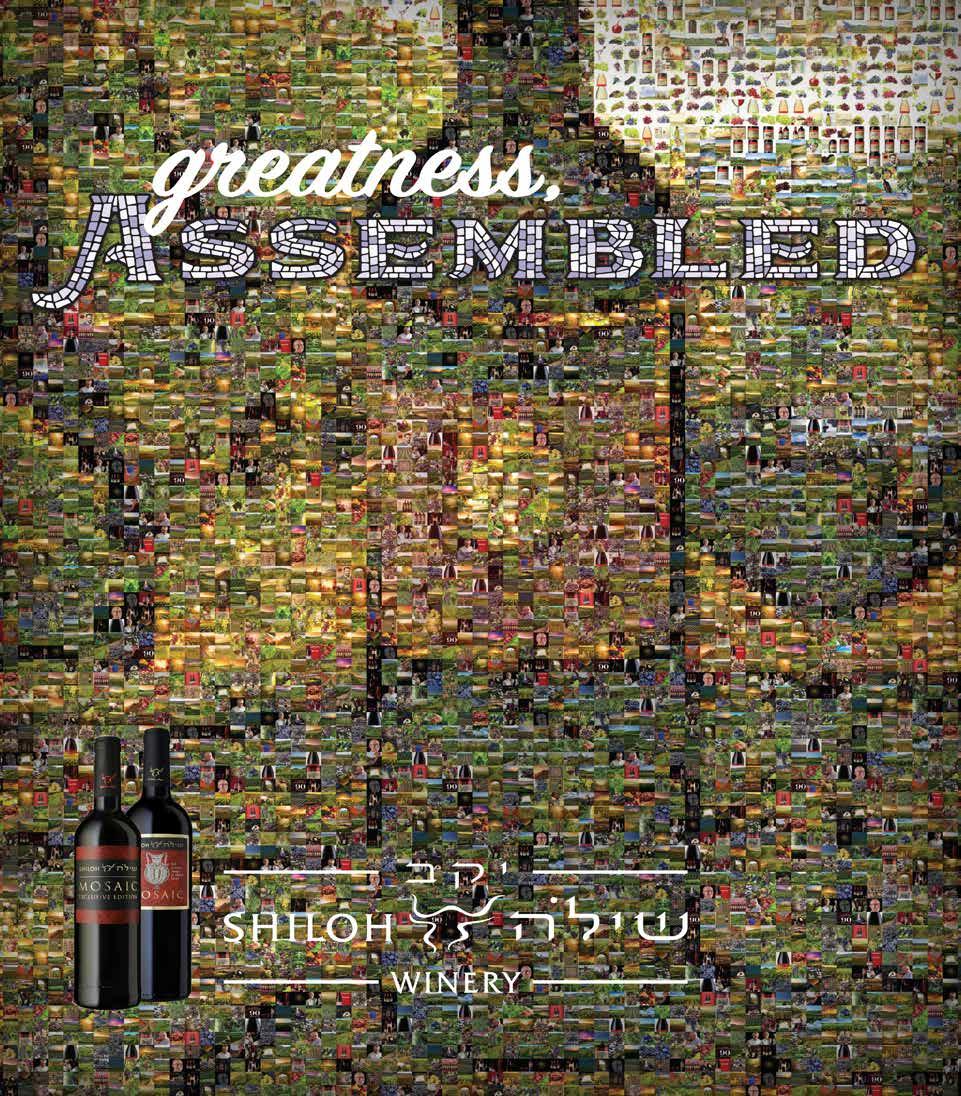

As we approach Pesach, our preparations often focus on the physical preparations – the cleaning, the kashering, the meticulous checking of each child’s winter coat looking for and removing even the wrappers, the crumbs, and everything else. While these preparations seem taxing and mundane, they connect to a profound spiritual lesson we can learn from Moshe’s interaction with Pharaoh.
Towards the end of the showdown that takes place between Pharaoh and Moshe, Pharaoh summoned Moshe and said, “Go! Worship the L-rd, but your flocks and your cattle shall remain [in Egypt].” Moshe responds by demanding that Bnei Yisrael leave with all of their property including the livestock “for we will take from it to worship the L-rd our G-d, and we do not know what we will need to worship the L-rd until we arrive there.”
The exchange here is fascinating. Pharoah is willing to allow all the Jews to go free from slavery, after hundreds of years of servitude – but Moshe refuses, demanding that even the livestock should leave with them. Pharoah refuses and then comes the tenth plague.
Why was Moshe so adamant on the point of the livestock, and why was Pharaoh so stubborn not to let the sheep go?
The Chiddushei Harim (the first Gerrer Rebbe) pointed to one generally overlooked line as the crux of the issue, “We do not know what we will need to worship the L-rd until we arrive there.” The Chiddushei Harim said this encapsulates one of the most fundamental philosophies of Judaism, one that clashes with Pharoah and Egyptian philosophy and culture. This message, the Chiddushei Harim pointed out, is for every single Jew about our final judgment.
We have no concept of how relevant or important the smallest of our actions can
By Rabbi Benny Berlin
be in the eyes of Hakadosh Baruch Hu. Every mitzvah, regardless of the scale we might think it to be, must be viewed as the most important – because we do not know how Hashem’s scale operates. Each act, as minute as we might think it to be, could be the greatest mitzvah and the one that ultimately tips this scale in the favorable direction.
When we do things in private, like control our emotions when we find ourselves angry, when we hold back in engaging in lashon hara, or when we might go the extra mile for a chessed that no one may ever know about – each of these small acts can be greater than the most public and monumental mitzvah.
Similarly, the Rambam said we have to view our lives and every action as if the scale is slightly imbalanced and one small action can tip that scale in the right direction. In Moshe’s mind, every sheep was important because he did not know how much would be needed to serve Hashem properly until after Yetzias Mitzrayim when Bnei Yisrael were ready to serve Hashem. This one sheep could tip the scale for all humanity.
Herein lies the difference between the mindset of Pharoah and Moshe. In Pharaoh’s mind, a lowly human choice is completely irrelevant. In Egyptian society, each person was enslaved to their societal position. They could never reach higher than the caste system they were enslaved to. The concept that actions –however, great or small – could change a destiny was foreign. The pyramid never moved, and Pharaoh’s negotiation tactic was a way of reminding the Jews that small actions do not have significance.
Alternatively, Moshe sees the exact opposite, that destiny is determined by the addition of each small action, each person and each mitzvah.
It is in this way that ultimately an impasse on the matter of the Bnei Yisrael’s livestock became a clash of ideologies. We can glean a wider lesson from our search for mere crumbs before the holiday. The little things do matter significantly more than we imagine, but we do not know fully until we get to the Olam Ha’Emes.
Towards the end of World War II, the Skulener Rebbe, Rabbi Eliezer Zusha Portugal, was able to procure a small
measure of wheat to make matzahs. He sent messages to the various Chassidic leaders in the area that he would distribute three matzahs to each Rebbe and they could run group Sedarim for their Chassidim. Leader after leader came to receive their allotted matzahs, but when the son of the Viznitzer Rebbe came, he relayed a request from his father for six matzahs and the Skulener Rebbe initially refused. The son was insistent, and so the Sklener Rebbe acquiesced.
On Erev Pesach, the son came back and asked if the Skulener Rebbe had any other matzahs for himself. He answered that he had given them all away. The son then produced the three matzahs to return to the Skulener Rebbe, explaining that his father knew this would happen and so he had asked for the extra ones to keep for the Skulener Rebbe.
This story personifies the point of the small actions that matter. With all the terrible things and worries that were taking place at the end of World War II, the Viznitzer Rebbe was concerned that the Skulener Rebbe would have matzahs for himself.
We have no idea of the spiritual impact of these small actions, and this is what the debate between Pharaoh and Moshe teaches us. They are not just arguing about sheep and cows but rather the importance and relevance of our small actions, those small crumbs we search for under the couch.
May we find greatness even in the small actions and may this give us strength to extend ourselves to do the service of Hashem, ha’ketanim im ha’gedolim.
Rabbi Benny Berlin is the rabbi of BACH Jewish Center located in Long Beach, New York. For more information, visit: https://www.bachlongbeach.com/.


“therefore, say to the Bnei yisrael, ‘i am hashem. i will extricate you from the burdens of Egypt and free you from their slavery. i will redeem you with a demonstration of My power and with great acts of judgment.’” – Shemos 6:6
“i will harden Pharaoh’s heart and thus will produce the opportunities to display many miraculous wonders and signs in Egypt.” – Shemos 7:5
At the end of Parshas Bo, in validating the centrality of the mitzvos that serve as reminder of Yetzias Mitzrayim, the Ramban famously explains that the makkos were meant to pierce the veil that conceals Hashem. The strands of which that veil is woven are the Laws of Nature. All of the makkos were openly miraculous, flouting numerous laws of nature in the most overt way.
The Maharal and the Chidushei HaRim explain that the 10 makkos were the bridge between the asara ma’amoros shebahem nivra haolam, the 10 pronouncements through which the world was created, and the Aseres Hadibros, the 10 commandments through which the Torah was revealed. A world that does not perceive Hashem as the Creator is unready to accept Hashem as the Divine Legislator. By laying bare the existence of a Force that superseded Nature, that could utterly manipulate nature and that could bend nature to its supernatural will, the makkos removed any the lingering doubts about the existence of Hashem the Creator and proved the truth of numerous principles of our faith. Thus understood, one could jump to the erroneous conclusion that the Hashem-concealing, illusion-of-independence-projecting, natural order is constantly at odds with Hashem. In fact, nature is the regular and consistent ex-

pression of the Divine Will. Why and when the Divine Will chooses to superimpose the hanhagah nisis – the miraculous management of the cosmos – upon and, apparently, against the hanhagah tiv’is – the natural management of the cosmos – is something that only the Divine Mind knows.
In this same vein, many of us striving to make good choices and grow spiritually regard our own human natures as obstacles. We are conditioned to fight our natural impulses. We associate them with our yetzer hara. But the pasuk says, “Everything that HasShem has made is for His own sake.”(Mishlei 16:4) That is to say, for His greater Glory. All of the works of creation are expressions of the Divine will.
When inanimate objects and living beings behave according to the laws of nature, they are fulfilling the will of Hashem. The great challenge with things behaving “naturally” is that they appear to be on autopilot. The Divine Will that created the Laws of Nature and that continues to direct natural law often becomes obscured by natural processes. This is why Torah numerologists have pointed out that “Elokim” has the same gematria as “hateva,” the nature (86), and why Torah etymologists teach that the root of the word Olam, world, is he’elam, concealment.
When Rabi Pinchos ben Yair trav-
eled to fulfill the mitzvah of pidyon sh’vuyim , he reached the banks of the Ginai River and could go no further. He commanded the river waters to interrupt their flow so that he could cross through the riverbed and proceed on his mission of mercy. The river responded, “You go to do the Will of your Creator, and I go to do the Will of my Creator. There is only a chance that you will fulfill the Creator’s Will but, so long as I flow, I’m most definitely fulfilling the Creator’s Will. If so, why should I cease my flowing so that you can get going?” (Chulin 7A).
Ultimately, the river split for Rabi Pinchos ben Yair, and he accomplished his mission of pidyon sh’vuyim. But the “conversation” between him and the river is significant in that it establishes beyond a shadow of a doubt that even inanimate things functioning according to the Laws of Nature are doing the will of Hashem. It belies the philosophy that Nature opposes Hashem. Nature is no more Hashem’s enemy than the veil is the face’s adversary.
Hashem brought the cosmos into being through the “10 pronouncements.”
All that exists in the cosmos, and the way in which they function, are expressions of Hashem’s will. We define a mitzvah as a thought, word or act having a positive and ethical charge. What makes them “good” or positive is
that they are consistent with, and fulfillments of, Hashem’s will. As such, it follows that every one of Hashem’s non-free-will-endowed creatures that behave according to natural law is, in a sense, performing mitzvos.
Rav Tzadok, the Lubliner Kohen, teaches that just as in the macrocosm, a river running downstream is “running to do with the Will of its Creator,” so, too, in the microcosm known as man, all the natural impulses induce man to “run to do the Will of his Creator.” When a man thirsts, it is Hashem’s will that he hydrate himself. When a man hungers, it is Hashem’s will that he ingest nutrition. When a man grows fatigued, it is Hashem’s will that he sleep. When human acts of eating, drinking, and sleeping are done as responses to the dictates of human nature, they too are mitzvos. When they are indulged in excessively, going beyond the dictates of nature, they are not, and they cross the boundary into negativity.
Over the past decade, Perek Shirah has gained enormous popularity. This concept is the deeper meaning of Perek Shira. When we hear a frog croaking cacophonously, we run for a pair of earplugs. We hardly consider this croaking to be the music of a symphony orchestra. But when the frog tells King Dovid that “I sing Hashem’s praises day and night” (Zohar Pinchos 222:B) what it

P26 really means to say is that just acting naturally and croaking, in accordance with the nature endowed in the frog by its Creator, is sweet music, a “singing of the Divine praise.”
“… [The frogs will be] in the homes of your officials and the people, even in your ovens and in the kneading bowls.”
- Shemos 7:28
“Why did Chananiah, Mishael and Azariah deliver themselves to the fiery furnace, for kiddush Hashem? They argued a kal v’chomer to themselves: If frogs [of the second plague] which are not commanded concerning kiddush Hashem yet it is written of them, “and they shall come up and go into your house…and into your ovens, and into your kneading bowls,” when are the kneading bowls to be found near the oven? When the oven is hot! [Then we must

certainly do so.]” - Pesachim 53B
While behaving “naturally” is the default setting for “running to do with the Will of the Creator,” it is essential to
the Creator.” The most basic instinct for all species is the survival instinct. Yet, during redemption process, when Hashem chose to superimpose the su-
When inanimate objects and living beings behave according to the laws of nature, they are fulfilling the will of Hashem.
remember that in some unusual times and circumstances, supernatural and contra-natural behaviors are required in order to “run to do with the Will of
pernatural hanhaga nisis upon the hanhaga tiv’is, then, as part of the second plague, the frogs threw themselves into the hot ovens flames, contravening the
survival instinct that is most primary to all creatures.
While humans are endowed with free will and the rest of Hashem’s creatures are not, we must nevertheless learn from them and exercise our free will choices appropriately. While choosing to maintain our lives and responding to the dictates of our natures is often a mitzvah, making choices that are contra-natural, even to the point of mesirus nefesh and self-destruction, can be “running to do with the Will of the Creator” as well. As the pasuk says, “[Hashem] Who teaches us — from the beasts of the earth, and makes us wiser — from the birds of heaven.” (Iyov 35:11)
As it goes for the macrocosm, so it goes for the microcosm. There is room for the redemptive and the supernaturally, contra-naturally miraculous within human beings as well. On Pesach, we celebrate our capacity as benei chorin, free and ready to follow the will of Hashem wherever and however it commands us.
The article has been excerpted from the new book From The Waters of The Shiloach: Plumbing The Depths of Toras Izhbitz, available now in Jewish bookstores and on mosaicapress.com. It is a landmark work exploring the fascinating teachings and chassidus of The Mei HaShiloach and his disciples. Rabbi Schwartz, who dedicated his life to teaching Torah and being mekarev Yidden, spent the final years of his life writing this book. May this Torah be an aliyah for his neshama.
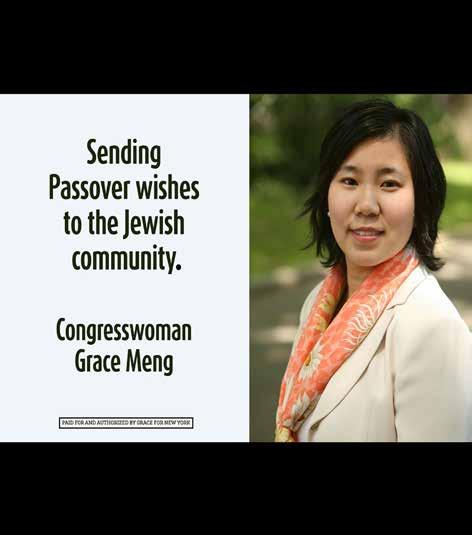


Pesach cakes have almost become completely gebrochts-free. They have also become quite expensive. Indeed, one shopper at a supermarket in the Five Towns had recently commented, “I have become gebroke from gebrochts!”
In many families, matzah brei is a favorite. In others, it brings shudders down the spine (well, almost). The issue, of course, is gebrochts.
What is gebrochts all about, and where did it come from?
The Shulchan Aruch (OC 461:4) writes that one fulfills the mitzvah of
matzah with matzah shruyah – gebrochts, soaked matzah – as long as the matzah remains intact and whole. This is based upon the Gemara itself (Psachim 41a), which states the very same law. What then is the source for the custom of avoiding gebrochts, dipped or wetted matzah?
Almost without exception, the custom to refrain from gebrochts has spread throughout the chassidic world and even among others. What are some of the halachos of this minhag? How did this minhag develop?
In this article, we will address some pertinent halachos as well as attempt to trace the origin of this stringency.

A woman should follow the custom of her husband. Thus, if while she was single she did not eat gebrochts but married someone whose custom is to eat it, she may eat gebrochts on Pesach – even without doing hataras nedarim. This is the view of Rav Moshe Feinstein (IM Vol. I #158), Dayan Weiss (Vol. IV #83) and Rav Shlomo Zalman Auerbach (Halichos Shlomo, Pesach 4:20).
Various Leniencies
Rav Elyashiv, zt”l, was asked a question by a non-grebocht eater: “My father is sick. Is it better for him to eat gebrochts or kitniyos?” He answered (Ashrei HaIsh 60:20) that it is better to eat gebrochts.
Some who have the minhag to avoid gebrochts do allow semi-solids on the matzah such as butter. Others forbid this as well (See Piskei Teshuvos 458, note 23).
Some allow children to eat gebrochts, while they themselves avoid it.
Earliest References
The first reference this author could find that directly mentions the minhag of avoiding a form of gebrochts is the Olas Shabbos (453:3) who discusses a halacha in the Bach that matzos should be baked prior to Pesach and not during Pesach. Why is this so? Chometz is only batel before Pesach and not during Pesach. The Olas Shabbos adds, “And one who is concerned for this stringency should not cook a baked matzah on Pesach either, for how is it different than baking?” In other words, the Olas Shabbos is concerned that the chometz that was mixed into the matzah but became nullified before Pesach is now re-awakened on Pesach itself.
The Mogen Avrohom 458:1 cites the Olas Shabbos and asks a series of questions on it, differentiating between the Bach’s case and the scenario described by the Olas Shabbos. Regardless, the

concern of the Olas Shabbos deals with a gebrochts of actual cooking. Simply soaking the matzah would not seem to be a concern of the Olas Shabbos, because it is not reawakened yet through any process.
The Knesses HaGedolah cited by the Mogen Avrohom (OC 473) tells us to avoid using it as a fish coating because of a woman who once confused it with flour. The Pri Chadash in 461:2 disagrees and writes, “I say that this is all permitted, and we cannot make our own enactments, and who cares if one woman made a mistake in halacha?” The Shaarei Teshuva in OC 460:2, after explaining that it is technically permitted, writes, “Nonetheless, one who wishes to sanctify himself with that which is permitted…we do not stop him.”
The next time we see a concern for gebrokts in print is in the response of Rabbi Shneur Zalman of Liadi, the GraZ, or the Baal HaTanya. The concern he raises is that perhaps the matzah was not kneaded sufficiently, and some unbaked flour remains on the matzah. The soaking will thus bring about a “chometzization” process.
The observant reader will note that this is a different concern that was mentioned by the Olas Shabbos. The Machtzis HaShekel voices the same concern in 458:1 about the unbaked flour. The Aishel Avrohom (Botshatch 447:4) is similarly concerned.
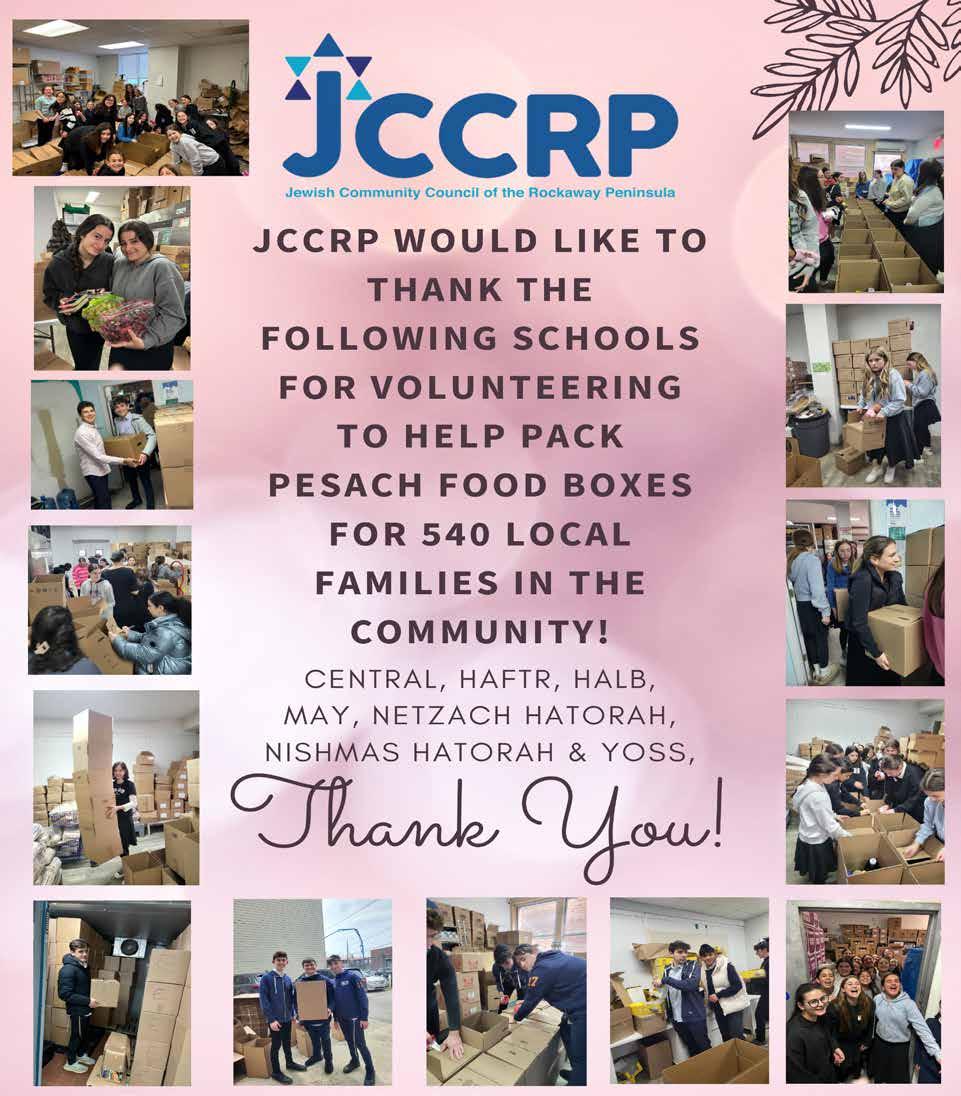
If we wish to find hints to the common practice of avoiding some form of gebrochts, we can. The Gemara in Psachim (40b) discusses an item called chassissi , which the workers of the house of the Raish Galusa would make. There were Amoraim, the Gemara indicates, who were unsettled with eating it, however. Although Rabbi Yitzchok quoted in Tosfos understands it to be a lentil paste, the Rif describes it as matzah that was rolled and cooked.
There are also two fascinating quotes of the Raavan (Psachim 73b). Firstly, he writes that one should avoid soaked matzah in soup on the first night of Pesach, because this takes away the taste of matzah itself. This is actually a proof to the notion that on the rest of Pesach one can eat gebrochts. However, he also writes that one should avoid making matzah balls because people may come to do it with flour itself and cook it. The Be’er Heitev OC 460 cites the Knesses HaGedolah to this effect as well.
The Ravya (Psachim 475) also explains that some people do not make kneidlach out of a concern that others may mix this up with doing it with flour and water. He describes this stringency
as a chumrah of a baal nefesh (a worthy individual).
The Maharshdam (responsa OC #26) describes yupkes, a matzah meal-based item, and explains that a baal nefesh should avoid it.
How does it fit into common practice? For the Korech section of the Pe -
There are also opinions that it is forbidden to be stringent. The Sheilas Yaavetz (Vol. II #65) cites his father the Chacham Tzvi that it is wrong to disallow the simchas yom tov with far-fetched stringencies!
Rumor has it that some members of the Chasam Sofer’s family even have the recipe for kneidlach that his wife used. Wishing
sach Seder, people who avoid gebrochts just dip the marror in the charoses – not the matzah (See Mishna Brurah 475:19). Is it muktzah for those who do not eat it? The Chazon Ish (Shabbos 49:15) rules that cooking kneidlach from yom tov to Shabbos may be muktzah if one’s minhag is that gbrochts are forbidden. If one is merely stringent to avoid it, then it is permitted.
So when did the chassidim start the minhag of not eating gebrochts? Reb Mendel of Vitebsk is cited by many of the early chassidim as attributing it to the Maggid of Mezrich and that, believe it or not, the Baal Shem Tov did eat kneidlach!
The Chasam Sofer (Responsa OC 138) also used to consume gebrochts – especially with soup kneidlach. Rumor has it
that some members of the Chasam Sofer’s family even have the recipe for kneidlach that his wife used.
It is also interesting to note that the change in our Pesach cakes adversely affects Sefardic Jews and those who follow the customs of the Vilna Gaon. How so? When there is no mezonos (matzah meal) in what is baked, it is not subsumed under the leniency of pas palter – baker’s bread. It would be considered bishul akum for Sefardim and for followers of the Vilna Gaon. Since most of our bakeries have an aino Yehudi preparing the Pesach cake, the non-gebrochts Pesach cakes would not be kosher for Sefardim.
In conclusion, Pesach allows us yet another opportunity to connect with our generations past, by strictly adhering to the minhagim of our parents and grandparents. Focusing on this aspect of the minhag will allow us to further our growth over this yom tov.
A gut yom tov!
This article should be viewed as a halachic discussion and not practical advice. The author can be reached at yairhoffman2@gmail.com.



Rav Shimshon Pincus once met a colleague who had just come back from a fundraising trip in America. The fellow was somewhat dejected, since he had been unable to gather the necessary funds for his yeshivah. Rav Shimshon told him that if he really believes in what he is doing, and is truly confident that it is beneficial for the donor to give him money, then he would be more successful. In fact, he insisted, there was no way he would ever fail. Rav Shimshon then gave an example to prove his point.
“One time, when I was in Los Angeles, someone showed me a New York Times article from 1942 where the Vaad Hatzalah advertised that for $50, one could save Jews in Europe. Imagine that you had read that article, and, unlike American Jewry in 1942, you knew what was happening in the war. You knew that every Jew there wasn’t safe and that he would, in all probability, be killed unless you were able to get him out of the inferno — soon. And for $50 you would be able to save those people. When you went knocking on doors, you would not leave without a significant donation. You would beg and implore every person to give you the necessary funding. You’d know the value of every $50.
“Indeed, if you really believed that it is beneficial for every person to give the money — so that he could take part in this precious mitzvah of saving lives — you would not leave without a check. Failure would not be an option.
“That,” he said, “is the key to raising money for those who are learning. You must really believe that the person who is giving the money is receiving a benefit by giving the money and joining in the mitzvah of limud haTorah.”
Rav Shimshon recalled an anecdote to emphasize his message.
“There was a housing office in Ofakim, where there were always very long lines. The woman behind the desk was careful not to let anyone cut the line.
“One day, I saw her father walking near our home, when suddenly he collapsed. Before anyone had a chance to revive him, he passed away. I quickly ran to the woman’s office to inform her of the tragic news. As usual, there was a long line, but I walked right up to the front. She immediately snapped at me that I was to wait in the back of the line like everybody else. But I told her that I have to talk to her about something very important. Again, she told me that I should go to the back of the line. I leaned forward and asked her if she knew where her father was. She did not understand the question, and I repeated it. ‘Do you know where your father is?’ I broke the news to her gently, and she began to cry. Of course, she apologized for trying to send me away.
“Can you imagine if I would have waited in line to tell her this news? What an absurd thought that is. I knew I had something very important to say to her, and I wasn’t about to let anything stand in my way.”
Although Rav Pincus used this story to encourage a fundraiser, this is the way a parent must approach the Seder. We have something very, very important to tell our children. We have the traditions and legacies that our parents passed down to us, and we need to convey the lessons to our progeny.
Initially, we may be met with resistance. Our children may not want to hear what we have to say. They may tell us to “wait in line,” by stating, “I have so many important things in my life. I have school and my social life and my other interests.”
Yet, tonight we cannot be pushed away. We must let our children know how important this message is: Do you know where your Father is? Do you know where the Almighty is in your life? When they see how serious we are about it, they will stop pushing us away. They will listen to everything we have to say and will be eternally grateful to us for sharing this message.
Rav Chaim Kanievsky Haggadah
compiled by Rabbi Avraham Yeshayahu Shteinman, adapted by Rabbi Dovid Hollander
Afamily was fighting bitterly about where to go for the Pesach Seder. The husband insisted that they go to his parents, and the wife was adamant that they go to hers. Someone suggested that the couple consult with Rebbetzin Batsheva Kanievsky – as she had much experience dealing with many different life situations — and do whatever she advised.
After the rebbetzin heard both sides of the issue, she came up with an idea that appealed to both parties: she invited them to her house for the Seder! The couple accepted the rebbetzin’s offer and joined the Kanievskys for the Seder, thus restoring domestic harmony.
The Chazon Ish Haggadah
compiled by Rabbi Asher Bergman, adapted by Rabbi David Oratz and E. van Handel.
“On this night — we all recline.”
One week before Pesach, a young scholar passed away in Yerushalayim, leaving a widow and seven orphans. The rosh yeshivah of Ruzhin, Rav Yehoshua Heschel Brim, supplied the family with all their holiday needs and even arranged for a young man to conduct the Seder for them. Before departing for shul on erev yom tov, Rav Brim told his family that he would come home late. He planned to stop at the widow’s house after Maariv to help with last-minute preparations for the Seder. Rav Brim found the atmosphere in the widow’s house mournful. The young man who was to conduct the Seder had inexplicably failed to appear. Without hesitating, the rosh yeshivah proclaimed, “Kadeish.” Joyously, he led the entire Seder, ate the festival meal with them, and sang the familiar melodies.
Half an hour before midnight, Rav Brim entered his own home, where his family was waiting for him to conduct their Seder. He immediately began Kadeish again. This time, he rushed through the Haggadah; the Afikoman had to be eaten before chatzos! Only after the Afikoman was eaten did Rav Brim apologize for the delay.
“True,” said one of the family members, “you did a great act of kindness for the widow, but your family, too, needed a Seder!”
Rav Brim explained by telling the following story.
“As a bachur, I frequented the home of the Chazon Ish. Once, he told my friend and me, ‘Reuven has reached marriageable age. You must help him find a wife.’ The words of the Chazon Ish were sacred to us. We made the necessary efforts and were successful. When we reported to the Chazon Ish, he said, ‘I would like to be present for the signing of the tena’im, but since my time is very limited, please come get me when the ceremony is about to begin.’ When we came for him, he was sitting in his study with a couple. They were reading a list of items and asking which ones were preferable and how and where to obtain each item. He answered all their questions patiently. For an hour and a quarter, we waited outside the open door. The Chazon Ish saw us, but continued the conversation. Finally, the consultation ended. The couple rose, and the Chazon Ish escorted them out and bid them farewell.
“As soon as they had left his home, the Chazon Ish quickly donned his hat and
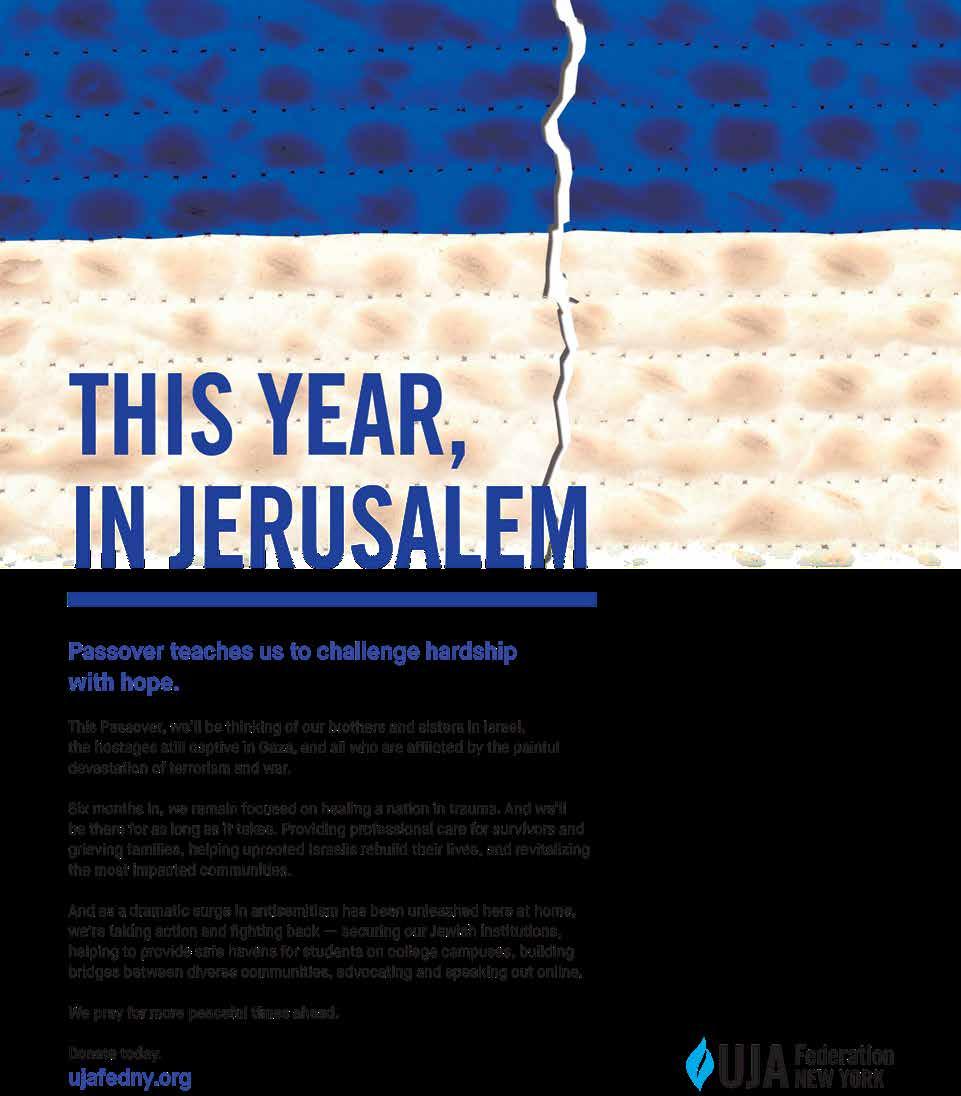
“You are surely wondering,” he said, “why I kept you and all of Reuven’s guests waiting.
“The couple with whom I was speaking are Holocaust survivors. They had told me that they had no source of income and I advised them to open a store. Now they came to consult me about how to run it and what merchandise to buy.
“I could not help them financially, since I have no money. I was therefore obligated to assist them with advice, which is also a great mitzvah.
“This mitzvah was incumbent on you and Reuven’s other guests no less than on me. I fulfilled the mitzvah by advising them, and all of you fulfilled it by waiting for me.”
Rav Brim concluded: “Each of us was obligated to gladden the widow and orphans. I fulfilled the mitz vah by conducting the Seder, and you fulfilled it by waiting for me.”
The Rav Moshe Haggadah from Rav Moshe Feinstein, compiled by Rabbi Shalom Meir Wallach, adapted by Malky Heimowitz
The granddaughter of Rav Shmuel Dovid Walkin asked him on the Seder night why we break the middle matzah to allude to the “bread of poverty” that we ate in Egypt, considering that the middle matzah corresponds to Levi, and the tribe of Levi was not enslaved.
The Rav Shach Haggadah from Rav Elazar Menachem Man Shach, compiled by Rabbi Asher Bergman, adapted by Rabbi Yaakov Blinder
“Had not the Holy One, Blessed is Be taken our fathers out from Egypt, then we, our children and our children’s children would have remained subservient to Pharaoh.”

Rav Walkin answered beautifully that it is to teach us that even though the tribe of Levi was not enslaved, they were heartbroken over the suffering of their brethren (Kisvei Abba Mari 241). •
Once, the person who was supposed to drive Rav Moshe Feinstein to yeshiva to say his shiur was waiting, yet Rav Moshe, who was always punctual, did not emerge from his house. The driver was worried; he knew how important it was to Rav Moshe to arrive on time to avoid causing large-scale bitul Torah. He went up to see what had happened and found the outer door open a bit.
He went inside and heard the sound of crying coming from Rav Moshe. Frightened, he inclined his ear and heard two people sobbing inside the room. To his alarm, he recognized the sound of Rav Moshe’s voice. What had happened?
He looked at his watch — it was getting late. He opened door a crack and saw Rav Moshe sitting in his place, with an elderly man beside him. Both of them were sobbing.
The driver made a split-second decision to open the door and ask, “Rebbi, can I help?”
Rav Moshe looked up at him, his eyes red from crying. “Oh, it’s time to go say the shiur. Please wait a little. I’m busy now.”
The driver retreated and closed the door. A moment later, the old man emerged, leaning on his cane, with Rav Moshe escorting him. Rav Moshe then went to the sink and washed his tear-stained face.
“Forgive me for the delay,” he said to the driver. “But you saw. What could I do?”
They entered the car and hurried to the yeshiva.
“Why was the rav crying?” the driver asked. “Did some tragedy occur?”
“To tell you the truth,” Rav Moshe answered, “I don’t know why.”
“What?”
“Of course!” said Rav Moshe. “You heard him crying, but you didn’t hear him speaking. He came in, sat down, and spoke some unintelligible words. Then, he started crying bitterly. I didn’t know why he was crying, and I could not help him at all. But when a Jew cries, how can I not cry with him?”
This statement seems rather unlikely. The Pharaohs have not ruled Egypt for centuries. So utterly forgotten by history is the Pharaoh of the Exodus that no one even knows his true identity with certainty. Surely, over the millennia, the Jewish people would have shaken off the yoke of slavery under natural historical circumstances, even if not for the Exodus. There aren’t even any slaves anywhere in the world anymore!
The answer to this question, said Rav Shach in the name of the great rabbis of the Mussar Movement, is that if Hashem had not taken us out of Egypt, but we would have gained our freedom through some political or natural process, taking advantage of Pharaoh’s magnanimity, we might not have remained enslaved to Pharaoh, but we would have been subservient to him — that is, we would have been beholden to him with a debt of gratitude, which would remain an encumbrance upon us for all time. There is no greater responsibility than the indebtedness owed to a benefactor for his kindness.
Rav Shach himself exemplified this trait in his personal life, as the following anecdotes illustrate.
In 5749 (1989), Rav Shach founded a new party called Degel Hatorah, which split away from the old, established party called Agudas Yisrael. As the new party prepared itself to enter the political fray and participate in Knesset elections, Rav Shach was greatly concerned that it should not fail in its attempts to gain a foothold in Israeli politics. Such a debacle would bring about a chillul Hashem in the eyes of the general public, since so many Torah leaders had thrown their weight behind it. Anything less than two seats in the Knesset, Rav Shach felt, would constitute a failure at the polls. He invested a great amount of time, effort and emotional energy into the nascent party, which, as it turned out, did achieve a second Knesset seat, but by only a handful of votes. At that time, an individual who was the head of an organization of English-speaking olim (immigrants to Israel) went to Rav Shach with the following question. Their organization had received extensive assistance in several matters from a senior party activist of Agudas Yisrael. How, then, does Rav Shach instruct them to vote? Rav Shach knew very well — and he never missed an opportunity to stress to others — that the fate of Degel Hatorah depended on every single vote it could muster. Yet, despite his tremendous dedication to this cause, he told the representative of the olim organization, “Gratitude is the most important of traits! If your organization received assistance from Agudas Yisrael, you must vote for them!”
For many years, Rav Shach used to visit an elderly woman in Ramat Gan and inquire after her welfare, offering to help her in whatever way he could. Rav Shach explained the background to his connection with this woman:
“When I was a child, we lived in a little village called Vovoilnik. My mother had the practice of spending the entire Yom Kippur in shul davening, straight from Kol Nidrei until Ne’ilah. One year, when I was about 5 years old, I was playing outside, when a band of Gypsies came along and snatched me, pulling me into their wagon as they continued to ride along. It so happened that several girls saw what had happened and began to run after the wagon, crying, ‘Stop! Thief!’ The Gypsies became frightened and threw their ‘catch’ out of the wagon. Thus I was saved from being kidnapped and from who knows what other forms of calamity. This woman living in Ramat Gan is one of those girls from Vovoilnik!”
Many decades had passed since that incident. Rav Shach had gone on to study in Ponevezh, in Slabodka, Slutsk, Kletzk, Luninetz, Novoardok and Vilna. He had moved to Eretz Yisroel and lived in Yerushalayim and then in Bnei Brak. But he never forgot his debt of gratitude to that woman!

The Generation to Generation Haggadah
by Rabbi Nosson Muller
.
“On all other nights we do not dip even once, but on this night twice.”
Several years ago, one of the hidden tzaddikim in the Boro Park section of Brooklyn, Reb Mendel Weiss, passed away. Although he dressed in layers of old rags and musty coats, those who merited to know him testified that Reb Mendel was a lofty, holy Jew who disguised himself as a simple, hapless Jew.
Someone who once gave Reb Mendel a ride was rewarded with this gem of a vort from this gem of a man.
“Why is it only on Pesach night that we ask why we dip twice, but on Rosh Hashana, we don’t ask? On Rosh Hashana, as well, we dip twice, first the challah in honey and then the apple?”
With a twinkle in his eye, Reb Mendel answered, “Because we tend to ask questions only when we dip into bitter things. When something is dipped into honey, we don’t have any questions!”
How true were his words. How many times throughout our lives, when things aren’t going well, are we quick to question the Ribbono Shel Olam, “Why me?” or “Is this really fair?” Yet, when things are going well and we are blessed with an abundance of sweetness, we somehow don’t rush to ask, “Why me?”
The Sephardic Heritage Haggadah
By Rabbi Eli Mansour and Rabbi David Sutton“Initially, our fathers were idol worshippers.”
There is a powerful story about Rav Yitzchak Elchanan Spektor of Kovna that sheds an interesting light on this passage in the Haggadah.
Rav Spektor was beloved by all Jews. Even the maskilim (the so-called enlightened Jews, most of whom had forsaken their precious heritage) admired him and thought that he was one of them, because in his rabbinical response, he seemed to them to have found leniencies in certain areas of halacha.
Once, when Rav Spektor was returning from a railroad journey to St. Petersburg, he stopped at the Vilna station on his way back to Kovna. Many people came to the station to greet him. One of the maskilim, who had been on the train but had not as yet seen Rav Spektor, became intensely curious as to the reason for the large crowd of well-wishers, and he was told that they had come out to greet Rav Yitzchak Elchanan of Kovna. At that point, the maskil wanted to meet the rav himself, and upon his being pointed out to him, the man saw a venerable chacham with a long beard and peyos, wearing a tallis and tefillin.
From Bondage to Freedom Haggadah
by Rabbi Abraham J. Twerski“Vayagar sham, he sojourned there.”
The word “vayagar ” that the Torah uses in referring to Yaakov’s dwelling in Egypt has its origin in the word gar, which connotes temporary residence rather than permanent citizenship.
The Talmud states that although the Bnei Yisrael lived in Egypt for two hundred and ten years, they maintained their identity by retaining their Hebrew language, by retaining the traditional Hebrew garb, and by giving their children Hebrew rather than Egyptian names. It was this preservation of their identity that allowed them to remain a distinct people, by virtue of which they were redeemed at the Exodus.
Throughout history, some Jews have sought to avoid discrimination and persecution by phasing out their Jewish identities and by frank assimilation. While one can hardly be condemned for seeking a way to avoid the suffering of anti-Semitism, we must remember that we were commissioned by Hashem to be a spiritual people and to carry the message of G-dliness and spirituality to the world. We cannot carry out our mission if we lose our identity by assimilation and become part of the non-Jewish world. A spiritual person does not shirk responsibilities, even at the cost of personal distress.
An anti-Semitic Russian minister of education once challenged one of the noted Torah leaders: “You Jews do not observe the teachings of your own Torah. Your Torah states that you must follow the majority. You constitute only a small minority among a vast majority of non-Jews, yet you are obstinate in being different. You are violating your own laws.”
The gadol replied, “Your Excellency is not applying the Torah law accurately. We indeed do follow the majority, but only when we are in doubt about the nature of something do we assume that the benefit of doubt lies with the majority. Or if there is an admixture of kosher with non-kosher food, so that the non-kosher food is not recognizable, we may then apply the majority rule. However, the latter does not apply in absence of doubt or when something is clearly recognizable.

“We Jews are never in doubt. We know who we are and have never lost our identity. Furthermore, we are easily recognizable. Hence the principle of following the majority does not apply.”
• • • • •
Yaakov Avinu knew that his descendants would have a lengthy stay in Egypt. His message to them was that they must always consider themselves geirim, foreigners in an alien society. They must always remain distinct, and never allow themselves to be absorbed by the dominant culture.
The maskil could not disguise his disappointment. He said, “Rabbi, we used to praise you as being one of us, one of the progressive elements, a member of the new generation. But now I see that you are from the old generation!”
Rav Spektor smiled as he answered, “No, it is just the opposite of what you are saying: I am from the new generation – and you are from the old generation! After all, we say in the Haggadah, ‘Originally, our fathers were idol worshipers.’ That is the old way, the way you maskilim practice your religion [by revering the ‘gods’ of the secular world around you]. However, the way I practice my religion is the new way — G-d’s way!”
Food for Thought Volume 2
by Rabbi Yitzchok Hisiger
Afew days before Pesach, Rav Yekusiel Yehudah Halberstam, the Sanz-Klausenburger Rebbe, was hospitalized with a serious virus. On Erev Pesach, the physicians examined him and decided that he has to stay in the hospital for the Seder night. They added that due to the seriousness of his condition, no one, not even close family members, would be able to be with him.
While accepting the doctors’ decision, the rebbe broke down crying. He was seem-

ingly devastated by what he had been told.
Toward the end of the month of Nissan, the rebbe was finally discharged and allowed to return home. At that moment, the rebbe explained why he had cried several weeks earlier. The
rebbe endured unspeakable tragedies in his life. His strength and fortitude were the things of legend. His faith was indestructible and his resilience rock-solid. Why had he suddenly broken down in the hospital?
“From the time I was born,” the rebbe explained, “I can honestly say that there has not been one tzarah that I have not endured, but I never cried or paid attention to my troubles. I was always concerned that someone might think that I may have even a tiny complaint against HaKadosh Baruch Hu, chas veshalom. I accepted everything with love.
“But when the doctors told me that I will have to remain in the hospital for the leil haSeder, I cried, because I saw the pain on the faces of my wife and my children. I saw their pain of not being able to be together for the Seder.
“It was my pain over their pain that caused me to cry.”
The rebbe’s close attendant, Rav Yosef Binyomin Williger, upon telling this story, would note that the rebbe was orphaned at a young age and went through the Holocaust, during which he lost his first wife and eleven children. Yet he never cried. He only cried when others were suffering and he felt their pain along with them.
Rav Shlomo Zalman Haggadah
From Rav Shlomo Zalman Auerbach, compiled by Rabbi Yisroel Bronstein, adapted by Rabbi David Oratz
“Who redeemed us and redeemed our ancestors.”
On Pesach, we say, “Who redeemed us and redeemed our ancestors,” yet on Purim, we say only, “Who has performed miracles for our ancestors.” If a person is required to personally thank Hashem for miracles that occurred to his ancestors — because, ultimately, he is affected as well — then on Purim, he should also say, “Miracles for us and for our ancestors.” If, on the other hand, one need not personally thank Hashem for a miracle that occurred to his ancestors, then why do we say “redeemed us” on Pesach?
The answer seems to be that a miracle that occurs to one’s ancestors, i.e., allowing the ancestor to live and bear children, does not require the descendant to offer personal thanks. The blessing that is said to express such thanks is “Who has performed a miracle for me in this place.” How can a person say for me when in his present state no miracle was performed for him (other than that he would not be in existence had the miracle not occurred to his ancestors)?
This is not the case, however, concerning the slavery in Egypt. Had Hashem not redeemed our ancestors, we would still have been born — but only in the lowly spiritual state of the enslavement, immersed in the fifty gates of defilement. In this case, it is appropriate to say, “Who has performed a miracle for me in this place.” The miracle He performed for me was that my ancestors were redeemed from this spiritual enslavement, thereby changing who I am. It is thus appropriate to say, “Who redeemed us and redeemed our ancestors.”
Rabbi Yissocher Frand on the Haggadah
“And now, please let your servants dwell in the land of Goshen.”
Lest we think that the Jewish settlement in the land of Goshen was just happenstance, the Torah uncharacteristically mentions it as the dwelling place of the Bnei Yisrael no less than eight times, and that’s just in Sefer Bereishis, before the story of Yetzias Mitzrayim actually begins. In Sefer Shemos, Goshen is mentioned twice, both of which discuss how Hashem differentiated between the areas the Egyptians inhabited and where the Jews lived. In advance of Makkas Arov, the plague of wild animals, Hashem sent a message to Pharaoh: “And on that day, I shall set apart the land of Goshen upon which My people stands, there shall be no swarm there; so that you will know that I am that Hashem in the midst of the land” (8:18). In describing barad (hail), the Torah states: “Only in the land of Goshen, where the Children of Israel were, there was no hail” (9:26). Clearly, because the Bnei Yisrael maintained a separate settlement, they merited to see Hashem’s Hand differentiating between them and the Egyptians. But differentiation can also come with an inherent theological danger.
On January 25, 1991, the most devastating night for Eretz Yisrael during the first Gulf War, seven of Saddam Hussein’s Scud missiles landed in the country despite the Patriot Missiles the United States had sent to intercept them, destroying nearly 150 apartments and damaging another 400. Two of those Scuds landed in Ramat Gan, a neighborhood that is contiguous with Bnei Brak, with streets leading directly from one to another. One of the relatives of Rav Elazar Menachem Man Shach visited him the next day and smugly noted that the scuds had landed only in the less-religious Ramat Gan but not in the “holy city” of Bnei Brak.
“We have witnessed a fulfillment of the verse, ‘And I will separate the Land of Goshen,’” he declared.

“My reaction was exactly the opposite,” Rav Shach countered. “When the storm hit the boat that was carrying Yonah HaNavi, each of the sailors began to pray to his idol. What did Yonah tell them? “B’sheli hasa’ar hagadol hazeh aleichem, It is because of me that this great tempest is upon you” ( Yonah 1:12).
“Shouldn’t Yonah have told them, ‘If not for you and your idolatry, we wouldn’t be in this mess’?” asked Rav Shach. “Why did he assume that the storm was due to his failure?”
“Do you know why I think the Scuds fell Friday night at 7 p.m.?” Rav Shach continued. “Because at that time, during a January Friday night, rather than going to learn or reviewing the parashah, people were sitting around and schmoozing at their tables. I think that the Scuds landing at that time were a reminder to us, in Bnei Brak, that we weren’t doing what we should have been doing. It is incumbent upon us to say: ‘B’sheli hasa’ar hagadol hazeh… It is because of me that this great tempest occurred…” •
In a similar vein, it is said that Rav Chaim Volozhin, the famed disciple of the Vilna Gaon, once passed a place in which a miracle had occurred to the Gaon’s mother. At that place he recited the blessing, “Who has performed a miracle for me in this place.” Now, it did not seem that a miracle was performed for him in that place; rather, as a result of that miracle, his master, the Vilna Gaon, came into existence. True, with or without that miracle, Rav Chaim would have been born, yet had the Vilna Gaon not been born, it would not have been the same Rav Chaim. Would he not have been the benefactor of the Gaon’s tutelage, he would have never reached those levels of greatness.
When tragedies occur, it’s so easy to point fingers at other segments of Klal Yisrael and blame them. The religious blame the secular, the frummer blame the more modern, the older generation blame the younger generation. But how many people look at their own shortcomings and try to improve?
Yes, Hashem sometimes differentiates between the Jewish people and others in the world. But the Torah philosophy is not to smugly point out how we were unaffected, but to think about the message Hashem is sending us through whatever catastrophe has struck, and to determine how we can improve so that we are spared a similar fate.

I am always very hesitant to prepare meats that have lots of sauce on them. Meat has such an unbelievable depth of flavor that sauces and condiments can just detract from it. So, when I have a recipe that I can make with the sauce as an outer component, as opposed to cooking it with the meat, it’s a win-win: for my husband, who loves a good sauce, and for me, who can eat it without.

IngredIents
• 1 (2-lb) London broil
• 2 Tbsp coarse sea salt
• 3 Tbsp coarsely ground black pepper
Chimichurri Sauce
• 1 bunch scallions
• 1 bunch parsley
• 3 cloves garlic
• 2 tsp oil
• 1 tsp salt
• ½ tsp black pepper
PreParat Ion
Prepare the meat: Rub salt and pepper well onto both sides of meat.
Heat a frying pan or skillet until it’s very, very hot; add meat. When the meat hits the pan, you want to hear a sizzle. Sear on each side for 4 minutes for rare or 6 minutes for well done.
Prepare the chimichurri sauce: Place all sauce ingredients into a food processor fitted with the “S” blade. Pulse until well blended. (This can be made a few days in advance.)
Allow meat to cool; slice thinly before serving. Drizzle with chimichurri sauce.
When reheating, reheat just until warm. (I usually just put it near a heat source to warm; the meat will dry out over direct heat.)
If I have leftover meat, I like to slice it into salad; it’s delicious.
You can broil the meat 6 minutes per side if you don’t have a stovetop pan to sear it in.

Anything with fries makes me happy. If I was stuck on an island, all I’d need is a fryer and a case of potatoes, and I’d be good to go! I like to make this as a special side dish with any leftover meat I have from yom tov.

IngredIents
• 1 (2-lb) chuck roast
• 1 onion, sliced into strips
• 2 cups good quality BBQ sauce OR Victoria’s BBQ Sauce (page 134)
• Homemade Fries (page 190)
Paprika Mayonnaise
• 1 cup mayonnaise
• 1 Tbsp paprika or smoked paprika
• 1 tsp ketchup
• 1 tsp schug (optional, if you want it spicy)
• 2 jalapeño peppers, sliced
• 1 red onion, diced
• ½ pint cherry tomatoes, diced
PreParat Ion
Preheat oven to 200°F.
Prepare the mayonnaise: mix mayonnaise, paprika, ketchup and schug together. Refrigerate until using.
Place meat, onions, and BBQ sauce into a pan. Cover tightly; bake overnight or 6-8 hours.
Shred beef. Place over fries. Serve with toppings and paprika mayonnaise.
When using leftover meats, I shred them, add BBQ sauce, mix together, and bake for 1 hour, well covered, at 350°F.
You can add or use any toppings that you think would work; some ideas are diced avocado, leftover matbucha dip, and chopped olives.
The pulled beef is freezer friendly, but make sure to reheat before topping the fries.

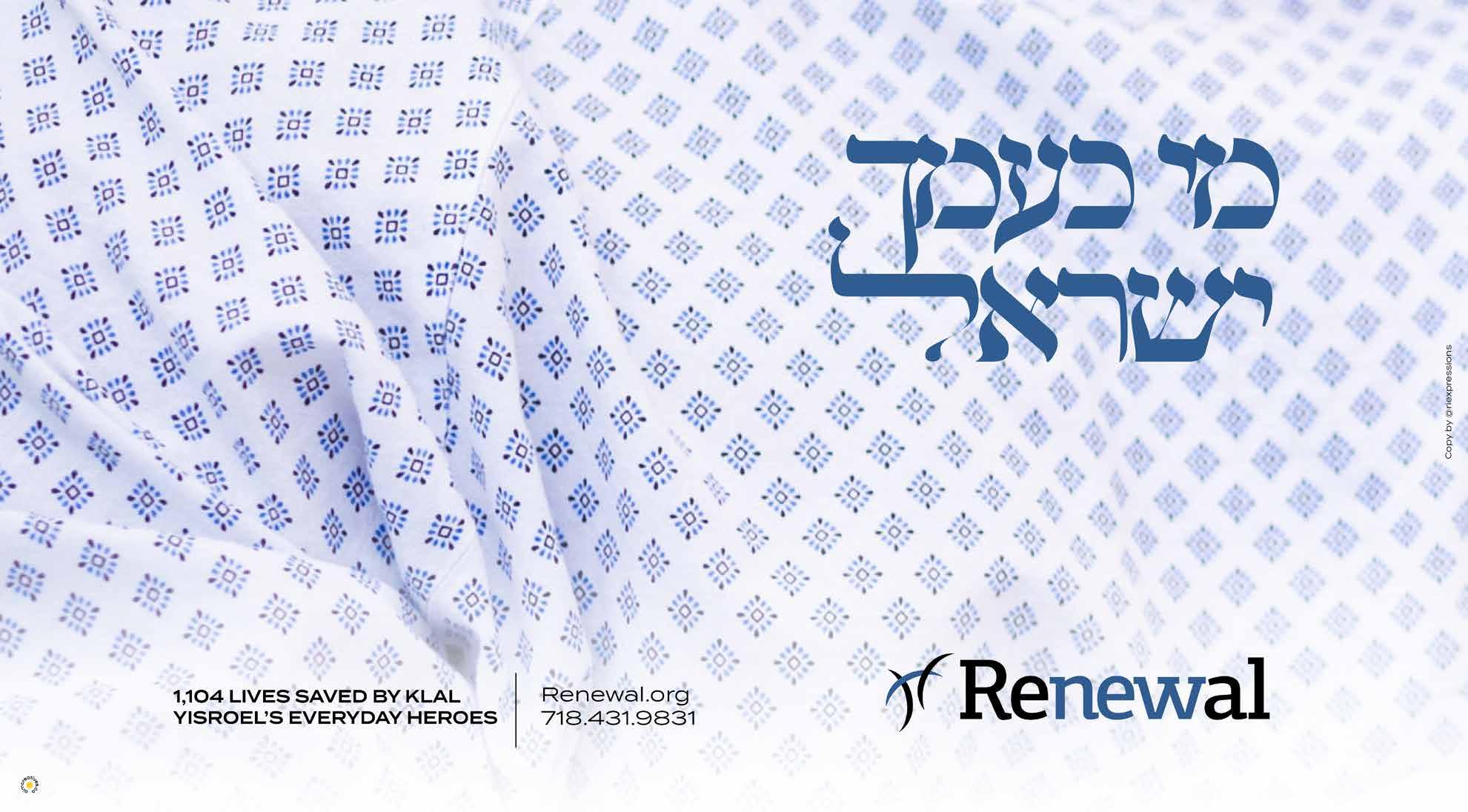

Yields 9 servings Pareve
Apple crisp is probably the first recipe I ever made. I have vague memories of going to my teacher’s house and baking apple crisp with her for a school Shabbaton. Honestly, the memory I have of standing side by side with my teacher in her kitchen is priceless!
Every time I wanted crumbs for a dessert, I would take out a second bowl and make them. Then I had the brilliant idea of making a huge batch of crumbs, keeping it in the freezer, and grabbing a cup or two whenever I needed them.
Apple Crisp
IngredIents
• 4 medium apples, peeled and sliced
• 2 tsp lemon juice
• 2 cups Pesach Crumbs (see below)
PreParat Ion
Preheat oven to 350°F.
Place apples into a bowl; toss with lemon juice. Set aside.
In a round 9-inch pan or 8x8-inch square pan, press 1/3 of the crumbs; top with apples, then with remaining crumbs.
Bake for 45 minutes.
Pesach Crumbs
Yields 3 cups / Pareve / Freezer Friendly IngredIents
• 1¼ cups ground almonds
• 1¼ cups potato starch
• 1 tsp cinnamon
• ½ cup oil
• ½ cup sugar
PreParat Ion
Place ingredients into a bowl.
Mix with your hands until a nice crumb texture forms.
Store in a container or Ziploc bag.
note & tIPs
This recipe can easily be doubled.

Sometimes, the crumbs can get a little moist from the freezer and lose their crumbly texture. If that happens, simply add an additional ½ cup potato starch and mix until the texture is correct.
Adding additional fruit, such as strawberries, blueberries, or pears, gives the crisp a delicious flavor.

My definition of biscotti was always the rock-hard sticks that you could crack your teeth on. There are very few foods that I won’t go near, but biscotti was just not worth it for me, until I discovered it doesn’t have to be that way. You can have delicious, chewy biscotti; ironically, my husband loves the super crunchy, almost-burnt version! So I always overbake some pieces for him.

IngredIents
• 2 cups potato starch
• 2 cups ground nuts (I use almonds)
• 1 cup sugar
• ¾ cup oil
• 2 eggs
• ½ tsp baking soda
• 1 tsp imitation vanilla extract
• 1 cup chocolate chips
PreParat Ion
Preheat oven to 350°F. Line a baking sheet with parchment paper.
In a large bowl, combine all ingredients until just incorporated (see Notes & Tips).
Shape batter into two skinny logs; place on prepared baking sheet.
Bake for 30 minutes.
Slice while warm.
note & tIPs
When the batter gets too difficult to mix with a spoon, I switch to using my hands.
I place the divided batter directly on the lined baking sheet and shape the logs there.
Sometimes I sprinkle on cinnamon mixed with sugar, as pictured, to add flavor and a little crunch to the biscotti.


 By Aliza Beer MS, RD, CDN
By Aliza Beer MS, RD, CDN
As many of you prepare for Pesach, you might be concerned about sticking to your weight goals. Pesach lasts eight days, revolves around food, and often means less physical activity. There are some healthy food options that we can’t eat during this time, and many Pesach dishes contain lots of carbs, added sugars, sodium, and unhealthy fats. Whether you’re celebrating at home or away at a Pesach program, this article will provide you with practical tips to help you stay on track and maintain your weight goals during the holiday.
Since the holiday is centered around matzah, it’s hard to avoid eating it at each meal. At the Sedorim, only eat the portion of matzah that is required. During chol hamoed, minimize the matzah and choose other healthier carb options, such as sweet potatoes, butternut squash, and quinoa. This will prevent you from consuming too many calories which leads to weight gain. You can also purchase whole-wheat or spelt matzah that is higher in nutrients and fiber to prevent constipation.
Drinking wine and/or grape juice is another staple at the Pesach Seder that can lead to weight gain. If you prefer grape juice, consider choosing a lighter version as it contains fewer sugars and calories compared to regular grape juice. If you prefer wine, go for options with a lower alcohol percentage to help manage your calorie intake.
Even though Pesach brings some lim-
itations of healthier foods we can eat, there is an abundance of nutritious options we can consume during the meals.
1. Proteins: Fish, poultry, and lean meat are great options to serve at your meals. If you are home, cook or purchase these protein options to have at your meal. If you are at a program or eating at a friend’s house, pick the healthiest protein option available. Protein can help you feel more full and prevent overeating.
2. Fiber : Finding fiber-rich foods during Pesach can be challenging, but far from impossible. Here are a few options you can choose from.
a) Vegetables: At each meal, fill up half your plate with vegetables like broccoli, cauliflower, and zucchini. If there’s a salad present, always try to consume a large bowl of salad at each meal. Veggies can also be great snacks you can eat during the day. Stock your fridge with baby carrots and sliced peppers.
b) Fruits: Fresh fruits such as apples, berries, and oranges are excellent sources of fiber. Whether you want a snack or it’s time for dessert, opting in for fruit is the way to go.
c) n uts and s eeds: Almonds, pumpkin seeds, pistachios, and walnuts are packed with lots of fiber. These can be sprinkled on salads, mixed in with yogurt, or eaten as a snack. Be mindful of portions since nuts and seeds can be higher in calories, and avoid honey glazed or sugar-coated nuts.
3. Healthy Fats: Since certain grains and legumes are restricted during Pesach, that leaves more room for fats. It is essential to make sure the fat options are healthy and non-processed. Healthy options include avocados, nuts, seeds, olive oil, fatty fish, and eggs.
Indulging in sugary desserts and beverages can contribute to weight gain due to their high calorie content. Here are some Pesach approved healthy alternatives to mitigate weight gain.
1. Beverages : Low-sugar grape juice, herbal teas, and infused waters flavored with mint, cucumber, or lemon.
2. Desserts : Sugar-free coconut macaroons, chocolate-dipped strawberries, yogurt parfait with berries, and baked apples or compote with cinnamon.
Since the Seder starts so late, it is a good idea to have a meal with some protein and veggies beforehand. For example, consider serving chicken drumettes or turkey sliders with a side of zucchini or cauliflower. This way, you won’t be starving when the Seder begins, and you’re less likely to overeat on matzah and other foods. During the Seder, try to keep your meal light, eating just a small amount of protein and soup, since you’ll be having lots of matzah and wine and the meal is typically eaten very late at night.
Even when you’re making healthier choices during Pesach, it’s important to pay attention to your portion sizes! Take salmon, for instance, where the recommended serving size is generally 3-4 ounces. Consuming 8 ounces of salmon alone adds up to 466 calories, without factoring in the sides and desserts you may enjoy during the meal. While salmon is nutritious (and one of my personal favorites!), eating too much of it can significantly raise your daily caloric intake and potentially lead to weight gain. This can be applied to all protein, healthy

fat, fruit, and healthier desserts you eat during Pesach. To maintain a balanced diet, it’s essential to portion your meals and snacks so you don’t go over your daily calorie limit.
It’s wise to consider limiting dessert intake during Pesach, as many cakes and cookies can be high in calories and lacking in nutritional value. Ingredients like potato starch, oils, and matzah meal are commonly used and don’t offer much in terms of health benefits. While occasional indulgence is fine, monitoring dessert consumption can help prevent overconsumption of calories. Select two or three meals where you’ll enjoy a treat, and opt for healthier dessert choices at other times. The timing of your mindful indulgences can be significant as well. The earlier in the day that you indulge, the better. The body is not burning off these excess calories when consumed later in the evening the same way it does earlier in the day.
When much of our time is spent at meals, shul, or resting, it’s beneficial to carve out some time in your day for a walk. Walking not only helps burn extra calories but also aids in digestion, weight management, and can enhance your mood. If the weather permits, aim for a brisk walk of at least 20 minutes outdoors. Consider inviting a friend along to make the walk even more enjoyable.
Drinking enough water is critical for your health during Pesach. Firstly, water can help you feel more full and reduce your hunger. This can prevent you from overeating and help you maintain your weight during Pesach. Secondly, since constipation is common during Pesach, water can help you maintain regular bowel movements and support your digestive health. Aim to have at least 8 cups of water a day to prevent dehydration. If drinking water is difficult, you can consume fluids from fruits, teas, and healthy flavored drinks.
If you are celebrating Pesach at a hotel, it may be harder to navigate clean eating at the program. You aren’t in control of what and how the food is being made, and you’re surrounded by food 24/7! To avoid weight gain at Pesach programs, here are some extra strategies you can implement in addition to those mentioned previously.
Even though some meals may offer less healthy choices, there are still
plenty of nutritious options available. At breakfast, you can enjoy omelets (except on Shabbat), yogurt, and fresh fruit. For lunch and dinner, there’s salmon, chicken, and roasted vegetables. Additionally, you can make a satisfying meal using the salad bar, which offers an array of vegetables, tuna, and eggs.
Just because the tea room is available, doesn’t mean you always have to visit. Tea rooms are filled with cakes, muffins, cookies, candies, and other unhealthy treats that can contribute to weight gain. Only visit the tea room a few times during the holiday, and consume mostly fruit, tea, and coffee if you attend.
Pesach programs often host additional events during the holiday, such as “midnight madness.” While these events offer plenty of food, you don’t have to attend every single one, especially since they occur late at night and you have already consumed food throughout the day. If you do decide to join in, a simple tip to prevent excessive snacking is to brush and floss your teeth beforehand.
If you keep food in your room, you’re very likely to eat it. The program provides its guests with plenty of food, making it unnecessary to have food in your hotel room. If you must, bring up light snacks like apples, grapes, carrots, and almonds.
Many hotels have gyms, tennis courts, swimming pools, basketball courts, and more on their property. Utilize these facilities during your stay since it can help you burn off extra calories and manage your weight. Before the holiday starts, pick which days you will engage in physical activity so you come in with a plan. Consider reaching out to a friend or family member to see if they’d like to join you, as having a workout buddy can boost your motivation and make exercising more enjoyable.
Maintaining weight goals during Pesach can be challenging since the holiday is centered around food and often involves less physical activity. It’s important to utilize these tips to help you avoid common pitfalls that lead to weight gain.
Strategies such as mindful matzah consumption, opting for nutritious options rich in protein, fiber, and healthy fats, practicing portion control, and finding alternative healthy desserts and drinks can help mitigate weight gain. Additionally, incorporating physical activity such as walking and utilizing exercise facilities during Pesach programs can aid in managing weight. By implementing these tips, you can navigate the holiday while staying on track with health and fitness goals. If you do, in fact, end up gaining a few pounds, remember that it’s temporary, and you can easily get back on track when the holiday is over. It’s important to enjoy the time with friends and family and not to stress too much during Pesach.
Wishing all of my readers a chag kasher v’sameach!
Aliza Beer is a registered dietitian with a master’s degree in nutrition. She has a private practice in Cedarhurst, NY. Patients’ success has been featured on the Dr. Oz show. Aliza can be reached at alizabeer@gmail.com, and you can follow her on Instagram at @alizabeer




Pesach comes out as the buds are beginning to blossom and the sun starts to peek through the clouds. We hope to have balmy temperatures as we celebrate Chag HaAviv, but remember that nothing warms you up more than enjoying quality time together. Take advantage and spend time with the family during chol hamoed – indoors or outdoors.
TJH has compiled a list of ideas, activities, and places to go for you to enjoy. Make sure to pack enough food (macaroons, matzah, and marshmallows!) and music for the road and have fun!
Queens County Farm Museum
73-50 Little Neck Parkway, Floral Park, NY 11004 718-347-3276
White Post Farms
250 Old County Road, Melville, NY 11747 631-351-9373
New York Aquarium
Surf Avenue & West 8th Street, Brooklyn, NY 11224 718-265-FISH
Long Island Aquarium and Exhibition Center
431 East Main Street, Riverhead, NY 11901 631-208-9200
Prospect Park Zoo
450 Flatbush Avenue, Brooklyn, NY 11225 718-399-7339
Queens Zoo
53-51 111th Street, Flushing, NY 11368 718-271-1500
Central Park Zoo
64th Street & 5th Avenue, New York, NY 10065
212-861-6030



Saturday April 27 9:30PM-1:00AM
Sunday April 28 10:00AM-5:00PM
Monday April 29 CLOSED
Tuesday April 30 CLOSED


Green Meadows Farm
73-50 Little Neck Parkway, Floral Park, NY 11002 718-470-0224
Green Meadows Farm Brooklyn
At the Aviator Sports Center
3159 Flatbush Avenue, Brooklyn, NY 11234 718-470-0278
Bronx Zoo
2300 Southern Blvd, Bronx, NY 10460 718-220-5103
Long Island Game Farm
489 Chapman Boulevard, Manorville, NY 11949 631-873-6644
Central Park

Boating, biking, the Great Lawn, model-boat sailing, carriage rides, carousel
Between 5th & 8th Avenues and 59th & 106th Streets, New York, NY 212-360-3444
Bryant Park 6th Avenue, between W 40-42 Street, New York, NY 10018 212-768-4242
New York Highline
Gansevoort St. to West 30 St. between Washington St. and 11 Ave., New York, NY 212-500-6035
Brooklyn Bridge Park
1 Main Street, Brooklyn, NY 718-222-9939
Little Island Floating Park
Pier 55 in Hudson River Park West 13 Street, New York, NY 10014
Roosevelt Island Tramway
300 E Main St, New York, NY 10044 212-756-7476
Fort Tyron Park

Riverside Drive to Broadway, W 192 Street to Dyckman Street, New York, NY
New York Circle Line Pier 83, West 42nd Street, New York, NY 10036 Pier 16, South Street Seaport, New York, NY 10038 212-563-3200
Statue of Liberty/Ellis Island Ferries from Battery Park, NY 1 Battery Place, New York, NY 10004 212-363-3200
Jamaica Bay Riding Academy 7000 Shore Pkwy, Brooklyn, NY 11234 718-531-8949

Old Westbury Gardens 71 Old Westbury Road, Old Westbury, NY 11568 516-333-0048
Sands Point Preserve 127 Middle Neck Road, Sands Point, New York 11050 516-571-7901
Great Neck Steppingstone Park 38 Stepping Stone Lane, Great Neck, NY 11021 516-487-9228
Sagamore Hill 20 Sagamore Hill Road, Oyster Bay, NY 11771 516-922-4788
South Street Seaport 89 South St., New York, NY 10038 212-732-7678
Brooklyn Botanic Gardens 900 Washington Avenue, Brooklyn, NY 11225 718-623-7200
Brooklyn Heights Promenade Downtown Brooklyn

Remsen Street to Orange Street along the East River


The New York Botanical Garden
2900 Southern Boulevard, Bronx, NY 10458 718-817-8700
Wave Hill Public Gardens
4900 Independence Avenue, Bronx, NY 10471 718-549-3200
Union Square Greenmarket
Union Square West, New York, NY 10003 212-788-7476
Historic Richmond Town
441 Clarke Avenue, Staten Island, NY 10306 718-351-1611

Bear Mountain State Park Route 9W North, Bear Mountain, NY 10911 845-786-2701
The Amish Village 199 Hartman Bridge Road, Ronks, PA 17572 717-687-8511
Mystic Seaport 75 Greenmanville Avenue, Mystic, CT 06355 888-973-2767
Amusement Parks
Six Flags Great Adventure
1 Six Flags Boulevard, Jackson, NJ 08527 201-862-0250
Hersheypark
100 W. Hersheypark Drive, Hershey, PA 17033 717-534-3900
Adventureland
2245 Broad Hollow Road (RT 110), Farmingdale, NY 11735 631-694-6868
Adventurer’s 1824 Shore Pkwy, Brooklyn, NY 11214 718-975-2748
Luna Park Coney Island
1000 Surf Avenue, Brooklyn, NY 11224 718-373-5862
Bayville Adventure Park
8 Bayville Ave, Bayville, NY 11709 516-624-7433


Sahara Sam’s Oasis and Water Park & Diggerland
535 N Route 73, West Berlin, NJ 08091 856-767-7580
Bronx Zoo Treetop Adventure Climb and Zipline Bronx River Parkway at Boston Road, Bronx, NY 10460 347-308-9028
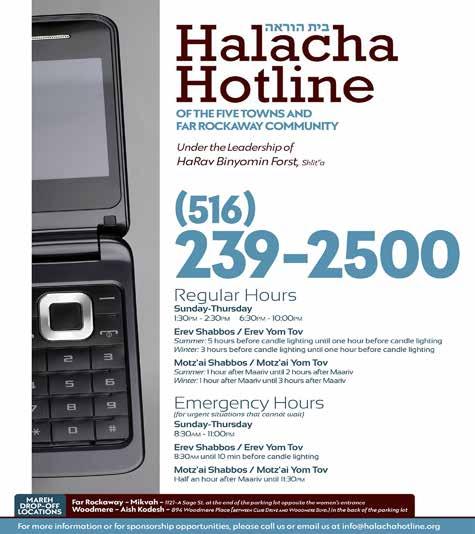


Legoland Discovery Center Westchester 39 Fitzgerald Street, Yonkers, NY 10701 844-740-9223
Fun Fuzion at New Roc City 19 Lecount Place, New Rochelle, NY 10801 914-637-7575
Fun Station USA
3555 Victory Blvd, Staten Island, NY 10314 718-370-0077
The Funplex
3320-24 NJ-38, Mount Laurel, NJ 08054 856-273-9666
Laser Bounce
80-28 Cooper Avenue, Glendale, NY 11385 347-599-1919
Laser Bounce
2710 Hempstead Turnpike, Levittown, NY 11756 516-342-1330
RPM Raceway Go-Karting
40 Daniel St, Farmingdale, NY 11735 631-752-7223
RPM Raceway Go-Karting
99 Caven Point Rd, Jersey City, NJ 07305 201-333-7223
One World Observatory
One World Trade Center, 117 West Street, New York, NY 10007 844-OWO-1776
Chelsea Piers
Hudson River—Piers 59-62—New York, NY 212-336-6800
Edge at Hudson Yards
30 Hudson Yards, New York, NY 10001 332-204-8500
Woodmere Lanes
948 Broadway, Woodmere, NY 11598 516-374-9870
Maple Lanes RVC
100 Maple Ave, Rockville Centre, NY 11570 516-678-3010
Funfest Bowling
6161 Strickland Avenue, Brooklyn, NY 11234 718-763-6800
Chuck E. Cheese
162 Fulton Avenue, Hempstead, NY 11550 516-483-3166


Chuck E. Cheese
750 Sunrise Highway, Valley Stream, NY 11581 516-234-5535
Kids N Shape
162-26 Cross Bay Boulevard, Howard Beach, NY 11414 866-567-1989
Beat the Bomb
255 Water St, Brooklyn, NY 11201 917-983-1115
Brooklyn Boulders
23-10 41 Avenue, Long Island City, NY 11101 718-482-7078
MetroRock Brooklyn
321 Starr Street, Brooklyn, NY 11237 929-500-7625
High Exposure Rock Climbing
266 Union St, Northvale, NJ 07647 201-768-8600
Thrillz High Flying Adventure Park
5 Prindle Ln, Danbury, CT 06811 203-942-2585

Urban Air
Long Island Adventure Park
75 Colonial Springs Rd, Gate #3, Wheatley Heights, NY 11798 631-983-3844
Trapeze School NY
467 Marcy Ave, Brooklyn, NY 11206 212-242-8769
Trapeze School NY
353 West St, New York, NY 10014 212-242-8769
4422 2nd Ave, Brooklyn, NY 11232 347-732-5438
Urban Air
683A Old Country Rd, Dix Hills, NY 11746 631-213-3894
Skyzone Trampoline Park
33 Lecount Place, New Rochelle, NY 10801 914-740-8272
Skyzone Trampoline Park
111 Rodeo Drive, Deer Park, NY 11717 631-392-2600
Rockin’ Jump Trampoline Park
241 Market Street, Yonkers, NY 10710 914-510-9119
Launch Trampoline Park
163-50 Cross Bay Blvd, Howard Beach, NY 11414 718-593-4204
849 Ridge Hill Blvd, Yonkers, NY 10710 914-449-4359
Glow Golf
Roosevelt Field Mall, Garden City, NY 11530 516-747-3682
Smith Point Archery
215 E Main Street, Patchogue, NY 11772 631-289-3399
Rise NY
160 West 45th St, New York, NY 10036 718-701-4998
City Climb
30 Hudson Yards, New York, NY 10001 332-204-8500
Dave & Busters
395 Gateway Dr, Brooklyn, NY 11239 718-368-6100
Dave & Busters
1 Sunrise Mall, Massapequa, NY 11758 516-809-8514
Dave & Busters
1504 Old Country Road, Westbury, NY 11590 516-542-85011504
Palisades Center
1000 Palisades Center Dr., West Nyack, NY 10994 845-348-1000
American Dream Mall
1 American Dream Wy, East Rutherford, NJ 07073
Iceland Long Island
3345 Hillside Avenue, New Hyde Park, NY 11040 516-746-1100
City Ice Pavilion
47-32 32 Place, Long Island City, NY 11101 718-706-6667

Long Beach Ice Arena
150 W Bay Dr, Long Beach, NY 11561 516-705-7385
Lefrak Center Ice Skating 171 East Drive, Brooklyn, NY 11225 718-462-0010
United Skates of America
1276 Hicksville Rd, Seaford, NY 11783 516-795-5474

Puppetworks
338 Sixth Avenue, Park Slope, NY 11215 718-965-3391
Make It Too
86 Cedarhurst Ave, Cedarhurst, NY 11516 516-341-7660
Build a Bear
Roosevelt Field Mall
630 Old Country Road, Garden City, NY 11530 516-248-0027
Build a Bear
9015 Queens Blvd, Elmhurst, NY 11373 718-289-7135
Sloomoo Institute: Slime Museum
475 Broadway, New York, NY 10013 Sloomooinstitute.com
Color Factory NYC
251 Spring Street, New York, NY 10013
Artrageous Studio
5 N Village Ave, Rockville Centre, NY 11570 516-255-5255
Once Upon a Dish
659 Franklin Ave, Garden City, NY 11530 516-742-6030
Brooklyn Clay Industries
62 5th St, Suite 306, Brooklyn, NY 11205 301-395-0143
Color Me Mine
123 Baxter St, New York, NY 10013 212-374-1710

Color Me Mine
177 Amsterdam Ave, New York, NY 10023 212-877-0007
La Mano Pottery
110 West 26 Street, New York, NY 10001 212-627-9450
Casa de Spin
81 Grand Avenue, Massapequa, NY 11758 516-654-7746
Taro’s Origami Studio
95 7th Avenue, 2nd Floor, Brooklyn, NY 11215 718-360-5435


P66 Bury the Hatchet
25 Noble Street, Brooklyn, NY 11222 917-243-9696
2BA Pilot Flight Lessons
9100 Republic Airport, Farmingdale, NY 11735 516-662-8887
Intrepid Sea, Air and Space Museum
Pier 86, 12th Avenue and 46th Street 212-245-0072
9/11 Memorial and Museum
200 Liberty Street, New York, NY 10006 212-266-5211
Jewish Museum
1109 Fifth Avenue, New York, NY 10128 212-423-3200
Museum of Jewish Heritage
36 Battery Pl, New York, NY 10280 646-437-4202
Living Torah Museum
1603 41 Street, Brooklyn, NY 11218 718-851-3215
Long Island Children’s Museum
11 Davis Avenue, Garden City, NY 11530 516-224-5800
Museum of Ice Cream
558 Broadway, New York, NY 10012 866-665-1018
Skyscape
928 8th Avenue, New York, NY 10019 212-549-1941
Museum of Illusions
77 Eighth Avenue, New York, NY 10014 212-645-3230
National Museum of Mathematics
11 East 26 Street, New York, NY 10010 212-542-0566
Brooklyn Children’s Museum
145 Brooklyn Avenue, Brooklyn, NY 11213 718-735-4400
Jewish Children’s Museum
792 Eastern Parkway, Brooklyn, NY 11213 718-467-0600
Children’s Museum of Manhattan
212 W 83rd St, New York, NY 10024 212-721-1234

NYC Fire Museum
278 Spring Street, New York, NY 10013 212-691-1303
American Museum of Natural History
Central Park West at 79th Street, New York, NY 10024 212-769-5100
Metropolitan Museum of Art
1000 5th Avenue, New York, NY 10028 800-662-3397
Frick Collection
1 E 70 St., New York, NY 10021 212-288-0700
Lower East Side Tenement Museum
103 Orchard Street, New York, NY 10002 877-975-3786
The Skyscraper Museum
39 Battery Pl, New York, NY 10280 212-945-6324
CitiField Non-Game Day Tours
41 Seaver Wy, Queens, NY 11368 718-803-4097
Yankee Stadium Tours
1 E 161 Street, Bronx, NY 10451 646-977-8687
Vanderbilt Museum & Planetarium
180 Little Neck Road, Centerport, NY 11721 631-854-5579
Liberty Science Center
Liberty State Park, 222 Jersey City Boulevard, Jersey City, NJ 07305 201-200-1000
Crayola Experience
30 Centre Square, Easton, PA 18042 1-866-875-5263
The Franklin Institute
222 North 20th Street, Philadelphia, PA 19103 215-448-1200
Please Touch Museum
4231 Avenue of the Republic (formerly North Concourse Drive), Philadelphia, PA 19131 215-581-3181
Imagine That! Children’s Museum
4 Vreeland Road, Florham Park, N.J. 07932 973-966-8000

TJH assumes no responsibility for the kashrus, atmosphere, safety, or accuracy of any event or attraction listed here. Please call before you go. Have a great time!

Ahoming pigeon flies 2,000 miles before returning to its homebase. A salmon may wait three years before returning to its home stream to lay its eggs. Students of Rabbi Zalman Deutscher’s Yeshiva Primary are reminiscent of the butterfly that travels tens of thousands of miles only to have its offspring return home three or four generations later. That is what happens every day in Queens.
Years ago, the forces of communism imposed anti-religious values upon thousands of Jews, halting their religious observance. Years later, those Jews watched from the Heavens as their offspring fell to Western, secular ideals upon reaching American shores. But those grandparents and great-grandparents shed tears from Above, beseeching the Holy One to bring their children back to Yiddishkeit.
One such person who helped – and is helping – to bring those holy neshamos back to their Source is Rabbi Zalman Deutscher.
Carpenters need plywood and nails to perform their craft; architects need blueprints. Teachers cannot go into chinuch just because they want to teach. Instead, they must desire to treat the students like they could be their own children or grandchildren who may need the help of a mentor to reconnect them with their Creator. In that vein, Rabbi Deutscher often takes his students to interviews at mainstream schools as a parent would do for their child.
Parents of students in Yeshiva Primary claim they still intend for their children to enter public school after completing the yeshiva elementary school curriculum. Rabbi Deutscher and his staff understand the predicament these parents have and strive to have the parents choose a Torah path for their kids as they discover the true American dream. Rabbi Deutscher believes that the basic emunah was not extinguished by communism, no matter how many generations down the line they are removed from Yiddishkeit. To the naysayers, Rabbi Deutscher reminds them that not too long ago, New Yorkers immigrated to the region when America was just a couple of colonies on an eastern seaboard long before the Louisiana Purchase. We have no guarantee what tomorrow may bring.
Rabbi Deutscher, a member of the Bostoner shul in
Boro Park since he had lived there for a number of years, is now living in Spring Valley, Monsey. For more than twenty years, he has commuted to Queens nearly daily with the realistic understanding that a vision very often is a mere dream.
On a Shabbos stroll through Kew Gardens Hills, Queens, one cannot miss Yeshiva Primary’s lawn signs boasting open enrollment for public school students transferring to yeshiva at an annual tuition rate of $3,100, a fraction of mainstream yeshiva fees. I spent the better part of this past erev Shabbos with Founder and Dean Rabbi Zalman Deutscher to hear from this hidden bastion of chinuch in Hollis Hills.
Rabbi Deutscher’s desire to provide a Jewish education to public school youth was cultivated from childhood.
In 1937, Rabbi Deutscher’s father arrived in the United States from Vienna. On the day of his arrival, a yeshiva meshulach made his shidduch. The new couple spent a few years in Providence, RI – where Rabbi Deutscher’s mother was from – and then spent two years in Pittsburgh before finally moving to Williamsburg, Brooklyn. First educated at Yeshiva Torah Vodaath and Yeshiva Arugath Habosem/The Tzeilmer Yeshivah through high school, Rabbi Deutscher then embarked on a two-year sabbatical learning in Eretz Yisrael in the presence of the Belzer Rebbe and finally completed his studies at the coveted Spring Valley Institute of Higher Learning and Research.
But it was summer visits to his grandmother in Providence where he encountered Jews living a different life that sparked Rabbi Deutscher’s current path of chinuch and kiruv. The master mechanech spoke of his encounter with an elderly European Yid whose son was well-removed from his father’s level of yiras Shamayim. The Yiddish speaker’s grandson was so far from Yiddishkeit that, like many his age, he had intermarried. Rabbi Deutscher was also moved by his grandfather’s difficulties in shemiras Shabbos as businesses operated on a six-day work week when, come Monday morning, new employment had to be sought until Rabbi Deutscher’s grandfather went into business for himself. Rabbi Deutscher spoke of his uncle’s
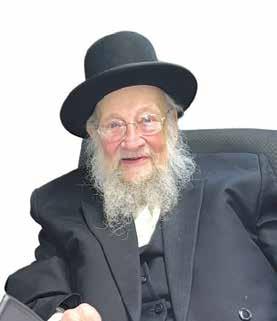
family who left Providence, RI, for Crown Heights, Brooklyn, each Shabbos to offer his children an essential taste of Jewish education.
Seeking to make an impact, Rabbi Deutscher accepted the General Studies Principal position of a kindergarten through 12th grade Brooklyn yeshiva of some 400 children. But in 1969, desiring to resurrect dormant neshamos, Rabbi Deutscher settled in Howard Beach to service a religious population that had not been connected to any specific yeshiva. There, Rabbi Deutscher opened up his school with a nursery, kindergarten, and first grade in the Ozone Park Jewish Center facility. Designed to register Jewish youth who had been in public schools, the new option was not a conflict for Yeshiva of Central Queens or Dov Revel applicants. Thinking, “If we can have thirty children combined in the three grades, I would be very, very happy,” Rabbi Deutscher was pleasantly surprised to wind up with over 60 students that historic inaugural year with a parent body that grew up in southeast Queens’ Rochdale Village and East New York’s Brownsville section of Brooklyn and moved to the quaint suburbia of Howard Beach.
A decade later, a move to a vacated Lefferts Blvd. nursing home near Rockaway Turnpike came about through a friend of the rabbi within the Far Rockaway community of legendary ba’al teshuva movement founder Rabbi Shlomo Freifeld, zt”l. Due to a government crackdown on such facilities, its ownership offered the site at no cost to house an educational institution. The miracle find became a reality after confirmed by a visit from the rabbi’s dear associate, Rabbi Elimelech Gavriel “Mike” Tress, National President of Agudath Israel of America, who alleviated concerns of an unscrupulous deal. Soon, the 44-bed venue was transformed into a school with new plumbing and electric, but renovations stopped short when it came to aesthetics due to a lack of funds.
Yeshiva Primary stayed there until 1985, when a new home was found on Northern Blvd., a short distance from its present home at the Hollis Hills Bayside Jewish Center that was acquired 20 years ago when the former site was purchased by a Korean house of worship.
“August 14, the day of the Northeast blackout of 2003, was when we moved locations,” recalled Rabbi Deutscher.
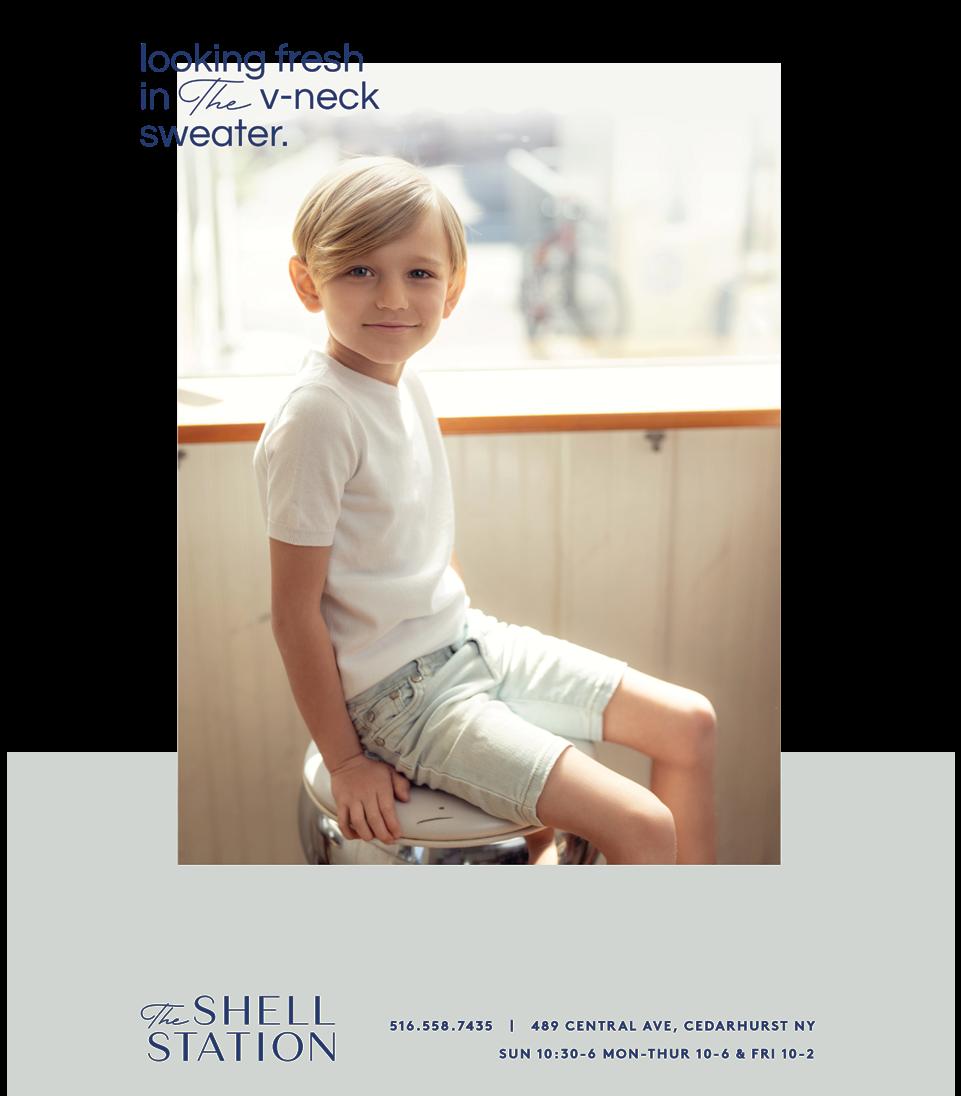
“I was here, and suddenly, the lights went out. I thought the building had a problem, only to soon realize the extent of the situation.”
Addressing Yeshiva Primary’s success, Rabbi Deutscher disclosed, “It’s unbelievable that we have had a tremendous amount of siyata dishmaya, and most of our children eventually wind up in different yeshiva high schools – whether the boys or the girls, depending on what school is best for them.”
Statistically, over ninety percent of Yeshiva Primary students continue in yeshiva high schools, with some years seeing ninety-eight or even one hundred percent of such enrollment, unheard of for children who were bullied over their heritage by public school peers a few short years before.
Not reluctant to discuss the less fruitful cases of his time in chinuch, the longtime dean explained that these children’s deep-seated formative roots are being reignited a half a decade or decade later, much like African lungfish that hibernate without any sustenance out of water for three to five years, only to reawaken when freshwater surroundings become available.
“We do what we can; our chinuch curriculum is geared to our student body, not based on a predefined number of p’sukim that must be mastered,” said the visionary who has been known to put insurmountable effort into students preparing for yeshiva high schools, often arranging tutoring to ensure they can catch up with their mainstreamed classmates. Take, for example, a Yeshiva Primary student who joins a new school in seventh grade. Rabbi Deutscher, yearning to see the pupil advance, will work with a third party to fund a summer tutor to ensure that limudei kodesh skills – be it kriah or Gemara – are on par with other students. Should the student require further assistance while already at the new school, Rabbi Deutscher, understanding that the child most probably is not getting fully supported at home, remains a presence in the child’s life and hires a tutor to supplement the skills taught during lunchtime or when appropriate. This fatherly love is not lost on the students who cling to Rabbi Deutscher and regularly return to show gratitude.
The demographics of the student body at Yeshiva Primary has changed over the years. Initially, many students of Iranian origin entered American shores and landed in Yeshiva Primary. Immigration from southern Russian republics followed, later changing to arrivals from Russia’s European sections. To get these students on target with classes, the yeshiva offered specialized programming that continued an hour past the general 3 p.m. dismissal. Back then, a paltry fifty-dollar monthly tuition bill was often impossible to allot for parents not accustomed to a tuition fee. A life lesson changed Rabbi Deutscher’s perspective when he drove a student who missed the bus to their four-story Kew Gardens walkup on Metropolitan Ave. at Park Lane South.
He described the student’s home. “I was appalled when I saw a couple of milkcrates with a board atop, a few more crates for seating, and a bunch of mattresses pushed into a corner. How could I be upset with this mother’s fifteen-dollar monthly payments?” he shared.
Accepting immigrant students came at the expense of
losing all but two of the yeshiva’s American registrants. The Divine hand was ever-present a short time later when Americans relocated from the vicinity, converting the school into a haven for new immigrants who within a handful of years were near-fully Americanized. Today, Yeshiva Primary is focused on the second and third generation of these immigrant populations, shocking to educationalists who had never fathomed their depth of impact on students.
As the classic Haggadah tune of “Dayeinu” reverberated from the youngsters in the adjacent classroom during our discussion, Rabbi Deutscher reaffirmed his commitment to doing his utmost in the present, never second-guessing the long term value in chinuch despite the challenges presented by parents needing to overcome trust issues with the yeshiva and vice versa.
“ i wa S appa LL ed when i S aw
a C oup L e o F mi L k C ra T e S
wi T h a B oard a T op, a F ew
more C ra T e S F or S ea T ing,
and a B un C h o F ma TT re SS e S
pu S hed in T o a C orner. h ow
C ou L d i B e up S e T wi T h T hi S
mo T her’ S F i FT een-do LL ar
mon T h Ly paymen TS ?”
The 1979 Iranian Revolution overthrew the army of Iran’s final monarch, Mohammad Reza Shah, and established the Islamic Republic of Iran, allowing for a flood of Iranians that trickled into the yeshiva. The mother of one such budding talmid played to Rabbi Deutscher’s ear, offering praise on a number of calls inquiring about her son’s consistent absence only for Rabbi Deutscher to find out weeks later that the boy had been in public school all along. Seeking input from Rabbi Mordechai Kashani, the Iranian-born menahel of Yeshivat Ohr Haiim, Rabbi Deutscher learned that such tactics were commonplace in the Iranian culture.
“We acclimated,” explained Rabbi Deutscher, describing his experience with various immigrant communities and then the mutual understanding that was established with the Bukharian immigrant community, a community which stemmed from the southern Russia republics often with short breaks in Eretz Yisrael before embarking on life in the U.S.
As I walked the hallways at Yeshiva Primary, I only heard English chatter. Gone were days when Russian and Farsi dialects prevailed. Quoting his father on the difference between Polish and Hungarian Jews, Rabbi Deutscher
noted that originally France had held the bulk of European Jewry and as the Jews traveled, they settled in Poland, bordered by Germany, and he joked that those with more reliable horses went an additional 150 kilometers into Hungary. Jews come from many parts of the world, with waves of Jewry ebbing and flowing.
Asked how the yeshiva attracts enrollment, Rabbi Deutscher noted that two or three generations of communism took a heavy toll on the Bukharian community that remains widely uneducated in religion beyond possessing positive vibes and the most basic beliefs in Yiddishkeit. During interviews with students, using the timeless tack of playing Jewish genealogy, the rabbi bonds as he quizzes parents on their ancestry, even requesting photos of elder grandparents. Determined not to embarrass parents, the rabbi turns to the child in the context of the conversation, questioning his favorite lunch item. To a response of chicken nuggets, a mother often declares he cannot have milk with that, not realizing that the poultry itself is not permissible to G-d-fearing Jews. Often, as the children bring home religious practices, dormant emunah reawakens in the parents who tend to follow suit.
One of two sisters sent from Yeshiva Primary to excel at Torah Academy for Girls in Far Rockaway had revealed to Rabbi Deutscher a superstition of her mother’s to not wash clothes on Friday. Using a Shulchan Aruch, the rabbi showed her that during the time of Ezra HaSofer, there was such a discussion about this, as not too long ago, laundry was a day’s affair at a river’s edge using stones.
Understanding the fundamental benefits of having 200 children recite krias Shema daily, Rabbi Deutscher observed that it implants a compass in the youth who will one day return to Hashem’s fold in comparison to drivers that deviate from a GPS’s instructions but are continually rerouted onto the correct path.
The yeshiva luckily has few second-generation students, a phenomenon for yeshivas that often boast such applicants. “I don’t accept them because they don’t belong here,” he says. “They belong in a mainstream school,” noting that he seeks such an option as early as possible. “My biggest problem today is that the mainstream schools are full,” a difficulty overcome only by finding a proper classroom for each child.
Rabbi Deutscher works tirelessly to get his graduates into the proper schools once they are able to move on from Yeshiva Primary. Recalling a fellow master in chinuch, Rabbi Deutscher speaks of Rabbi Moshe Neuman, zt”l, who persevered notwithstanding door knocking amongst the modern Jews of Queens as he sought students willing to bank on the non-co-ed environment found at Bais Yaakov Academy of Queens. Rabbi Deutscher recalls the warmth shown when he brought five or six girls to BYQ annually, stating that Rabbi Neuman never gave off an impression of feeling obligated to take on students from Yeshiva Primary who, with time, eventually acclimated well in the mainstreamed all-girls setting. Thirty years ago, Yeshiva Tiferes Moshe and Shevach High School were able to take up to five students each from Rabbi Deutscher annually, a reality not practical anymore as classrooms are at capacity. To this day, Yeshivas Chofetz Chaim willingly brings aboard a Yeshiva Primary talmid in an annual pre-selected slot.
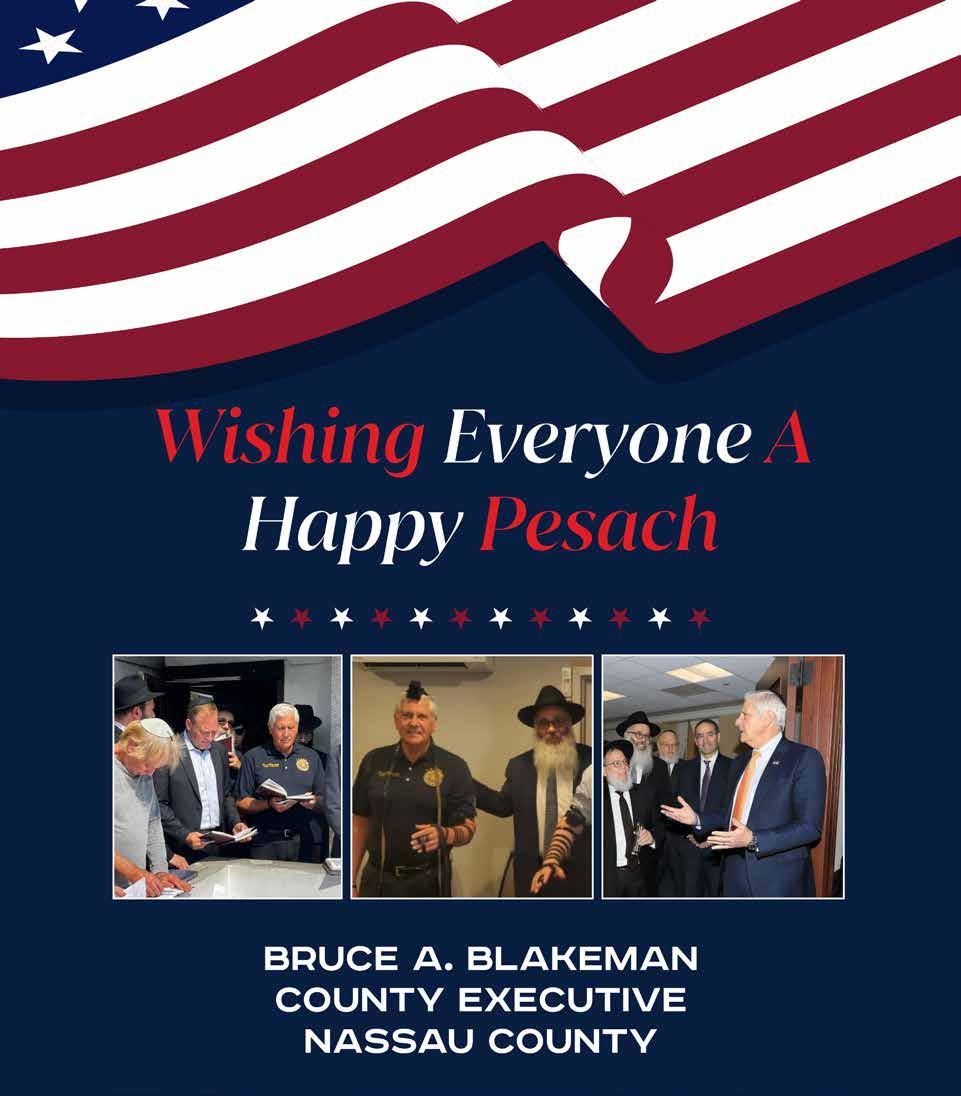
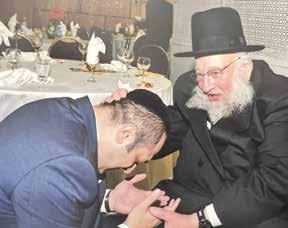
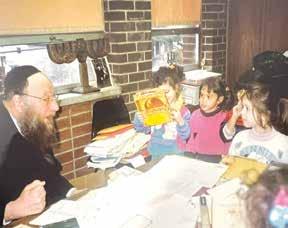
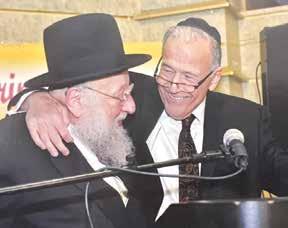
Still, each student requires different needs that only the right yeshiva can address.
Rabbi Deutscher fondly remembers his students. Years ago, when the Northern Blvd. campus was active, Rabbi Deutscher stopped a young Rabbi Avner Yusupov (now curriculum coordinator at the yeshiva) on his way into a bar mitzvah celebration. By the following year, all the Yusupov siblings were registered at Yeshiva Primary. The rabbi also spoke of a popular dental surgeon today who, years back, was placed into Yeshiva of South Shore after a stint in Yeshiva Primary. Another student who did beautifully at Yeshivas Chofetz Chaim once returned concerned that he had chosen to lead a life in direct contrast to his parents. Rabbi Deutscher told this young man that he had reconnected with his ancestors long severed by
communism. Rabbi Deutscher shared a parable with the young boy, pointing to the immediate extinction of the Pony Express in 1861 on the very day the telegraph was deemed a success. But telegraph progress was disrupted for a period of days when a lone fishing boat snapped the telegram cables laid beneath. A reconnection of those cables was needed to resume the communication device.
Notable alumni of Yeshiva Primary also include a co-founder of TorahAnytime, the founder of a Sephardic citadel of Torah in Kew Gardens, and the originator of a Queens-based outreach center for teenagers, amongst countless others who now reside nationwide, markedly in Colorado and Florida.
While the yeshiva once peaked at 300, due to overwhelming demand, Rabbi Deutscher never wanted to

accept more than 125 students because there is a need to connect with each child and that cannot be successfully accomplished in a room of 30 children. An educator planning a path to become superintendent will be sorely disappointed. At Yeshiva Primary, teachers are encouraged to do their best to the furthest extent attainable while adjusting to communal needs and while realizing the yeshiva is just a stop along the way to a mainstream school with no need to keep even one student a day longer than necessary. In turn, the rabbi encouraged parents of eligible children to marry them off and not stop or hold back the clock of life.
Rav Yaakov Kaminetsky, zt”l, gave a friend of Rabbi Deutscher seeking to open a high school the bracha to never get tired. Years later, Rabbi Deutscher understood


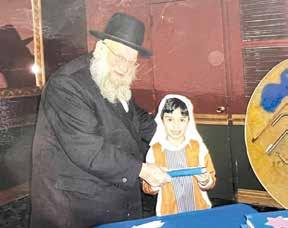
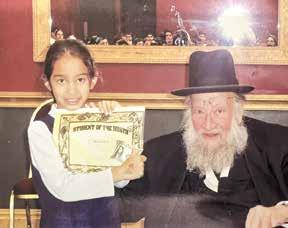
this to mean that one must keep on doing more while always thinking in terms of the future, adjusting to demographics that generally change. These changes are positively showcased on a walk along the bustling Main Street business corridor where former students – now grandparents – are strolling with their grandchildren in the ways of a frum Yid.
Admitting that times were once tough, Rabbi Deutscher said that he and a friend once visited the Alter Skulener Rebbe in Miami, hoping to be allowed to close operations. The Rebbe, quoting his father, said that Rabbi Deutscher needed to assume more responsibilities, and, in turn, Hashem will help. While not the advice he had expected, Rabbi Deutscher persevered, and the yeshiva succeeded.
Yeshiva Primary’s Hebrew curriculum has not changed over time. Parents are similarly known to appreciate the quality of the secular education, getting more for less at the incredible rate of $3,100, that is supplemented by generous contributions. Rabbi Deutscher understands that a parent who has no reason to be unhappy with the free public school system is comfortable with their children staying there. And so, the need remains to keep tuition as low as is feasible, and still, a parent may be forced to choose between a Torah education or a new car. To sweeten the deal for hesitant parents, Rabbi Deutscher becomes a lifelong friend, a parent figure, who ensures the education continues for his students, using tutors as needed when the transition is challenging.
Over the decades, Rabbi Deutscher and Yeshiva Pri-

mary helped to remove the lead shield that once blocked the neshamos of thousands of children, helping their Jewish souls to reignite. Roughly 100 students fill the yeshiva classrooms each year, finding the warmth of kiruv to be new and exciting. They absorb the light of Hashem and watch as it slowly seeps past the challenges and conflicts of their household and becomes embedded in their souls. The emunah of these parents slowly flickers, first by buying kosher, then by keeping some halachos, and finally by keeping Shabbos, helping their families to reconnect to their lost heritage. Homes in Jamaica Estates, Fresh Meadows, Hillcrest, Briarwood, Kew Gardens, Kew Gardens Hills, Rego Park, Forest Hills, and right at the helm in Hollis Hills are clinging to Hashem’s heels more and more each day.


With the glorious yom tov of Pesach approaching, parents are enveloped in preparation. There is planning, purchasing and much work to be done. It is entirely normal to become exhausted by the time the Seder begins. With fatigue can come irritability and impatience, and the glory and splendor of the festival can be obscured by the tension at the table.
Maintaining a holiday atmosphere along with salvaging a holy experience in this commemoration of our emergence from bondage into a hallowed nation takes effort and focused planning. Our children need the Sedarim to be memorable in positive ways. Parents need these years of raising their families in our wholesome traditions to be seasons of closeness and bonding. Consider some of these recommendations:
Parents, sit down together at least a week before yom tov and forgive one another. Make peace.
Renew your commitment to being a team, being caring partners, for each other’s sake and for the sake of your family. Resolve proactively that yom tov is going to be a loving and happy experience for all and that you will check in with each other, support one another, and will make efforts to communicate and to stay close. Gently and non-judgmentally review past Sedarim to identify what went right and what went wrong so that you can make this year flow. Cultivate optimism.
Anticipate the needs and the moods of each child and each guest at the Seder, along with discussing in advance that person’s maturity level, their ability to participate in the Seder, and any special handling they will need in order to be comfortable and feel included.
Think about the big picture: consider the purpose and function of the Pesach Seder and Haggadah and how you plan to get through the many steps of running
By Rabbi Dr. Dovid Fox
the evening. Consider that the goals are in fact to create a family celebration within the context of fulfilling the mitzvos. For some adults, their vision is that the evening is going to be one of erudite Torah discourses, and for some, the expectation is that it will be a night of trying to keep young children awake and engaged. You will be disappointed if you do not think
place or time to first begin peering into the various sections of the “service” in order to figure out what to talk about. Go through the Haggadah beforehand (many have the custom of reading a large section of it on the preceding Shabbos). Start thinking about the themes of slavery-to-freedom, exile and exodus, and of how our nation evolved. Start thinking
It is about education and intellect but about feeling and soul, too.
ahead about who is attending the Seder, what each one is capable of, and how you want the evening to evolve. Plan carefully and plan together. Remember that those who might be classified as any of the “Four Sons” may be present, and the Seder is for them, too. Some are bright, some are simpler and some may pose challenges.
It is not only food that must be served. Prepare the Haggadah and the Seder sequence in advance. The table is not the
about what parts of the Haggadah tend to spark conversation and which parts get overlooked. Remember that it is not only the history that we should dwell on, but it is the Hallel and the praise, and that Hashem is there with us at the Seder, too. The Seder is a service, a sacred avodah, and there is much tefillah taking place that night. It is about education and intellect but about feeling and soul, too.
Consider what your young children may have done at school to prepare for
the Seder. If you do not appreciate each one coming to the table with binders full of notes and essays which their teacher prepared for them to read aloud, then make time to meet with each child well in advance to share with you their songs and explanations, and help them select the ones which they want to say over, rather than read page after page with emotional detachment as if they are reciting an assignment at the Seder. Promote every child’s feeling of pride for sharing what they know, songs they like, questions that they have. Show them patience and enthusiasm. They belong with you there, even if they slow you down or cannot yet appreciate your deeper understanding of the intricacies of profound commentaries. Pick out a Haggadah for each family member that he or she can relate to.
Just as a parent will want to be familiar with the flow of the Seder in advance, a child can gain greatly when parents acquaint them with the layout of the evening. Either way, be sure to include your children, encourage them to participate, and remember that they are children with levels of attention and comprehension which are age appropriate for them. After all, the mitzvah of the evening focuses on teaching our children about the Pesach saga. Teach them and model for them, which should be more than having them recite someone else’s writings and more than you lecturing to them. When they inquire, you inspire.
Make this yom tov positive by infusing it with inclusion and meaning. Bring achdus into your home and family. Shepherd your children along the Pesach path.
Rabbi Dr. Dovid Fox is a forensic and clinical psychologist, and director of Chai Lifeline Crisis Services. To contact Chai Lifeline’s 24-hour crisis helpline, call 855-3-CRISIS or email crisis@chailifeline.org. Learn more at www. chailifeline.org/crisis.

E We give out makkos prizes
E Our seder table is set up like Kriyas Yam Suf. I put out a blue tablecloth runner in the middle of the table with little people walking through and the Mitzrayim “drowning.” It always looks amazing!
E We put frog jumping toys on the table and have Makkos finger puppets.
E Other than finding the afikomen, we all just aim to get to bed before midnight.
E At “Ha lachma anya,” I put matzah on my shoulder and walk around the table as if walking in intense heat.
E We all walk around the table with a bag of matzos on our backs as if we’re leaving Mitzrayim. All the kids love it!
E We make the sounds of each stanza in “Chad gadya.” Animal sounds for the animals, obviously. We have to get creative when it comes fire and water, etc. When it comes to the last stanza (Hakadosh Baruch Hu comes), we all cheer.
E By the 10 Makkos, we have all around the table things connected to it, and the kids try to find it.
E We take turns reading different sections.
We asked readers to give us their ideas.
Here are some ideas that readers submitted to TJH :

E To get our kids involved at the Seder and every meal on Pesach, we let each person in the family choose a makkah. They get to set the table with paper goods that they choose relating to their makkah, plus small prizes. Each person ends up planning and setting up one meal. For example, for Makkas Choshech, we used black tableware, costume jewelry and fake coins since they went into the Mitzrim’s houses, toy eyes, and sunglasses.


E We use leeks, chives or scallions, symbolizing a whip, and hit each other when we recite the parts about being slave and working hard.
When each kid asks a question, we give a chocolate or candy to them and to the person who can answer the question.
E My husband dresses up as Pharoah or as Moshe Rabbeinu (depending on the year).
E I have four kids, so each kid acts out the Four Sons. We rotate each year, so no one really feels like he or she is the rasha!

E Each kid always wants to say something at each part of the Seder, so we take turns so each kid gets a chance at each part and it doesn’t get too long. One year, I wrote down everyone’s names on slips of paper, and we chose the papers out of a hat to decide who gets to say their dvar Torah. It ended up being too much work keeping track.
E Anyone (big or small) who asks a question or reads a portion gets a candy from a dish set prominently on the table.
E We give out candies and prizes throughout the night.
E Our family loves to sing, so we sing a lot of the Haggadah. It’s so beautiful.
E Instead of hiding the afikomen, we make a sack and tie it on the shoulder of the children after “Ha lachma anya.”
E We make a huge deal out of hiding the afikomen for the little ones. That keeps them busy.

E Lots of chocolate and lots of candies. Anyone who says something or asks a question, gets to choose. The kids love it, and it keeps them entertained and engaged.
E By the Makkos, each person has a makkah they have to act out. They know beforehand, so they bring props to the Seder. It becomes very interactive!



 By Hershel Lieber
By Hershel Lieber



Ithought about writing about our trips to Florida many times, not so much about our experiences but rather about the myriad of attractions and sights that one can see and enjoy in the Sunshine State. What bothered me was that the article would appear like a travelogue and have the feel of a tourist brochure. Nevertheless, I decided to override my concerns and present my readers with a depiction of the pleasures of visiting the state of Florida – Miami and beyond.
Like most people in our circles, a trip to Florida during the ‘70s and ‘80s meant staying in Miami Beach either in some of the well-known hotels that catered to Orthodox Jews or renting a room or two in a rooming house. I remember those hotels well. There was the Caribbean, which hosted many Polish and Galicianer Yidden, and the Crown, which had a mostly
Hungarian clientele. Some of the other hotels that were frequented by heimishe Yidden were the Waldman’s, the Saxony, and the Seagull. The cuisine was basically Jewish European food. Blintzes, pirogen, borscht and potatoes, noodles and cheese, kasha varnishkes, pickled herring and the ever present glass of warm prune juice. Dinner always included carp or gefilte fish, an option of chicken soup with kneidlach, flanken with horseradish, mashed potatoes with fried onions, chopped liver, and occasionally crunchy, greasy griebin.
During those years, we went to Florida only a couple of times. My first trip was in January of 1975 when I went alone with my mother. In 1987, Pesi and I went with our children, when my in-laws were there for a few weeks. In 1990, we joined a familiarization trip for travel agents thanks

to my client, Bella Travel. Other times, in the ‘90s and the 2000s we came for short stays, especially when my mother rented an apartment for the month or two. Each time, we were basically headquartered in Miami Beach and only toured some of the local attractions. I remember that for the elderly Yidden, the boardwalk was a big attraction, especially in the evening when groups of men and women, mostly war survivors, would sit on the wooden benches under the streetlamps and spend endless hours schmoozing with each other in a babble of languages. Miami Beach was truly the place to be!
It was only in 1997 when we surprised our son Mechel with a three-day trip to Orlando that we ventured out of Miami. Between Disney World’s Magic Kingdom, Epcot, Sea World and Universal Studios, he had a ball. Our joy came mainly from
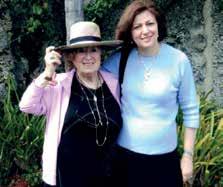
watching him enjoy himself. To us, the numerous attractions within these theme parks were not as stimulating as we had imagined. We went two more times to Orlando with friends, each time for a week, and only visited the parks once.
After retiring from my accounting practice in 2020, we started to go to Miami each year for some of the winter months. The first three years we went only for one month, but the past two years, we were there for January and February. We rented an apartment in the Tower 41 building, which is mainly occupied by Orthodox tenants, some of which we know from before. There are two shuls in the building, nusach Ashkenaz and nusach Sfard, with steady minyanim and shiurim. The building has ample parking in their underground garage, so we sent
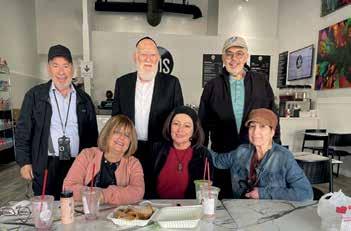



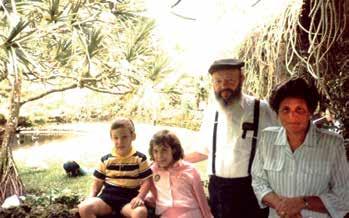
kosher groceries and restaurants which are close by. There are other shuls in the vicinity to choose from. There are some beautiful, tree-shaded blocks near our building which make for very eye-pleasing walks. The iconic boardwalk, which is only a ten-minute stroll from us, is especially inviting during the evening hours.
Staying in Miami Beach for two winter months was not so much a vacation, rather, we were making our home in a climate-friendly environment. My schedule continued very much like when I at was home in Lakewood, New Jersey. Davening, daily shiurim, studying with a number of people over Zoom and Skype, three times a week exercises, and writing my column for TJH. I joined a morning kollel for three days a week which offered a diverse learning program. Pesi also exercised, listened to shiurim, and socialized with other women in the building. I joined Pesi for our food shopping forays and for occasional walks. During the past few years, we hosted some of our children and grandchildren for long Shabbos weekends, and some came for an entire week. Pesi’s sister and her husband, as well as other friends, stayed with us for over a week as well. Eating out, though quite expensive, was at times part of our activities. We met with friends at some of the upscale restaurants and treated family members to a selection of delicious cuisines.
Over the past few years, we went twice to the annual Coconut Grove Art Festival and twice to the Miami Beach Antique Show. We went on two occasions to Candlelight Concerts, which featured a classical string quartet. This year, we went to Luminosa, a unique presentation of forty-plus illuminated sculptures. Many were breathtaking! Twice, we partook in a virtual projection immersive experience, which brought to life the art and biography of famous artists. The first one exhibited Claude Monet, and the second one highlighted Vincent Van Gogh. One year, we took a tour of the Amazon Distribution Center which showed how items that are bought on Amazon are retrieved
by robots and packaged to be shipped to customers. It was a fascinating tour. Three years ago, we took a walking tour of the Little Havana section of Miami with a local guide where we immersed ourselves in the Cuban culture that represents a great part of the city’s population. To us, it was an eye-opener and very exciting. The colorful clothing, the exotic foods (which we could not eat), the gaudy souvenirs, the bars serving rum, and the small tobacco shops rolling cigars…it was an experience we cherished.
I mentioned before that this article may turn into a travel brochure. So far, I have not taken that path. Nevertheless, I feel that I would like to share with my readers some of the different sights and attractions that Pesi and I experienced over the years. Not everyone has the same interests as we do, but I will attempt to share an image which may be helpful for future trip planning. In this Part I section of my article, I will focus on Miami and destinations that are close by.
Miami Beach Botanical Garden is right off the Convention Center. This 2.6-acre gem is small but delightfully appealing. It showcases native plants like palms and orchids. It has ponds and fountains and a Japanese garden. It is an easy walk around the pathway and a welcome getaway from the neighboring cityscape.
Miami Zoo is the best zoo in the state. We enjoyed the large variety (over 2,500 species) of animals and birds immensely. We even went there twice. We rented a safari cycle, which we peddled between the animal exhibits which saved us time and energy. The landscapes, which replicate the original habitats of the wildlife on display, are authentic looking. We could hardly believe that a visit at our age would bring us so much enjoyment.
Vizcaya Museum and Gardens is a National Historic Landmark of a 1916 waterfront estate with thirty-two decorated rooms and ten acres of formal gardens.
Almost all of the European acquired furnishings, paintings, tapestries, rugs and decorative items are original. We must have been there at least four times over the years. We came alone, took my mother, took along friends, and recommended the place to others. A real must!
Deering Estate consists of a three-story wooden house and a three-story stone mansion. There are artifacts and antiques displayed in both buildings. The front lawn leads out to Palmetto Bay, and the view is stunning. There are guided tours of the houses, and an hour-long nature hike is also offered.
Fairchild Tropical Botanic Garden is in nearby Coral Gables. This eighty-three-acre garden has rare tropical plants, including palms, cycads, flowering trees and vines. There are lush tropical gardens, rainforests, and coastal habitat displays. The Arboretum and the Butterfly Garden are just some of its features. We went there twice and enjoyed it immensely. The downside was that it is very large (though there is a tram that makes a number of stops) and that vast sections of the garden have no shade (an issue on a hot day).
In my next articles, I will cover Fort Lauderdale, Delray Beach and Palm Beach. Then I will focus on Key West, St. Augustine and Cape Canaveral. I will also highlight the sights and attractions of Florida’s Gulf Coast like Naples, Fort Meyers, Sanibal, Sarasota, St. Petersburg and Tampa.
Hershel Lieber has been involved in kiruv activities for over 30 years. As a founding member of the Vaad L’Hatzolas Nidchei Yisroel he has traveled with his wife, Pesi, to the Soviet Union during the harsh years of the Communist regimes to advance Yiddishkeit. He has spearheaded a yeshiva in the city of Kishinev that had 12 successful years with many students making Torah their way of life. In Poland, he lectured in the summers at the Ronald S. Lauder Foundation camp for nearly 30 years. He still travels to Warsaw every year – since 1979 – to be the chazzan for Rosh Hashana and Yom Kippur for the Jews there. Together with Pesi, he organized and led trips to Europe on behalf of Gateways and Aish Hatorah for college students finding their paths to Jewish identity. His passion for travel has taken them to many interesting places and afforded them unique experiences. Their open home gave them opportunities to meet and develop relationships with a variety of people. Hershel’s column will appear in The Jewish Home on a bi-weekly basis.






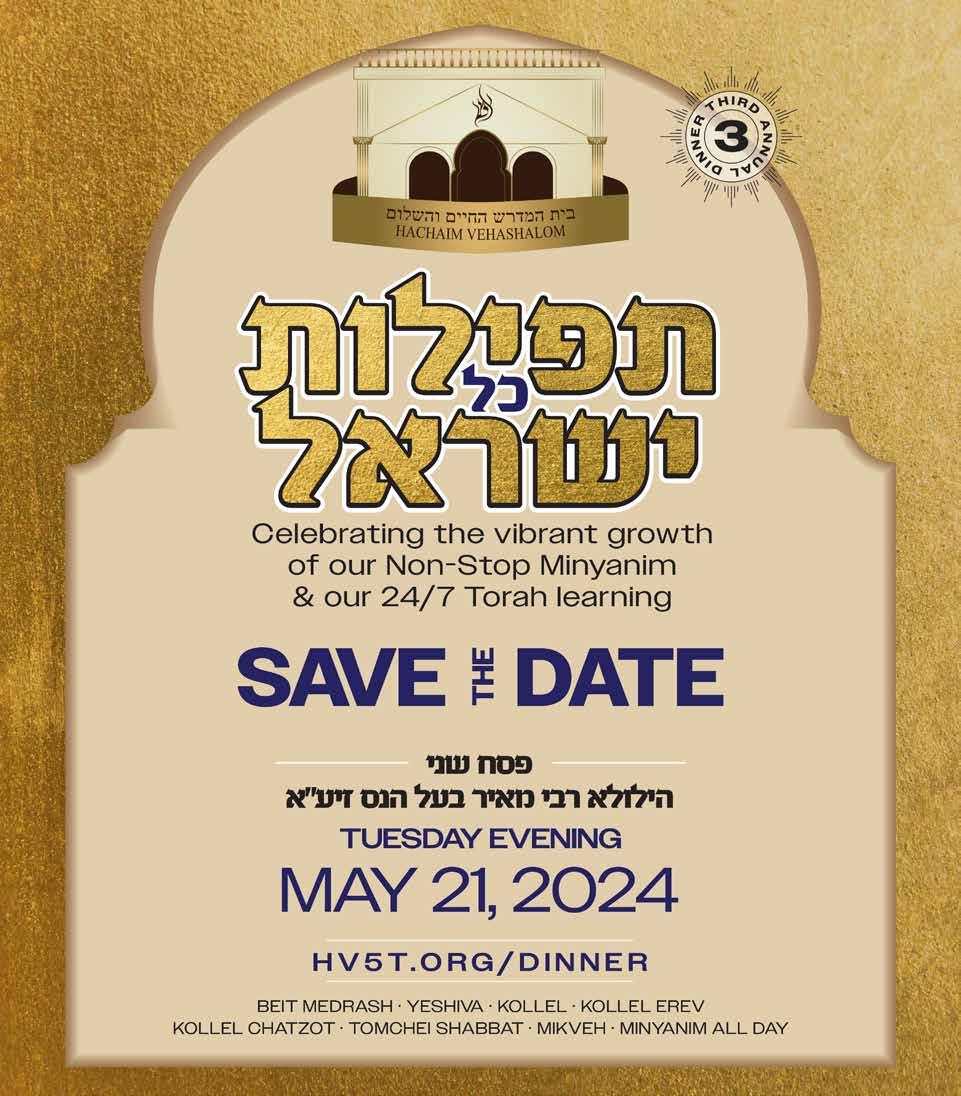

Thirteen years ago, our grandson Yosef was born. It was Erev Pesach, well almost, and our daughter Rachel was having a very hard time keeping her blood pressure stabilized and Yosef out of distress. Her pregnancy/birth situation harkened back to the time when she was born and I was a mess; a status that still continues to be a part of my health profile.
Right after she gave birth, I left for Israel to help with newborn Yosef’s five siblings; my coming before the bris would be a surprise to all of them. As it was the season of cleaning and organizing, Pesach, the sight that welcomed me was chaotic. All of the family’s clothes were out of their closets, furniture was piled into one room, and kids and stuff were everywhere. As I peeked into the room, I noticed Dovid, Yosef’s not much older brother, giggling; he had spotted me.
From the moment I stepped into the apartment until my flight home for Pesach in Florida with my in-laws, I did not stop to eat a meal, sleep a night, or drink much. It was nonstop gan drop offs, preparing food of all kinds, cleaning and folding. Truth be told, I called up all of Rachel’s friends and told them that she was having an immediate tag sale and giving away all maternity and girl’s baby clothes.
My husband joined us before Shabbat. He had been on a mission to Washington with our eldest grandson, Elly.
The day of the bris was bright and sunny and thankfully went off without a hitch. At the time, we were blessed that we had no one in our family to honor with his or her name. As a result, Rachel and Josh named their new baby boy Yosef just because they liked the name and its meaning. We left to go back to New York and a few days later, Miami, comforted by the knowledge that we had done everything possible to give Yosef and his recovering mom a strong start.
Here we are back in Israel for the third time in as many months to celebrate a bar mitzvah – Yosef’s – and a wedding. One of Rachel’s dear friends Michal and Jonathan’s daughter, Julia, got married.
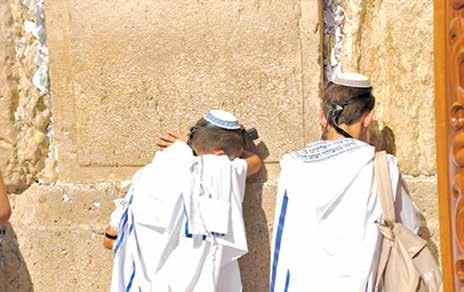
Michal and Jonathan are part of the closeknit “friends who are like family” circle that have banded together because they live in Israel and their parents/ grandparents don’t.
Michal even came to the “baby stuff tag sale.”
Every one of their children called us “Grandma” and “Grandpa” growing up, and our extended families have enjoyed many meals and good times together. We were privileged to be included in the wedding simcha.
Yerushalayim is very somber and empty. The people are scared and the mood uneasy as the mighty Iran sends hundreds of midnight missiles to rain down on a sleeping land. It was frightening despite the fact that we slept through the whole thing; our bedroom is a cave.
The news this week is that they can’t find or don’t have enough hostages to broker a ceasefire. Even though I have been feeling that the hostages are gone for a while, I’m still shocked.
How could the infirm, infant, injured, brutalized and starving men, women and children survive under the best of conditions? It is my belief that they certainly could not under the present ones. I’m worried, so worried.
Yet, whenever you walk into an empty store to bring back anything you can, the shopkeepers greet you with joy and bless
you for even the most minor purchase. “It’s all from Him,” they say pointing to the sky. There are celebrations to be made, Pesach to prepare, opportunities for joy, and laughter to be heard.
We went to Julia and Binyamin’s magnificent wedding held in the Psagot Winery. It overlooks the magnificence that is this land. We were supposed to travel in various carpools, but because of the tensions and the fact that the winery borders an Arab enclave, the shul hired an armored bus to ensure the guests got there safely.
It was a little (a lot) unsettling realizing that you must think of the many safety issues and concerns before going anywhere in Israel at this time.
The wedding was held in and out of doors; it was outrageous in its breathtaking beauty. People came dressed in a colorful variety of clothing – jeans, suits and ties, no ties, uniforms, skirts and blouses, sparkly silky dresses, heels and almost everyone, including the men and most of the wedding party and guests, in sneakers.
The ceremony began with the prayer for the soldiers. It was spinetingling to sit high above the world and sing along with the crowd begging Hashem to keep the chayalim safe. As the chosson is a lone soldier, his battalion was there celebrating with him as only a group who have
spent long days and freezing nights together can.
After the raucous ceremony, the groom’s friends danced him out, and one couldn’t help but notice the wide selection of rifles and guns proliferating in the crowd. So many!
The music and dancing shook the tent; this old lady found that her dancing shoes still work despite her unreliable betraying knees. All participants got to pack up their worries and live in the moment of joy.
My highlight at the wedding was to witness the wonderful circle of the chosson’s friends, some in and some out of uniform, dancing with and around him. Some chayalim had their rifles slung across their shoulders; it was clear that they were so happy to celebrate Binyamin and his beautiful bride. Hopefully each one of the chayalim has or will have a big happy and healthy life in front of him. Mazal tov!
It will soon be Shabbat in Israel, and we are preparing for Yosef’s big moment. He has worked so hard getting ready for his Aliyah, and he is well prepared. From the dramatic days of his birth to this special day, he has brought a selfless commitment to his fellow man, Torah, and chesed. Yosef has a warm, sunny nature, like his dad Josh (Deutschs don’t have that magical smile; we have other things), that is a gift to everyone in his world.
Even though the streets of Jerusalem are not packed and the people are worried, having opportunities to celebrate the future through our bar mitzvah boys and freshly minted couples gives me the confidence to say, “L’shanah haba’ah b’Yerushalayim” at the conclusion of the Seder.
I am more confident than ever that it will happen!
Mrs. Barbara Deutsch is currently the associate principal at HANC 609 and a longtime reflective educator, parent, grandparent, and new great-grandparent. Even after all these years, she still loves what she does and looks forward to working with kids every single day.



